
A Summit Trek In Uttrakhand | India’s Top Most Winter Trek
Easy - Moderate

Highest Altitude
Oct, Nov, Dec, Jan, Feb, Mar, April
Kedarkantha Trek
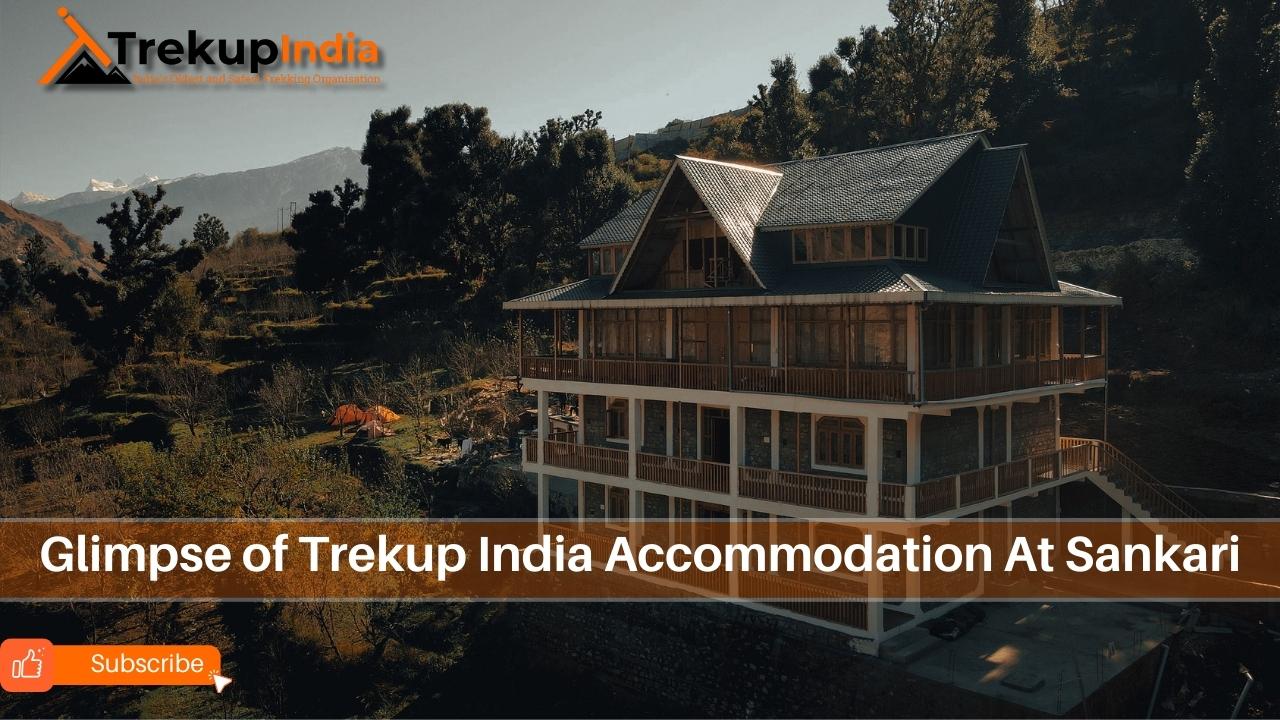
Get Ready to trek the most popular and adventurous Kedarkantha Trek located in Uttarkashi, Uttrakhand, India. Fringed with pine trees and decked with the prettiness of snow, Peak is often considered the best snow-trekking destination across the globe. Located at an altitude of 12,500 ft. above sea level, the trek to this mountain pass in Uttarakhand provides diverse levels of challenges to the voyagers. If you want to experience nature at its best and enjoy a wonderful trek then this Winter Snow Trek is definitely for you. During the trek, you will pass through mesmerizing picturesque views, rich forests, fields as well as snow trails. You need to know that Kedarkantha Summit is nestled in Govind wild life National santuary Park of Uttarkashi. This beautiful peak is encircled by several scenic river valleys, this valley is also known as upper valley of garwal, remotely situated villages the villagers of these villages are living here since Mahabharat Period. Kedarkantha is considered as top most winter snow trek in India, beginners can also do this trek in the Himalayas that you need to experience at least once in your life. Best time to do this trek is from the first week of November to the last week of April, you can find a lot of snowfall here. The campsites of this trek are beautifull all camps are covered with snow after mid november.
Although every trek in the Himalayas is special and known for its own beauty. Trekking often gives you a dose of nature which is not possible in the cities and also offers you the chance to stretch your psychological & physical limits. This Trek is one of those treks in the Himalayas that induce you to witness the beauty of nature that too in its pure form. Right from snow-capped mountains, green pastures forest, frozen lake to a pleasing divine summit, it offers everything that you wish for as a trekker. The summit ascent of trek is extremely rewarding and sure to give you amazing memories. All these views are seen from the starting point Sankri base camp till summit.
As you begin your trek in the early hours of the morning and gradually climb up the steep hill, you will experience breathtaking nature views. Kedar Kantha is popular mainly as a winter trek that starts right from a famous village called Sankri. This beautiful village is almost 210km away from Dehradun.
Generally, in the mountains, winter is quite harsh when it comes to weather. When the snowfall begins, the temperature drops down to minus that further blocks several roads, making most areas unreachable. All these things often make trek exciting and popular because here you can actually experience what winter feels like in the mountains. The temperature here drops to 10 degrees at night and even less but remember such kind of temperature is bearable only with a bit of carefulness. This is the reason why several tourists head towards the base village of this trek called Sankri, especially in the month of December, January, February, and March each year.
The drive from Dehradun to mussoorie and to sankari is one of the most stunning and charming drive in the Himalayas. So, don’t forget to carry your camera. On the way, you will come across the paths filled with snow as well as meadows that are going to offer you a mesmerizing glimpse of the Himalayan Peaks. The silent and peaceful streams along with tranquil lakes are sure to treat all your trekking tiredness and give you a tenderness in nature. You can do ski, if you are good at doing skiing then make sure you try it during the Winter. Skiing will give you the chance to experience an amazing view of the medows of himalyas covered with snow. Get ready to experience the pleasant view that will definitely soothe your eyes because while trekking you will come across rich forests that are wailed with recent snowfals n month of december. Not only this, but the gentleness and kindness of the Local people will surely impress you. This Trek is also considered as the place of Shiva, the ancient Hindu Lord, this trek is no less than a paradise. Silence, as well as the peacefulness of this trek, gives you an amazing feeling and even make you fell like you are in heaven. The paradise sky sight, and sky-knocking mountains, are sure to give you a feeling like you are standing on the edge of the earth. When it comes to this trek, there are several mythological stories behind it. It is believed by the locals of sankri that kedarnath temple initially was here, However, local people still believe that Kedarkantha is the only place of the Lord Shiva Live. Even if you are new to trekking, This Trek is the best trek of all time. Get ready to explore the stunning beauty of the view from Burane range to Bandarpoonch 1 and 2 and in between, you will also get the wonderful sights of Rupin range, Har Ki Dun, Swaragrohini 1 to 4 as well as Black Peak, during your trek. Height and altitude of Kedarkantha Trek is 12,500 ft and is an achievable altitude for all beginners and first-time trekkers. If you are fond of trekking and want to experience nature at its best then do plan for this trek once.
Why is Kedarkantha Trek an ideal choice for beginners?
Location and Geography: Nestled in the heart of Uttarakhand, India, the Kedarkantha trail winds through the enchanting Govind Wildlife Sanctuary in the Western Garhwal Himalayas. It’s a journey that takes you through the spellbinding Tons Valley, a sight to behold and a top trekking destination in India.
Route: The journey to Kedarkantha Peak takes six days and is suitable for beginners and experienced trekkers. It passes through charming villages, lush forests, and captivating meadows, highlighting the beauty of Uttarakhand’s trekking.
Difficulty Level: The trek offers a balanced level of challenge, suitable for those with limited experience. The terrain provides a mix of excitement and accessibility without being overwhelming.
Suitable for Different Age Groups: Kedarkantha is not just a trek; it’s an experience that welcomes families, friends, and solo explorers with open arms. It offers something for everyone, making it an ideal choice for beginners.
No Technical Skills Needed: This beginner-friendly trail eliminates intimidation and does not require extensive technical expertise.
Well-Marked Trail: The trail in Kedarkantha is marked, reducing the chances of getting lost and enhancing the trekking adventure.
Guided by an Experienced Team: Your journey to Kedarkantha is not just about the trek but the experience. With the assistance of experienced guides and trek leaders, your safety is our priority. They will guide you and enhance your knowledge of the region’s culture and natural environment, making your trek more enriching.
For beginners eager to trek, Kedarkantha is an ideal starting point. It offers breathtaking beauty and a deep sense of achievement.
Remember this helpful guide to the Kedarkantha Trek
The Kedarkantha Trek, located in the Himalayas, is famous for hikers due to its stunning scenery, moderate challenge, and easy accessibility. With the winter season approaching, it’s time to start planning your Kedarkantha Trek. This article provides an overview of what to expect during the trek and how to prepare.
Location: The Kedarkantha Peak is in the Uttarakhand Govind Garhwal region. The trek typically starts from the picturesque village of Sankri, known for its beauty and friendly locals. Sankri is easily accessible by road from major cities such as Dehradun and Rishikesh.
Duration: The Kedarkantha trek lasts six days and is suitable for trekkers of all experience levels, from beginners to seasoned hikers.
Difficulty Level: With a moderate rating, Kedarkantha offers a good balance of adventure and accessibility, making it suitable for novice and experienced hikers. The gentle incline provides a pleasant and rewarding experience, making it an excellent option for families with children.
Best Time to Visit: The best time to visit the Kedarkantha Trek is during winter, from December to April. During this time, the area becomes a magical winter landscape with snow-covered trails, frozen lakes, and thick forests.
Altitude: Kedarkantha’s altitude reaches an impressive 12,500 feet. The journey from the base camp to the summit involves an increase in height of 6,100 feet over three days, allowing participants to adjust to the altitude.
Lodging: Accommodations include stays in a Trekup India Luxury Hotel at the base village of Sankari and comfortable twin-sharing tents during the trek.
Offloading Service: Offloading services are available for an additional fee. If booked online through the website, it will cost INR 1600, or at Base Camp Sankri, it will cost INR 2000. The offloading bag weight should be at most 10 kg.
Cloakroom: Upon arrival in Sankri, you can store your luggage at the guesthouse.
Nearest ATM: The last ATM before Sankri is at Mori. For a secure trek, carrying cash with you or withdrawing it at Dehradun is advisable.
The Biodiversity of Kedarkantha Trek in Uttarakhand
Located within the Govind National Park in Uttarakhand, Kedarkantha is a popular trekking destination in India known for its stunning scenery and panoramic summit views. Despite its natural beauty, the region’s incredible biodiversity often goes unnoticed. The trek through the national park showcases a wide variety of plant and animal life, with different vegetation zones transitioning from dense oak and pine forests at lower elevations to picturesque alpine meadows at higher elevations. This unique range of altitudes creates a diverse ecosystem supporting various plant and animal species. Kedarkantha is home to many rare plant species, including the beautiful Brahma Kamal. It is a haven for wildlife such as the Himalayan Monal, Musk Deer, and various bird species. The Kedarkantha Trek is moderately complex and suitable for beginners and experienced trekkers. All of these contribute to the rich biodiversity of the Himalayas.
Please remember the following text about the plants and wildlife you can encounter during the Kedarkantha Trek:
Plant Life in Kedarkantha Trek
1. Rhododendron Blooms
The Kedarkantha Trek offers an extensive view of rhododendron forests in shades of red, pink, and white, especially visible in spring. These forests add a vibrant contrast to the snowy scenery.
2. Oak & Pine Forests
The trek takes you through thick oak and pine forests, which support diverse plant and animal life, including various bird species and small mammals.
3. Moss & Lichen
At higher elevations, you will find a serene landscape adorned with moss and lichen, crucial for maintaining the region’s ecological balance.
4. Medicinal Plants
The trek features the Brahma Kamal, a revered plant species essential to Uttarakhand’s local population.
Wildlife on the Kedarkantha
1. Himalayan Monal
The rare Himalayan Monal, known as the state bird of Uttarakhand, is a sight to behold in the thick forests, showcasing its shimmering feathers. Spotting this magnificent bird is a privilege that adds a touch of exclusivity to your trekking experience.
With its graceful movements, the elusive red fox enhances the beauty of the stunning snowy landscape. Its presence adds a touch of allure to the already picturesque scenery, making your trek even more enchanting.
3. Himalayan Tahr
Spot the impressive Himalayan Tahrs with their curved horns and dense fur in the alpine meadows.
4. Langurs and Macaques
Energetic langurs and macaques add an exciting element to the natural environment.
5. Musk Deer
Spotting the elusive musk deer, a rare and exhilarating experience amidst the breathtaking scenery of the Kedarkantha Trek, is sure to get your heart racing. The thrill of such an encounter is an unforgettable part of your trekking adventure.
Due to its biodiversity, the Kedarkantha Trek is a valuable experience for nature enthusiasts, offering a chance to explore the wonders of the natural world.
- Stay will be on a twin-sharing basis in tents
- + 210 Trek Insurance (Optional)
- Discount Policy
- Transport Optional ( INR - 1,500 extra )
Pickup time 6.30 A.M from Prince Chowk, Near Dehradun Railway Station
- Inclusions & Exclusions
- Food Provided Trekup India
- Safety With Trekup India
Call Our Mountain Experts
Fix Diparture Dates
Kedarkantha trek videos.
Videos by experts watch these videos to prepare well for a Successful Trek

Want To Trek Like Pro?
Check out the following videos if you want to trek like a pro trekker and improve your skills. These videos contain helpful tips, tricks, and techniques to help you trek like a pro. Whether you’re a beginner or an experienced trekker, these videos can provide valuable insights to enhance your trekking experience. So, watch the videos below by Trekup India experts to take your trekking skills to the next level.
Know Everything About Acute Mountain Sickness
Acute Mountain Sickness is a medical condition that can occur when individuals travel to high altitudes, typically above 8,000 feet. It is caused by the decrease in air pressure and oxygen levels in the air as altitude increases. Symptoms of Acute Mountain Sickness may include headache, nausea, vomiting, dizziness, and difficulty sleeping. To avoid Acute Mountain Sickness, it is important to gradually adjust to high altitudes and seek medical attention if symptoms worsen. To learn more about this condition, check out the videos by Trekup India.
Day Wise Detailed Itinerary of Kedarkantha Trek
Day 1: pickup from dehradun and drive to sankri.
- Sankri is located at an altitude of 1920 meters and 6,400 feet.
- Dehradun to Sankri 220km drive which will take almost 10 hours.
- All the trekkers will be pickuped from Hotel garand which is near Dehradun Railway station at 6:30 AM in a Bolero (6-7 seaters), Innova (7 seaters), Tempotravellers (12 seaters) & Bus.
- You will be reaching at Sankri till 05 in the evening.
- Jio & BSNL network available.
- Night stay in guest house and hotel.
Your trip will start from Dehradun for the Kedarkantha Winter Snow Trek. All the trekkers need to arrive at Dehradun before 6 am because till 06:30 am, we will start our drive to Sankri.
You need to know that the distance between Dehradun to Sankri is almost 220km which will take approximately 10 hours to reach. Sankri is located on the National Highway 123 and is a beautiful drive. While driving from Dehradun to Sankri, you will be spell-bounded with the beauty of valleys as well as forests.
Before reaching Sankri about 22km, all the trekkers will get an amazing feeling of serene Himalayas as well as greenery. You will also come across Govind National Park which is well-known for its huge collection of Flora. In this park, you will find the Flora which is available only in this region and nowhere else in the country.
Day 2: Trek from Sankri to Juda-ka-Talab
- On this day we will to 9100 ft from 6400 ft.
- Trekking for 4km will take 2.5 long hours.
- The path will pass through maple trees, oak forests, water streams, and stunning meadows.
- Night stay in tents (twin sharing).
On day 2, you will begin the trek towards Juda Ka Talab which is located at an altitude of 9,100 feet. Till afternoon, you will cover almost 5km which takes 5 hours but this can also vary on the capability of the trekker.
Get ready to experience the diverse adventures on the trail. While walking, ice and slush might bother you a little but the guides of TrekupIndia will help you out so don’t worry.
The trek will start with a beautiful pine & maple forest that will further rise alongside the wildlife as well as pastures. As you trail upwards, you will spot some beautiful huts alongside the fields.
While trekking, you will see a goliath lake on the left and thick pine & oak backwoods on the other side which is a perfect example of beauty. You will get the Luke warm water all around the lake and the rest water will be colder.
In winters, you can see a sheet of ice instead of water, giving you an eye-catchy view. This lake also has a big natural tunnel that offers water to the villagers.
Primarily, you will be climbing through the bridges and one of the exciting things about this trek is that you will find Himalayan Languor. You need to know that they are shy animals and hardly anyone gets the chance to see them.
You might also witness boars, hares as well as martens in this region. Juda Ka Tal is a beautiful destination in the thick pine and oak forest. At night, you will be served with hot & healthy dinner. Your night stay will be scheduled in a camp where you can enjoy the beauty of Mother Nature’s lap.
Day 3: Trekking from Juda-ka-Talab to Kedarkantha Base (Lohasu)
- today we will trek to 11250 ft from a height of 9100 ft.
- Trekking for 4kms which will take time of 2.5 hours.
- Most of the trail is on a ride and under the beautiful oak trees
- You will be passing through some pastures where shepherd log huts can be seen.
- Night stay in tents (twin sharing), giving amazing views of nature.
Get up early in the morning and witness the breathtaking sunrise that will definitely leave you stunned. On day 3, we will begin the trek for Kedarkantha base which is located at a height of 11,250 feet.
Kedarkantha Trek Base i.e Lohasu from Jadu Ka Talab is almost 4kms and it takes 2.5 hours to cover at a moderate speed. You need to know that Jadu Ka Talab is a wonderful lake that is surrounded by pine trees that often gets freeze at the time of winters and also turns out to be a spot for adventures as well as fun activities for the trekkers.
Gradually, the trail will get steeper as you keep on moving upwards. Your trek guide will teach you different skills for snow slopes, so be attentive and listen to him carefully. He might also guide you about how big your footsteps should be.
Your trekking will again start from the dense forest of pine and oak trees. The trail also passes through the steep ridges. As you gradually walk towards the path and reach a height of 10,400 feet, you will witness the snow traces that will definitely give you magnificent views of nature.
Get ready because the spectacular views are still waiting to shock the trekkers because before reaching the base camp all the trekkers can observe the stunning views of different arc-shaped ranges that are covered with snow like Bandarpoonch, Swargarohini, Kala Nag as well as Ranglana that are standing with great pride in the lap of Mother Nature.
At night, you will be served with delicious dinner in your tents only.
Day 4: Early Morning Hike From Kedarkantha base to Kedarkantha peak; descend to Hargaon camp
- We Will WakeUp Early Mornig for the summit push / peak.
- Trekking for almost 7 hours for 6kms trek
- You will see sun rise if we reach on time to summit
- Served with lip-smacking lunch at the camp base only
- After lunch, descending towards Hargaon
- For snacks time we will reach Our next Campsite Hargaun
- Night stay will be organized in tents (twin sharing).
Day 4 is going to be a long one because you will be heading towards the Kedar Kantha peak. Today, you will be trekking from 11,250 feet to 12,500 feet and trek for almost 6kms which will be covered in 7 hours. It is necessary for you to know that the trail will be steeper, so be prepared accordingly.
At the time of trekking, you will see the magical colors of nature as well as the majestic sights of different ranges including Rupin. The reason for calling it Kedar Kantha, rumors from villagers is; 1st they tried to build Kedarnath temple in that peak but they heard some animal’s sound which means omen for a divine event.
Till then they constructed Lord Shiva’s statue till neck ad in Hindi neck is called Kanth as well as Lord Shiva has a lot of names and Kedar is one of them. This is the reason, why it is known as Kedarkantha.
In Kedar Kantha peak, you can treat your eyes with appealing views of Bandarpooch, Swargarohini, Kalanaag, Gangotri as well as Yamunotri. After reaching the summit, the captivating views of nature will definitely balance your emotion and leave you stunned.
On the top, you will also find a small temple which is dedicated to Lord Shiva and Goddess Parvati along with a small shrine of Lord Ganesh too. Apart from this, we will also start descending to Hargaon camp on the same day.
A night stay will be scheduled at the campsites, giving you beautiful views of valleys and nature.
Day 5: Trek from Hargaon camp to Sankri
- Returning back from Hargaon camp (8,900 feet) to Sankri (6,400 feet)
- Trekking for 6kms which will take almost 4 hours
- Descend 2,500 feet through dense pine woodlands
Day 5 is marked for descending further to Sankri from Hargaon Camp. We will be descending from 8900 feet to 6400 feet. The time for descending the 6kms long trail will take almost 4 hours and even more if you follow a moderate speed.
The day has arrived when you need to leave the regal views of the Himalayas as well as snowcapped mountain ranges because we will be heading back to Sankri. It is important for you to know that the trek is going to simple as the distance is short.
Sankri is the stoppage village for several treks like Bali pass, Borasu pass, and many more. The morning at Hragaon camp is going to welcome you with a stunning sunrise right between the pine trees.
After having breakfast, you will pack your back and start descending through a clearly marked paved pathway and reach Sankri.
Day 6: After Having Last tea, coffee with us, Departure from Sankri to Dehradun
- Back to Dehradun which is 220km from Sankri.
- The drive will take almost 8 to 10 hours but, on the way, you will come across beautiful scenes.
- By Tata Sumo or any other vehicle, you will be dropped at Dehradun Railway Station.
On day 6, you will be heading towards Dehradun from Sankri which will take almost 10 hours as you need to cover 220km. You will be leaving Sankri early in the morning so that by evening you reach Dehradun.
By 7 – 8 pm in the evening, you will be reaching Dehradun, so get your bookings done for your hometown accordingly.
Make sure to collect all your memories while driving back to Dehradun.
We’ve prepared a comprehensive Trek Route Map for your upcoming adventure to Kedarkantha Trek , which outlines the entire journey including all stops and trails. This map provides detailed information on the terrain, distance between points of interest, and estimated travel time to help ensure a safe and enjoyable trek. We’ve carefully curated the map to ensure that you have all the necessary information at your fingertips. Please take a moment to review it thoroughly, and don’t hesitate to reach out if you have any questions or concerns.
The Trek Altitude Chart is a useful tool for Trekkers to monitor their altitude changes during their rides, allowing them to plan their routes more efficiently and track their progress over time. This Kedarkantha Trek chart is beneficial for both casual and experienced Trekkers, helping them make the most out of their Trek experience.
Trek Cost Inclusions
- Stay: 3 Nights of tented accommodation at individual campsites of Trekup India on twin sharing and 2 nights at sankari in Trekup India Luxury Hotel on multi sharing basis.
- Meals: Trekup India will provide freshly cooked meals during the trek starting with Dinner on Day 1 to tea, coffee on day 6 (Meals are simple, nutritious, and vegetarian)
- Transport (Optional): Dehradun to Sankari and return. ( 1500 extra )
- Trek Insurance (Optional): Trekup India recommends that all trekkers consider getting trek insurance. This is optional, but highly recommended. Trek insurance covers unexpected events that may occur during your trek. The cost of the insurance starts from INR 210. Please read more about what is included in the coverage and why it is mandatory on treks.
- Trek Equipment: Sleeping bag, Sleeping tents, Kitchen tent, Dining tent, Toilet Tent.
- Amenities: All utensils, sleeping mattresses (Black foam mats), Crampons, and Gaiters for snow.
- Health & Safety: First Aid Box, Oxygen Cylinders, Stretchers, Oxi meters, BP Machines, health.
- Permits: Forest Permits and Camping Permission Fee
- Trek Crew: High Altitude Chef, Helpers, Trek Leader & Guides, and other support teams.
- Potters & Mules: Potters and Mules are to carry all trekking equipment, ration, and vegetables.
Trek Cost Exclusions
- GST 5% (it is Mandatory)
- Any Meals/accommodation beside the itinerary or not mentioned in the program.
- Any Bus / Airfare to/from trek start/end point
- Personal Medical expenses do carry your medication.
- Any personal services such as Laundry, phone calls, liquors, mineral water, etc.
- Any still / video camera fee
- Any Entrance fee Monuments, Monasteries, Museums, Temples – Pay directly on the spot.
- Mules or porter charges to carry private baggage (Offload Charges for bag 365 per day, per bag if paid online (at base camp 2,550). Note: Bag weight should not be more than 10 kg.
- Any emergency evacuation charges
- Any services that are not mentioned in the cost inclusion section.
What should you pack for the Kedarkantha Trek
Kedarkantha Trek is a high-altitude trek. The trekking gear you have to have for this particular trek differs from normal treks. Thus, read this whole segment. There is an important question that the trekker who is doing trek asks, like what all things to carry while trekking. Below, we have provided the details on everything you should take; an easy way to remember is by Head to foot or foot to head. We have prepared from Head to foot.

When trekking it's important to carry headgear to protect your head and face.
Heading out for a trek? Don’t forget to carry headgear to protect your beautiful face and head from the sun, wind, and dust! It’s an essential accessory that keeps you safe and comfortable throughout your adventurous journey. So, make sure you pack it before you step out into nature!
- Head Lamps – When trekking at night, headlamps are essential to illuminate your path while keeping your hands free. Headlamps come in different sizes and lumens, so it is essential to choose one that suits your needs.
- Hats or Cap – Caps or hats are also necessary when trekking in different weather conditions. Caps protect your head from the wind and freezing temperatures at night, while hats provide shade and protection from the sun during the day. It’s essential to ensure that your hat has a strap to prevent it from being blown away by the wind.
- Sunglasses – Sunglasses are also essential for trekking. Your sunglasses should protect your eyes from harmful UV rays and fit your face perfectly to avoid falling off while climbing, jumping, or crossing obstacles. The glass of your sunglasses should also be designed for different weather conditions to provide optimal visibility.
- Buff / Balaclava – Lastly, a buff or balaclava is a must-have to protect your mouth or neck from extreme temperatures and keep them warm. Buffs and balaclavas come in different materials, thicknesses, and designs, so it’s important to choose one that suits your needs and preferences. Depending on the weather conditions and your activities, you can wear them as neck warmers, face masks, or headbands.
When trekking in high altitudes, prepare for cold weather by wearing layers. Layering traps heat, keeps you warm, and allows you to easily adjust your clothing as temperatures fluctuate.
Layering is important for different seasons when trekking. When planning a high-altitude trek, it is important to prepare for the cold weather. Wearing layers is the best approach as it provides both protection and flexibility when the weather changes frequently in the mountains. Layering helps to trap heat and keep your body warm, while at the same time allowing you to easily adjust your clothing as the temperature fluctuates. By wearing layers, you can enjoy your trek comfortably and stay safe in the unpredictable mountain weather
- For spring, summer, and monsoon treks , consider wearing three layers: a woollen sweater, a fleece, and a padded jacket.
- For autumn treks , add one more fleece layer to make it four layers.
- For winter treks , you may need five layers with thermals, a woollen sweater, two fleeces, and a padded jacket.
- T-shirt/sleeve shirt – Bring three T-shirts and two quick-dry trek pants, wearing one and carrying the others. Long sleeve shirts help to protect from sun UV rays. We recommend synthetic T-shirts as they get dry quickly when they get wet.
- Hiking / Trekking Jacket – down jackets (-5 to-10 C) or two-three-layer jackets.
- Thermals – at least two pairs of thermals help keep the body warm during cold weather.
- Undergarments – you can carry them according to your habitual and hygiene requirements.
- Gloves – 1 pair of gloves will keep your hand warm and nice.
- Trek Pants – Bring 2 to 3 comfortable trekking pants. Trekking pants play a significant role, as they are designed for comfort and mobility, making trekking easier. It should be Synthetic so that it gets dry quickly when wet.
- Rain Wear – you can carry a raincoat or Poncho. During long rains and snowfalls, the waterproof jackets start leaking. Still, the Poncho and raincoats keep you dry, so choose accordingly.
Tip: If you choose a raincoat on your trek, carry a small waterproof cover so things inside your backpack can’t get wet. If you carry a Poncho, you don’t need to worry. It protects both you and your backpack.
When it comes to planning a trek, one of the most important aspects is to ensure that you have the right kind of foot gear.
- Trekking shoes which are waterproof and have ankle support. Walking / Hiking sandals which can be used off the trek, i.e., in the morning and evening hours when you reach the campsite, basically to get your feet rest from heavy boots, sometimes used for crossing streams and rivers, it’s more comfortable and safer than crossing barefoot or wetting your shoes. Sneakers (Optional) can be worn for normal driving days or used around the camp.
- Socks – you should at least carry 3 to 4 pairs.
- Microspikes & Gaitors will be provided by Trekup India when required. You don’t have to carry them.
Personal First Aid Kit
Don't forget to pack your personal first aid kit! It's always better to be safe. So, make sure you're prepared for any unforeseen circumstances.
Below are some common medicines generally required/used during your adventure trip; however, please consult your doctors prior.
- Antiseptic towel or water syringe (to clean the wound)
- Butterfly bandage for a small cut
- Cotton and elastic bandages and sterile gauze pad for larger wounds
- Latex gloves are used when the wound bleeds.
- Medicine for Diarrhea (Upset stomach)
- Medicine for cold, flue/fever, headache
- Some pain killers
- ORS pouches
- Quick pain relief spray (External use)
- Any personal medicine prescribed by your doctor
- Dimox / Similar for high altitude sickness
- Bug Repellent
- Carry some nutria/energy bars and drinks (non-alcoholic)
- Note: Kindly consult your doctor before purchasing or taking any medicine.
Gadgets and Other Items
You might also consider bringing a camera, binoculars, portable charger, and snacks. Be well-prepared and tackle any trail with confidence.
- Trekking Poles
- Mobile phone
- Spare batteries for phone and camera, power bank
- Lightweight flashlight or headlight
- A waterproof bag made of plastic is used for the camera.
- Plug/converter for electrical items
- 1-litre water bottle
- A journal with a pen would be a good idea to keep your notes.
- Some book of your interest for the ideal time
- Get into the habit of maintaining a Map and guidebook of the region.
Hygiene & Personal toiletry
Remember to pack hygiene and personal toiletry items such as soap, shampoo, toothbrush, toothpaste, deodorant, and toilet paper.
- Sunscreen with UV protection to shield your skin from harmful rays
- 1 or 2 small quick-drying towels to help you dry off quickly in case of rain or sweat
- Toilet paper, tissues or wet wipes for maintaining hygiene while on the trek
- Toothbrush, toothpaste, and mouth freshener to keep your mouth clean and fresh throughout the journey
- Deodorant or talcum powder to help you stay fresh and odor-free, especially during hot and humid climates
- Shampoo to keep your hair clean and healthy
- Sanitary pads or tampons (for female trekkers) to manage menstrual cycles
- Lip-gloss or salve to protect your lips from dryness and chapping
- Bio-degradable soap to keep yourself clean and hygienic while on the trek
- Nail clipper and other personal items that you use daily
Compulsory Documents to Carry
There are certain documents that you should always carry with you. These documents are not only necessary for your safety and security, but they may also be required by local authorities.
These files must be submitted to the Forest Department before your trek. With none of these, you will not be permitted to trek—original and photocopy of government photo identity card. Carry IDs like Aadhaar, voter ID, etc.
How To Plan Your Trek & Reach Dehradun?
By Air:- The Jolly Grant Airport is the nearest airport to reach Dehradun by flight, located almost 25km away from the city. Regular flights are available from Delhi to Dehradun. However, if you plan to arrive in Dehradun by flight, it is advisable to arrive one day in advance.
By Train:- If you prefer to reach Dehradun by train, two express trains are convenient options. Nandadevi Express (Train no: 12205) departs at 11:50 pm and arrives at 5:40 am, while Dehradun Express (Train no: 12687) departs at 9:10 pm and arrives at 5:00 am. The train journey is overnight.
By Bus:- There is also a regular bus service from Delhi to Dehradun, with both AC and non-AC buses available from the main bus station, ISBT Kashmere Gate. However, it is recommended to take government buses from Kashmere Gate ISBT. The bus will drop you off at Dehradun ISBT, and our staff will pick you up from Dehradun Railway Station, so make sure to reach there.
A Travller or similar vehicle will pick you up from Dehradun Railway Station at 06:30 am, and you will reach Sankri by 05:00 pm.
Kedarkantha Trek Photos
Fitness required & preparation guide for kedarkantha trek.
If you’re preparing for a Kedarkantha Trek, Trekup India recommends jogging as part of your fitness routine. Jogging helps work out the same muscle groups that you’ll use during trekking and can help you build endurance. You don’t need any special equipment to get started.

Fitness Target
Trekup India has put the Kedarkantha Trek into an easy-to-moderate-grade-level trek.
For Easy – Moderate Treks – In order to be well-prepared for your upcoming trek, it is recommended that you focus on building your endurance by aiming to cover a distance of 4.5 kilometers in less than 45 minutes. This will help you to develop the necessary stamina and strength required to successfully complete your journey.
How to Achieve This Fitness Target?
To start preparing for your trek:
- Try jogging for at least five days every week.
- If you find 5 km too difficult at first, begin with 2 km and gradually increase over 2-3 weeks.
- Once you feel more comfortable running 5 km, focus on improving your speed gradually on a daily basis.
It is important to ensure that you can consistently complete 4.5 km in under 40 minutes for at least two weeks before your planned trek. Allow yourself 6-8 weeks to prepare physically for the journey.
Strength Training exercises that benefit Trekking
Trekking is an activity that demands a good level of strength.
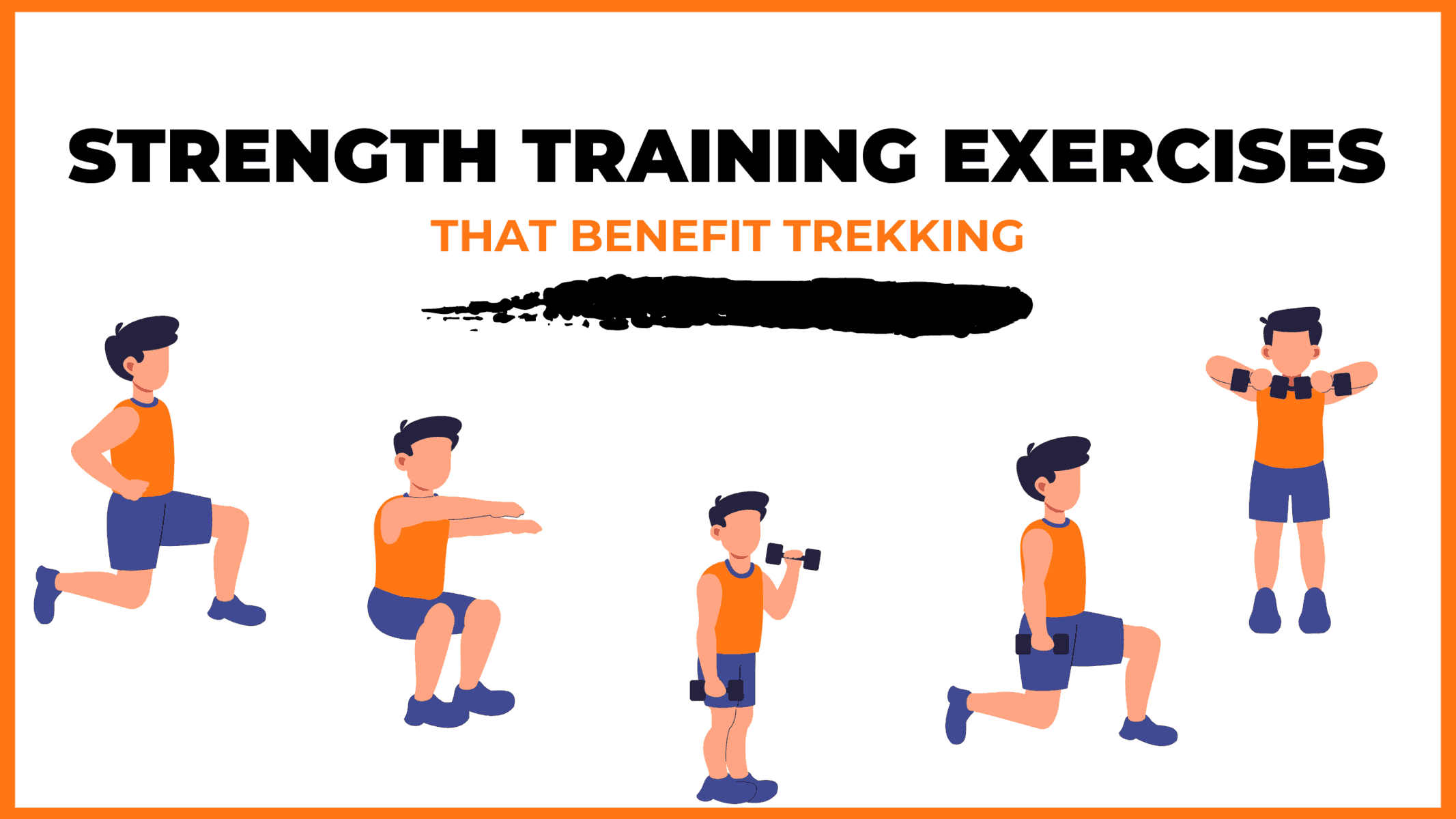
Trekking is a demanding activity that requires good cardiovascular endurance, muscular strength, and overall fitness. To help you prepare for your trek, incorporating bodyweight exercises into your training routine can be an effective way to build strength, improve stability, and enhance endurance, all of which are crucial for a successful trek. In this regard, here’s a breakdown of body weight exercises categorized by the specific body parts they target and the benefits they offer during trekking.
1. Lower Body Exercises
Lower body exercises like squats and lunges are great for building lower body strength, essential for trekking.
Squats are an excellent exercise for building lower body strength, essential for trekking. They target the quadriceps, hamstrings, glutes, and calves. Solid quadriceps and glutes provide power for ascending and tackling uphill climbs, while vital hamstrings aid stability during descents. This is particularly helpful in navigating uneven terrain during trekking.
How to perform Squats Exercises:
- Stand with feet shoulder-width apart, toes pointing slightly outward.
- Lower your body by bending your knees and hips, keeping your back straight.
- Lower until your thighs are parallel to the ground or as low as comfortable.
- Push through your heels to return to the starting position.
Lunges target the quadriceps, hamstrings, glutes, and calves. They improve lower body strength, balance, and stability, crucial for maintaining control on rocky trails and steep slopes. Additionally, they enhance flexibility, reducing the risk of injury while trekking.
How to Perform Lunge Exercises:
- Stand with feet hip-width apart, hands on hips or sides.
- Take a step forward with one foot, lowering your body until both knees are bent at 90-degree angles.
- Push through the heel of your front foot to return to the starting position.
- Repeat on the other side, alternating legs.
2. Upper Body Exercises
Upper body exercises such as push-ups and pull-ups effectively strengthen the upper body, especially the chest and shoulders, which are essential for carrying a backpack during treks.
a. Push-Ups
Targets: Chest, shoulders, triceps, and core.
Benefits for Trekking: Push-ups are an effective exercise to strengthen the upper body, especially the chest and shoulders, essential for carrying a backpack during treks. Improved upper body strength will also help maintain posture and stability while traversing challenging terrain.
How to Perform Push-Ups Exercises:
- Start in a plank position with hands shoulder-width apart and body in a straight line from head to heels.
- Lower your body by bending your elbows until your chest nearly touches the ground.
- Push through your palms to return to the starting position.
- Keep your core engaged throughout the movement.
b. Pull-Ups/Bodyweight Rows:
Targeting the back, biceps, and shoulders can significantly benefit trekking. You can strengthen these muscle groups by performing pull-ups or bodyweight rows and improve your posture and balance while carrying a backpack. Additionally, more muscular back muscles can help reduce the risk of back strain and fatigue during long treks, making your journey safer and more comfortable.
3. Core Exercises
Core exercises like planks and Russian twists can help strengthen the core muscles, which are crucial for maintaining stability and balance while trekking on uneven terrain.
Targets: Abdominals, obliques, and lower back.
Benefits for Trekking: Planks are an effective exercise that helps strengthen the core muscles. These muscles are crucial for maintaining stability and balance while trekking on uneven terrain. A strong core also helps improve posture, reducing the risk of back pain and fatigue during extended hikes.
How to Perform Planks Exercises:
- Start in a plank position with elbows directly under shoulders and body in a straight line from head to heels.
- Engage your core and hold the position, avoiding sagging or arching the back.
- Keep breathing steadily and hold for the desired duration.
b. Russian Twists
Targets: Obliques, abdominals, and lower back.
Benefits for Trekking: Russian twists engage the core muscles, particularly the obliques, improving rotational stability and balance. Enhanced core strength helps prevent injuries and improves overall performance during trekking.
How to Perform Russian Twist Exercises:
- Sit on the ground with knees bent and feet flat, leaning back slightly to engage the core.
- Clasp hands together and twist the torso to one side, bringing the hands towards the ground beside the hip.
- Return to the centre, then twist to the other side.
- Continue alternating sides for the desired number of repetitions.
4. Full Body/Cardiovascular Exercises
Full-body/cardiovascular exercises like burpees and mountain climbers are excellent for improving cardiovascular endurance, strength, and agility.
Burpees are an excellent full-body exercise that targets your legs, chest, arms, and core. This exercise dramatically benefits trekking enthusiasts, improving cardiovascular endurance, strength, and agility. Regularly incorporating burpees into your workout routine can enhance your overall fitness level, which can help you endure long hikes and rugged terrains with ease.
How to Perform Burpees Exercises:
- Start in a standing position.
- Squat down and place hands on the ground.
- Jump feet back into a plank position.
- Perform a push-up.
- Jump feet back to the squat position.
- Explosively jump up into the air, reaching overhead.
- Land softly and repeat the sequence.
b. Mountain Climbers
Mountain climbers target the core, shoulders, chest, and legs. This dynamic, full-body exercise can significantly improve cardiovascular endurance and agility. It is an excellent functional workout for trekking preparation as it engages both the upper and lower body muscles while strengthening the core muscles.
How to Perform Mountain Climbers Exercises:
- Drive one knee towards the chest, then quickly switch legs, alternating in a running motion.
- Keep the core engaged and the hips stable throughout the movement.
- Continue at a moderate to fast pace for the desired duration.
Incorporating bodyweight exercises into your training routine can help you build strength and endurance and prepare your body for the physical demands of trekking. Consistency and proper form are crucial to maximizing the benefits of these exercises and ensuring a safe and enjoyable trekking experience. Engaging your core muscles, including obliques, abdominals, and lower back, with Russian twists can improve your rotational stability and balance, preventing injuries and enhancing overall performance during trekking.
When incorporating strength training exercises into your workout routine, it’s essential to maintain proper form and technique to avoid injury. Start with lighter weights and gradually increase the intensity as you progress, focusing on compound exercises targeting multiple muscle groups simultaneously. Some examples of practical strength training exercises for trekking include squats, lunges, deadlifts, and pull-ups.
Remember to give your muscles time to recover between workouts, and remember to stretch before and after your workouts to prevent injury and improve flexibility. Combining strength training with jogging and proper stretching allows you to take your fitness to the next level and confidently tackle even the most challenging treks.
Our Trekkers Reviews And Expreinces

We provide only Indian vegetarian food, and your meal will mainly consist of Indian bread, vegetables, lentils, rice, and a delicious dessert. During your trek, we will serve three meals a day, including breakfast, lunch, and dinner. You will also be served tea, snacks, and lip-smacking soup in the evening before dinner. If it is a long day of trekking, you will be given a packed snack.
After extensive research on the trekkers’ nutritional requirements, we prepare the menu. Before putting all the meals together, we also consider the altitude and the weather.
The meal we serve during the trek is perfectly balanced with calories, carbohydrates, vitamins, protein, fibre, and minerals. You need to know that all our cooks have great expertise in cooking and have undergone thorough training. So, get ready to enjoy delectable and lip-smacking dishes during your trek. You will be served with lemon tea in the tent to start your day with a refreshed feeling. Before leaving the campsite for trekking, you will be given a hot finger-licking breakfast like upma, Aallu Prantha, Besan Chilla, Poha, Daliya, Corn flakes, and Maggie, along with tea or coffee.
If your trek is longer, we also offer some fresh local fruits such as apples and healthy drinks like Frootie or Maaza. In the afternoon, you will be served a simple & healthy lunch, while at around 04:00 pm, you will be given tea and a light evening breakfast. After you reach your campsite at night, you will be served a hot and delightful dinner.
After reading this, you must have understood the food we provided on the trek; you don’t need to worry about food. Many trekkers repeatedly trek with us because of the food we provide. Thus, we will give you unforgettable experiences.

Trekking with us for the Kedarkantha Trek is entirely safe because we have a team of trek leaders qualified in Wilderness first-aid and complete information about the high-altitude glitches. During the trek, we carry a full first-aid kit that contains all the essential medicines. Before trekking with us, you must ensure that you are medically fit for the trek; for us, your medical fitness is more important than anything else.
Right from our establishment, we at Trekup India have been continuously introducing new safety practices into Indian trekking to ensure the safety of voyagers. Trekup India introduced microspikes and made emergency bottled oxygen mandatory for all treks. Our trek leaders take your daily Pulse oximeter reading. We at Trekup India introduced the radio walkie-talkie as a safety communication device.
How can we ensure that your trek is safe with us?
We have noticed that most trek-organizing organizations do not follow these systems, but with time, they are following us; several competing companies are adopting these practices and organizing great, safe treks.
We ensure complete technical safety in the mountain. Our company has a vast team of more than 100 guides and trek leaders who serve on Himalayan treks. One of the best things about our team is that all the members are trained professionally by the Nehru Institute of Mountaineering, Indian Mountaineering Foundation Delhi, and Hanifle Center Outdoor Education Mussoorie.
Explore our New Safety Protocols
To ensure a perfect Trek, we have introduced some new safety checks to ensure excellent safety for our trekkers.
Our On-trek safety checks include:
- Daily oxygen saturation, along with pulse readings
- Stretchers team appointed on every trek
- Trained mountain staff and complete safety
- Additional oxygen cylinders
- Special medical kit for high-altitude treks
- Microspikes on all types of snow treks
- Experienced Trek leaders, as well as safety
- Technical team on all snowy slopes
For Us, Your Safety Is the Top Priority
At Trekup India, you will find a team with local knowledge and fluency in English and Hindi. This helps ensure that you have a fantastic trek. Not only this, but we also pay attention to your health and safety because this is something we cannot ignore. All the team leaders involved in trekking have already undergone several professional courses in first aid, portable altitude chamber training, CPR, environmental awareness training, and advanced wilderness emergency medicine.
We also carry a complete first aid medical kit on every trek and trip we organize. Apart from the medical kit, we take a portable altitude chamber (if needed) and medical oxygen for all high-altitude treks. Our company has significant expertise in organizing all sorts of group adventure holidays for family groups, school and college groups, and friend groups. We have many travel options that suit different fitness levels and travelling styles.
Regardless of the group size, we value each and every member of our trekking groups. Our commitment to personal attention ensures that your needs and safety are always our top priority.
Who we are?
Trekup India has been a stalwart in the Adventure Tourism industry for 30 years. Since our inception, we have been dedicated to providing top-notch treks, voyages, trekking programs, and high-altitude expeditions. Our extensive experience is a testament to our commitment to your adventure and safety.
We organize treks in Uttarakhand, Kashmir, Sikkim, and Himachal while being part of the trekking community; we feature more than 75 documented Himalayan treks. In addition to other outdoor activities, our company also organizes trips for schools, colleges, and families.
Therefore, we maintain the quality of services offered to our valuable customers.
Must Read These Information Of Kedarkantha Trek
Why you should do kedarkantha trek.
This Trek is one of the famous winter treks that you should definitely go once, in your lifetime. Make sure to carry all your gears properly because the lovely snow-covered scenery and an adventurous summit climb can make anyone go weak in the knees. After March, the snow begins to retreat opening up the lavish green pasture beneath with colorful flowers thriving during the spring and summer seasons. Get ready to camp among the woodlands, deep in the dense forestry of the Govind Vihar National Park right in the Himalayas of Uttarakhand.
You will also trek through the thick forest covered with Himalayan Coniferous trees. If you are a beginner then this trek is the right winter trek for you. During trekking, you will experience a perfect combination of beauty as well as adventure. Not only this, but you will also trek through the dense forests that are covered with ice completely. During the trek, you will learn to camp in clearings on thick mounts of snow. Be prepared because the summit climb will get your adrenaline kicking with the thick snow until and unless you reach the summit.
During the winters, you will get the chance to experience fresh snowfall, high snow, and even extremely cold nights while trekking. Trekking on snow-covered mountains is really worthwhile. It is not only a classic winter trek but also one of the topmost & best winter treks in the entire Himalayas. The breathtaking views of nature are strictly reserved for the trekkers who make the effort. The sight is so amazing that you will forget for your entire life.
From the top, the views are marvelous and beyond your expectations. You will not only see the popular peaks such as Gangotri, Bandarpoonch, Kalanag, Yamunotri, and Swargarohini range but several other unnamed peaks. Trek has the most attractive campsites in the Himalayas such that no trekking place can ever match up the beauty of this winter snow trek. Each of the campsites present in this trek is unique and offers mesmerizing views of the landscape.
There is a charm in this world, you just need to be in the right place for experiencing it. This trek embraced with beauty which gives the photographers a perfect chance to capture some eye-catchy pictures of nature. Every frame appears just like a postcard image.
Best time to do Kedarkantha Trek
In the Indian Himalayas, the Kedarkantha trek is one of the few treks where you can trek any time of the year except July and August month because it is the rainy season of Uttarakhand. In summer, you will find mild weather here. This is the time when neighboring mountains are visible.
In case, you are planning the this trek during the monsoon then you have to face difficulties. During monsoon, landslides take place and lead to road blockage. Although it is going to be a little tireless but the himalayan medows view is definitely priceless of all your efforts.
In Winter, the trail remains covered with silver sheet. As a result, the trek becomes a little hard. During the winters, this trek turns out to be difficult and exciting at the same time. Make sure to carry your heavy woolens during the trek because the temperature drops.
How Difficult is the Kedarkantha Trek
The Kashmir Great Lakes trek is a moderately challenging ascent that reaches an elevation of 13,715 feet. Despite the tranquil and picturesque appearance of the trail in photos, it poses its share of challenges.
The trek spans 75 km over six days, averaging 12 km of trekking each day. You’ll need to ascend and descend 1500 feet daily. This trek has five tough segments that demand careful focus, such as the initial climb to Nichnai Campsite, the steady ascent from Nichnai Campsite to Nichnai Pass, the demanding climb to Gadsar Pass, the rocky stretch from Satsar to Gangabal, and the steep descent to Naranag.
The initial ascent to Nichnai Campsite presents a formidable challenge, as it demands a strenuous climb from Shitkadi (the starting point of the trek) to the Table Top (the first rest area). This grueling journey takes approximately 6-7 hours to complete and involves an altitude gain of 3,000 feet, which can be daunting and potentially lead to altitude sickness.
The journey on the second day of the trek presents another tough challenge with a 3-hour ascent to Nichnai Pass from the Nichnai Campsite. On the third day, you will encounter a 40-minute stretch with large rocks between Satsar and Gangbal. This part lacks a clearly marked path, requiring you to navigate by leaping and maneuvering around the boulders. It can be a difficult passage if you are not mentally and physically ready for it.
Mythological Stories About Kedarkantha Trek
The Harmukh mountain, rising more than 16,000 feet high, is revered in local lore as the abode of Lord Shiva. According to legend, a devout individual endeavored for twelve strenuous years to reach the mountain’s summit to meet the deity but was unsuccessful. Despite this, he achieved enlightenment during his quest and mysteriously disappeared from the hill. In tribute to Lord Shiva, a pilgrimage to Harmukh is undertaken, with devotees ascending to 14,000 feet to pay their respects to the god.
In 1856, Thomas Montgomerie led an expedition to Harmukh as part of the Great Trigonometric Survey, which resulted in the discovery of the renowned mountain K2. Prior to this, the mountain was unnamed and unknown to the surrounding villages due to its immense size. The survey team assigned the name K2, which has persisted as the mountain’s name despite the later adoption of a local name.
Frequently Asked Questions About Kedarkantha Trek
Where is kedarkantha trek located.
It is located in pretty small Himalayan village Sankari in Uttarkashi district of Uttarakhand, India.
How to reach the main pickup location of Kedarkantha Trek i.e. Dehradun?
Please see the info below:- Nearest Airport: Jollygrant Airport, Dehradun Nearest Railway Station: Dehradun Railway Station Nearest Bus Stand: ISBT, Dehradun Bus Stand
How to reach start point of the trek i.e. Sankari?
Normally, Trekup India provides good transportation facilities from Dehradun to Sankari & Back. If you want to use other public mode of transportation than, there are Uttarakhand road ways buses from Dehradun. There are 2-3 daily buses depart in the morning hours only starting at 0530-0730 Hrs, do check and re-confirm the timings from sources.
How many days is Kedarkantha Trek?
it is 5 Nights and 06 Days and this is recommended duration, in order to complete your trek comfortably with proper acclimatization.
How difficult is Kedarkantha Trek?
It is easy to Moderate Trek and one can easily attempt and conquer the Summit. But remember to start some exercise before your trek and you rapidly gain altitude in this trek. Hence you must be physically fit.
How Long is Kedarkantha Trek?
The total trek distance is approx 20-22 Kms and amazing Himalayan trail with mesmerizing landscape, with mind blowing sunrise and 360 degree Himalayan view.
Is Kedarkantha good for beginners?
Yes, off course Kedarkantha trek is an easy to moderate trek and beginners can easily attempt the same, however keep oneself physically fit with 4-5 Kms daily walk and exercise.
What is Best time for do Kedarkantha Trek?
October –April is considered to be Best time, however if you are a snow lover than Mid Nov to Feb, during December you get abundant
What Kedarkantha Trek is Famous for?
There are many unique highlights about Kedarkantha Trek, below are some major points. – Its one of the best and safe snow trek – Its offers 360 degree snow capped peaks – It involves night trekking Experience – The summit offers breath taking sunrise view – Its also believed lord shiv used to meditate here and as per locals original Kedarnath temple was to be built here. – Also, the pretty small village of Sankari it’s unique for up keeping its tradition & Culture.
Which are the Himalayan peaks visible from Kedarkantha Summit?
As the summit offers 360 Degree Himalayan view, below are some of the peaks visible: – Nanda Ghunti, Swargarohini peak, Kalang Peak, Yumnotri ranges, Bandarpunch Mountains, Draupadi ka Danda, Rupin valley, Harkidoon Valley and many more.
Where do we keep our extra luggage, when on trek?
Trekup India provides Luggage store room in Sankari, hence trekkers can leave behind their extra luggage; however ensure that no valuable items or electronic Gadgets are left behind.
How Much Does Kedarkantha Trek Cost?
To be very frank and honest today there are hundreds of operators and hence many rates are selling in the market for this trek from 4000-10000 Per Person, secondly choosing rates means choosing your services. If you are expecting trusted services than 6000-6500 are good rates for this trek along with transportation from Dehradun to Dehradun. Pick you travel agent wisely, don’t feel prey of online frauds.
How to choose right Trek operator for Kedarkantha Trek?
We always advise you not to fall prey of online frauds, therefore ensure the trek operator is at least registered with State Tourism Board. Rest you can also ask if they have affiliation from Organization like (Adventure Tour Operator Association of India-ATOAI), (Indian Mountaineering Foundation of India – IMF) and Ministry of Tourism (MOI).
How much luggage should be we carry for Kedarkantha Trek?
Carry only essential items, do not over burden yourself a backpack of 60-70 liters should be quite enough, your backpack should not exceed 9-10 KG.
What is luggage off loading charges on Kedarkantha Trek?
Trekup India, provides you off loading facilities and it costs approx 450-500 Per bag Per day, weight not exceeding 9 Kg. You can book the same when you arrive in Sankari after meeting our Base Camp manager / Trek leaders.
Is there Extra luggage Store room available in Kedarkantha Trek?
Trekup India provides, luggage store facilities at their accommodation in Sankari, remember not leave any valuable items or electronic gadgets in your left luggage and it should have proper locking system.
Is there any network in Kedarkantha Trek? Which sim Card works better?
Currently Jio network is working quite good in Sankari, no network will be available beyond Sankari.
What should we pack for Kedarkantha Trek?
You can follow the link for complete packing list: Things to pack
How should we prepare for Kedarkantha Trek?
Start your daily walk / run 4-5 Kms a day with some regular Exercise, make breathing exercise mandatory. Quite smoking and alcohol right away.
What temperature we can expect on Kedarkantha Trek?
December- January are coldest months during Day time 10-15 Degree Celsius and during night time upto -4 Degree Celsius.
Is Kedarnath and Kedarkantha Same trek?
No, both are different located in totally different location, Kedarnath is a Yatra Trip and Kedarkantha is a proper Trek. Kedarnath comes in Rudrapryag district and Kedarkantha comes in Uttarkashi both falls in Uttarakhand state.
Similar Treks

Dayara Bugyal Trek

Sandakphu Phalut Trek

Kuari Pass Trek

Chopta Chandrashilla Trek

Brahmatal Trek
Trek Insurance – (Trekup India recommends each trekker get insurance.)
Discount Policy Trekup India
Group Discount: Our group discount policy allows you to save money when booking a trek with a group of 10 or more individuals. You will only need to pay for 9 people, as we waive off the trek fee for one person in the group. It’s important to note that the discount amount does not include the 5% GST. We look forward to hosting your group on our trekking adventure soon!
Trekup India offer special discounts to inspire enthusiastic Trekkers. Checkout our Discount policy here
Transportation to base camp is optional. If you want to book transport, you can also book it at the time of booking; just tell your mountain expert or trek coordinator, and they will guide you. We strongly recommend you book your transport at least seven days before the trek.

KEDARKANTHA TREK
The finest summit climb for beginners
Have questions? Speak to our expert Trek Advisors Talk to our Trek Advisors
We have an expert team of Trek Advisors to help you choose the right trek. So if you have questions like, "Can I do this trek?" or "Who else is trekking?", please get in touch. Talk to our Trek Advisors
TREK DIFFICULTY
Easy Moderate
TREK DURATION
HIGHEST ALTITUDE
12,500 feet / 3,810 metres
SUITABLE FOR
8 to 62 years
Kedarkantha (not to be confused with the popular Temple Kedarnath) is a 6-day long trek in Govind Pashu Vihar National Park in Uttarakhand (6 when including the travel days from Dehradun to the base camp and back). Kedarkantha is easily one of the most popular treks in India — popular amongst seasoned trekkers and beginners alike.
There are many reasons why it is a very popular trek to do in the Indian Himalayas. The most important of them is this — the summit climb .
The summit climb of Kedarkantha is a very rewarding one. Right from the base camp of the trek, the summit looms large. As you start your trek in the early hours of the morning and steadily climb up the steep slope of snow, the world opens up around you.
The climb is not easy. The entire stretch is steadily steep. As you get closer to the summit, it gets tricky as well. But the big mountains of the upper Himalayas keep you company until you finally reach the summit.
As you stretch yourself and take in the views of the Himalayas from the summit, you feel a strong sense of satisfaction and accomplishment. This is an unparalleled feeling.
Did you know Indiahikes was the first to explore and document Kedarkantha? Read the untold story here.
Very few treks offer the same adventure, making it popular among beginners for its finest summit climb.
Outside the summit, the trek is also unique for its beautiful clearings . Very rarely you will find stunning clearings on a trek that makes way for some rest spots and beautiful campsites . This trek is filled with clearings on all the different routes. What's more, the clearings are just at the right locations, giving you beautiful vantage points to appreciate the trek and its views.
The third biggest reason this trek is unique is its beautiful forests . All three routes have beautiful diverse forests that will immerse you. If you are not careful, you will get lost in them (in a good way).
Ever since Indiahikes explored and opened up Kedarkantha as a winter trek in 2011, many other organisers have followed suit. Having explored and trekked this route for over a decade, we know every nook and corner on the trail.
Kedarkantha Videos

Kedarkantha - Complete Trek Information
We have always wanted trekkers to be well-informed before they go on a Himalayan trek. Knowledge is the difference between a safe trek and a dangerous one. It’s also the difference between a wholesome experience and a superficial experience.
Use this section to learn about the Kedarkantha trek. It has in-depth information about each day of the trek, what to expect, and how you need to prepare for it. Many years of expertise have gone into this content. Trekkers find that extremely useful.

Quick Itinerary (Kotgaon Route)
Get your trek plan
Drive from Dehradun to Kotgaon
Drive Distance: 200 km | Duration: 10-11 hours | Pick up point for Indiahikes trekkers: Grand Legacy Hotel, near Laal Pul , Dehradun or Library Chowk, Mussourie | Pick up Time: 6.30 am | Location of Indiahikes basecamp: Kotgaon
Transport will be arranged at 6.30 AM. The cab can also pick you up from Library Chowk, Mall Road, Mussoorie at 7.30 AM. This cost has to be borne by trekkers and paid directly to the driver. Cost of the cab – Rs 6,500 per vehicle for an SUV, shared among 5-6 trekkers, or Rs 10,000 per vehicle for a Tempo Traveller, shared among 11-12 trekkers.
Trek from Kotgaon to Khujaai
Trek Distance: 5.3 km | Trek Duration: 5 hours | Altitude Gain: 6,400 ft to 9,460 ft
Trek from Khujaai to Bhoja Dhadi
Trek Distance: 3 km | Trek Duration: 3.5 hours | Altitude Gain: 9,460 ft to 10,700 ft
Trek from Bhoja Dhadi to Khujaai via Kedarkantha Summit
Trek Distance: 9 km | Trek Duration: 7-8 hours | Altitude Gain: 10,700 ft to 9,460 ft via 12,500 ft
Trek from Khujaai to Kotgaon
Trek Distance: 5.3 km | Trek Duration: 4-5 hours | Altitude Loss: 9,460 ft ft to 6,400 ft
Drive back from Kotgaon to Dehradun
Drive Distance: 200 km | Drive Duration: 10-11 hours | Drop off point for Indiahikes trekkers: Grand Legacy ( near Laal Pull ) Hotel, Dehradun
This transport cost has to be borne by trekkers and paid directly to the driver. Cost of the cab – Rs 6,500 per vehicle for an SUV, shared among 5-6 trekkers, or Rs 10,000 per vehicle for a Tempo Traveler, shared among 11-12 trekkers.
Please note: The distance between campsites may vary by 100 meters depending the weather conditions and the route you take. The altitude may also vary by 100 feet for similar reasons.
IMPORTANT POINTS
➤ Documents required: It is mandatory for trekkers to carry a copy of their photo id and medical certificate for entry at forest check posts on the trek. The medical certificate along with the disclaimer form will be part of the Safety Check-in done by the trek leader when you arrive at the base camp.
➤ Stay facility: At the base camp, your stay will be arranged in lodges. Do not bring any packaged food , tags from your new clothes or any waste with you. We follow a Dustbin Free Zone and No Wet Wipes Policy at our base camps in line with our spirit of Green Trails .
- On the trek, you will be staying 2 in a tent.
➤ Cloakroom facility for excess luggage: We have a Cloak Room facility at the base camp for excess luggage. Every trekker is permitted to leave behind one piece of luggage at no charge. Anything beyond one piece of luggage is chargeable at Rs 500 per luggage. (The luggage could be a backpack/suitcase/duffel bag or anything similar.). Do not leave behind any valuables in the cloakroom.
➤Documents required: It is mandatory for trekkers to carry a copy of their photo id and medical certificate for entry at forest check posts on the trek. The medical certificate along with the disclaimer form will be part of the Safety Check-in done by the trek leader when you arrive at the base camp.
➤Stay facility: At the base camp, your stay will be arranged in lodges. Do not bring any packaged food, tags from your new clothes or any waste with you. We follow a Dustbin Free Zone and No Wet Wipes Policy at our base camps in line with our spirit of Green Trails.
➤Cloakroom facility for excess luggage: We have a Cloak Room facility at the base camp for excess luggage. Every trekker is permitted to leave behind one piece of luggage at no charge. Anything beyond one piece of luggage is chargeable at Rs 500 per luggage. (The luggage could be a backpack/suitcase/duffel bag or anything similar.). Do not leave behind any valuables in the cloakroom.

Quick Itinerary (Gaichawan Route)
Drive from Dehradun to Gaichawan Gaon
Drive Distance: 195 km | Drive Duration: 10-11 hours | Pick up point for Indiahikes trekkers: Grand Legacy ( near Laal Pull ) Hotel, Dehradun | Pick up Time: 6.30 am
Trek from Gaichawan Gaon to Julota
Trek Distance: 5.5 km | Trek Duration: 4-5 hours | Altitude Gain: 5,600 ft to 8,950 ft
Trek from Julota to Pukhrola
Trek Distance: 3 km | Trek Duration: 3-4 hours | Altitude Gain: 8,950 ft to 10,800 ft
Trek from Pukhrola to Akhoti Thach via Kedarkantha Summit
Trek Distance: 8 km | Trek Duration: 6-7 hours | Altitude Gain: 10,800 ft to 9,170 ft via 12,500 ft
Trek from Akhoti Thach to Gaichawan Gaon
Trek Distance: 7.2 km | Trek Duration: 5-6 hours | Altitude Loss: 9,170 ft to 5,600 ft
Drive back from Gaichawan Gaon to Dehradun
Drive Distance: 195 km | Drive Duration: 10-11 hours | Drop off point for Indiahikes trekkers: Grand Legacy ( near Laal Pull ) Hotel, Dehradun | Drop off Time: 7 pm

How Does Each Day Look (Kotgaon Route)
Complete day-wise guide
Day 1 (Pick-up Day): Drive from Dehradun to Kotgaon

Drive Duration: 10-11 hours | Drive Distance: 185 km

Altitude: 6,520 ft
The trek begins at Kotgaon. The journey takes you past Mori and Purola. You see beautiful valleys and forest cover throughout the journey.
At the Naitwar Barrier, you need to take permission. A government-issued ID is essential for this. Take the road that goes straight towards Sankri. Take a right turn in about 30 minutes.
This takes you to Kotgaon surrounded by small hamlets called Shialdi, Paisar, Guradi, Suchan Gaon, Dargar Gaon and Dewara. The guest house where you will be staying is in Shialdi.
Roam around this quaint village and be enchanted by the sound of the Tons river.
Day 2: Trek from Kotgaon to Khujaai
Trek Duration: 5 hours | Trek Distance: 5.5 km
Altitude Gain: ⇗ 2,940 ft (6,520 ft to 9,460 ft)

Difficulty: Easy-Moderate. Gradual ascent in the forest till Mohlani meadows. A combination of ascents and descent to Khujaai
Highlights: Mohlani meadow. It’s a huge clearing with a grand view of the surroundings.
The trek starts from Kotgaon. Start off from the road that goes towards right from the Kotgaon campus. About a kilometre of walk on the road leads to a small suspension bridge. Watch out for the beautiful views of the valley on your left. Just before the suspension bridge, the trail deviates towards the right. Take this trail.
Now, you enter the dense forest. This is a beautiful section predominantly of oak trees. Gradually ascend in the dense jungle for about an hour. You come across a small clearing surrounded by bushes and trees. This is your first resting point.
The forest section continues. It’s a bit of an ascent from here. Savor every bit of it. Listen to the sound of the wind, chirping birds and the rustling of leaves. In another hour, you reach Mohlani meadows. This is a huge clearing and opens up on one side to the grand views of the hills. It is surrounded by tall pine trees on other sides. There is a small Matrishakti Mandir. There is a water source too. Replenish your water supplies here.
Continue in the forest section again for half an hour to reach another small clearing. From here, it’s a bit of a descent. Listen to the sounds of the gushing water stream. Within a few minutes, you come across a small wooden bridge. Cross the bridge and start ascending. About 15-20 minutes of gradual ascent from here takes you to the Khujaai campsite.
The Khujaai campsite is a huge clearing in the middle of dense forest. This is where you spend the rest of the day. Explore around a bit. To your right, you can see the next day’s trail. To your left, there is a cattle space and shepherds’ huts. A little ahead from this is a space where there are a lot of boulders. You can sit and enjoy the view from here. If the weather permits, do not miss out on views of the starlit sky at night.
Day 3: Trek from Khujaai to Bhoja Dhadi
Trek Duration: 3.5 hours | Trek Distance: 3.5 km
Altitude Gain: ⇗ 1,280 ft (9,460 ft to 10,740 ft)
Difficulty: Easy. A combination of ascents and descents in the forest and meadows.
Highlights: Stunning sunset views from Bhoja Dhadi
Start the trek from the trail that goes to the right in the south-west direction from Khujaai. About a kilometre of an ascent in the forest section takes you to Tatalona meadows. It’s a beautiful clearing. Rest here for sometime.
From the meadows, about 600 metres of a descent takes you to a water stream. The gushing stream, the boulders and all of this in the middle of a dense forest makes it a beautiful setting.
Cross this stream. The trail further is again an ascent in the forest section. It can get slippery when it rains. So be mindful of your footing. In about 20 minutes you will reach another small clearing.
Take a steep right turn here. The trail now is through boulders. About another 100 metres of a descent takes you to another water stream. Cross this stream and start your final ascent to Dhoka. It’s another 700 metres of an ascent in the forest section.
Dhoka in Garhwali means “meadow with a big boulder”. Aptly, it is a huge meadow with one big boulder at one end. From here onwards, snow-clad mountains start making their appearance. A little ahead of Dhoka is Bhoja Dhadi, where you stay for the night. Do not miss the alpen glow on these peaks during sunset. You can also see Kedarkantha summit up ahead of you.
Take a good rest as tomorrow will be a long day.
Day 4: Trek from Bhoja Dhadi to Khujaai via Kedarkantha Summit
Trek Duration: 7-8 hours | Trek Distance: 9 km
Altitude Gain and Loss: ⇗ 1,760 ft ⇘ 3,040 ft (10,740 ft to 9,460 ft via 12,500 ft)
Difficulty: Moderate. 2-3 hour steep ascent to reach the summit. Steep descent to Khujaai
Highlights: Stunning views of the Himalayan ranges from the summit.
There is a trail on the right of Bhoja Dhadi campsite. Start ascending on this trail. Soon, you will reach a section of beautiful rhododendron trees. Meander your way through them to reach a clearing in about 500 metres.
Now you are almost out of the treeline. Continue ascending on a grassy trail. The trail slowly transitions from grassy to muddy. Be cautious as it could get slippery. Ascend in a zigzag manner.
You will soon reach a point where the trail from Sankri joins. It’s a steep ascent from here onwards to all the way up to the summit. You see the Phulara ridge on your left from here. It takes around 2.5-3 hours to reach the summit from Bhoja Dhadi.
Once you are at the summit, you’re surrounded by the mountain ranges and valleys. You see the Rupin and Har ki Dun valleys. You see Mt Swargarohini, Mt Bandarpoonch and Mt Kalanag predominantly. You see Jaonli, Gangotri, Draupadi Ka Danda and Jorkanden peaks at a distance.
After spending some time at the summit, retrace your way back to Dhoka and further to Khujaai.
Day 5: Trek from Khujaai to Kotgaon
Trek Duration: 5 hours | Trek Distance: 5.3 km
Altitude Loss: ⇘ 2,940 ft (9,460 ft to 6,520 ft)
Difficulty: Easy-Moderate. A gradual descent through a narrow forest trail.
Highlights: Lovely dense oak forest
From Khujaai, you find a trail going further down. It’s a descent all the way to the Kotgaon.
It’s a narrow trail in the dense forest section, consisting predominantly of oak trees. Savour the forest walk for one last time, as today is the last day of your trek.
Retrace the way back to Kotagon from here and stay at the Indiahikes Community Campus for the day.
Day 6: Drive from Kotgaon to Dehradun
Duration: 9-10 hours | Drive Distance: 185 km
Start early in the morning, preferably before 7.00 AM since the journey takes at least 10 hours. Plan your travel from Dehradun post 7.00 PM on this day.

How Does Each Day Look (Gaichawan route)
Get your questions answered here
Day 1 (Pick-up Day): Drive from Dehradun to Gaichawan
Drive Duration: 10-11 hours | Drive Distance: 200 km | Altitude: 5,570 ft The trek begins at Gaichawan Gaon. The journey takes you past Mori and Purola. You see beautiful valleys and forest cover throughout the journey.
At the Naitwar Barrier, you need to take permission. A government-issued ID is essential for this. After the barrier, take a right turn to go to Gainchawan Gaon. The road that goes straight takes you to Sankri. After taking the right turn, take another right turn in about 30 minutes.
Gaichawan Gaon is known as the Apple Valley of this district of Mori. You will see apples being grown in this region.
One can see a strong influence of Kathkuni Architecture which has come from Himachal Pradesh. The houses are built using an interlocking mechanism of rocks and wood. An alternate lego block of this sustainable way of building houses without using cement is something very rare and remote to witness.
Our homestay at Gaichawan Gaon is a cultural hotspot. The storage is almost a hundred years old in the basecamp. You will be able to see the Kothar here, which is the grain bank. You have underground levels. Under that, there is another floor section to keep ration. The residents of the house store their ration in it. It is generally two storey and a little elevated from the ground. It has a very small entrance and inside you’ll find four compartments dedicated to different grains and the upper storey is used to store dry meat etc. for the winters.
Day 2: Trek from Gaichawan to Julota
Trek Duration: 5.5 hours | Trek Distance: 5.2 km | Altitude Gain: ⇗ 3,350 ft (5,570 ft to 8,920 ft)
Difficulty: Moderate. Gradual ascent for 2 to 2.5 hours followed by a steep ascent
Highlights: Unique culture and architecture at Haltwar. Lovely pine and oak forests to enter into clearings.
There’s a motorable road to Haltwar which is a work in progress. From Gaichawan Gaon, you will have to stick to the villager’s path that goes through apple orchards and farmlands. The Suchan Gaon and Dargar Gaon villages are unique in their culture, in their architecture and lifestyle. Haltwar is at a distance of 3 km from Gaichawan Gaon if you come through these villages and 6 km via the motorable road.
Haltwar is a small village with few houses. While spotting a building with Kath-Khuni architecture, do notice the waste hotspot around the village where you can leave the mountains better.
You get beautiful views of the Rupin Valley from here. Experience local cuisine such as siddu in one of Dhabas in Haltwar. Kamlesh Ji’s dhaba is a no packaged food dhaba.
From Haltwar, the trail first goes inside a light forest that ascends gradually. In some time, you see a beautiful clearing amidst pines and oaks. Soon you see a wooden bridge over a stream bed. There’s a water source here to refill your water bottles.
After the clearing, you enter a dense forest of pine and oak. The trail from here on gets gradually steeper and more like a staircase made of slabs of rock. After gaining some altitude, the incline becomes more gradual.
This place is a magical experience when you trek while observing the silence with birds chipring around you. Dont forget to get immersed in this rich ecosystem as a few maple trees and Rohdodendrons start popping sparsely in the forest.
Follow the trail through the forest until you reach another lovely clearing. This second clearing indicates about you getting closer to the campsite of Julota.
From here it is a gradual ascent until you start noticing few dome shaped tents to reach a stunning clearing where you get to witness a beautiful sunset. This is your Julota campsite.
Day 3: Trek from Julota to Pukhrola
Trek Duration: 3.5 hours | Trek Distance: 3.50 km | Altitude Gain: ⇗ 1,950 ft (8,920 ft to 10,870 ft)
Difficulty: Easy. Half a kilometre ascent to a meadow followed by half a kilometre of a level walk. Gradual ascent which becomes steep for the last 300 meters to Pukhrola.
Highlights: A moderate climb through forests and clearings followed by a rewarding sunset
Today’s trek is quite short but there’s close to 2,000 ft of altitude gain through a couple of bigger clearings. So remember to keep yourself hydrated well. The trail is steeper and the terrain is undulated and mixed.
The trek starts with passing through some charming golden oaks. The fallen wooden log with moss and smaller being living transports you to another world.
Within 400 metres of Julota, you reach a clearing. Pass this clearing and walk for another 400 metres to reach the next clearing. This is called Shiun Ka Thatch.
The trail again goes through a thick forest section of Oaks and opens into a much bigger clearing called Moru Ka Thatch. You will see a dhaba near the end of the clearing where you can try the local dishes of Siddu, Sidku or Pua. Take a short break here to enjoy the serenity of the place.
After Moru Ka Thatch, you trek through a tree-covered area on steep terrain. The tree cover slowly loses density and you see Rhododendron and drawf rhododendron trees. You will cross a few streams on the trail. It is colorful in Spring and snowy capped in Winter making it a perfect forest to spend time in.
In 45 minutes to an hour, you reach an amphitheatre-like setting. You can see a lot of mountain ridges from this meadow. This is Pukhrola, our new base in Kedarkantha. You can also see the Kedarkantha summit up ahead of you.
Take a good rest and enjoy the picturesque sunset here. Do not miss the night sky with billions of stars above you.
Note: The cold in the open is intense and it often gets windy. Ensure you layer up once you reach the campsite to trap the heat after your trek.
Day 4: Trek from Julota to Akhoti Thatch via Kedarkantha Summit
Trek Duration: 7-8 hours | Trek Distance: 9 km | Altitude Gain and Loss: ⇗ 1,630 ft ⇘ 4,230 ft (10,870 ft to 8,270 ft via 12,500 ft)
Difficulty: Easy to moderate. 2-3 hour steep ascent to reach the summit. Steep descent to Akhoti Thatch.
Today you make the final push towards the summit. Start from Pukhrola at 4.00 AM.
The route goes on the western ridge of the mountain and it gets steep at multiple points. Climb in a zigzag way in such places. It takes 2-3 hours to reach the summit by this route. On the summit, you are surrounded by mountain ranges and valleys.
You see the Chainsheel Pass, Rupin valley, and Har Ki Dun Valley. Mt Swargarohini also comes into view along with Mt Bandarpoonch and Mt Kalanag. Some of the other peaks you see include Jaonli, Gangotri, Draupadi Ka Danda and Jorkanden.
After spending some time on the summit, retrace your way to Pukhrola. Reach Pukhrola by lunchtime. Have lunch and trek down to Akhoti Thatch.
Akhoti Thatch campsite is 2 km from Pukhrola. It will take 2.5-3 hours to complete this stretch through the forest section. A slight deviation from the trail towards Pukhrola takes you on the trail towards Akhoti Thatch. This campsite is a nice big clearing amidst walnut trees and hence the name.
Day 5: Trek from Akhoti Thatch to Gaichawan
Trek Duration: 4-5 hours | Trek Distance: 4 km | Altitude Loss: ⇘ 2,700 ft (8,270 ft to 5,570 ft)
Difficulty: Easy. Gradual descent all the way.
Highlights: Beautiful Oak and Rhododendron forests. View of Kedarkantha Peak from afar.
After breakfast, start moving towards Gaichawan. This is 6 km from Akhoti Thatch. The trail after Akhoti Thatch and till reaching Haltwar is untouched and serene.
The trail goes through thick Oak and Rhododendron forests. There are a few small clearings and river streams while on the way down. The trail is not that well-made because not too many trekkers come here.
After 2 hours and almost 2 km of descent from Akhoti Thatch, we reach an opening with shepherd huts. Take a small break here before starting your next phase of the descent.
This next section is a thrilling experience for trekkers to cross. You have a small waterfall which needs to be traversed carefully. There is space for only one trekker to navigate on the trail here. If you are lucky, you can catch glimpses of Martins and red foxes in the early morning.
The route descends further towards Haltwar, which is one and a half hours away. While on the way to Haltwar, you can see Gaichawan Gaon from a small opening in the forest. It takes another 1.5 hours to reach Gaichawan Gaon as you end your memorable experience of trekking to Kedarkantha.
Day 6: Drive from Gaichawan Gaon back to Dehradun
Drive Duration: 10-11 hours | Drive Distance: 200 km

How Difficult is the Kedarkantha Trek?
This will tell you just how fit you must be

Easy-Moderate
Suitable for Beginners
At Indiahikes, while rating a trek difficulty we consider a number of factors. These include, altitude gained every day, length of trek everyday, highest altitude, nature of the terrain, weather etc. Based on this, we rate a trek as easy or difficult or somewhere in between.
Kedarkantha is categorized as an easy-moderate trek. At Indiahikes, we classify a trek as easy-moderate if it fits the following criteria:
- The ascent is gradual and evened out
- The trek is 5-6 days long
- The altitude reached is within 14,000 ft
- The trek has easy and multiple exit points
Kedarkantha fits all of these criteria very well. In Kedarkantha, you climb an altitude of 5,500-6,000 ft within 3 days. The ascent is gradual and steady. Of course, there are certain steep sections spread out, but when well-prepared, they are easy to tackle.
Also, every day of the trek, you climb for a maximum of 4 hours (except on the summit day which in general tends to be longer).
Next, the trek reaches a maximum altitude of 12,500 ft. Hence, it is extremely well-suited for beginners and trekkers who are looking to not do a demanding trek.
Last, as mentioned earlier, Kedarkantha is a stand-alone mountain. Hence the trek presents multiple routes to the summit. The biggest asset is that these routes provide multiple exit routes making it an ideal trek in terms of safety. This is especially important when you are looking to trek on your own.
What raises the difficulty level to easy-moderate?
Although this trek has all the components of an easy trek, the aspect of Kedarkantha which makes it an easy-moderate trek is its summit climb. The summit climb is long and steep.
Not just that, the duration of the summit day is also quite long. You are looking at about 7-8 hours of the trek on the summit day with about 5 hours of steady climb and 2-3 hours of fast descent. This is challenging on the legs and you need a good level of fitness to comfortably finish this day.
Considering all of this, the trek has been marked as easy-moderate.
Safety on the Kedarkantha Trek
- Safety - Terrain Wise
- Safety - Altitude Wise
- Safety – Weather Wise
- Emergency Exits and Closest Hospitals
When it comes to terrain, Kedarkantha can be considered as highly safe . The entire route is marked with:
- Well marked trails
- Well trodden routes
- Gradual ascents
- Well placed campsites (important when considering AMS)
- Easy and multiple exit points
There are hardly sections that are challenging and require technical assistance. The only tricky section is the ridge walk closer to the summit. However, even this section does not require technical assistance.
In this trek, you are climbing around 6,300 ft in the first three days and reaching a maximum altitude of 12,500 ft. Naturally, you can get hit with AMS.
Few aspects of the trek that helps mitigate AMS :
- The campsites are placed well within a normal altitude gain for each day. With a steady pace, the chances of getting AMS are less.
- The second day is shorter in length and altitude gain. This gives you ample opportunity to rest and acclimatize before the long summit day.
- On the third day, you lose a lot of height. This helps recover from most AMS symptoms that might occur on the summit day.
However, there are still chances of getting hit by AMS.
In this trek, the symptoms can start right from day 1. Most trekkers present with the starting symptoms of AMS – usually headache or tiredness mixed with perhaps lack of appetite or sleep. The immediate step to take would be to start on a curative course of Diamox which is 250 mg, every 12 hours followed by ample rest.
The earlier you treat these symptoms, the higher the chances of recovering and completing the trek.
If you present with symptoms that persist for more than 12 hours, descend to the base camp .
As you climb higher and proceed beyond 11,000 ft, there are chances of HAPE/ HACE to occur as well. In our history of running this trek, we have never had a trekker present with HAPE/HACE. Nevertheless, it is better to be prepared and mindful of the symptoms. Read and learn more about HAPE/HACE and how to tackle it here .
Here’s a Complete Guide to Acute Mountains Sickness, HAPE and HACE:
- What Is Altitude sickness? A Quick Look At AMS, HAPE And HACE
- How To Treat Altitude Sickness – AMS, HAPE, & HACE
- How To Prevent Acute Mountain Sickness (AMS), HAPE and HACE
- 3 Life Saving Drugs You MUST Have To Tackle Altitude Sickness – AMS, HAPE and HACE
The trek is safe for all the ten months of the year it is open. The trek can get slippery and tricky when there is a lot of snow. However, this can be managed with the right gear – microspikes, gaiters, etc.
The trek also gets extremely cold in the winter and can result in cold-related injuries. But this can be tackled with the right winter gear, right technique of layering and good insulation techniques.
Emergency Exits: Kedarkantha is one trek that has multiple routes and thereby multiple exit points to safety. You can follow them easily on the map below.
You can exit the trek from Sankri, Kotgaon or Gaichawan Gaon . In case of an emergency, the closest exit point to the hospital would be Kotgaon. It is also the nearest road head when compared to the other exit points of the trek.
Note: As you can see, the three trails in Kedarkantha are interconnected. There are multiple bridging routes in between to move from one route to the other within the trek. However, this requires extensive knowledge of the trails to navigate. So, we strongly recommend against switching a route unless you are with a team who knows the trek like the back of their hand.
Closest Hospitals: For mild medical issues, the closest medical assistance can be found in Mori and then in Purola. This includes simple fracture, sprain, etc.
Government Hospital Mori – Sankari Rd, Mautar, Uttarakhand – 249128
Primary Health Center Mori, Uttarakhand – 249128 Ph: 01373 234 486
2. Barkot
Government Hospital Barkot, Uttarakhand – 249141
Swami Vivekanand Dharmarth Chikitsalay Barkot, Uttarakhand – 249141 Ph: 095576 19690
However, for major medical emergencies, the nearest hospital is in Mussoorie or Dehradun – which is almost 8-9 hours away from the base camp of the trek.

Best Time to do the Kedarkantha Trek
Time your trek well
Kedarkantha trek is one of the few treks in the Indian Himalayas where you can trek for the most part of the year. Kedarkantha trek is accessible for 10 months of the year except for July and August (the peak rainy months in Uttarakhand).
The 10 months cover four different seasons –
Winter – December to February Spring – March and April Summer – May and June Autumn – Mid September to November
Each of these seasons has something very different to offer in terms of terrain, difficulty and weather.
Kedarkantha in Winter (December, January and February)
Kedarkantha is most popular as a winter trek and it is rightly so. The beautiful snow-covered landscape and an adventurous summit climb especially in the winter can make anyone go weak in the knees. It was discovered, documented and brought out to Indian trekking by Indiahikes as a winter trek.
Kedarkantha is a perfect winter trek – especially for beginners. What makes it perfect is how it brings about beauty and adventure together in the right proportion. You get to trek through dense forests that are covered with snow. You will learn to camp in clearings on thick mounds of snow.
The summit climb will get your adrenaline kicking with the thick blanket of snow to the summit. These make the trek in winter a memorable and a unique experience even for experienced trekkers.
Note: Kedarkantha trek gets extremely crowded from the Sankri side starting December 15th until mid-January. It is at this time, you will appreciate the more quiet and pristine Gaichawan Gaon route which Indiahikes trekkers go on.
Read Vikash Lavaniya's Blog on Kedarkantha - 7 Lessons My First Winter Trek Taught
Kedarkantha in Spring (March and April)
Kedarkantha in March still carries quite a bit of snow – especially the higher campsites towards the summit. What you will also see are the Rhododendrons and the freshly exposed grasslands blooming. This is a sight to watch especially when you see the flush of colours in contrast against the snow backdrop as you climb higher.
Snow melts away by April in Kedarkantha. Kedarkantha in April is a must to experience the beautiful landscape come alive after its long winter hibernation. The weather is much more pleasant to trek and camp in and the spring is in full force during this month. There is a riot of colours all along the way.
Kedarkantha in Summer (May and June)
Kedarkantha in May is marked with bright sun in the morning. In the evenings, the cold is not as harsh as in the other months.
Kedarkantha in June has occasional rainfall. Monsoon sets in only in July. The entire trek turns lush green.
In May and June, crowds are less as most of them are now moving towards the higher altitude treks. All in all, a great time to trek if you are looking to enjoy the trek in more isolation.
Kedarkantha in Autumn (September, October and November)
Right after the monsoon, the entire trek comes alive in September. The meadows and the forests are fresh and alive during September and continue to be so in October as well. The air is crisp and the views of the upper Himalayas are strikingly clear.
The trek does get cold as we proceed towards November. And the feeling of incoming winter sets in during November. The views and the terrain remains crisp and beautiful for the trekker.
All in all, the ten months are ideal for anyone to do the trek.

How to Reach the Base Camp
Plan your travel

Planning your onward flight/train booking
If you are travelling from Bengaluru, Chennai, Pune, Mumbai or any other city, book your air tickets for Day Zero, which is the day before Day 1 on the itinerary. If your trek start day is 25 August, book your air tickets for 24 August to either Delhi/Dehradun.
There are two options.
Option 1: Fly directly to Dehradun
We recommend this. It gives you an added rest day at Dehradun. Most metros are directly connected to Dehradun. However, if the cost of the flight ticket to Dehradun is too high, book to Delhi and connect to Dehradun by train/bus.
Tip : Train is the best option to get to Dehradun. Bus journeys are often delayed by a few hours.
Taxis are available from the airport (plenty). Prepaid taxis are available (look for the pre-paid taxi counter just out of the conveyor belt at the arrivals). You can also flag down a taxi (bargain a bit) with taxis outside the airport. Airport taxis are exorbitant. They usually charge between Rs 800 to Rs 1,000 to Dehradun.
Usually, most passengers take taxis from the airport. Try to hook up with co-passengers on the flight for your taxi ride to Dehradun.
Pro Tip : If you want to save real money try to catch an auto just outside the airport terminal complex. They usually come there to drop passengers off. Autos are not allowed to enter the airport complex. They charge approximately Rs 300 to Dehradun.
If autos are not available, walk for a further 1.5 km to get to the Rishikesh Dehradun highway. From the highway, you can flag down regular town buses or shared autos (shared autos are called Vikram's ). Bus fare is about Rs 30 to Dehradun. Shared autos charge about Rs 20.
Option 2: Flying to Delhi/Dehradun
Flying to Delhi may be a lot cheaper than getting to Dehradun. Make sure to book a flight that reaches Delhi by 8.00 pm. You must arrive in Delhi on Day Zero and not on Day 1.
Note: If you notice the difference in air ticket prices between Delhi and Dehradun is less than Rs 1000 then book directly to Dehradun. The rest and shorter travel time are worth the difference.
Next, book yourself on the Nanda Devi Express to Dehradun (Train No: 12401). It is a fully AC train that leaves at 23.35 hrs from Hazrat Nizamuddin and gets to Dehradun at 5.40 am.
Note : Earlier the Nanda Devi express would depart from New Delhi railway station. From 26 Aug 2019, it leaves from Hazrat Nizamuddin railway station. The train now comes from Kota. So expect about 15 to 30 mins delay in arrival. The train number has changed too from 12206 to 12401.
At Hotel Grand Legacy ( near Laal Pull ), Dehradun/Library Chowk, Mussourie, wait for Indiahikes pick up at 6.30 am/7.30 am. Contact your driver by 6.00 am. The number of your transport coordinator will be shared with you a day or two before your departure.
Caution : Do not book on any other train except the Nanda Devi Express. The other option, Mussoorie express, is notorious for its delay. Your pickup vehicle may leave without you. If you do not get tickets on the Nanda Devi Express, take a bus from Delhi to Haridwar, but do not book on the Mussoorie express. Pro Tip : Take the afternoon Jan Shatabdi express from New Delhi railway station (leaves at 3.20 pm) to arrive at Dehradun by 21:10 in the night. Stay overnight at Dehradun. Take the Indiahikes to pick up the next morning directly from Hotel Grand Legacy ( near Laal Pull ), Dehradun/Library Chowk, Mussourie.
Bus : If in case you do not get a train ticket, there are regular Volvo AC buses from Delhi’s ISBT Kashmiri Gate to Dehradun. You also get Non-AC buses. Buses are frequent and not usually crowded. You can get a bus almost every half hour. Buses take 7-8 hours to get to Dehradun from Delhi. AC bus tickets cost about Rs 700.
Note: The last metro line from airport to New Delhi to reach Kashmiri gate is 23:15. It costs you Rs 60.
Planning your return flight/train booking
Booking your return tickets requires some thought. First, keep some buffer time in mind before booking tickets. If you are scheduled to reach Dehradun around 6.30 pm, book your onward bus or train tickets only after 9 pm. In case you are stuck in traffic or get delayed at your lunch spot, you will have some buffer time to catch your bus/train.
Next, if your onward flight departs from Delhi/Dehradun, then book flight tickets for Day 7.
Sometimes trekkers worry if they can book an early morning flight out of Delhi on Day 7. Yes, you can. But book flights that depart only after 8 am. Do not book any flight between 6.00 and 8 am. You may not reach Delhi in time.
How to get to Delhi on time for an early morning flight .
If your flight is early, say between 8.00 and 9.00 am, then there are two options.
Train : Take the Nanda Devi Express from Dehradun (12402) that leaves at 22:40 hrs to get to Hazrat Nizamuddin Railway Station at 04:50 in the morning. From Hazrat Nizamuddin, you get airport buses from outside the station as well as taxis. The Metro train is somewhat inconvenient from Hazrat Nizamuddin.
Note : Earlier Nanda Devi express would arrive at the New Delhi railway station. From 26 August 2019, it has been extended up to Kota. It no longer goes to the New Delhi railway station. Instead, it goes to Hazrat Nizamuddin railway station . The train number has changed from 12206 to 12402.
Bus : The other option is to take a bus from Dehradun. It is about a 6½ – 7 hrs journey to Delhi. So if you take a bus that leaves around 9.00 pm, then expect to reach Delhi at around 04.00 am (ISBT Kashmiri Gate). A bus that leaves at 10:00 pm will reach Delhi around 05.00 am. AC Volvo buses are the fastest, so opt for them. Non AC buses can take up to 7-8 hrs for the journey.
From Kashmiri Gate ISBT you get Airport buses or taxis.
Note : Metro trains in Delhi do not start before 5.00 am.
If you are taking a flight out of Dehradun
If you are taking a flight out of Dehradun then book yourself on Day 7 . Most metros are now well connected by Dehradun by flight.
Planning your hotel/stay
In Dehradun, look for hotels around your pick up point. There are quite a few options available online and it is not difficult to find last-minute hotel bookings.
Hotel options at Dehradun
1. Hotel Grand Legacy is where your pick up is. It's a nice option. It has clean rooms with good amneties. Rooms ranges from Rs 1,800 onwards depending on the booking website.
Location: https://goo.gl/maps/tcbToJs1qnu3JP349
Phone: +91-9358774612
2. Nomads House is another new backpacker hostel in Dehradun. The atmosphere is good. The place is neat and clean. Indiahikes trek leaders love Nomads House. It is about 10 mins from the Dehradun railway station. Bunk beds start at Rs 400, rooms start at Rs 800. Shared autos are easily available to get to Nomads House.
Location: https://g.page/NomadsHouse?share
Phone: +91-9760596464
3. Hotel Drona , which is a government property owned by the GMVN is decent. It is an old, but large and spacious property. It is about 1.5 km from Dehradun railway station. Rooms start at Rs 750.
Phone: +91-9568006631
Book online https://gmvnonline.com/room-tariff.php?trhID=9&adults=&child=&checkindate=&checkoutdate=
Location: https://goo.gl/maps/sjWSkGhe5LfAN8wDA
4. Simran Guest house is another option near Grand Legacy. It has very basic amneties with rooms starting from Rs 700 onwards.
Location: https://g.page/simran-guest-house?share
Phone: +91 - 9219882447
Hotel options near Jolly Grant Airport
1. Sun n Soil Backpackers hostel is a great option, if you want to stay near Jolly Grant airport. It's a great place for the backpackers and travellers as it has a different ambience. Bunk beds start at Rs 450, rooms start at Rs 1,000.
Location: https://g.page/sun-n-soil-backpacker-hostel?share
Phone: +91 - 9634570743
What if you miss the Indiahikes pickup?
Getting to kotgaon on your own.
If you miss the Indiahikes pick-up from Dehradun, here is how you can get to Kotgaon base camp on your own.
Bus from Dehradun to Sankri
There is a direct bus from Dehradun Railway Station to Jakhol. It leaves at 7 am. The cost per ticket is Rs 400/-. Get down at Motwar. Kotgaon is about 3 km away from Motwar and is not on the same route as Sankri. Take a shared taxi from Motwar to Kotgaon. There are private buses that leave from outside Dehradun Railway Station 6:30-7:30 AM to Sankri as well.
Alternatively, there is a trekking route from Motwar to Kotgaon base camp. This is a well-marked 1 km long trail but is a steep ascent. It may become difficult if you have more luggage.
If you are reaching Dehradun late, you can take a bus to Purola/Naugaon and then a private cab to Motwar
Tip : While this bus hopping may sound cumbersome, we do it regularly at Indiahikes. They are a fun and a good way to know the real Uttarakhand. You also get to meet very interesting local people. So while no one wants to miss a pickup, don’t be too disheartened if it happens. You may just experience one of your best travel moments!

Packing List
Things you must take on the trek
- Mandatory Documents
- The Essentials
- Personal Medical Kit
These are documents required for legal purposes by Indiahikes and the forest department. Without any of these, you will not be allowed to trek.
- Original and photocopy of government photo identity card. Anything such as a driver’s license, Aadhar Card, or passport will do. This is required by the forest department for your identification.
- Disclaimer certificate: There are two sections in this. The first part is a personal medical record. The second part is a legal requirement. Download the PDF, read carefully, fill in and sign it. This must be handed over to your Trek Leader during registration at the base camp. – Download disclaimer certificate
- Medical certificate: The medical certificate needs to be filled out by an MBBS doctor, without which the forest department will not issue permissions for your trek. It is also a requirement by Indiahikes – Download medical certificate Note: Indiahikes has a panel of doctors who can help you with a medical certificate. They are available for online consultation. To get in touch with them, please write to [email protected] . They will respond to you within 24 hours. Consultation fee: Rs 300
Keep important documents in a clear plastic cover and slide them into the inner pocket at the back of your backpack. This keeps them from getting wet.

Before you purchase any gear, make sure you visit the Crosstrek Rental store , where you can get custom-made high quality gear at 5% of the buying cost.
You can rent trekking shoes, backpacks, padded jackets, trekking poles, rainwear and headlamps for less than Rs 1400 for the entire duration of your trek. Visit our Crosstrek Rentals store here.
Here is a list of everything you need for your trek.
Shoes and backpack
- Trekking shoes with ankle support ( Available on rent )
- Backpack with rain cover ( Available on rent )
Warm Layers and Clothes
- Warm layers ( Padded jackets available on rent ) - 3 layers if you're trekking in spring, summer and monsoon (1 woollen sweater, 1 fleece, 1 padded jacket) - 4 layers if you're trekking in autumn (1 woollen sweater, 2 fleece, 1 padded jacket) - 5 layers if you're trekking in winter (1 pair of thermals, 1 woollen sweater, 2 fleece, 1 padded jacket)
- 3 Collared T-shirts (Wear one, carry two)
- 2 quick-dry trek pants (Wear one, carry one)
Accessories
- Sunglasses ( Available on rent )
- Sun cap, preferably with flaps ( Available for purchase )
- Waterproof gloves ( Available for purchase )
- Woollen socks (2 pairs of Dry fit + 1 pair of Woollen)
- Headlamp ( Available on rent )
- Trekking pole ( Available on rent )
- Rain jacket + pants / poncho ( Poncho is available on rent )
Toiletries:
- Moisturiser
- Light towel
- Lip balm or vaseline
- Toilet paper ( Wet wipes are strictly not allowed on our treks )
- Reusable plastic covers (for used clothes)
- Steel lunch box, spoon and a coffee mug ( Lunch box is available on rent )
- Two water bottles or Hydration Pack ( Water bottles are available on rent )
Once you run through this list, don't miss this ultimate guide on what gear to take on a trek . It contains tips on what gear to choose, where to get it from and how much to spend on it.
Our only tip: Keep your backpack light. Indiahikes practices low impact sustainable trekking in every aspect of the trek. Carrying your own personal backpack reduces your impact on the mountains by 20% . We expect all our trekkers to carry their own backpacks unless they have a justifiable reason not to.

Carry these medicines with you, easily accessible at all times. Do not take any medicine unless you have consulted your trek leader .
- Diamox (1 Strip): It is important to carry Diamox as part of the Live Saving Drugs. Read more about Diamox here on how it reduces the chances of Acute Mountain Sickness on the trek.
- Dolo 650 (5 tablets): This is a paracetamol. It helps to tackle fever, mild pain
- Avomine (4 tablets): Carry this especially if you are prone to motion sickness. Pop one-half hour before the start of your road journey.
- Combiflam (5 tablets): Take a combiflam if you get a sudden twist of the leg or a muscle strain. It is a pain reliever. It also contains paracetamol.
- Digene (4 tablets): Take it if you feel the food that you’ve taken is undigested. Alert your trek leader immediately. It could be a sign of AMS.
- ORS (6 packs): Consume a pack of ORS water at least once a day, usually mid-day when you are in the middle of your trek. It replenishes essential salts lost while trekking. Tip : It also makes cold water easier to drink.
- Knee Brace (optional) : Carry this if you are prone to knee injury or have known issues of knee pain.
Our trek leaders carry a high altitude medical kit with them which also consist of Life Saving Drugs . If there is an emergency our trek leaders know how to tackle it. Meanwhile, contact your trek leader before consuming any of these medicines listed here.
Pro Tip: We find that these medicines by trekkers are rarely used. But you cannot do away with them. At the end of the trek please donate unused medicines to your trek leader. Some of these medicines get distributed to villages on the trek and some are added to the Indiahikes medical kit.

Why get fit for Kedarkantha Trek
Fitness matters for the trek
We recommend jogging as the best routine to get fit for a trek. It works on the same muscles that you use while trekking — your calves, glutes and hamstrings. It helps increase your stamina day by day. It is also an easy routine that does not require any equipment or tools.
Fitness target:
To do this trek comfortably, you must be able to cover 5 km in under 38 minutes. This is the minimum fitness required for this trek.

How to achieve this fitness?
- Start jogging at least 4 days a week
- If you cannot run 5 km immediately, start with 2 km and increase to 5 km over 2-3 weeks.
- Once you’re able to run 5 km, increase your pace day by day.
- Gradually increase your pace and bring it down to 5 km in less than 38 mins.
- You must be able to run 5 km in 38 mins consistently for at least 2 weeks before the trek.
This trek requires at least 6-8 weeks of preparation. The longer, the better. So plan your trek soon and start preparing.
Here's a complete guide to get you trek fit.
Strength training tips:
How to get Fitness Approval from the Indiahikes team:
Every trekker needs fitness approval from the Indiahikes team 20 days before the trek date. Without this, you will not be allowed on the trek.
What to upload?
- A minimum of 3 screenshots of your runs/jogs/walks/cycling
- Monthly summary of your routine
Why fitness matters:
Every high-altitude trek comes with a set of challenges. Steep ascents and descents, uneven terrain, snow walks, stream crossings, pass crossings, and summit climb. Even the easiest of treks have some of these challenges if not all of them. Without fitness, trekkers struggle, get injured easily, lag behind, or simply fail to complete the trek.
At Indiahikes, we take pride in the fact that our trekkers are among the fittest in the country. Those who do not meet the fitness requirements are often sent back. Our philosophy is that trekking and fitness go hand in hand. Without fitness, there’s no trekking.
Complete guide to get trek fit

Frequently Asked Questions
Kedarkantha Trek is an 18 km long trek that spans over 4 days (6 if you include the travel days from Dehradun and back). On the first day, you trek for about 5 km for about 4 hours. The second day is shorter where you trek for about 2 km over 2 hours.
The third day is the longest day of the trek as you trek to the summit and come back to the next campsite. On this day, you trek about 6 km over 6-7 hours. On the last day, you trek for 5-6 km again over 5 hours.
Kedarkantha trek reaches a maximum altitude/height of 12500 ft. Depending on the starting point, there are three altitudes you start the trek from:
Sankri – 6,455 ft Kotgaon – 6,520 ft Gaichawan Gaon – 5,600 ft
From the starting point, the trek climbs a height/altitude of more or less 6,000 ft during the length. You steadily climb up the first three days of the trek till the summit and climb down on the last two days. Please check the short/detailed itinerary to understand the trek in more detail.
Kedarnath and Kedarkantha are not the same. The distance between Kedarkantha and Kedarnath is around 370 km by road. They are a 12-hour-journey away from each other. Kedarkantha is a Himalayan summit in the Govind Pashu Vihar National Park in Uttarakhand. It is a popular trekking trail that takes trekkers to the top of a summit, from where you see fantastic views of the Garhwal Himalayas. It is known for its beautiful forest trails, pretty campsites and the remote villages on the trail. Kedarnath, on the other hand, is a revered Hindu temple in Uttarakhand. It is considered one of the 12 most sacred Shiva Temples in the world (the Jyotirlingas). It has enormous religious and mythological significance, attracting pilgrims from all over the world.
Yes you can!
If you are above the age of 58 years, you’ll need to submit a Treadmill Test (not older than 12 months) within a week of completing your trek registration. Apart from this, you should also be able to jog 5 km in 45 minutes.
Network and connectivity are sparse in Kedarkantha. But there are few locations where you can rely on a good network for communication on the trek route.
The last ATM en route to the base camp is in Mori. Mori has an SBI bank with an ATM attached to it. However, the ATM is empty of cash many times. In such a case, you may head out to an SBI authorized cash withdrawal centre. You can swipe your card and get cash from the person servicing the desk. This centre is located on the first floor, two buildings to the right of SBI.
Although Mori has this possibility, we strongly encourage trekkers to bring cash or to withdraw cash from the 3 ATMs available in Purola (SBI, ICICI and Axis Bank ATMs) .
Sankri/Gaichawan Gaon/Kotgaon are the last points that are electrically connected. However, the electricity is extremely intermittent and can be absent for most part of the day during winter/late summer (when the monsoon starts to set in).
So, we strongly encourage you to bring additional batteries for your cameras and a power bank with more than 10,000 mAh to last you the entire trek.
Pro Tip: Beware that the power from your batteries will drain faster in cold temperatures of this region. So, put the batteries in a small pouch and keep them inside your sleeping bag to keep them warm during the night.
At Kedarkantha, you have the opportunity to drop your luggage at the base camp for the duration of the trek. Every trekker is permitted to leave behind one piece of luggage at no charge. Anything beyond one piece of luggage is chargeable at Rs 500 per luggage. (The luggage could be a backpack / suitcase / duffel bag or anything similar.).
At the end of the trek, the cloakroom belongings will be brought back to you.
Please do ensure that you do not leave valuables in our cloakroom facility. If you do so, do inform our staff so that they can take the necessary precautions to keep it safe.
Having too many mules on a trail isn’t good for the ecosystem. This is why, at Indiahikes, we do not encourage offloading. A trekker carries his/her own backpack in the true spirit of trekking.
But if — due to a medical condition — you are unable to carry your own backpack, you may offload your backpack.
The cost of offloading on the Kedarkantha trek is Rs 1,680 for the trek.
Find details about the offloading process here.
5 Reasons Why Indiahikes

When we brought out new trails in Indian trekking, safety came with us. Back in 2012, we were the first to introduce microspikes, and two years later, pulse oximeters became standard thanks to us. Nobody does safe treks like Indiahikes. In the mountains, emergencies don't care who you're with – everyone knows that when trouble hits, you look for the yellow tents of Indiahikes.

We are pioneers in trekking. Since 2007, we have brought out treks that have become India's most famous treks: Roopkund, Rupin Pass, Buran Ghati, Kedarkantha, Kashmir Great Lakes, Tarsar Marsar, Brahmatal, Phulara Ridge—the list goes on. In 2023 alone, we brought out five new treks in Indian trekking. We know treks better than anyone . This comes directly from the reason why Indiahikes was born: to bring out trek information and enable trekkers to trek on their own.

More than 25,000 people trek with us every year. We are the largest trekking organisation in India. 24% of our trekkers come back to trek with us every year. Over 4,000 students from the top educational institutions trek with us every year. Aside from this, families with children choose to trek with Indiahikes knowing that our treks are the safest. We have taken over 8000 children trekking so far, and the number continues to grow.

We focus on designing transformative experiences. Our trek leaders conduct thought-provoking exercises that help you reflect and contemplate. This impact stays with you for a long time. Trekkers return feeling energised, more confident, or developing abilities to deal with difficulties. Many have changed careers, rethought their core values, become more humble, shown gratitude to others, or started a new fitness journey.

Since 2012, we have pioneered sustainable practices that have become standard in trekking. Using eco-bags, our trekkers have cleared over 120 tonnes of litter from the mountains. We do not carry packaged foods; instead, we serve freshly made food. We do not light campfires; we carry coal to light angethis to keep you warm. Our bio-toilets not only keep our toilets odour-free but also enrich the soil. When you trek with us, you leave mountains better.
Photo Gallery
Winter (Dec-Feb)
Spring & Summer (Mar-Jun)

Expert Speak
Lakshmi Selvakumaran, Head of Experience

Lakshmi Selvakumaran heads the Experience team at Indiahikes. She handles the Learning and Development and Training functions of Indiahikes. She is keen to make Indiahikes the best learning place for everyone. With her team, she is constantly working toward making trekking a more sustainable sport in India. She is a strong advocate of zero waste and a vegan lifestyle.
Here’s Lakshmi talking about one of the top treks in our country.
What I Like and Don’t Like About the Kedarkantha Trek
What I Like About the Kedarkantha Trek
Lakshmi Selvakumaran heads the Experience team at Indiahikes. She handles the Learning and Development and Training functions of Indiahikes. She is keen to make Indiahikes the best learning place for everyone. With her team, she is constantly working toward making trekking a more sustainable sport in India. She is a strong advocate of zero waste and a vegan lifestyle. Here’s Lakshmi talking about one of the top treks in our country.
1 . The Drive to the Base Camp
It is one of the most beautiful drives you will ever have to any trek. The 18 km stretch of the dense pine forest after Purola and the drive through the Mori valley alongside River Tons will stay with you for a long time. Do not miss to watch out for them.

The drive from Purola to Kotgaon snakes through lovely pine forests. It’s worth the long journey! Picture by Sreenath
2 . The culture of Kotgoan
If you are trekking with Indiahikes, you are in for a treat. Very rarely will you get to experience how the local people live? In this trek, you get to see it. You will be spending both your first night and the last night at our campus in Kotgaon.
Although they are close to each other, their houses look different, they dress different and their lifestyle is a little different. You will get to experience this up close.

A temple located in the quaint village of Kotgaon - the base camp of your trek. Picture by Jothiranjan
3 . The Forests
When you are in the forests of Kedarkantha, especially the stretch from Kotgaon to the summit, you will feel this sense of oneness with your surroundings more strongly.
Many factors bring this about:
– The forests in this stretch are the least travelled. Apart from the villagers, only our trekkers take this route. So in a lot of ways, this route has stayed pristine. If you are not careful, you can get easily lost.
Unlike the other forests, where the forest looks almost manicured and arranged, this stretch of the forest has its wilderness intact. You will feel it strongly the moment you enter it.
– The forest is extremely dense and immersive. The sun plays hide and seek and this makes this stretch all the more magical.
– It is also diverse. Along with Deodar, Pine and Oak, you will see more variety of trees and shrubs that you do not see on the other side.
The forest from Kotgaon to the summit is one of my favourite forests that I have ever trekked in. The diversity, contrasting colours, and the density – all give a very surreal feel to this section.
I would be most happy to do this trek again and again just for these forests. However, the other sides of Kedarkantha equally offer some of the most beautiful forests climbs in the Himalayas.

You’ll not see golden Oak forests like the Kedarkantha trek on any other trail. Picture by Jothiranjan
4 . The Clearings
Kedarkantha has many such clearings on all sides. No other trek offers such clearings. I have done almost 11 treks so far and I am yet to find a trek that has such beautiful clearings.
It is one trek in the entire Himalayas, where you have no dearth of campsites. One of the reasons we have been able to open multiple routes in this trek is because of these clearings.
Other factors make these clearings even more special. They are:
– Each of the clearings on this trek is so uniquely different from the other.
– The views you get from each of the clearings are stunning. The sunsets from these clearings are absolutely out of the world.
– The clearings are very well spaced along the route. So, with the forest and the clearings together, each day’s trek feels complete. You will find a clearing every 2 hours of the trek. Such is the number and ideal placement of these clearings.

One of the clearings on your way to the Kedarkantha summit. Picture by Jothiranjan
5 . Multiple Routes
Being a standalone mountain, this trek is blessed with multiple routes to reach the summit and all of them are unique and beautiful in their way.
This allows everyone to explore this trek in the way we want to – going with the popular route or choosing the quieter trail, adapting the route depending on the weather, etc. There are plenty of ways to reach the summit.

The summit climb to the Kedarkantha is one of the most challenging sections on the trek. Picture from Indiahikes Archives
6 . The Sunsets
This trek offers some of the most dramatic sunsets and it is precisely so because of the placement of the campsites. The campsite Bhoja Dhadi faces the western side of the sky and is wide open to the sky. This makes the sunsets along this trail absolutely must watch on the trek.
The sunsets I have witnessed have stayed with me until now. All I need to do is close my eyes and remember to be transported back there.

The sunsets on the Kedarkantha trek is an absolute treat to watch. Picture by Vasudev Sharma
7 . The Summit
The trek is famous for its summit and is rightly so. The first is that this is a proper summit marked by a cairn. Of all the 12,500 ft treks in the Himalayas, Kedarkantha is one of the two summit treks. The rest are all mostly passes or high points on a range.
This itself is special. The second is the route to the summit. As soon as you clear the tree line, the summit is right in front of you. So, right from the beginning of the trek, you know where you are trekking to and it creates an instant aspiration. This builds the challenge of the trek right from the beginning of the summit day.
The third is the slope. The summit is a steady climb at almost an inclination of 45 to 60 degrees. In many places, especially in snow, it gets challenging even for experienced trekkers. This again makes the summit climb a rewarding one.
Fourth, is the views that accompany along. Although the views are not the most prominent or the highlights of the trek, the upper Himalayas do accompany the entire way up. This does add a charm to the entire climb giving respite when you take a break.

The view from the Kedarkantha summit is extremely rewarding with the Garhwal Himalayas spreading to the horizon. Picture by Jothiranjan
What I Don't Like About the Kedarkantha Trek
1 . The Crowd
I will be very frank here that during the peak winter season, the Sankri route is extremely crowded. As a person looking for peace, I would not want to do the trek during this time. But luckily, we do have the alternative routes that we, at Indiahikes, run precisely to give you the exclusiveness you will want while trekking.
We talk about this route in more detail below but just giving you an idea of what you can expect if you want to take the Sankri route normally.
2 . The Hydro Project
As I mentioned before, the trip to the base camp is one of the most beautiful ones – especially driving by River Tons from Mori till Naitwar. However, this charming route has changed dramatically ever since the Hydroelectric project started along this route. Frankly, I am not a fan of it. Because of the deforestation that this stretch has seen ever since the project started.
So, there you go. Aside from these, there is hardly anything that I will fault with this trek. Precisely why, I believe it is one of the most famous treks in the Indian Himalayas today.
Trek Trivia
Things Nobody Tells You About Kedarkantha
- The Rich Wildlife Sanctuary
- Culture and Religion of the Land
- Treks around Kedarkantha
Did you know that you'll be trekking inside a wildlife sanctuary on the Kedarkantha Trek?
The Kedarkantha trek begins in the majestic Govind Pashu Vihar Sanctuary and National Park. The area is rich and filled with biodiversity. Flora and fauna in the sanctuary are of a Western Himalayan type.
There are three categories of Western Himalayan flora: Broadleaved forests, Subalpine conifer, and Subalpine shrubs and bushes. One of the best things about Kedarkantha is that you get to witness all three kinds.
During the ascent, you'll notice the striking change in flora and fauna. From forests and shrubs to vast meadows, Kedarkantha has it all.
In Kedarkantha, you get breathtaking views of the river Tons and Thamsa. The blue turquoise colour of river Tons can wash away your worries.
Not only this, India's first Snow Leopard project began here. Huge efforts have been made to conserve the Snow Leopards by the Govind Wildlife Sanctuary.

Did you know the religious significance and culture of Kedarkantha?
Kedarkantha holds great religious significance among the locals. It is believed that the mighty Lord Shiva came here to hide from a demon and stayed there for a while. The three villages, Sankri, Gaichawan Gaon, and Kotgaon, have a temple dedicated to Lord Shiva.
While 'Kedar' means Lord Shiva, 'Kantha' is translated to be his neck. The locals consider this mountain to be holy and worship Lord Shiva religiously.
Although Kedarkantha is in Uttarakhand, the Kinnaur culture greatly influences the people. They dress up and talk similarly too. Since Kedarkantha is located close to Himachal Pradesh, the culture crosses over and merges with them.

Do you know about these treks around Kedarkantha?
The region of Govind Pashu Vihar National Park is famous for the start of many of the trekking trails of our country.
However, many are not aware of these treks which are surrounding our famous Kedarkantha. Here is a list of those treks:
- Har Ki Dun Ruinsara
- Phulara Ridge
- Maldaru Lake
- Devkyara Valley
- Fachu Khandi
- Borasu Pass
- Baraadsar Lake
- Khimloga Pass

Other Treks Like Kedarkantha

Deoriatal Chandrashila
Get Trek Info

Dayara Bugyal Trek

Brahmatal Trek

Deoriatal Chandrashi...
A summit climb to one of India's best panoramas
An ideal Himalayan trek for beginners and families
Trek to a high-altitude lake in Mt Trishul's shadow
Treks by Categories
Treks by season, treks by month, treks by duration, treks by difficulty.
- Easy - Moderate
- Moderate - Difficult
Treks by Region
- Uttarakhand
- Himachal Pradesh
- Lahaul and Spiti
- Jammu & Kashmir
- West Bengal
- Chhattisgarh
- Madhya Pradesh
Treks by Experience
- Family Treks
- Stargazing Treks
- Senior Treks
- Adventure Therapy
- Summer Camps
- Youth Camps
Quick Links
- Upcoming Treks
- Cancellation policy
- Work with us
- Our sustainability practices
Follow Us On
- Privacy Policy
- Terms & Conditions
080 468 01269
Mon to Sat - 9.30 AM to 7.30 PM
Sun - 9.30 AM to 6.30 PM
Bengaluru Office
139, Defence Colony Road, Defence Layout, Sahakar Nagar, Bengaluru, Karnataka - 560092
Dehradun Office
Mohabbewala, Titan Road, Near Titan Factory, Chandramani Khalsa Dehradun - 248002
© 2024 Indiahikes Private Limited
All images are copyrighted by their respective authors.

Kedarkantha Trek Itinerary: Detailed Day-by-Day Guide
Embarking on the Kedarkantha trek is not just a physical journey; it’s a soul-stirring experience that takes you through the heart of the majestic Himalayas. Here’s your detailed day-by-day guide of Kedarkantha trek Itinerary to making the most of this exhilarating adventure.
Introduction to Kedarkantha trek Itinerary
The Kedarkantha Peak Trek is a soul-enriching escapade that promises not just breathtaking views but also a journey into the core of the Himalayas. Planning your adventure with a detailed itinerary is the key to unlocking the full spectrum of experiences this trek has to offer.
Day 1: Arrive in Sankri (1950 m)
The scenic 197 km journey from Dehradun to Sankri & it takes 9-10 hours. Departing at 7 AM from ISBT, Dehradun, the route unfolds through Mussoorie’s hills, Kempty falls, and alongside the Yamuna River. The final 22 km, traversing Govind National Park, offers rough yet rewarding terrain with stunning views. Reach Sankri by 5 pm, a lush village with Mt. Swargarohini vistas.
Day 2: Sankri to Juda-ka-Taal (2773 m)
It’s a 4 km trek from Sankri to Juda-ka-Taal, taking 5 hours, starting at 9 AM. Your journey through Saud village and Kedarkantha trail is adorned with bridge crossings, maple-carpeted forests, and the soothing sound of a stream. In winter, the trail transforms into a magical snow-covered wonderland. After traversing Oak-brown forests, reach the campsite at Juda-ka-Taal, a serene high-altitude lake surrounded by emerald-green Oak and Pine forests. Enjoy packed lunches and tea in a meadow clearing.
Day 3: Juda-ka-Taal to Kedarkantha Base Camp (3413 m)
You will trek from Juda-ka-Taal to Kedarkantha Base Camp, starting at 9 AM, which is a 3-hour trek and the distance is 4 km. The steeper gradient takes you through dense oak forests. Ascend to witness the Kedarkantha summit peeking through the trees. In late winter, encounter snow-covered trails and budding rhododendrons. April reveals vibrant blooms and awakening grasslands. The base camp offers a panoramic view of snow-clad peaks, including Kedarkantha. Prepare for an early dinner and rest as the next day’s trek begins at 3 AM.
Day 4: Kedarkantha Base Camp to Kedarkantha summit (3810 m) and back to Hargaon (2700 m)
This trek will be a 9 km trek from Kedarkantha Base Camp to the summit, starting at 3 AM for a sunrise view. Endure cold temperatures and icy winds. The initial easy trail through Oak forests transitions to a steep, snow-covered ascent. Reaching the surreal summit, enjoy a 360-degree view of peaks like Gangotri and Swargarohini. Descend to the base camp by noon, have lunch, and proceed to Hargaon, an open grassland at 2700 m. Set up camps for a night under the star-lit skies.
Day 5: Hargaon campsite to Sankri (1950 m); Depart from Sankri
The final day which is a 6 km trek from Kedarkantha Base Camp to Sankri, taking 3-4 hours. The rocky yet well-paved trail offers scenic views of Har Ki Dun Valley and steady streams. After a brief stop in Sankri, commence a 197 km journey to Dehradun, taking 9-10 hours. Reflect on the memorable trek before departing. Note: Anticipate reaching Dehradun by 8-9 PM; if heading to Delhi, book Volvos departing between 11 PM and 12 AM for possible delays.
Best Time to Trek Kedarkantha
The timing of your trek significantly impacts the experience. Seasonal variations bring unique charms to Kedarkantha. While snow blankets the trail in winter, spring offers a burst of colours. The best time to trek Kedarkantha depends on your preferences, with spring and autumn being popular choices.
Kedarkantha Trek Package with Wanderin’ Man
Wanderin’ Man offers Kedarkantha Trek packages to different preferences and durations. Whether you seek a challenging adventure or a more leisurely exploration, there’s a package for everyone. Each package comes with its own set of inclusions and exclusions, so choose wisely.
Kedarkantha Trekking Cost and Booking Details
Understanding the breakdown of the Kedarkantha Trekking cost is essential for budget planning. Additionally, knowing how to book your Kedarkantha trek package ensures a seamless and stress-free experience. Research, compare, and book in advance to secure your spot.
Optimal Kedarkantha Trek Route
The trek offers different routes, each with its own appeal. Consider factors like difficulty level, scenic beauty, and personal preferences when choosing your route. Whichever path you take, the journey to Kedarkantha’s summit is nothing short of extraordinary.
Exploring the Himalayas: More Than a Trek
The Kedarkantha trek goes beyond being a physical challenge. It’s an opportunity to connect with nature and the local culture. From encounters with diverse flora and fauna to interactions with mountain communities, every step is a revelation.
Kedarkantha Trek Itinerary Safety Measures and Tips
Ensuring your safety during the trek is paramount. Acquaint yourself with essential safety measures, including altitude sickness prevention and emergency protocols. Additionally, heed practical tips for a smoother and more enjoyable trek.
Packing Essentials for Kedarkantha Trek
Packing light yet smart is an art for trekkers. Know the must-have items for your journey, from comfortable clothing to essential gear. A well-packed backpack is your companion on this adventure.
Photography Tips for Trekkers
Capture the essence of your trek with these photography tips. From choosing the right equipment to mastering composition techniques, document your Kedarkantha experience with stunning visuals.
Conclusion
As you wrap up your Kedarkantha trek, take a moment to relish the memories created and the challenges conquered. The Himalayas have shared their grandeur, and you’ve etched your story into their slopes. Until your next adventure, cherish the triumphs of this unforgettable journey.

- Trekking & Travel Events
- Travel Organizations
- Himalayan Treks
- Maharashtra Treks
- Karnataka Treks
- Travel Guides
- Weekend Getaways
- Trekking Tips & Advice
Kedarkantha Trek: Complete Guide 2024
- Trekking Destinations
Welcome to an enchanting journey through the heart of the Himalayas – the Kedarkantha trek awaits, offering an unparalleled blend of natural beauty, adventure, and cultural immersion. Imagine traversing through snow-laden trails, ascending to a stunning summit, and camping under starlit skies. Our comprehensive trek guide is your compass to this captivating escapade, providing you with a detailed itinerary, insights into the trail’s highlights, and practical tips to ensure a successful and rewarding experience.
From the exhilarating ascent to the Kedarkantha summit to the heartwarming interactions with local communities, join us as we unravel the secrets of this Himalayan gem. Whether you’re a seasoned trekker or embarking on your first mountain adventure, this guide will equip you with the knowledge and inspiration needed to make your Kedarkantha trek an unforgettable tale of exploration and achievement. Get ready to lace up your boots and embark on a lifetime journey!
- Max Altitude: 12,500 Ft. (3,810M)
- Average Trekking Fees: ₹7,000 - ₹10,000
- Distance: 20 – 25 kms
- Difficulty: Difficult
- Duration: 4-6 days
- Ideal For: Beginners
- Best Season: November to March
- Region: Uttarakhand
Table of Contents
Overview of the Kedarkantha Trek

The Kedarkantha trek is a captivating Himalayan expedition renowned for its stunning landscapes and thrilling adventure. Nestled in the Garhwal region of Uttarakhand, India , this trek perfectly blends natural beauty and challenging terrain . The hike usually spans 4-6 days and begins from Sankri village , known for its rustic charm and warm hospitality.
Key highlights of the trek include the breathtaking summit views , where trekkers are greeted by a panorama of majestic peaks like Swargarohini, Bandarpoonch, and Black Peak . The trail takes you through dense pine forests , lush meadows , and charming local villages , providing a glimpse into the region’s rich culture and traditions . Snowfall transforms the landscape into a winter wonderland during the colder months, adding a magical touch to the journey.
Camping is an integral part of the Kedarkantha experience, with campsites at Juda-Ka-Talab and Kedarkantha base offering a chance to revel in the beauty of the starlit Himalayan skies . The summit day involves a challenging ascent through snow-covered trails , culminating in a sense of accomplishment upon reaching the 12,500 feet summit.
Essential tips for trekkers include proper acclimatization , adequate clothing , and physical fitness . The best time to embark on this trek is from December to April when the trail is adorned with a blanket of snow . Whether you’re an avid trekker or a first-time adventurer , the Kedarkantha trek promises an unforgettable experience, making it a must-visit destination for those seeking a rendezvous with the Himalayan wilderness .
Trek Duration & Difficulty

The Kedarkantha trek presents an engaging 4-6 day expedition spanning approximately 20-25 kilometres . The trekking duration each day varies from 4 to 5 hours , traversing diverse terrains and altitudes.
Key Highlights :
- Trek Duration: 4-6 days
- Total Distance: 20-25 kilometres
- Daily Trekking: 5-7 hours
With a difficulty level classified as easy-moderate , the trail encompasses steep ascents, particularly on the summit day, which involves navigating snow-covered trails to reach the 12,500 feet high summit. Adequate physical fitness is imperative due to the demanding landscape and extended trekking hours. Proper pre-trek preparation , including cardiovascular conditioning and strength training, is recommended to ensure a successful journey.
Key Points :
- Easy to Moderate trekking level
- Challenging ascent to the 12,500 feet high summit
- Snow-covered paths and varied terrains
- An essential requirement of physical fitness and pre-trek preparation
The Kedarkantha trek offers a remarkable opportunity to engage with the stunning Himalayan surroundings, accompanied by the thrill of conquering its demanding trails.
Best Season for the Kedarkantha Trek

The best season to embark on the Kedarkantha trek is winter, stretching from November to March . This time of year brings a unique charm to the hike, with its highlights , advantages , and disadvantages .
Highlights of the Winter Season :
- Snow-Covered Wonderland : The trail is blanketed in pristine snow, creating a picturesque winter wonderland.
- Breathtaking Scenery : Crisp, clear skies offer stunning views of the surrounding snow-capped peaks .
- Magical Campsites : Camping beside frozen lakes and under starlit skies adds to the enchantment.
Pros of Winter Trekking :
- Serene Atmosphere : Fewer trekkers mean a quieter and more peaceful natural experience.
- Exceptional Photography : The snow-laden landscapes provide excellent opportunities for captivating photographs.
- Unique Adventure : Walking through snow and conquering snowy trails offers a novel and exciting challenge.
Cons of Winter Trekking :
- Cold Temperatures : The weather can be freezing , requiring proper clothing and gear.
- Limited Accessibility : Heavy snowfall might lead to occasional road closures, affecting travel plans.
Average Temperature :
- November : Daytime: 8°C (46°F), Nighttime: -5°C (23°F)
- December : Daytime: 2°C (36°F), Nighttime: -8°C (18°F)
- January : Daytime: 1°C (34°F), Nighttime: -10°C (14°F)
- February : Daytime: 3°C (37°F), Nighttime: -8°C (18°F)
- March : Daytime: 6°C (43°F), Nighttime: -3°C (27°F)
- Best season : Winter (November to March)
- Snow-covered landscapes and majestic views
- Pros : Serene atmosphere , unique adventure , and exceptional photography
- Cons : Cold temperatures and limited accessibility due to snow
- Average temperatures range from -10°C to 8°C (14°F to 46°F)
Winter trekking in Kedarkantha unveils a world of beauty and challenges, making it an ideal choice for those seeking an unforgettable snowy escapade.
Budget & Costing
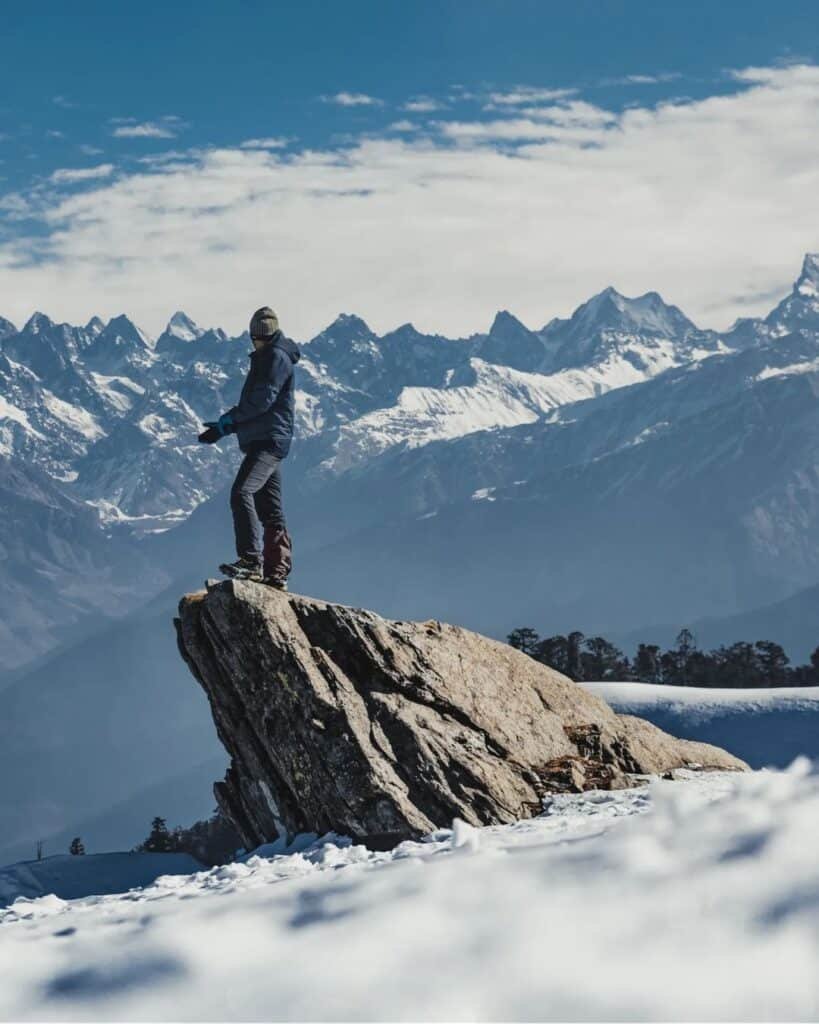
When planning your budget for the Kedarkantha trek , several essential factors must be considered to ensure a smooth and cost-effective journey.
- The average trekking fees for this adventure, charged by trekking organizations in India, typically range from ₹7,000 to ₹10,000 . These fees cover essential components such as accommodation , food , and guides .
- Transportation to the trek’s starting point should be accounted for whether you opt for flights, trains, or buses.
- While accommodation costs are already included in the trekking fees, it’s advisable to inquire about any additional charges for lodging before and after the trek.
- For necessary equipment and gear , renting items like trekking poles, sleeping bags, and jackets can offer a cost-effective alternative to purchasing them outright.
- While food and water are typically provided during the trek, having extra snacks or accommodating personal dietary preferences might prompt you to bring supplementary items.
- Additionally, setting aside a tiny budget for miscellaneous expenses , such as local purchases or unexpected costs, is prudent to ensure you are prepared for unforeseen circumstances.
By considering these factors and creating a comprehensive budget, you can embark on the Kedarkantha trek with financial clarity, enabling you to enjoy this enriching Himalayan experience.
How To Reach
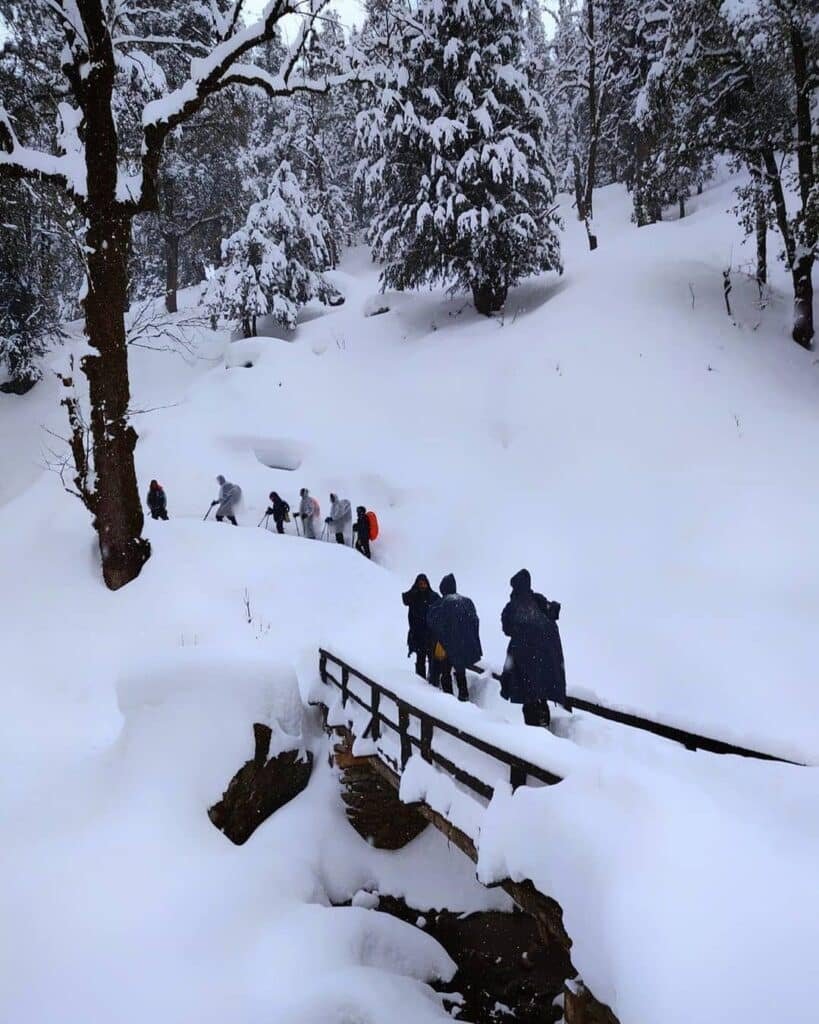
- Flights to Dehradun : The fastest option to reach Dehradun, the gateway to the Kedarkantha trek, is a flight from your city to Dehradun’s Jolly Grant Airport . Several airlines operate daily flights, offering convenience and reduced travel time. However, flight costs can vary depending on the time of booking and availability.
- Trains to Dehradun : Train travel is another viable choice. You can board a train from Delhi to Dehradun Railway Station . While the journey may take longer than a flight, it provides a more scenic experience and can be cost-effective. Be sure to check train schedules and book your tickets in advance.
- Buses to Dehradun : Buses also connect Delhi to Dehradun, providing a budget-friendly alternative. Various bus operators offer overnight services, allowing you to save on accommodation costs. The journey may take longer than a flight, but it provides a cost-effective mode of transportation.
- Trek Organization Pick-Up and Drop : Most trekking organizations arrange pick-up and drop services from Dehradun to the trek’s starting point in Sankri. This option provides convenience and ensures a seamless transition from arrival to the hike’s beginning.
- Best and Cheapest Option : Considering convenience and cost, the best and cheapest option may be to take a train to Dehradun. Trains offer affordability, a scenic journey, and the possibility to choose from various travel classes. Also, trekking organizations’ pick-up and drop services can simplify your travel logistics.
By selecting the most suitable transportation method based on your preferences and budget, you can ensure a smooth and enjoyable start to your Kedarkantha trekking adventure.
Highlights of the Kedarkantha Trek
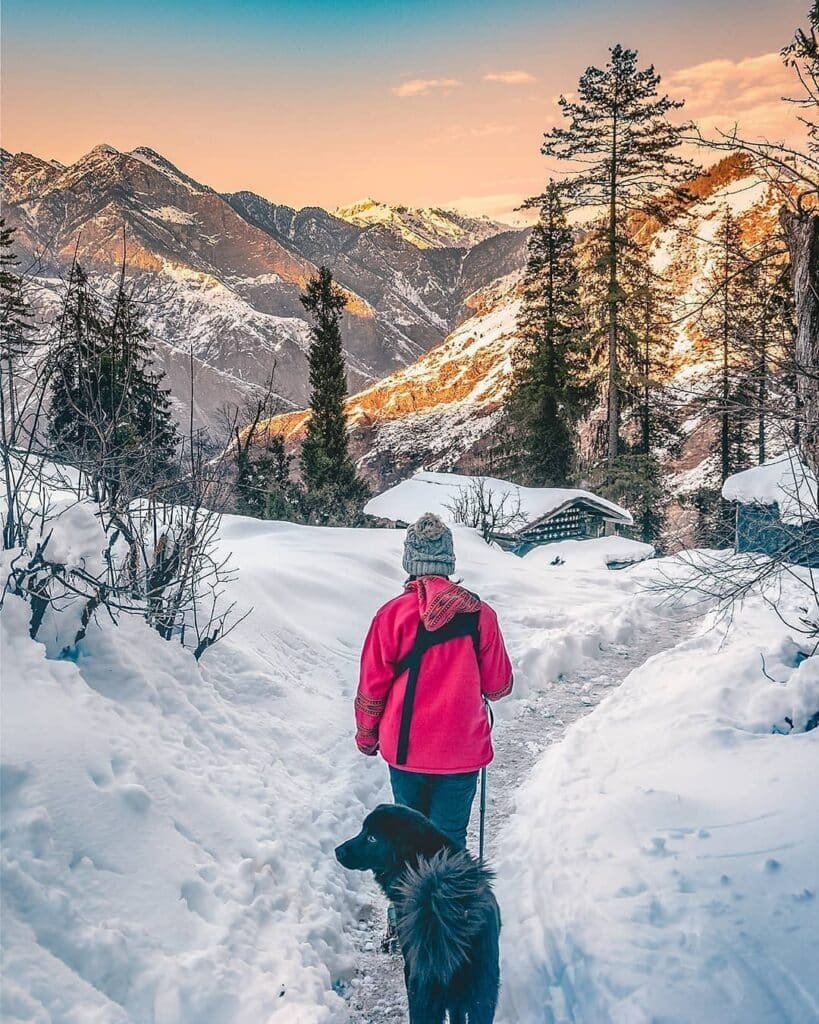
The Kedarkantha trek is a mesmerizing expedition that promises an array of captivating highlights , making it a cherished Himalayan experience.
- Panoramic Summit Views : The ultimate highlight is reaching the 12,500 feet high Kedarkantha summit , rewarding trekkers with awe-inspiring vistas of renowned peaks, including Swargarohini, Bandarpoonch, and Black Peak . This breathtaking panorama stands as a testament to nature’s grandeur.
- Enchanting Winter Wonderland : Embark on this trek during winter to witness the trail transforming into a magical snow-covered wonderland . Every step takes you through a pristine landscape adorned in glistening white, creating an enchanting ambience.
- Picturesque Camping Sites : The trek offers remarkable camping opportunities at Juda-Ka-Talab and the Kedarkantha base , allowing you to relish the serenity of starlit nights amidst the Himalayas. These campsites create cherished memories of nature’s tranquillity.
- Charming Local Villages : The trail meanders through charming local villages like Sankri , providing a glimpse into the region’s rich culture and traditions . Engage with the warm-hearted locals, experience their way of life, and cherish the sense of community.
- Diverse Landscapes : As you ascend, encounter a diverse range of landscapes, from dense pine forests to vast, undulating meadows like Hargaon . Each step unveils a new facet of nature’s beauty.
- Thrilling Winter Adventure : The challenging terrain, especially during the winter months, adds an element of adventure and excitement . Traversing through snow-laden paths and conquering steep ascents creates a thrilling sense of accomplishment.
- Starlit Night Skies : Away from the city lights, the trek offers a chance to gaze upon a glittering expanse of stars, creating a breathtaking night sky that adds a touch of magic to your journey.
- Cultural Insights : Interact with the local Garhwali communities, learning about their daily lives, traditional practices, and heartwarming stories, which enrich the trekking experience.
- Personal Achievement : Scaling the Kedarkantha summit is a physical accomplishment and testament to your determination and spirit. The sense of achievement you gain as you stand atop the summit is a memory that will stay with you forever.
The Kedarkantha trek seamlessly weaves these highlights into a captivating journey. It is a cherished chapter in any trekker’s Himalayan adventures.
Kedarkantha Trek Itinerary

Day 1: Dehradun to Sankri (Travel)
- Travel : Depart from Dehradun to Sankri via road (around 8-10 hours).
- Highlight Scenic drives through charming villages and lush landscapes.
Day 2: Sankri to Juda-Ka-Talab
- Distance : Approximately 4-6 kilometres
- Time : About 4-5 hours
- Highlight trek through dense pine forests , crossing streams, and reaching Juda-Ka-Talab – a serene lake surrounded by tall trees.
Day 3: Juda-Ka-Talab to Kedarkantha Base
- Distance : Around 3-4 kilometres
- Time : Approximately 3-4 hours
- Highlight trek to the Kedarkantha base camp , passing through clearings and experiencing a gradual change in landscape.
Day 4: Kedarkantha Base to Kedarkantha Summit and back to Hargaon Camp
- Distance : About 6-7 kilometres (summit and back to Hargaon Camp)
- Time : 8-10 hours in total
- Highlight the Challenging ascent to the Kedarkantha summit (12,500 feet), offering breathtaking panoramic views. Descend to Hargaon Camp.
Day 5: Hargaon Camp to Sankri
- Distance : Approximately 4-5 kilometres
- Time : About 3-4 hours
- Highlight : Descend back to Sankri, passing through local villages and enjoying the last leg of the trek.
Day 6: Sankri to Dehradun (Travel)
- Travel : Return from Sankri to Dehradun (8-10 hours) via road.
- Highlight : Reflect on the incredible journey while driving through picturesque landscapes.
Key Landmarks and Highlights :
- Juda-Ka-Talab : Tranquil lake amidst the forest.
- Kedarkantha Base : Campsite surrounded by towering peaks.
- Kedarkantha Summit : Majestic views of Swargarohini, Bandarpoonch, and Black Peak.
- Hargaon Camp : Overnight stay with the beauty of the Himalayas.
- Local Villages : Cultural insights and interactions with Garhwali communities.
- Sankri : Charming village with rustic charm and gateway to the trek.
This detailed itinerary ensures you experience the best Kedarkantha trek while allowing time to acclimatize, relish the natural beauty, and conquer the summit. Trekking times may vary based on individual fitness levels and weather conditions.
As your footsteps echo the trails of the Kedarkantha trek, we hope this guide has illuminated your path and kindled a sense of wanderlust within you.
The majestic peaks, snow-covered landscapes, and the camaraderie of fellow trekkers await your embrace. Remember, the Kedarkantha trek is not just about conquering heights but about discovering your strength and forging lasting memories. Whether you find solace in the whispering pine forests, stand humbled at the summit’s edge, or connect with the warmth of local culture, this journey is a testament to your spirit of adventure.
So, go forth with determination, let the Himalayas weave their magic, and may the memories you gather on these trails be etched in your heart forever. Your Kedarkantha story begins here – one step at a time.
The Kedarkantha trek is classified as easy to moderate, with challenging terrains, steep ascents, and varying weather conditions. Adequate physical fitness and preparation are recommended.
The cost of the Kedarkantha trek varies based on factors such as trekking organization, duration, and inclusions. On average, trekking fees range from ₹7,000 to ₹10,000, covering accommodation, food, and guides. Additional costs may include travel to the start point and equipment rental.
The Kedarkantha trek typically spans 4-6 days, covering approximately 20-25 kilometres. Due to the trail’s length and altitude cannot be completed in just one day; proper acclimatization and multiple days of trekking are necessary for a safe and enjoyable experience.
The best time for the Kedarkantha trek is from November to March, during winter. This period offers stunning snow-covered landscapes, clear skies, and a chance to witness the region’s beauty at its peak.
Video of the Kedarkantha Trek
Video Credit: Soul Trails
Kuari Pass | Bhrigu Lake | Brahmatal Trek | Sar Pass Trek | Shrikhand Mahadev Trek | Buran Ghati Trek | Bali Pass Trek | Kareri Lake Trek | Kashmir Great Lakes Trek | Goechala Trek | Har ki Dun Trek | Hampta Pass | Rupin Pass | Sandakphu Trek | Dayara Bugyal Trek | Tarsar Marsar Trek
- Uttarakhand
- No comments yet.
Add a comment
Leave a reply · cancel reply.
Your email address will not be published. Required fields are marked *
This site uses Akismet to reduce spam. Learn how your comment data is processed .
- Share via...

Home » Categories » Treks » Kedarkantha Trek: A Complete Guide
Kedarkantha Trek: A Complete Guide
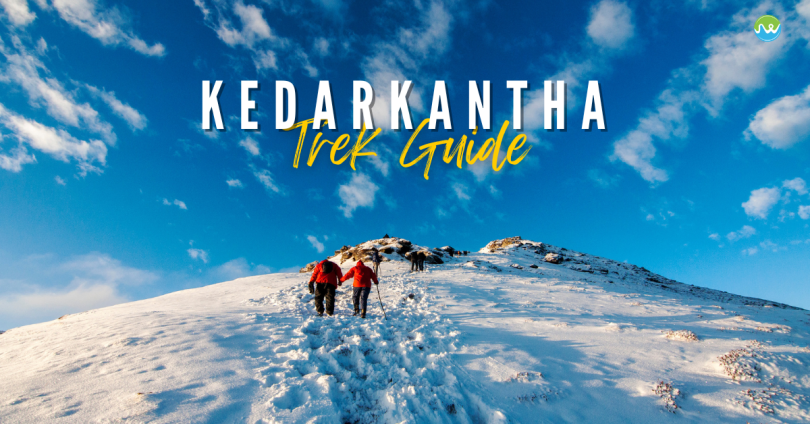
Imagine yourself standing in the middle of a forest, it’s barely a forest now because it’s fully covered in a white blanket. The trail will amuse you at every step. At this moment all you can think about is the mesmerizing summit view that is ahead of you….
Having difficulty figuring out where you are standing? This is none other than the breathtaking Kedarkantha Trek known as the queen of winter treks.
Kedarkantha Trek is nothing but an incredible 5 days packed with adventure, self exploration, and a sweet nap in the lap of nature. Nestled in the heart of Uttarakhand, the Kedarkantha Trek is a captivating winter trek known for its mesmerizing landscapes, serene forests, and sparkling streams. This incredible beauty is the reason behind Kedarkantha’s nickname – The Queen of Winter Treks. Starting from the quaint village of Sankri, the trail winds through lush green meadows, dotted with majestic pine trees, before culminating at the Kedarkantha Peak, standing tall at an altitude of 12,500 feet. Trekkers usually take 5 days to complete the trek.
All we can promise in this Kedarkantha Trek Guide is a complete and full experience of your Trek to Kedarkantha. Each day you will get the opportunity to do the snow walk and discover the winter wonderland in its full glory. All your doubts regarding the mesmerizing trek of Kedarkantha is going to get answers now, including the difficulty level of Kedarkantha, best time to visit Kedarkantha, what to look out for in Kedarkantha, peaks you can witness in this picturesque trek and more.
We cannot be held responsible if you find yourself experiencing the enchanting touch of snowy sparkles in your hands or feel an irresistible urge to leap out of your room to conquer the summit. What we can guarantee is that the memories you create during this trek, Kedarkantha, will linger vividly. Throughout the year, the trek ensures that your heart will be dusted with snow, preserving the cold and heartwarming moments you’ve crafted.
Basic Details
- State: Uttarakhand
- Altitude: 12500Ft.
- Base Camp : Sankri
- Duration: 5 Days .
- Trek Difficulty : Easy To Moderate
- Trek Length : 20km
Nothing matters when it comes to Kedarkantha Trek . If you are a novice or an experienced trekker, Kedarkantha is able to satisfy all your needs. With proper research and training, you can easily conquer the summit as well as you. Here comes the importance of this blog, all you need to know about Kedarkantha Trek is arranged here as you need it!
Let’s Dive into Kedarkantha Trek Guide Together!!
Table of Contents
Why Kedarkantha Is The Best Winter Trek In India
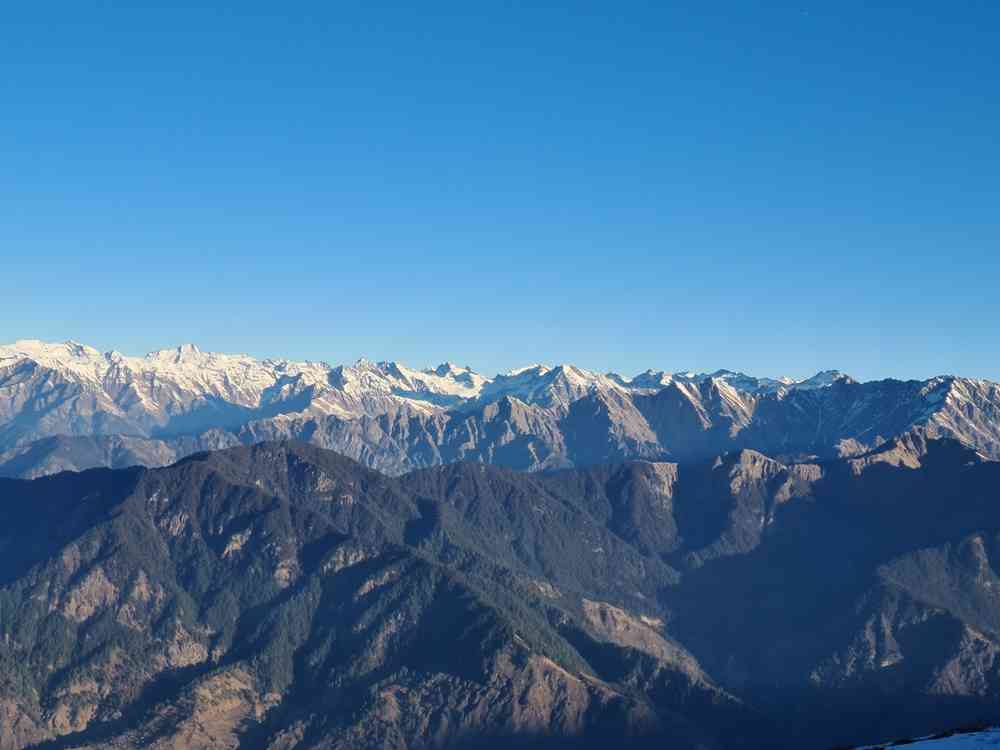
Ever wondered about the question of the best winter trek in India, the name Kedarkantha is likely to have crossed your exploration. If you are someone who is looking for reasons why to visit Kedarkantha, then you got your answer in 5 points- Snow, Forest, Frozen Lake, 360 degree Summit View and Camping experience.
What sets the Kedarkantha Trek apart is its unparalleled beauty during the winter season. As the temperature drops, the entire region transforms into a snowy wonderland, offering breathtaking panoramic views of the Himalayan range. It’s the perfect blend of challenge and charm, making it accessible to both experienced trekkers and beginners alike. No wonder it’s hailed as the best winter hike in India!
- Lush Green Meadows – After the month of March, the snow gradually recedes, revealing the lush green pastures adorned with vibrant flowers that thrive during the spring and summer seasons. The awe-inspiring vistas of nature are exclusively reserved for those who dare to embark on this journey
- Mind – Blowing Camping Experience – Prepare yourself for an extraordinary camping experience amidst the enchanting woodlands, deep within the dense forests of Govind Vihar National Park, nestled in the majestic Himalayas of Uttarakhand. Each campsite along this trek is unique and offers mesmerizing views of the surrounding landscape.
- Frozen Forests – As you embark on this trek, you will traverse through thick forests adorned with Himalayan Coniferous trees. Moreover, you will also trek through dense forests completely covered in ice, learning to set up camps on snow-covered clearings.
- Beginner’s Friendly Trek – This winter trek is perfect for beginners, offering a harmonious blend of natural beauty and thrilling adventure.
- Summit Climb – Brace yourself for an adrenaline-pumping summit climb, where thick layers of snow will challenge you until you reach the pinnacle.
- Winter Wonderland – During the winter months, you will have the opportunity to witness fresh snowfall, towering snow-capped peaks, and bitterly cold nights, creating an unforgettable trekking experience. Trekking on snow-covered mountains is truly a rewarding endeavor, making this classic winter trek one of the finest and most sought-after in the entire Himalayan region.
- Panoramic Views of Himalayas – From the summit, you will be treated to marvelous views that surpass all expectations, not only capturing the renowned peaks such as Gangotri, Bandarpoonch, Kalanag, Yamunotri, and Swargarohini range, but also numerous unnamed peaks.
- Photographer’s Paradise – There is an undeniable charm in this world, and being in the right place allows you to truly experience it. This trek is a haven of beauty, providing photographers with the perfect opportunity to capture breathtaking images of nature. Every frame resembles a picturesque postcard.
Another exciting reason why you should visit Kedarkantha peak is to experience the heart capturing sunrise and sunset that is waiting for you! Dear trekkers, let us assure you that the sunrise or sunset that you will encounter is going to be one of the best in your life.
What are you waiting for? Plan your Winter Escape Now!!
How To Reach Kedarkantha
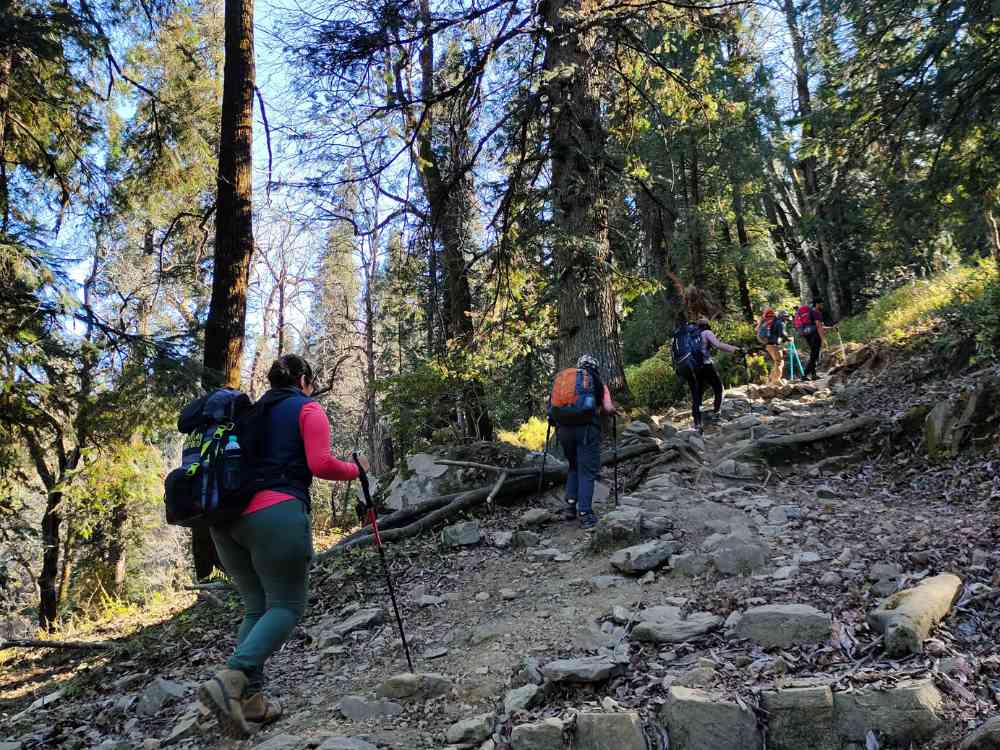
According to the Itinerary we preferred trekking starting from Dehradun. From there you can join your trekking team. If you are directly reaching the base camp that is Sankri, you can use the following commute options.
By Air: The closest airport to the city is Jolly Grant Airport in Dehradun, located approximately 25 kilometers away. There is a daily flight from Delhi to Dehradun. Once you reach Dehradun, you can either hire a taxi or use public transportation to reach the base camp.
By Train: If you are coming from Delhi, you have the option to take a train to Dehradun. There are frequent trains connecting Delhi and Dehradun, so you can choose to travel overnight. Upon reaching Dehradun, you can then take a private vehicle or a bus to Sankri.
By Road: Regular bus services are available from Delhi to Dehradun. It is recommended to take a Delhi government bus from Kashmere Gate to Dehradun. Once you arrive in Dehradun, you can either use public transportation or rent a private vehicle to reach Sankri.
The Kedarkantha Summit is located in the Govind wildlife National sanctuary Park of Uttarkashi, and it is important for you to be aware of this. This magnificent peak is surrounded by numerous picturesque river valleys, which are also referred to as the upper valley of Garwal. These remote villages have been inhabited by the villagers since the time of the Mahabharat Period, adding to the historical significance of this area.
Extra Toppings for You – The origin of the name Kedarkantha stems from a captivating tale that suggests the Kedarnath temple was initially intended to be constructed in that very location. However, as the skilled artisans were diligently sculpting the divine figures of Lord Shiva, an unexpected sound resembling that of a cow resonated nearby. In accordance with the prevailing beliefs of Hindu mythology at that time, this was perceived as an ominous sign, leading the craftsmen to abruptly halt their work. Consequently, only the upper portion of Lord Shiva’s sculpture, encompassing the majestic neck, was completed. Thus, the mountain came to be known as Kedarkantha, forever preserving the essence of this mystical legend.
READ MORE: Everything You Need To Know About Kedarkantha Trek
Distance Chart For Kedarkantha Trek
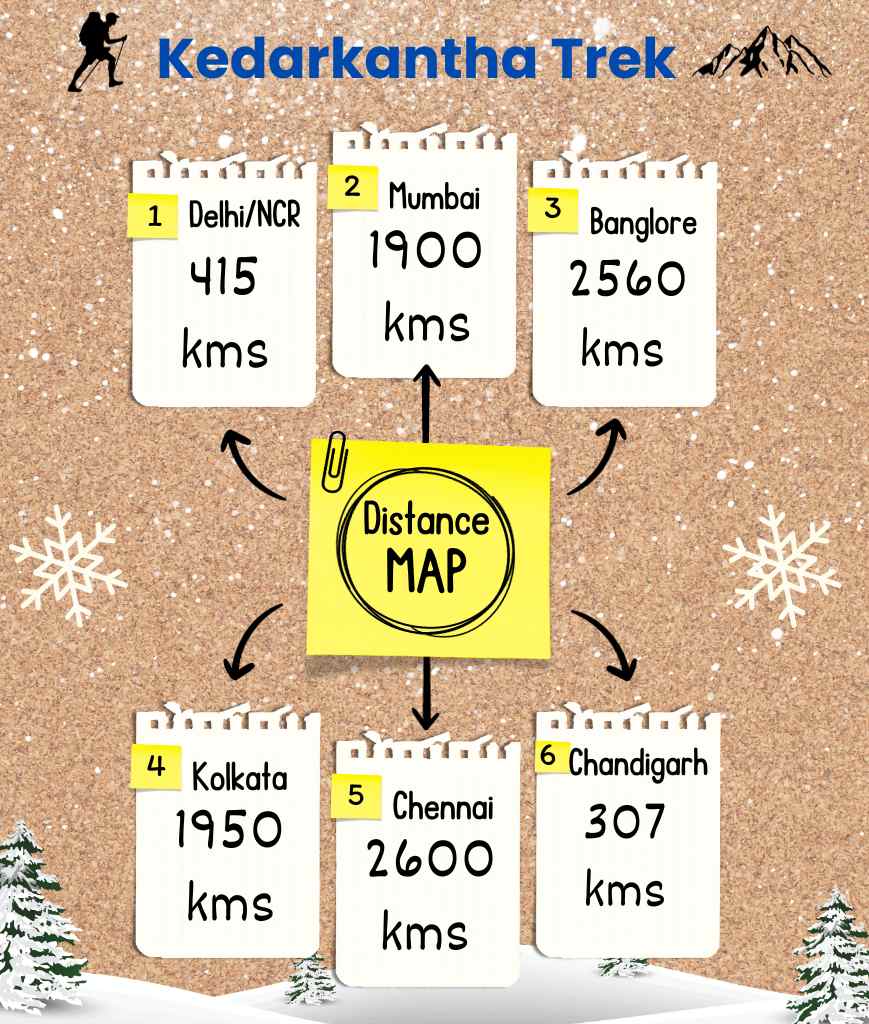
Preferred Route for Kedarkantha Trek
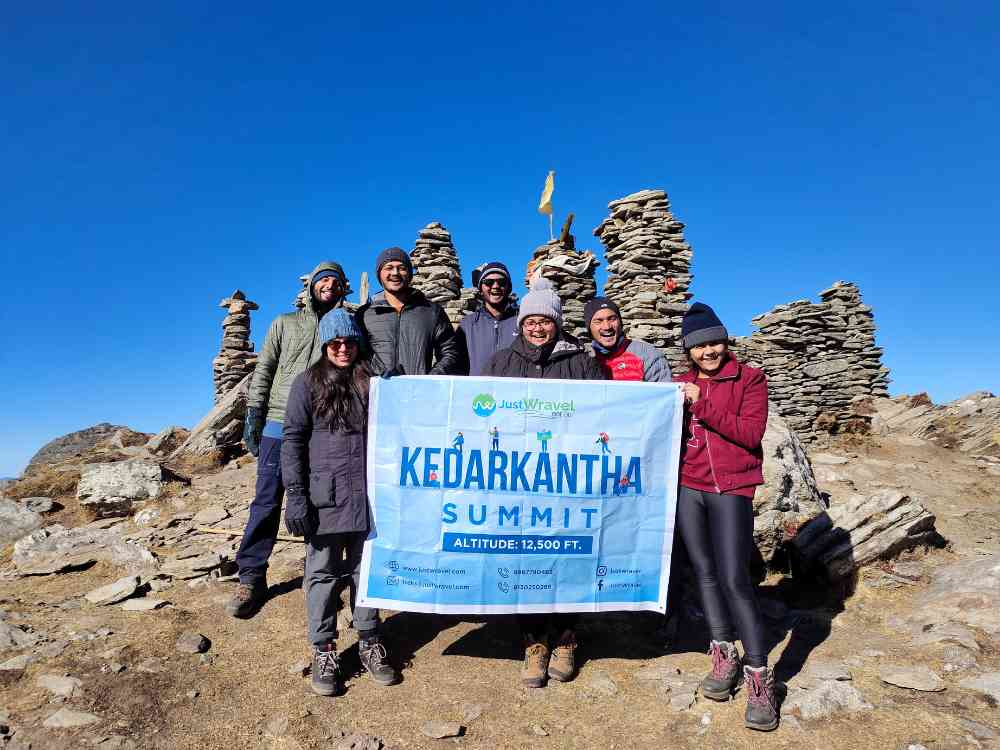
- Day 1 : Drive From Dehradun To Sankri Base Village (198 Kilometers, 8 Hours Drive )
The journey begins with a beautiful 8-hour drive from Dehradun to a tiny hamlet Sankri in Mori Tehsil, in the Uttarkashi district of Uttarakhand. The drive by the Yamuna and Tons rivers, surrounded by dense forests, and taking in nature’s splendor is the best start. Sankri Village provides you with comfort and peacefulness before embarking on your trek to Kedarkantha. In addition, it is a gateway to the spectacular Govind Pashu National Park and starting point for a total of 7 treks. There is an overnight stay at the homestays in the village, and it sets your mood right for the journey ahead. You will get a peaceful sleep at this beautiful hamlet and a well-needed rest before trekking.
- Day 2 : Trek from Sankri to Juda Ka Taal (4 Kilometers, 4 Hours Trek)
On day 2 of our Kedarkantha trek , we climb to the Juda Ka Taal which takes up to 4 hours. We would be passing through luxuriant green forests of pine trees en route to our camping site, with the Swargrohini Massif in the background beckoning you closer. Juda Ka Taal is a breathtakingly beautiful lake with an interesting story behind it. People believe that Lord Shiva opened a tiny clamp of his hair from which water started to drip down. This resulted in the creation of this massive lake. After trekking for four hours, you can indulge in lip-smacking food. Followed by a day at leisure. You could stay in comfort at the campsite under the starring sky.
- Day 3 : Juda Ka Taal To Kedarkantha Base Camp (3 Kilometers, 3 Hours Trek)
Next, we head towards the base camp of Kedarkantha after indulging in morning tea by the stunning river. It is a 3-kilometer trek that takes around three to four hours to reach. Additionally, on the way, the breathtaking view of the snow-covered Himalayan peaks of Bandarpoonch, Kala Nag, Swargarohini, and Ranglana will leave you spellbound. Upon reaching the base camp, you can feast on delicious food after a short trek. It would be a rejuvenating day afterward. Followed by an overnight stay at camps with the excitement for the day you have been waiting for.
- Day 4 : Trek To Kedarkantha Peak | Back To Juda ka Taal (9 Kilometers, 8 Hours Trek)
Finally, the wait ends, and you will get to be closer to your dream view from the summit of Kedarkantha. The trek is 8 kilometers long and will take you approximately 9 hours to reach. Hence, an early start to the trek is the way to go! On the trails, you will get warm greetings from Yamunotri and Gangotri ranges. In addition, with Kinner Kailash ranges as well. The whole trail is filled with scenic views and beautiful dense forests. Upon reaching the summit, you will get to experience the best sunrise of your life. The sun peeking through the forest, and the light on you will give you a glow like no other. The feeling of overcoming hurdles and accomplishment will stay with you for life. Post-spending some quality time, we would be trekking back to the base camp. You can then treat yourself to some delicious food. Followed by an overnight stay at the Juda Ka Taal campsite after a long day full of adventures.
- Day 5 : Juda ka Taal To Sankri (4 Kilometers, 4 Hours Trek) | Back To Dehradun (8 Hours Drive)
After a nutritious and delicious breakfast, we start back our journey to Sankri village. It will take us approximately 4 hours to Trek. Upon reaching the village, we will spend some time refreshing ourselves and having lunch while appreciating the simple and raw local life of the village. Soon after that, we will head back to Dehradun with a bag full of great memories and newfound companions who share the same zeal for trekking as you!
EXTENDED READ: Detailed Itinerary For Kedarkantha Trek
Tip From JW The temperature on the Kedarkantha trek varies between 15°C and -5°C, necessitating the need for ample warm clothing regardless of the time of year. Given the cold and freezing weather conditions, it is advisable to have an adequate supply of moisturizer to maintain the health of your skin.
Kedarkantha Trek Route
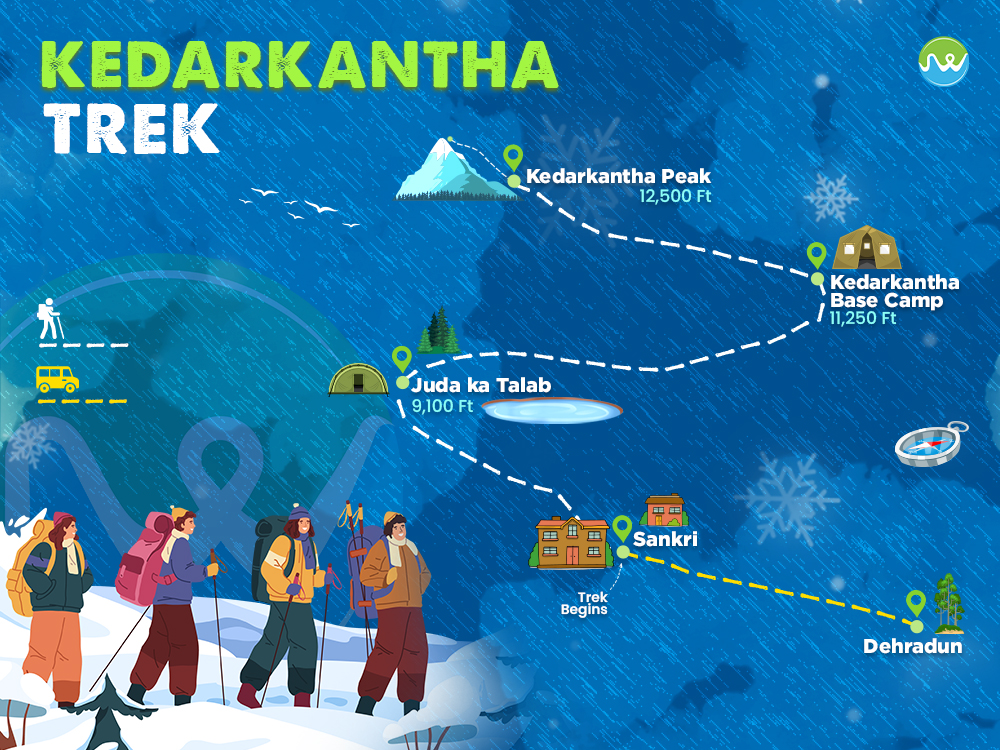
Who Can Participate In Kedarkantha Trek
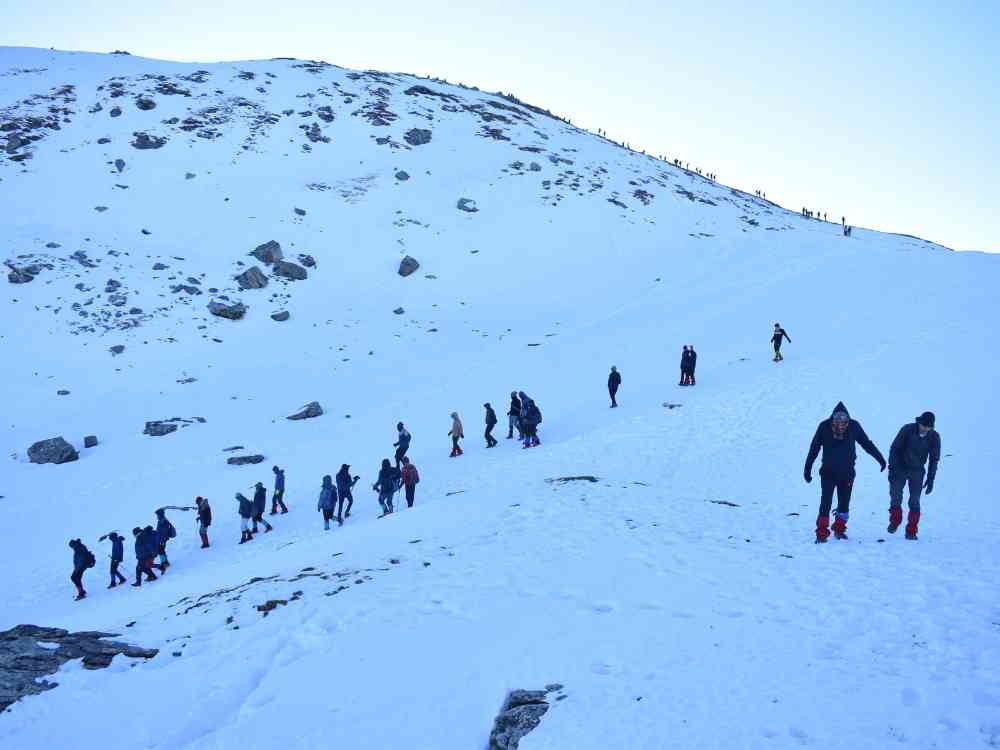
Kedarkantha Trek is unquestionably the best winter trek in India. Falling under the category of easy to moderate, it becomes accessible to all. Whether you are a novice or an experienced trekker, the snowy forests and frozen lakes of Kedarkantha will surprise you. With proper training and preparation, conquering the Kedarkantha summit becomes easily achievable. Children above the age of 15 years can participate in the trek. You can commence your preparation 15-20 days prior to your trekking date. A Kedarkantha Trek Guide is not complete without addressing this question.
Read the below part on How to Prepare for Kedarkantha Trek to get a better grasp.
Best Time For Kedarkantha Trek
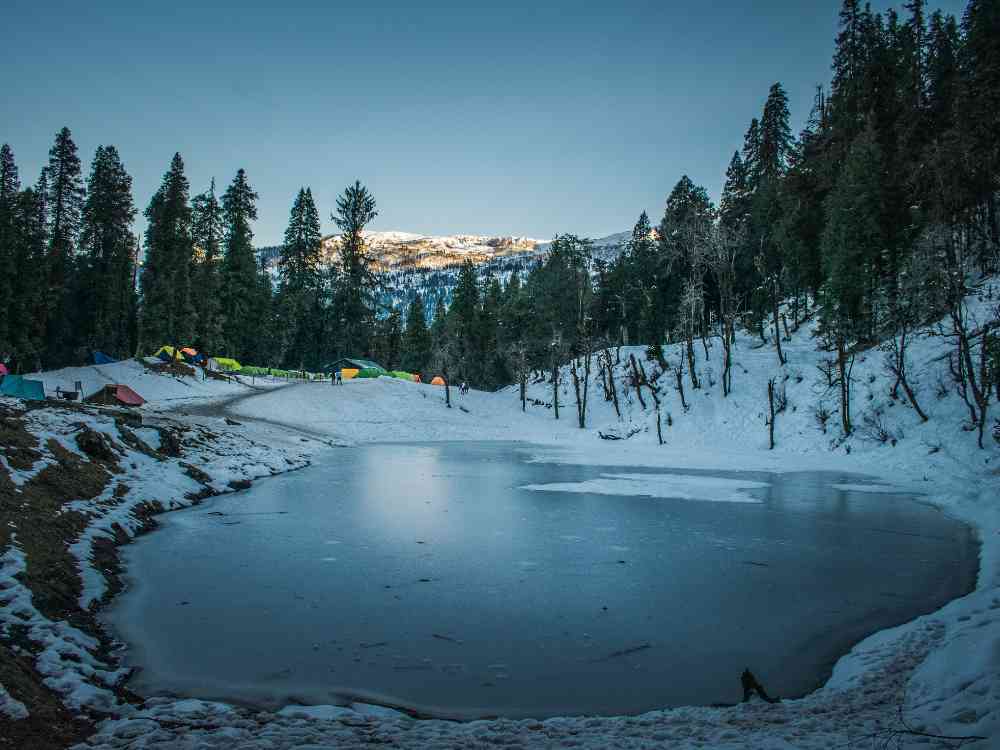
The Kedarkantha trek is unique among the Indian Himalayas as it can be done all year round, except for July and August when it is closed due to heavy rainfall. The trek is divided into four seasons, each offering its own distinct terrain, difficulty, and weather conditions.
Winter – November to March
During December, January, and February, Kedarkantha is famous for its winter journey. The snow-covered landscapes and thrilling summit ascent make it a popular choice, especially for beginners. You will trek through deep snow-covered forests and set up camps in clearings amidst the snowdrifts.
Spring
In March and April, Kedarkantha still retains a significant amount of snow, particularly in the upper campgrounds near the summit. The blooming rhododendrons and newly exposed grasses create a stunning contrast against the snowy backdrop as you ascend higher. By April, most of the snow has melted, and Kedarkantha comes alive with the beautiful scenery after its winter slumber.
Summer
May and June bring the brilliant morning sun to Kedarkantha. The nights are not as cold as in other months, and there is a lower chance of rainfall. This is also the time when the trail is less crowded, as most people have moved on to higher altitude hikes. If you prefer a more solitary experience, May and June are the perfect months to visit.
Monsoon
September, October, and November mark the post-monsoon season when the entire journey comes to life. The meadows and forests are fresh and vibrant, and the air is crisp. The upper Himalayan vistas are breathtaking during these months.
Overall, the Kedarkantha trek offers something unique in each season, and whether you prefer the snowy winter landscapes, the blooming spring scenery, the sunny and less crowded months of May and June, or the fresh post-monsoon experience, there is a perfect time for everyone to embark on this adventure.
READ MORE: Har Ki Dun Guide
Tip From JW Dehydration is a contributing factor to altitude sickness, hence it is crucial to stay hydrated.
Highlights of Kedarkantha Trek
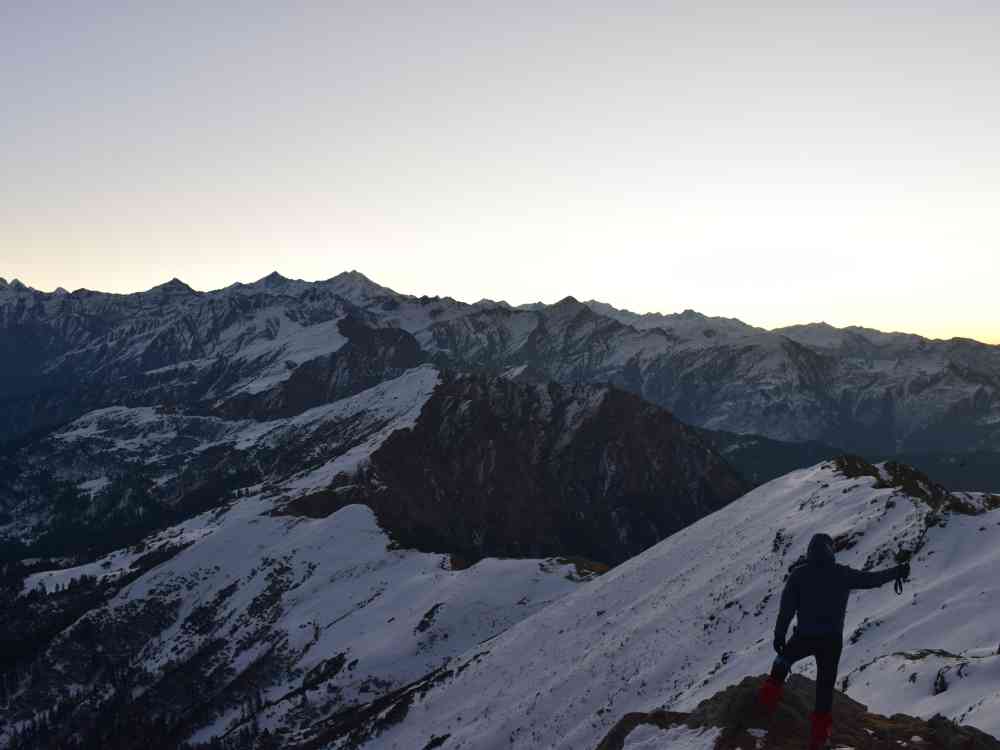
- Frozen Lake – Juda ka Talab, situated in the Govind Wildlife Sanctuary in Uttarakhand, India, is a picturesque high-altitude lake. Here are some of the captivating features of this enchanting destination
- Accessibility – The Kedarkantha trek is conveniently reachable from major cities such as Delhi, making it a sought-after weekend escape.
- Pinnacle View – Once you conquer the summit, a mesmerizing vista of the Garhwal mountains awaits, leaving you in awe. Black Peak, Bandarpoonch, and Swargarohini are all captivating sights that make the arduous climb worthwhile. Moreover, from this vantage point, you can also catch a glimpse of the renowned Har ki Dun Valley.
- Enchanting Campsites – The campsites along this trek are truly unparalleled in the Himalayas of India. Khujey, nestled amidst lush green forests, is a picturesque meadow that exudes tranquility. Another delightful camping spot is Bhoja Dadi, which is conveniently closer to the Kedarkantha trail. Numerous campsites dot the lake’s vicinity, providing an opportunity to spend the night under a star-studded sky and immerse oneself in the serene ambiance of the surrounding wilderness.
- Sankri Village – Embarking on the journey to Kedarkantha begins in the humble village of Sankri. Immersed in tranquility, this rustic hamlet serves as a delightful appetizer for the exhilarating experience that lies ahead. Its picturesque beauty, coupled with the warm hospitality of the locals, offers a soothing retreat before the arduous ascent.
- Juda Ka Talab Campsite – Nestled amidst a pristine blanket of snow, the Juda Ka Talab campsite is a bewitching location that captivates trekkers with its serene allure. As the sun sets behind the mountains, the sky transforms into a vibrant canvas of colors, presenting a mesmerizing spectacle.
- Cultural Immersion – Engaging with the locals enriches the trekking experience, infusing a cultural dimension into the journey. The heartwarming tales they share about the region’s folklore and traditions provide a profound cultural context, elevating the journey beyond a mere physical climb.
- Stargazing at Night – The night sky at Kedarkantha, untouched by the city’s light pollution, offers an astronomical extravaganza. With countless stars adorning the dark canvas, the experience of stargazing here is truly unforgettable.
- Kedarkantha Peak – The final ascent to Kedarkantha peak is a rewarding endeavor in its own right. The awe-inspiring panoramic view of the majestic Himalayan range from the summit leaves trekkers spellbound, making every step of the challenging journey worthwhile.
- Natural Beauty and Adventure – The Kedarkantha Trek is not solely about reaching the summit. It embraces the raw beauty of nature, from lush meadows to snow-capped peaks and expansive forests. The thrilling adventure of traversing rugged terrains to conquer the top adds an exhilarating rush to the journey.
- Bird Watching – With its diverse range of bird species, including Himalayan monals, snow pigeons, and koklass pheasants, Juda ka Talab is a haven for avid bird watchers.
- Flora and Fauna – The lake is encircled by dense forests teeming with rhododendron, oak, and deodar trees, providing a habitat for various wildlife species like musk deer, bharal, and leopards.
- Religious Significance -Locals hold the lake in high regard, considering it sacred and believing in its connection to the Mahabharata epic.
Dear Girls, Get Ready for ALL GIRLS KEDARKANTHA TREK
Kedarkantha Temperature Chart
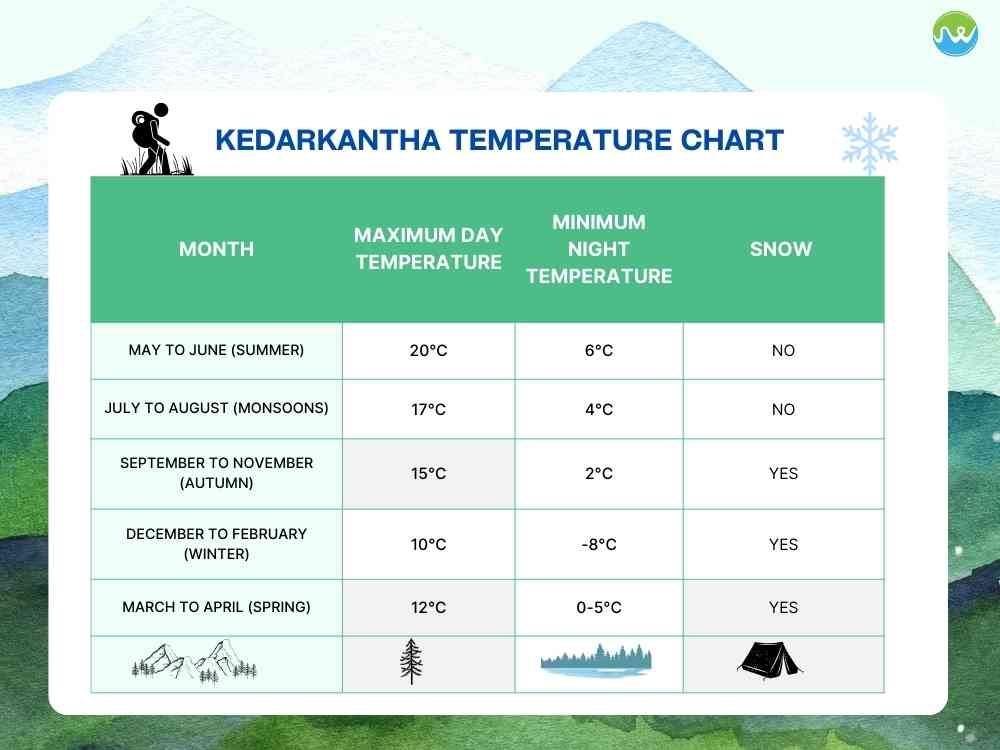
At night, the temperature in this area plummets to 10 degrees or even lower. However, it is important to note that such extreme temperatures can be endured with some caution. This is precisely why numerous tourists flock to the starting point of this trek, known as Sankri, particularly during the months of December, January, February, and March each year.
EXTENDED READ – A Guide to AMS
Kedarkantha Trek Difficulty Level
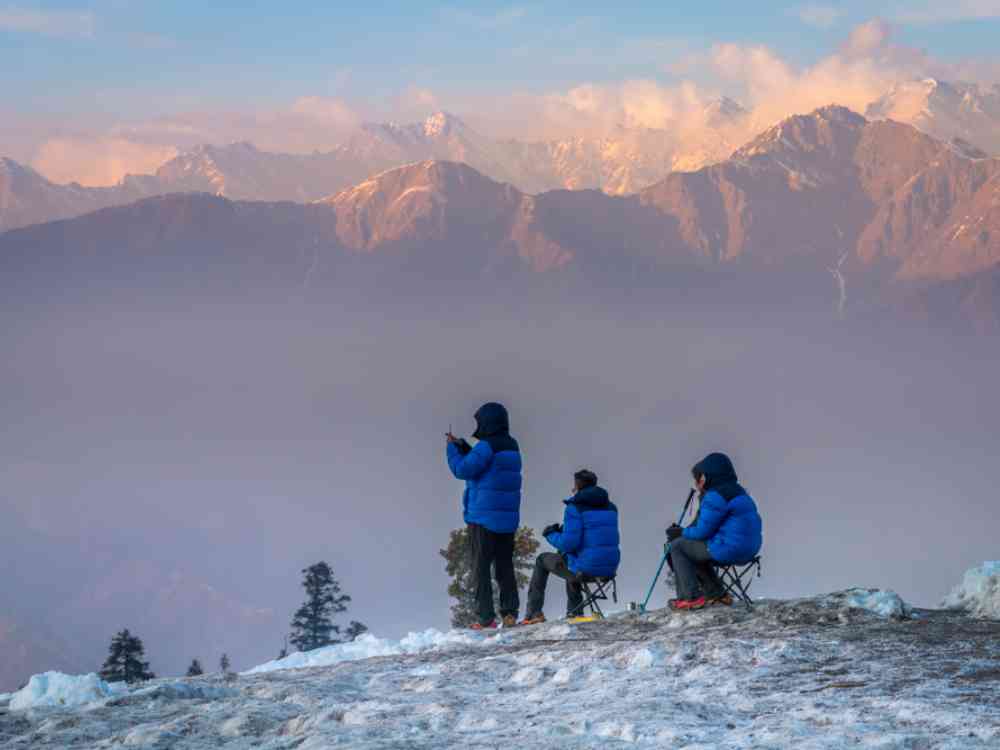
This Kedarkantha Trek Guide is designed to answer all your questions, Here comes the answer of one of the most debated question.
The Trek falls under the category of easy to moderate. The Kedarkantha Trek , a 25 km route, takes you from an elevation of 6,400 feet to 12,500 feet, making it one of the easier treks in Uttarakhand. It is an ideal choice for beginners who wish to experience the wonders of trekking in the majestic Himalayas. Furthermore, the duration of the summit day is quite extensive. You can expect around 7-8 hours of trekking on the summit day, with approximately 5 hours of steady ascent and 2-3 hours of rapid descent. This puts a strain on the legs, requiring a good level of fitness to complete the day comfortably. Considering all these factors, the trek has been categorized as easy-moderate.
The relatively short distance allows you to take your time, immersing yourself in the breathtaking surroundings, and capturing unforgettable moments, enhancing the overall spiritual experience. Upon reaching the summit and witnessing the other peaks at eye level, a profound sense of humility washes over you, providing immense satisfaction. Additionally, Kedarkantha is a standalone mountain, offering multiple routes to the summit. This not only adds to the adventure but also ensures safety, as there are various exit routes available. This is particularly beneficial for solo trekkers. Although Kedarkantha encompasses all the characteristics of an easy trek, its summit climb elevates its difficulty level to easy-moderate. The climb to the summit is long and steep.
Tip From JW To ensure safety, it is important to stay with your group and follow the guidance of your guide.
Things to Carry for Kedarkantha Trek
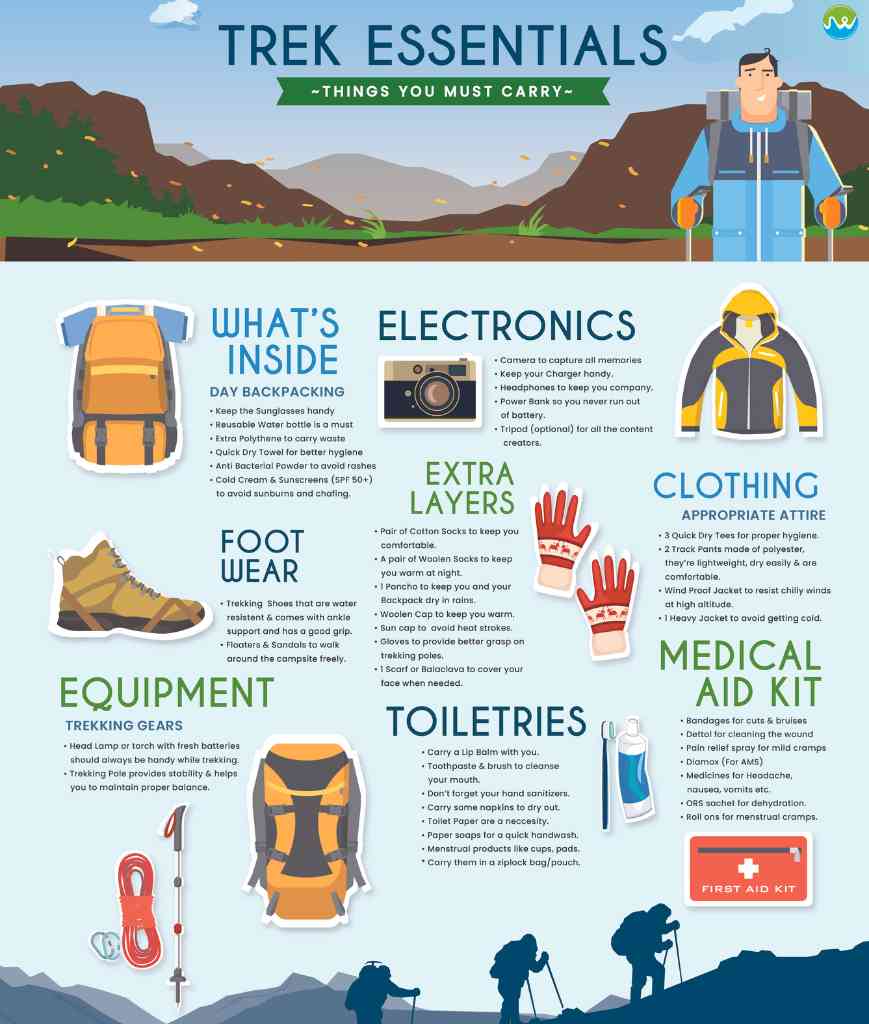
Going for a trek like Kedarkantha can be very exciting and take you over the moon for sure. But don’t drown your responsibilities of preparing everything for the trek in that excitement. Here is a detailed list of Things to Carry for Kedarkantha Trek.
- Documents – Please make sure you are carrying all your necessary documents with you. First of all bring a government ID card, you can choose anyone from this like Aadhar Card, Driver’s License, Voters ID, and so on. If you are a foreigner please make sure to carry your passport and visa, this part is not applicable for Indian Trekkers. Make ready your medical certificates and certificate of declaration ready in hand.
- Trekking Necessaries – Bring a Backpack that is capable of carrying 50 – 60 liters with enough support. Also note here you need a rain cover for your backpack. The weather in mountains is always unpredictable and you should be prepared for any kind of changes.
- Trekking Shoes – Trekking shoes is an important part of the trek like Kedarkantha. It is crucial to have durable and supportive shoes for trekking. Although some may question the comfort of sports shoes, it is advisable to opt for the right trekking footwear.
- Trek Pants – Jeans are never suitable for a journey, so it’s essential to have 2-3 pairs of trekking trousers for shorter trips and even more for longer treks.
- Jacket – A must-have on any hike as it shields you from the elements. Therefore, if you’re embarking on a week-long hike, make sure to bring along two coats.
- Layers of Warm Clothing – Don’t forget to pack warm woolen layers or cozy fleece. In winter, it’s advisable to carry at least two to three layers, while in summer, you can get away with fewer garments.
- Thermals – As temperatures tend to drop at night, it might be necessary to have thermals on hand.
- T-Shirts – Don’t leave behind your quick-drying t-shirts.
- Poncho – If you’re planning a hike on a rainy day, a poncho will keep you dry.
- Medical Kit – It is also Important for you to maintain a personal Medical Kit with all the medicines you need from time to time. The kit should include items like Diamox, Digene, Crocin Advance , Aspirin/Combiflam, Disprin, Avomine, Avil, Norflox TZ & Lomofen, Ranitidine, Volini/Moov spray, Betadine/Savlon, ORS, Band-aid, Cotton, Stretchable/Elastic bandage and Gauz.
Other Necessary Items Include
Is Kedarkantha and Kedarnath the same?
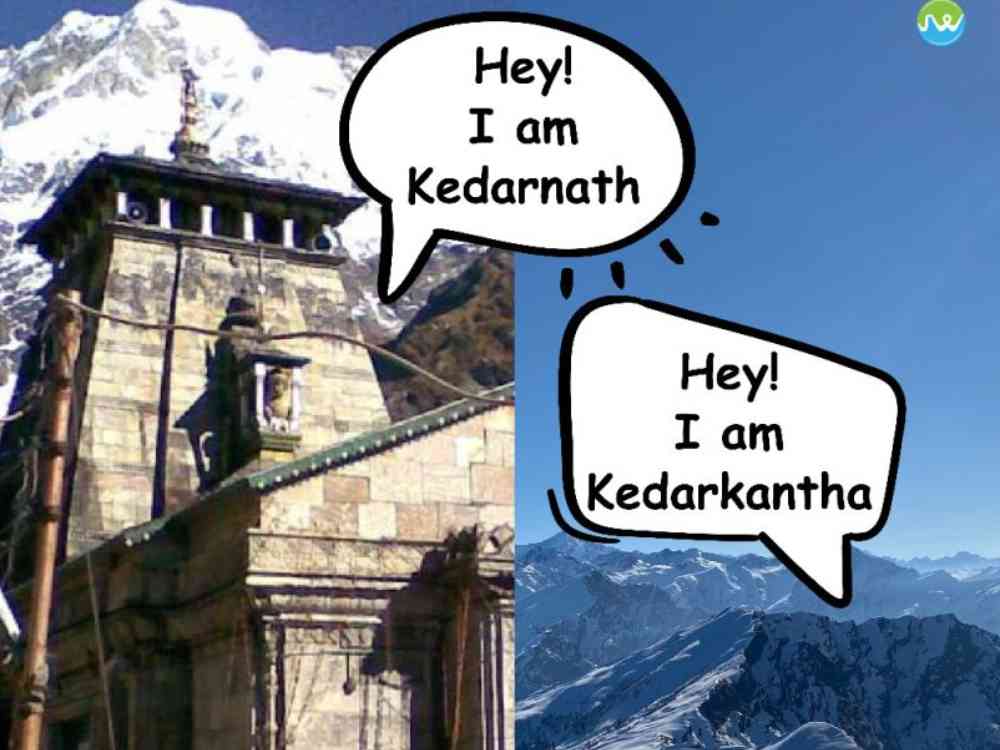
Kedarkantha is a winter wonderland and a beginner-friendly trek where Kedarnath is a part of Panch Kedar and a true spiritual journey. Kedarkantha and Kedarnath – two distinct adventures in the heart of the Himalayas. But what sets these two treks apart? First, let’s talk about location. Both are in Uttarakhand, but Kedarkantha kicks off from the picturesque Sankri village, while Kedarnath begins its journey at Gaurikund. Kedarkantha Trek is a year-round delight, but winter steals the show with its mesmerizing snowscapes. On the other hand, Kedarnath Temple opens only from May to November each year. Altitude matters, right? Kedarkantha stands tall at 12,500 ft, Meanwhile, Kedarnath Temple perches at 11,755 ft. Ready for the trekking challenge? Kedarkantha beckons you with a 20 km trek from Sankri and Kedarnath demands a 22 km journey from Gaurikund, one way. The choice is yours! Whether it’s the snowy wonderland of Kedarkantha or the spiritual journey to Kedarnath, Uttarakhand has it all. So, which path will you choose for your next adventure?
Still Confused? READ IT THROUGH HERE
Is a Guide Necessary for Kedarkantha
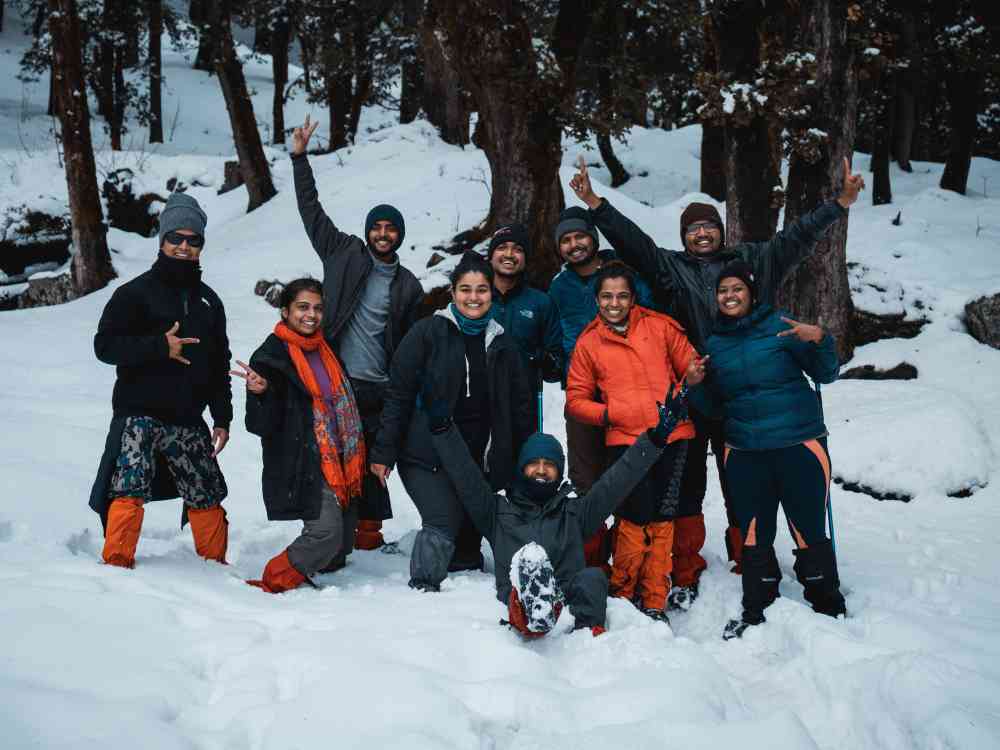
Having a guide will help you attain the permit to enter the Kedarkantha region. This is issued by Govind Vihar National Park. Unless you possess extensive experience, it is not advisable to venture alone into the wilderness, particularly during long treks. It is recommended to explore remote wilderness areas in the company of experienced professionals or certified tour guides. Having an expert guide provides a better understanding of unfamiliar terrains. If you are trekking with JustWravel, you don’t have to worry about Permit for Kedarkantha, it is included in your package. There are two important guides you need for Kedarkantha, one is this Kedarkantha guide and another is trek guide.
Where to Stay in Sankri
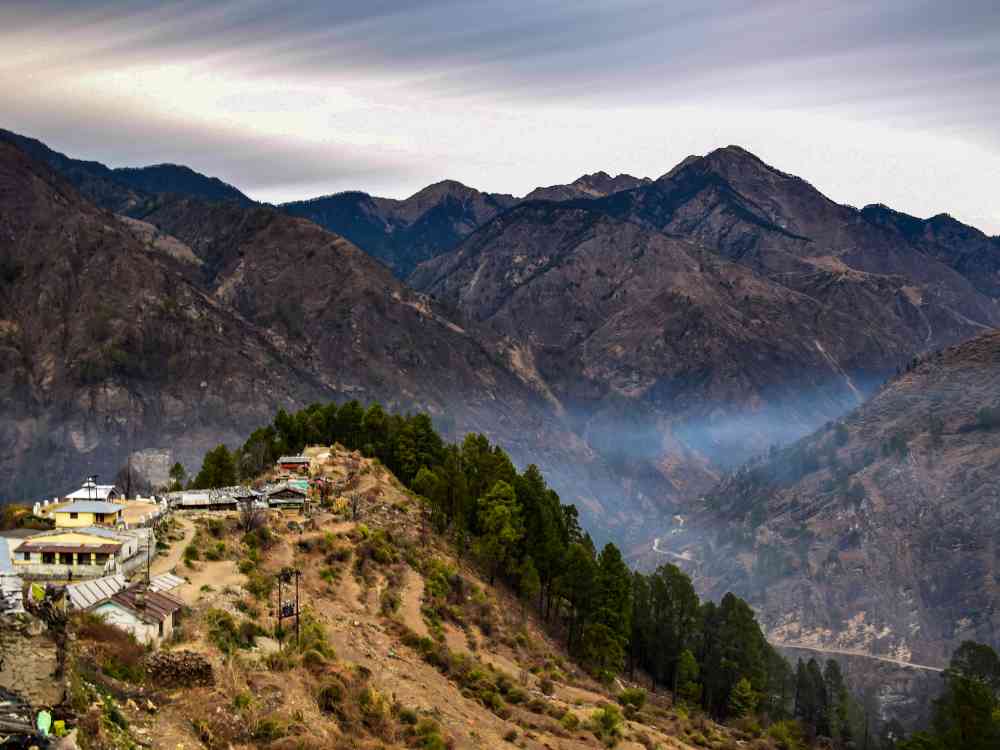
Once you have arrived at Sankri, the next essential step is to secure accommodation. Sankri offers a limited number of hotels and cozy homestays for trekkers and tourists. However, during the peak season, these establishments are often fully booked by trekking companies. Therefore, if you fail to pre-book your stay, you may find yourself in a predicament. As Sankri is a secluded Himalayan village, it is highly recommended to opt for a local homestay or a quaint lodge, as this will provide you with an authentic experience of village life in the Himalayas. It is important to note that Sankri does not have any ATMs or banks, so it is advisable to have cash readily available before reaching your destination. If you are choosing the package from Justwravel, your accommodation in Sankri is already covered.
Food Provided During Kedarkantha Trek
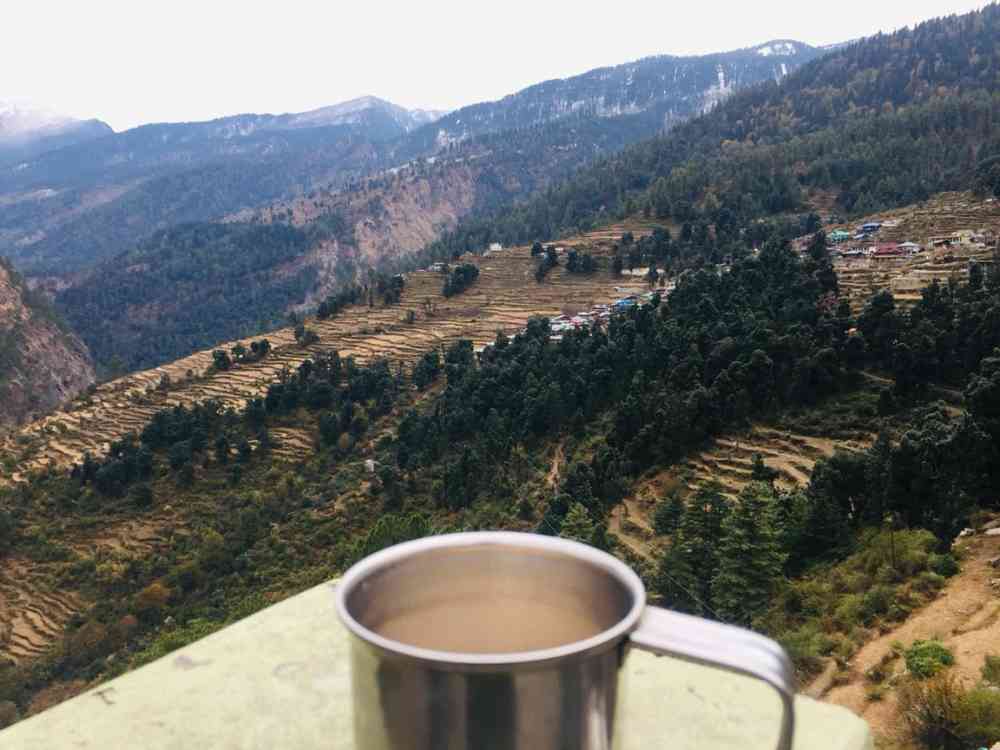
Besides Sankri, there are only a few tea houses along the trail that offer limited options such as Maggi and snacks. However, their availability is uncertain, so they should not be solely relied upon. The best option for arranging food and accommodation would be to choose a trekking package that includes these services. Those who prefer to trek independently will need to carry necessary supplies, including a portable stove and fuel.
If you are choosing JustWravel as your Trekking Partner, you don’t have to worry about the food part at all.
Story Of Kedarkantha
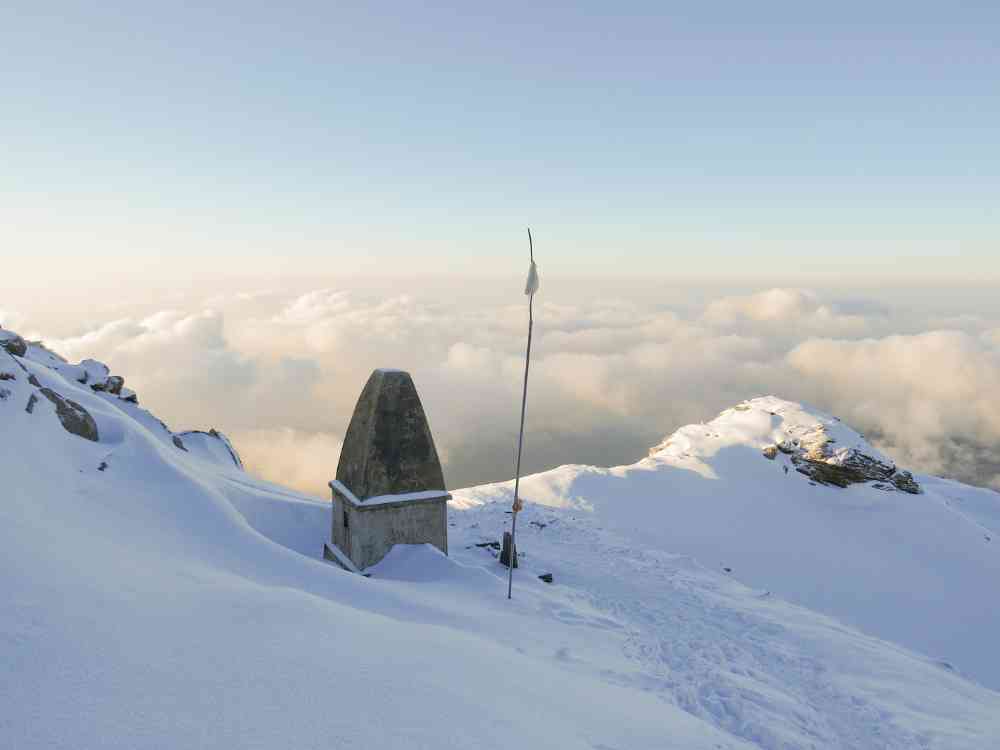
Kedarkantha , like many other destinations in Uttarakhand, is steeped in mythology. It is said that Lord Shiva, in his bull form, sought solace from the Pandavas and meditated in the valley. However, due to disturbance from the locals, he eventually fled to Kedarnath. The peak of Kedarkantha is adorned with Lord Shiva’s Trishul, which is believed to safeguard the valley and its inhabitants.
Kedarkantha, also known as Bal-Kedar, holds an intriguing local legend that suggests it was originally intended to be the sacred site of Kedarnath. According to the tale, Shiva, in his bull form, sought refuge in Kedarkantha to evade the Pandavas. However, the tranquility of this place was disrupted by the locals, prompting Shiva to flee to the present-day Kedarnath site. The villagers of Sankri firmly believe that the majestic trident of Lord Shiva, standing tall at Kedarkantha, not only safeguards them but also ensures the continuous flow of the Himalayan Rivers, blessing their land with abundance.
Tip From JW The Kedarkantha region offers optimal conditions for astro photography and capturing the beauty of the Milky Way in its dark and clear skies.
How To Prepare For Kedarkantha Trek
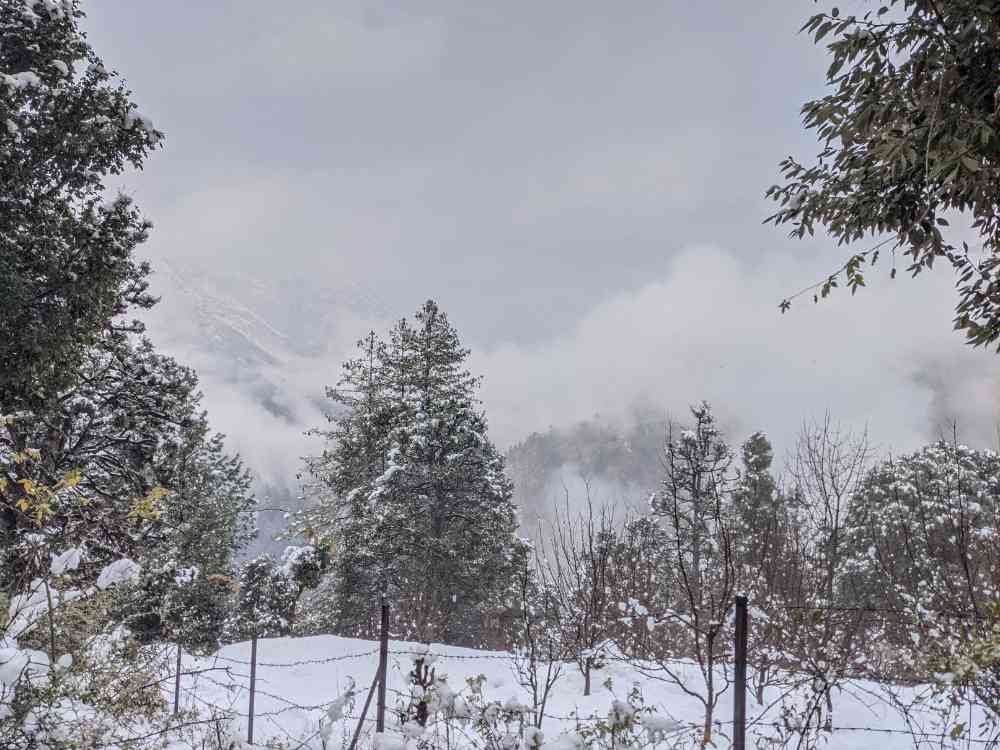
The Kedarkantha Trek stands out as one of the most popular Himalayan treks, offering a challenging yet rewarding experience that spans multiple days and involves steep ascents and descents. Given the high altitude and the nature of the trek, adequate preparation is crucial for a successful journey. Fortunately, as Kedarkantha Trek falls under the Easy to Moderate category, the following preparations should suffice.
Uphill Training: Dedicate 6 to 8 minutes to Uphill Training, a crucial aspect to enhance your leg muscle strength, quicken your stride, and develop your cardiovascular system.
Push Ups: Incorporate Pushups into your training regimen. Practice 10 reps of 2 push-ups each to build upper body strength, essential for the demands of Kedarkantha Trek.
Squats: Include Squats in your routine. Similar to push-ups, aim for 10 reps of 2 squats each. This will contribute to overall lower body strength, helping you tackle the varied terrains of the trek.
Jogging: Improve your cardiovascular fitness through jogging. Aim for 20 to 30 minutes of jogging every day, a highly effective way to enhance your endurance for the trek.
Crunches: Like push-ups and squats, incorporate 10 reps of 2 crunches each into your training. This will strengthen your core muscles, providing stability during the trek.
By diligently following this training regimen, you’ll be better prepared for the challenges that the Kedarkantha Trek presents, ensuring a more enjoyable and successful trekking experience.
Loved Kedarkantha Trek? What to do Next?
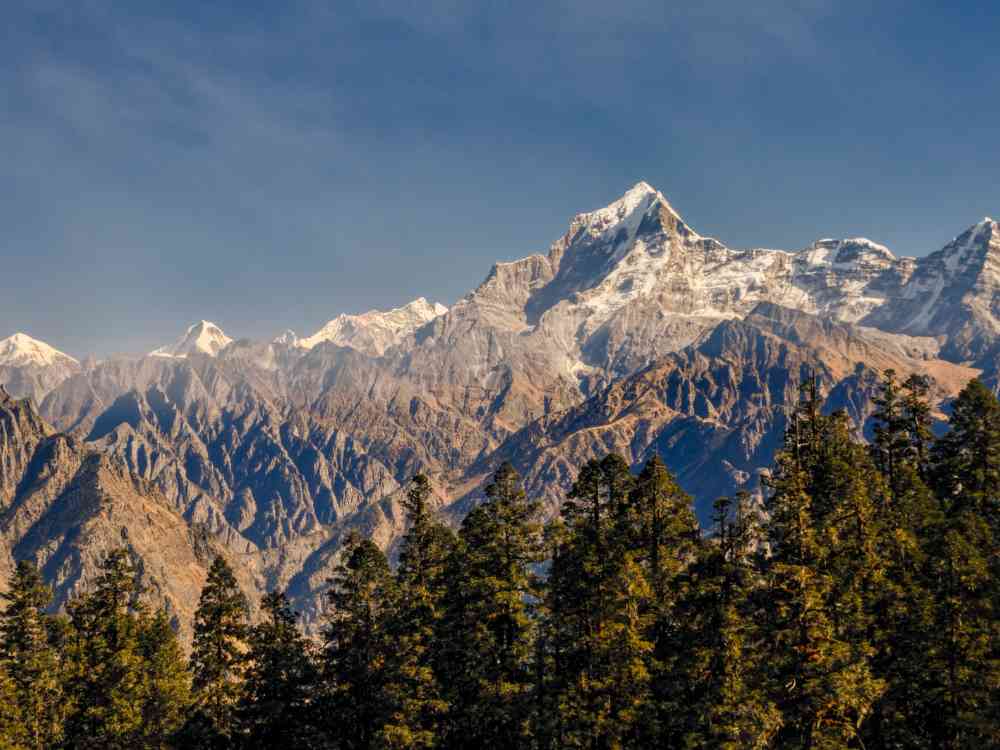
Loved Kedarkantha Trek? Then here are some recommendations for you!
Brahmatal Trek – Providing a diverse panoramic vista encompassing majestic mountains, snow-laden trails, high-altitude serene lakes, and lush green forests, Brahmatal stands out as a truly mesmerizing trek.
Look what Brahmatal has to offer!
Kuari Pass Trek – Nestled in the Garhwal region of the Himalayas, the Kuari Pass trek is hailed as one of India’s premier winter treks. Situated at an elevation of 12,516ft, this trail, also known as the Lord Curzon trail , pays homage to the former Viceroy of India.
Trek together to Kuari Pass Now!
Dayara Bugyal – Tailored for both novice and seasoned trekkers, this 22km long trek unfolds incredible rewards, treating you to the majestic peaks of the Himalayas. From the Gangotri massif and Black peak to the Bhgirathi massif and Bandarpoonch massif, Dayara Bugyal offers a breathtaking Himalayan spectacle.
Dayara Bugyal welcomes you with it’s whole heart!
Conservation in Kedarkantha
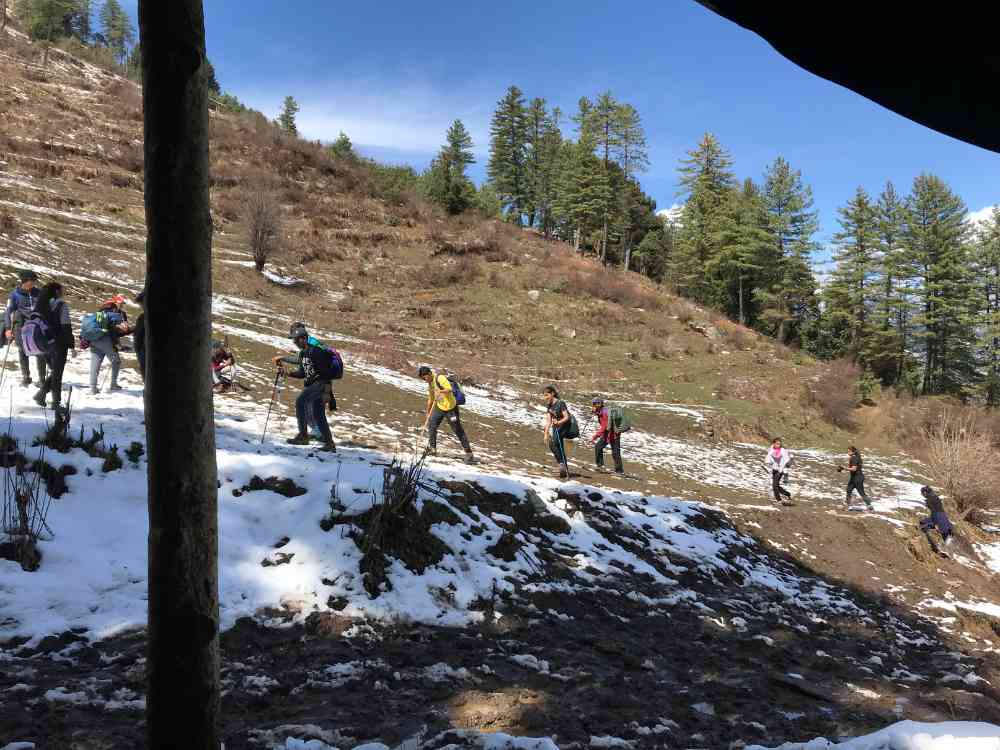
The Kedarkantha Trek, celebrated as one of the most beautiful and majestic treks in India, not only captivates with its stunning landscapes but also instills a sense of responsibility in those who embark on its trails. As conscientious trekkers, it becomes imperative for us to not merely witness the beauty but to leave the environment in a better state than we found it. Conservation is not just an activity; it is a duty we owe to these pristine mountain landscapes.
Our responsibilities as stewards of the mountains extend beyond the grandeur of the trek itself. Small yet impactful initiatives, such as diligently collecting plastic debris from the mountains, contribute significantly to the preservation of this fragile ecosystem. Ensuring the safety and hygiene of the trails becomes a paramount duty, reflecting our commitment to sustainable trekking practices. Each footstep should resonate with a pledge to maintain the sanctity of the natural surroundings.
Moreover, as responsible trekkers, we must actively engage in educating fellow enthusiasts about the importance of preserving these mountain havens. By fostering a culture of environmental consciousness, we pave the way for future generations to relish the same breathtaking vistas that we have been privileged to witness. In essence, our duty in the mountains transcends the trek itself, weaving a narrative of conservation, respect, and a shared commitment to protect the unparalleled beauty that nature graciously bestows upon us.
Q1. What is the difficulty level of the Kedarkantha Trek? The Kedarkantha Trek is considered to be of moderate difficulty. It is suitable for beginners as well as experienced trekkers.
Q2. How long does it take to complete the Kedarkantha Trek? The Kedarkantha Trek usually takes 5 days to complete. This includes trekking for approximately 4-5 hours each day.
Q3. What is the best time to go for the Kedarkantha Trek? The best time to go for the Kedarkantha Trek is during the winter months, from December to April. This is when the region is covered in snow, offering breathtaking views and a unique experience.
Q4. What are the highlights of the Kedarkantha Trek? Some of the highlights of the Kedarkantha Trek include camping amidst snow-covered landscapes, panoramic views of the Himalayan peaks like Swargarohini, Bandarpoonch, and Black Peak, and exploring remote villages and their rich culture.
Q5. Is it necessary to hire a guide for the Kedarkantha Trek? While it is not mandatory, it is highly recommended to hire a guide for the Kedarkantha Trek. A guide will not only ensure your safety but also provide valuable insights about the region, its flora and fauna, and help you navigate the trail effectively.
The Kedarkantha Trek is undoubtedly an unforgettable experience. Its enchanting beauty, coupled with the thrill of trekking through snow-laden paths, makes it the go-to option for winter trekking in India. But remember, preparation and respect for nature are the keys to a successful and enjoyable trek.
So pack your bags, tie your laces, and get ready to embark on this mesmerizing journey.
Happy Trekking!
Leave a Comment X
Save my name, email, and website in this browser for the next time I comment.
Very Informative, Just got to know about this place
Thankyou for providing us with such detailed information! Makes me want to pack my bag and head here straight away.
The most informative blog for kedarkantha!
Infomartive
Thanks for Sharing!
Absolutely! Your Kedarkantha Trek blog is an incredibly comprehensive guide, providing invaluable insights for adventurers. The captivating picture that accompanies it perfectly captures the allure of the journey, inviting readers to explore the majestic beauty of the trail.
About the author
You may also like

Best Summer Treks to Do in 2024
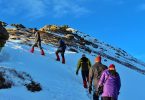
Best Winter Treks To Do In the Himalayas
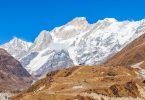
Uttarakhand is now open for all

Mysteries of the enchanting Roopkund Lake!
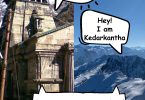
Confused Between Kedarkantha and Kedarnath? Check How...
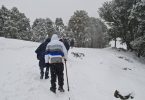
Health Benefits Of Trekking

- Upcoming Treks
The Kedarkantha trek is a paradise for trekkers and adventure enthusiasts in the Uttarkashi District of Uttarakhand state of India. With its awe-inspiring landscapes, pristine wilderness, and the opportunity to witness the raw beauty of the Himalayas, this trek has become a favorite among both beginners and seasoned trekkers. In this comprehensive guide, we’ll take you on a virtual journey through the Kedarkantha trek, offering insights into its mesmerizing beauty and practical tips to make your adventure unforgettable.
Before we dive into the nitty-gritty details, let’s get acquainted with the Kedarkantha trek itself. We’ll discuss the trek’s significance, the best time to visit, and the essentials you should pack for a successful journey.
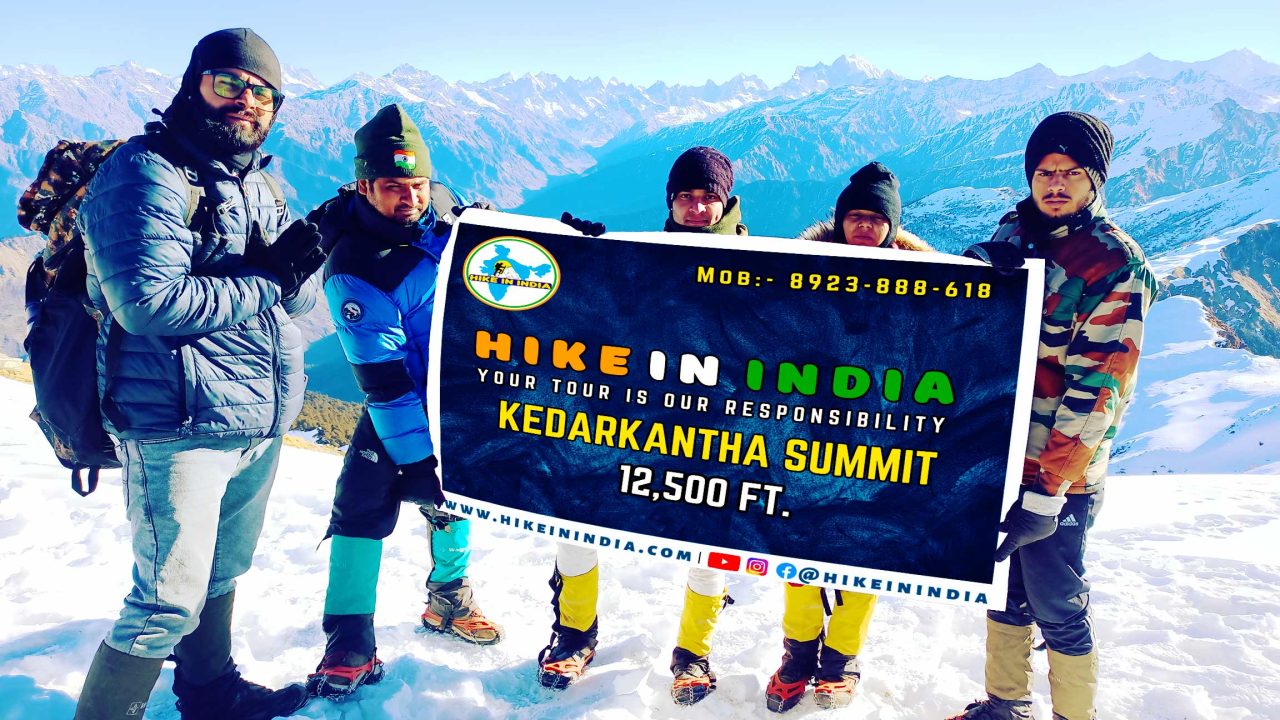
The Kedarkantha Trek – An Overview
The Significance of Kedarkantha : Kedarkantha is a sacred peak in the Garhwal region, named after Lord Shiva. It holds cultural and religious importance and also a favorite trek among trekkers with beautiful scenic views.
Best Time to Trek: The best time to embark on the Kedarkantha trek is during the winter months, from November to April. The snow-covered landscapes during this time are a sight to behold.
Essential Gear: Packing the right gear is crucial. We’ll cover clothing, trekking equipment, and personal essentials to help you prepare for the adventure.
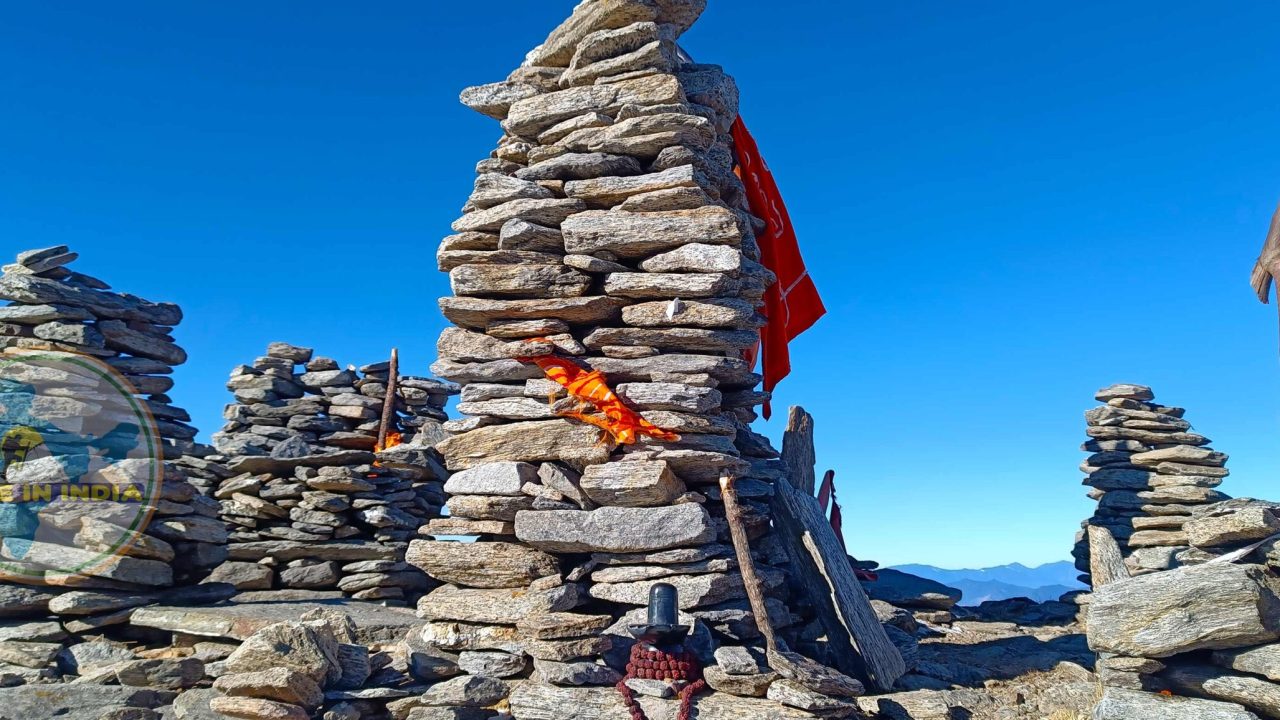
Planning Your Trek
We will discuss how to summit KedarKantha Trek, documents for permits and accommodations and the story behind KedarKantha.
Reaching the Trek Point : You can start the Kedarkantha trek from Sankri, which is well-connected to Dehradun. We’ll provide transportation options for which is included in the Package, Dehradun to Sankri is about 220 kms.
Permits and Documentation : You’ll need to obtain permits for the trek. You have to gave a photocopy of your Aadhar Card and must carry original with you to verify it and a passport size photo, we will do all the further process.
Accommodations: There are two types of options available for accommodation at the KedarKantha trek. In the Sankri village you have to stay in Guest House or Homestay. During the trek we’ll provide camp and the mat under the sleeping bag to sleep.
Story : In the last of blog.
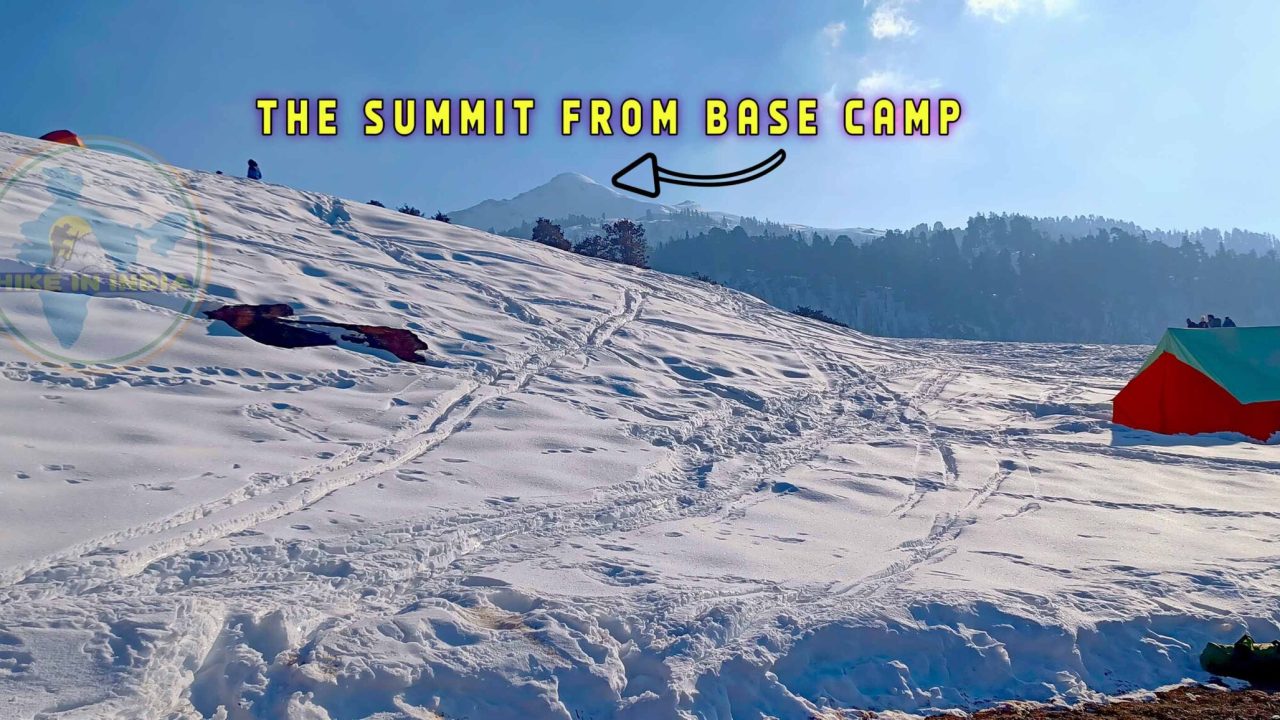
In the heart of the majestic Himalayan range lies a hidden gem, the Kedarkantha trek, where nature weaves its magic and adventure awaits those willing to explore. This enchanting trek takes you through a myriad of experiences, each more captivating than the last.
The journey commences at Sankri, a quaint village that feels like a portal to a different world. The locals welcome you with warmth, sharing tales of the mountains and their revered deity, Lord Kedarkantha. As you ascend, you can’t help but be entranced by the colorful rhododendron forests, an awe-inspiring backdrop to your trek.
The trail winds through meadows adorned with vibrant wildflowers, invoking the feeling of walking through a picturesque dream. Your footsteps are accompanied by the symphony of birdcalls, echoing the eternal harmony of nature.
The highlight of the trek is, of course, the Kedarkantha summit. At 12,500 feet above sea level, you’re met with panoramic views of snow-capped peaks that stretch as far as the eye can see. The summit feels like a sacred altar, a place where you connect with the spiritual energy of the mountains.
Camping amidst the Himalayan wilderness is an adventure of its own. The crisp mountain air, the flickering campfire, and the millions of stars above transport you to a world far removed from the hustle and bustle of city life.
But Kedarkantha’s allure doesn’t end with its natural beauty. It’s also a place where you discover your inner strength. The trek presents challenges, from steep ascents to freezing temperatures, and conquering them instills a sense of accomplishment and self-discovery.
As you descend, the mountains seem to bid you farewell, promising to remain etched in your memories. You return to civilization with a heart full of gratitude for the Himalayas and the incredible journey you’ve undertaken.
The Kedarkantha trek isn’t just about reaching a summit; it’s about the journey, the connection with nature, and the self-transformation it offers. It’s a story that beckons adventure seekers to explore the Himalayan mystique, leaving them forever changed by its beauty and grandeur.
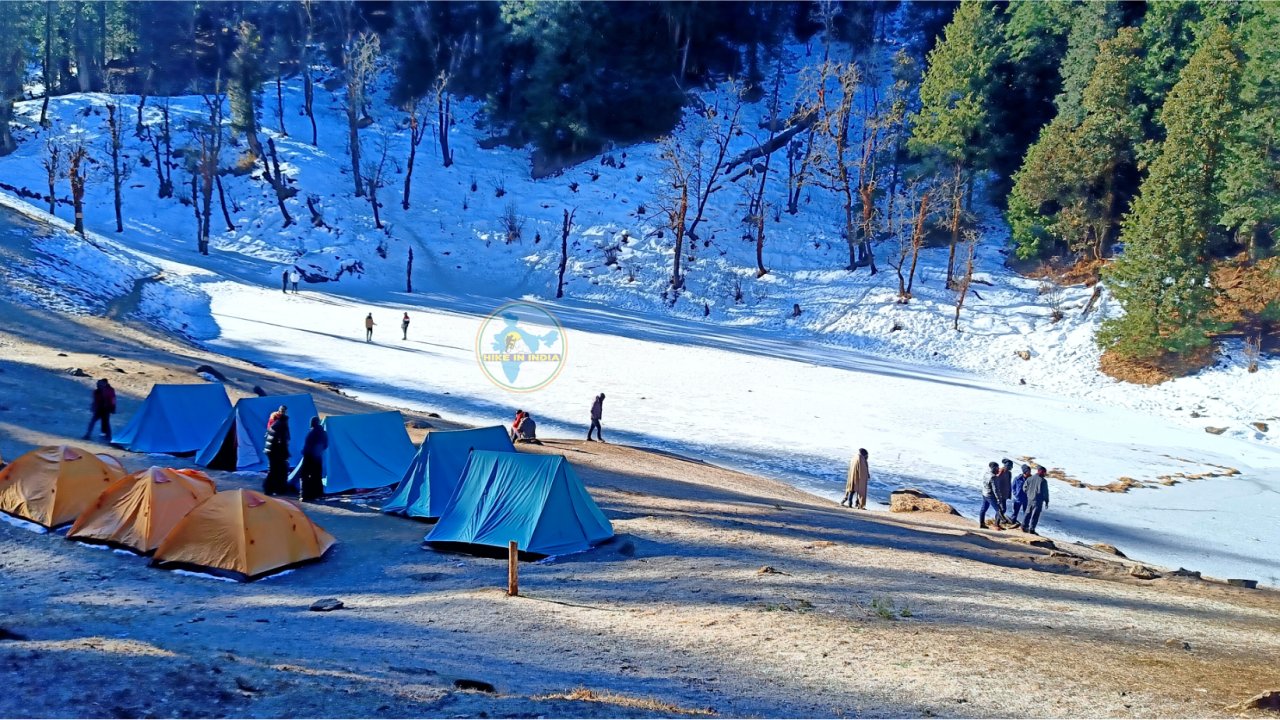
The Trekking Itinerary
Kedarkantha trek can be done in to 5 to 6 days, depends on the stamina of the group. We’ll break down the trekking itinerary day by day. You’ll get a glimpse of the beautiful landscapes and the distances to be covered at each stage.
- Day 1: Dehradun to Sankri – You’ll be picked up from Dehradun Railway Station or ISBT and drive around 220 km and it takes around 7-8 hours to reach Sankri. Sankri altitude is 6,455 ft.
- Day 2: Sankri to Juda Ka Talab – Start your trek from Sankri to reach Juda ka Talab (Frozen Lake during winter). We have to Trek around 3 km to reach Juda ka Talab at 9,100 ft altitude, Overnight stay at Camp.
- Day 3: Juda Ka Talab to Kedarkantha Base camp – Enjoy your Breakfast at Juda ka Talab, and head towards the KedarKantha Base camp at 11,250 ft altitude and we have to trek around 3 km to reach there, overnight stay at camp.
- Day 4: Kedarkantha Base Camp to Kedarkantha Summit and Back to Juda Ka Talab – After breakfast, get ready for the ultimate Adventure. Wake up early around 1:30 or 2:00 Am in the Morning, have breakfast then start your trek towards summit at 12,500 ft altitude and it takes around 4-7 hours to reach the summit. After enjoy the Sunrise from the Gangotri or Yamunotri mountain ranges. Descend back to Juda Ka Talab overnight stay at camp.
- Day 5: Juda ka talab to Sankri, Sankri to Dehradun – Enjoy your delicious breakfast, then ready to descend towards Sankri village. After arrival on Sankri feshed up and Drive to Dehradun.
Note: The above itinerary is based on 5 days regular tour package, If you want then we can customize it for 6 days.
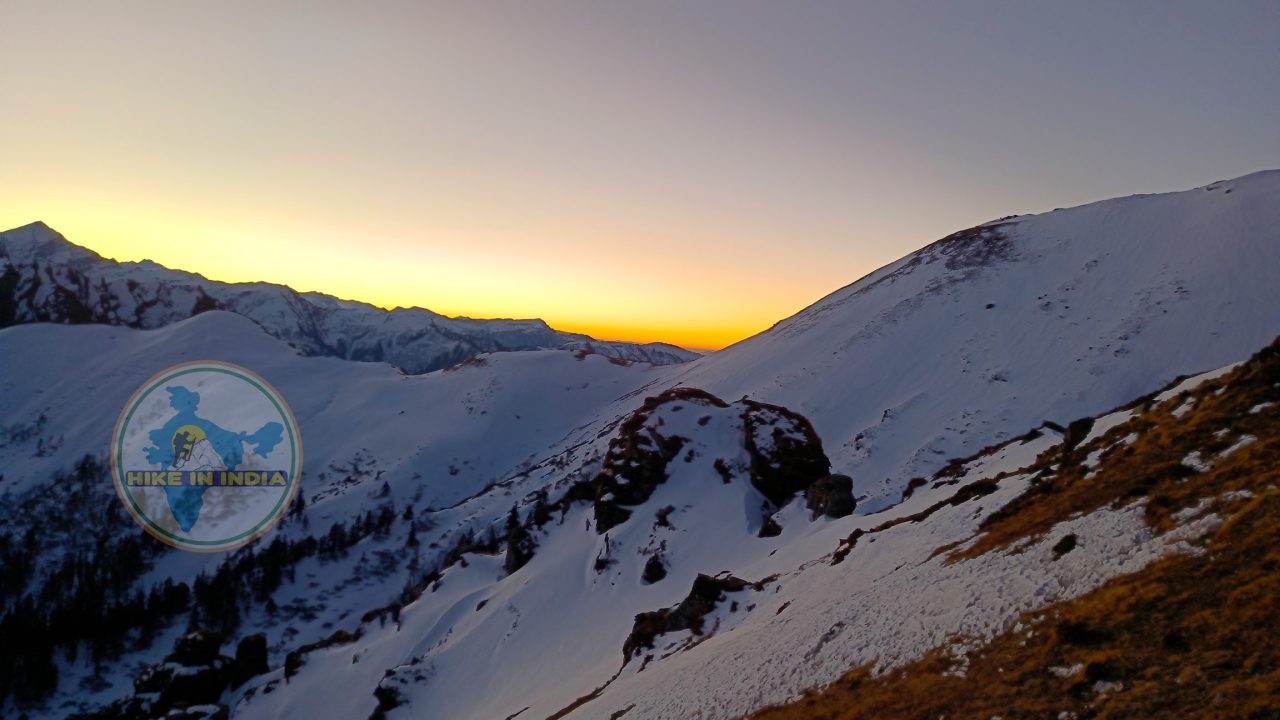
Responsible Trekking and Safety Measures
Responsible trekking is not only about experiencing the natural beauty of the great outdoors but also ensuring the preservation of these fragile ecosystems and the safety of trekkers. Here are a few lines on responsible trekking and safety measures:
Leave No Trace: Responsible trekkers follow the “Leave No Trace” principle, meaning they leave nature as they found it. This involves carrying out all trash, using designated camping areas, and minimizing their impact on the environment.
Plan and Prepare: Thoroughly plan your trek, considering factors like weather, terrain, and the skill level of your group. Inform someone of your itinerary and expected return time.
Pack Essentials: Bring essential items like appropriate clothing to handle changing weather conditions.
Respect Wildlife: Keep a safe distance from wildlife and refrain from feeding or approaching animals. Your presence should not disrupt their natural behaviors.
Stick to Established Trails: Stay on designated paths to avoid damaging fragile ecosystems and to ensure your own safety. Venturing off-trail can lead to accidents and environmental harm.
Camp Responsibly: Follow all camping regulations. Minimize campfire use and opt for a camp stove to reduce the risk of forest fires.
Leave No Mark of Your Presence: Avoid graffiti, littering, or any other activities that harm the environment. Remember, you’re a guest in nature.
Consider Local Culture: When trekking in different regions, respect local customs and traditions, and be mindful of how your actions might affect the local community.
In summary, responsible trekking is a balance between enjoying the outdoors and preserving it for future generations. Safety measures are integral to this, ensuring that you have an enjoyable and secure experience while minimizing your impact on the environment.
The Kedarkantha trek is a thrilling adventure that will leave you with memories to cherish for a lifetime. From the sacred significance of the peak to the incredible landscapes and the challenges of trekking in the Himalayas, this journey is a rewarding experience for those who seek the beauty and serenity of the mountains. By following this comprehensive guide, you’ll be well-prepared to embark on this incredible Himalayan adventure. So, lace up your trekking boots and get ready to explore the mesmerizing Kedarkantha trek!
Blog Suggestions

Har ki Doon Trek

Nag Tibba Trek

Trekking Safety Tips
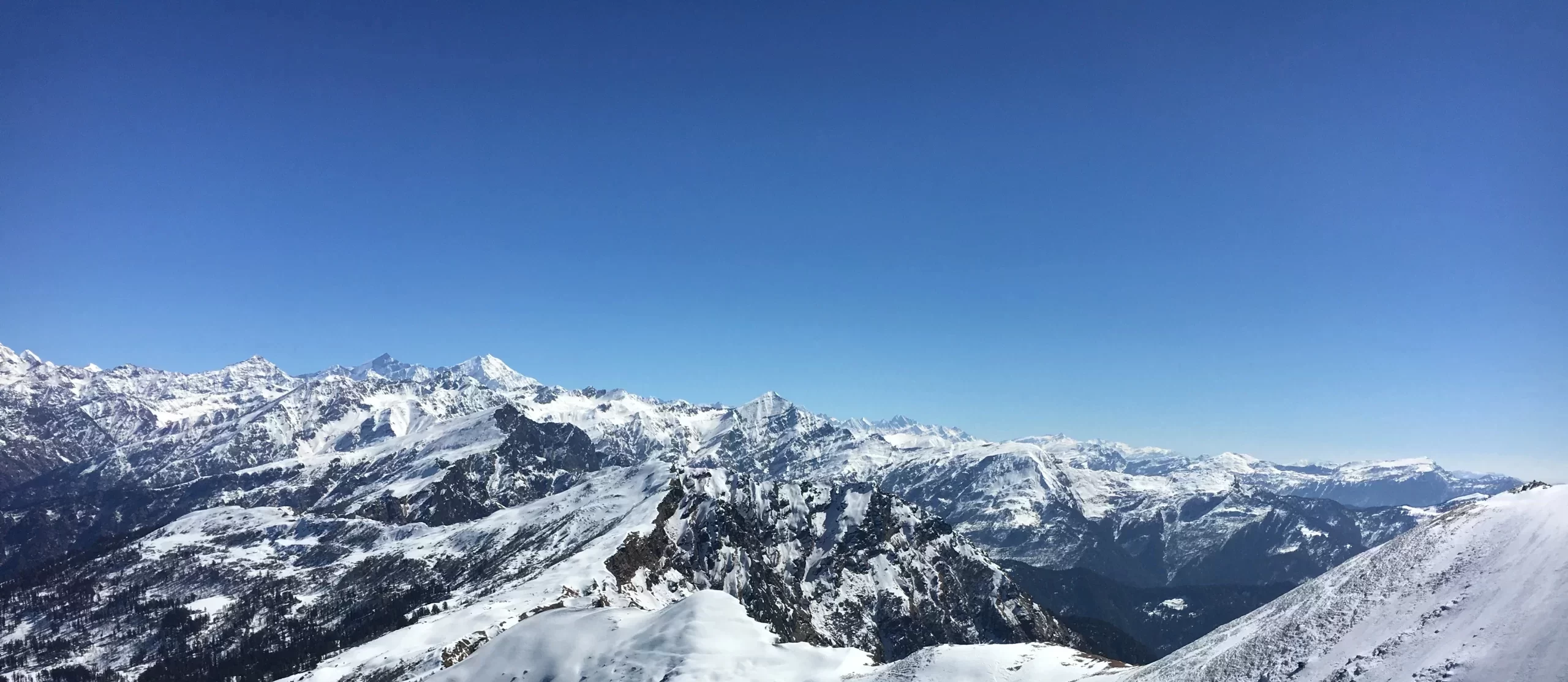
Kedarkantha Trek
The most popular winter trek in india, rated 4.9/5.0 on tripadvisor. 837 reviews, customize your himalayan trip or join our fixed departures, kedarkantha trek overview:, highlights of kedarkantha trek:, 1. sankri: base camp of the trek:, 2. juda ka talab:.
The frozen Juda ka Talab lake, a 3-D view , image credit: khushwant singh
3. Kedarkantha Base Camp:
4. sunrise from the summit of kedarkantha peak:.
3-D view of Sunrise at the Kedarkantha Summit , image credit: Gahan Saraiya
5. The Best Attraction in Winters:
6. cultural exploration:, 7. wildlife on trek:, best time to visit:.
1. Kedarkantha Trek from September to November (Autumn):
2. trek in december, january, february, march, and april (winter and spring):, 3. kedarkantha trek in may and june (summer):, kedarkantha trek difficulty level:, kedarkantha terrain details:.
- Starting Point: From Sankri, some gradual slopes through the oak and pine trees.
- Forest Trails: It passes through deep pine, oak and fir staples. Crossings can be done on water, trails can be very muddy and sometimes to the extent of being slippery.
- Meadows and Clearings: Goes in to open up meadows specially at Juda Ka Talab, with wide open spaces with lots of grassy fields and a great view.
- Snow-Covered Paths: The cross-country trails are covered with snow during winter and early spring. Trekking is not easy due to distinctly different snow conditions. Trekking poles, gaiters, and microspikes are useful.
- Steep Ascent to Base Camp: Hike from Juda Ka Talab to the Base Camp with short steep steps on stones and rocky terrains with many hairpin bends. Views improve with altitude.
- Summit Push: The last trek to reach Kedarkantha is difficult which is steep and path is completely open and many at times it is snow or ice. Must be managed and does require one to have lots of energy.
- Descent: Journey through from meadows and the forest trails. Still a moderately easy hike compared with ascent but a shocker, for knees especially because the slopes are steep.
- Overall, Terrain: It has forest tracks, meadows, and alpine; country characteristics. Varied and interesting trekking experience with different terrains.
Maximize the Kedarkantha Trek Experience with a Good Physical Fitness and Safety Precautions:
Preparation for a good physical fitness:, 1. lower body exercises:.
- Target Body Parts: Quadriceps, hamstrings, glutes, calves.
- Benefits: Strengthens lower body for climbing and descending; stabilizes uneven terrain.
- How-to: Stand feet shoulder-width apart. Lower into a squat, keeping your back straight, then return to standing.
- Benefits: Improves balance and stability on rocky trails; enhances flexibility.
- How-to: Step forward with one foot, lowering your body until both knees are bent at 90 degrees. Push back to start and alternate legs.
2. Upper Body Exercises:
- Target Body Parts: Chest, shoulders, triceps, core.
- Benefits: Strengthens upper body for backpack support and improves posture.
- How-to: Start in a plank position, lower your chest to the ground, then push back up, keeping your core engaged.
Pull-Ups/Bodyweight Rows:
- Target Body Parts: Back, biceps, shoulders.
- Benefits: Enhances posture and reduces back strain; strengthens muscles for carrying a backpack.
- How-to: For pull-ups, grip a bar and pull yourself up until your chin is above it. For rows, use a low bar or TRX straps.
3. Core Exercises:
- Target Body Parts: Abdominals, obliques, lower back.
- Benefits: Improves stability and balance; reduces back pain.
- How-to: Hold a plank position with elbows under shoulders and body in a straight line.
Russian Twists:
- Target Body Parts: Obliques, abdominals, lower back.
- Benefits: Enhances rotational stability and core strength.
- How-to: Sit with knees bent, lean back slightly, and twist your torso side to side.
4. Full Body/Cardiovascular Exercises:
Mountain climbers:.
- Target Body Parts: Core, shoulders, chest, legs.
- Benefits: Improves cardiovascular endurance and agility.
- How-to: In a plank position, alternate bringing knees to chest in a running motion.
- Target Body Parts: Full body.
- Benefits: Boosts cardiovascular endurance, strength, and agility.
- How-to: Perform a squat, jump to a plank, do a push-up, return to squat, and jump up.
5. Additional Tips:
- Consistency & Form: Maintain proper technique and gradually increase intensity.
- Recovery & Flexibility: Allow muscle recovery, and stretch before and after workouts.
- Balance Training: Incorporate strength exercises like deadlifts for overall balance and endurance.
Safety Precautions & Protocols during the Kedarkantha Trek:
1. acclimatization:.
- Importance: Acclimatization helps stabilize oxygen levels in the body. It is crucial for preventing altitude sickness and maintaining physical fitness.
- Spend an extra day at the Sankri base camp or intermediate points to adjust to the altitude.
- Ascend gradually, avoid ascending too quickly.
- Climb high and sleep low. After reaching the campsite, hike to a higher elevation than the campsite's altitude, spend some time there, and then return to the campsite.
- Reduce strength exercises and increase yoga practice with Pranayama or other slow breathing techniques.
2. Weather Preparedness:
- Importance: The weather in Kedarkantha can be unpredictable, with snow and cold temperatures. Knowing weather facts helps trekkers determine the best time to start or not start their trek, and be prepared for any expected weather fluctuations during the hiking.
- Check weather forecasts regularly.
- Be prepared for sudden changes by carrying appropriate gear, such as waterproof jackets or a poncho, and extra pairs of quick-dry socks.
- In the mountains, afternoon rain is more common than other times of the day. So, make sure to start and end your hike before noon.
- If it’s raining continuously, pause on the hike on the spot but avoid stopping near water streams and riffle sections. Try to pass away these areas as quickly as possible.
3. Hydration and Nutrition:
- Importance: Staying hydrated and well-nourished helps maintain energy and health.
- Drink plenty of water at regular intervals throughout the trek.
- Carry high-energy, easy-to-digest foods like nuts, energy bars, and fruits.
- Avoid taking alcohol.
- Avoid consuming sugary foods or drinks during the trek. Excess sugar increases blood glucose concentration, leading to fatigue.
4. Health and First Aid:
- Importance: Immediate response to health issues can prevent serious complications.
- Carry a comprehensive first aid kit, including altitude sickness medication, and be familiar with basic first aid procedures.
- Inform your trek leader of any pre-existing health conditions.
5. Safety Gear:
- Importance: The right gear can prevent injuries and keep you safe in adverse conditions.
- Wear sturdy, broken-in trekking boots with good ankle support.
- Dress in layers to manage your body temperature, especially above the Kedarkantha Base Camp.
- Carry a reliable backpack with a rain cover and other essentials such as a headlamp, rope, oxygen cylinder, gaiters, and microspikes.
6. Emergency Preparedness:
- Importance: Quick action is vital in emergencies.
- The nearest hospital is located in Mori, which is 21 km from the Sanrari Base Camp.
- Keep emergency contact numbers.
- Ensure that your trek leader has communication devices such as a satellite phone or walkie-talkie in case of an emergency.
- Make sure you have appropriate adventure insurance that covers trekking in high-altitude areas.
7. Navigation and Trail Safety:
- Importance: Navigating snowy trails requires caution and skill.
- Follow your guide.
- Follow marked trails and use a compass, maps, or GPS devices to avoid getting lost on the trail.
- Pay attention to trail markers and avoid venturing off the path.
8. Wildlife Awareness:
- Importance: Encounters with wildlife can be a risk.
- Maintain a safe distance from animals.
- Avoid leaving food unattended and keep your campsite clean to avoid attracting wildlife.
9. Group Coordination:
- Importance: Staying connected with your group ensures collective safety.
- Maintain regular communication with your group.
- Follow the trek leader’s instructions and avoid separating from the group.
10. Environmental Responsibility:
- Importance: Protecting the natural environment is essential.
- Follow "Leave No Trace" principles.
- Dispose of waste properly and avoid disturbing wildlife or vegetation.
11. Altitude Sickness Awareness:
- Symptoms: Headache, nausea, dizziness, and shortness of breath.
- If symptoms occur, inform your trek leader immediately.
- Descend to a lower altitude if necessary and seek medical help if symptoms persist.
- On the Kedarkantha Trek, after crossing the Kedarkantha Basecamp (11,250 feet), some trekkers might be affected by AMS. Therefore, keep your walking pace slow and steady until you reach the summit.
Backpacking with essential gear and equipment for the Trek:
Mandatory documents:, accessories:.

Toiletries:
- For trekking in spring, summer, and monsoon: 1 Trek Pant, 1 innerwear (made of nylon), 1 lightweight shirt, 1 fleece Sweater, and 1 poncho
- For Trekking in Autumn, and starting of Winters: 1 Trek Pant, 1 pair of thermals, 1 t-shirt, 1 fleece Sweater, 1 padded jacket, and 1 poncho
- For Trekking in Winters: 1 pair waterproof gloves, 1 Trek Pant, 1 pair of thermals, 1 t-shirt, 1 fleece Jacket, 1 padded jacket, and 1 windproof jacket
- 3 T-shirts (Wear one, carry two)
- 2 pair thermals (Wear one, carry one)
- 2 quick-dry trek pants (Wear one, carry one)
- 3 pair socks (Wear one, carry two)
- 2 pair gloves (Wear one, carry one)
- 1 padded Jacket (Always carry it in your bag, whether you are wearing it or keep it with you in case there is a sudden drop in temperature during evening and morning hours)
Medical Kit:
To reach the base camp of kedarkantha trek:, traveling to dehradun:, dehradun to the basecamp sankri:, private and govt. buses:, regular taxis and cabs:, kedarkantha trek package by himalaya shelter:, dynamic or customised package options for the kedarkantha trek:, kedarkantha trek route map:.
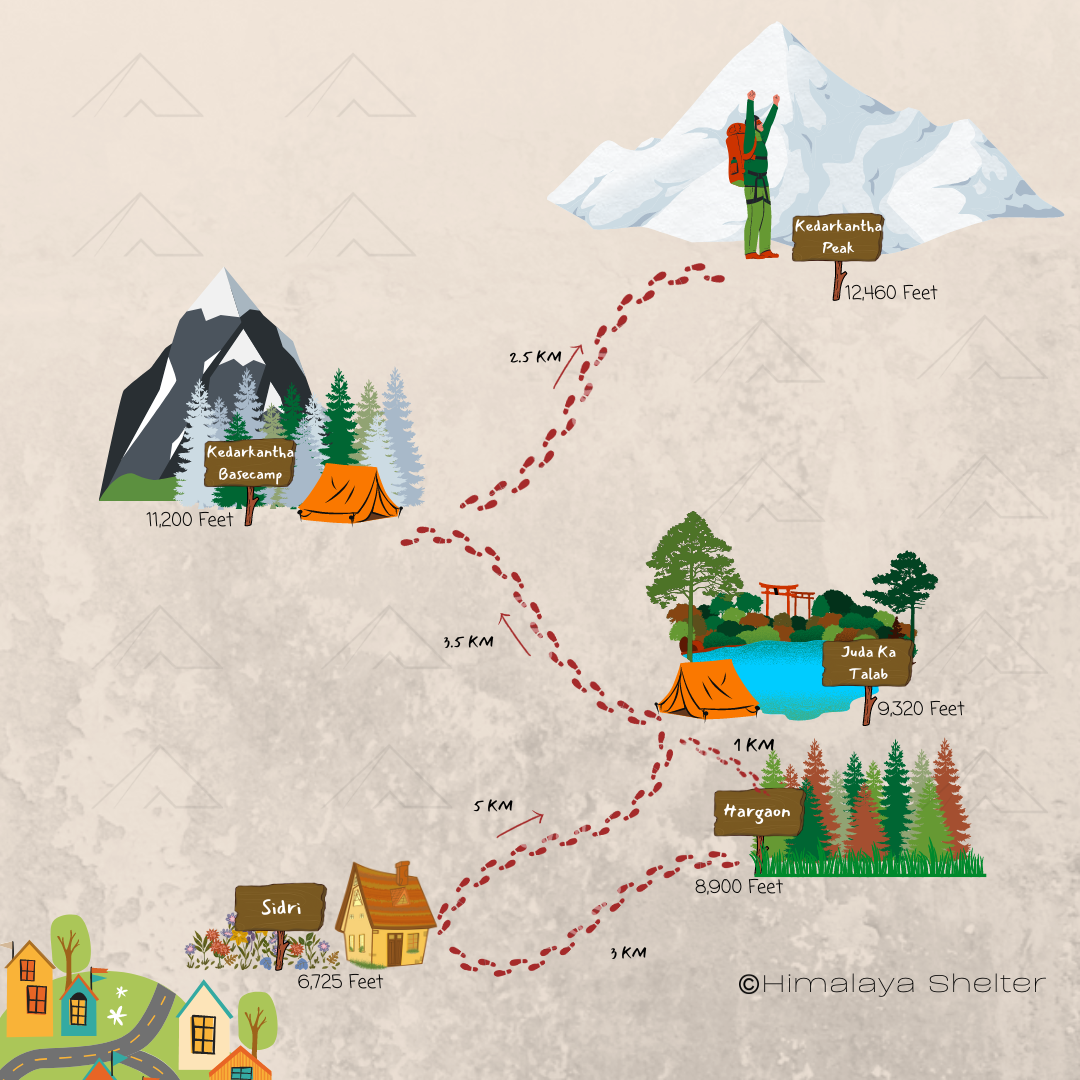
Kedakantha Reviews:
Kedarkantha Trek Itinerary
Day 1 dehradun to sankri (1,920 m): 187 km drive in 8 hours.
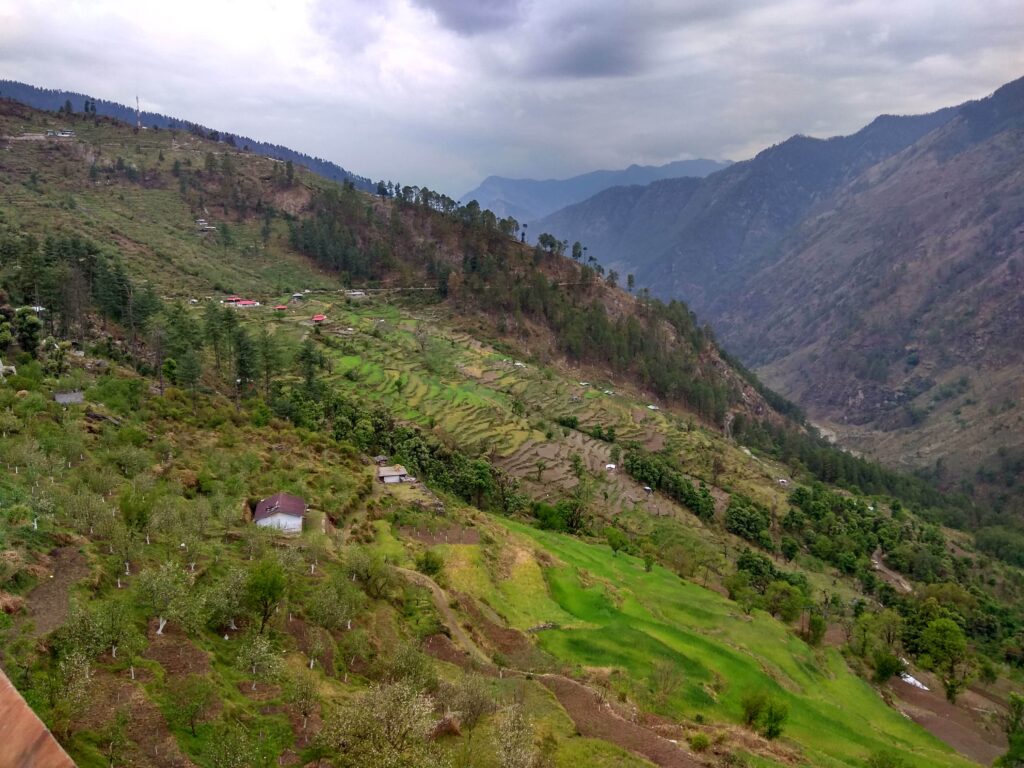
The drive from Dehradun to Sankri takes you through picturesque towns and villages like Mussoorie, Nowgaon, Purola, and Mori. The route is scenic and takes you through a dense pine forest, filling the air with the sweet aroma of pines. After driving through the forests, you’ll reach Mori, where the Tons River joins you on the route. The Tons River is the biggest tributary of Yamuna and is well-known for rafting activities. The 190 km long drive typically takes 8-9 hours to complete, so it’s advisable to start early to reach Sankri by evening. You’ll spend the night at a guesthouse before starting your hike the next day.
Day 2 Sankri to Juda Ka Talab (2,774 m): 4 km trek in 3 to 4 hours
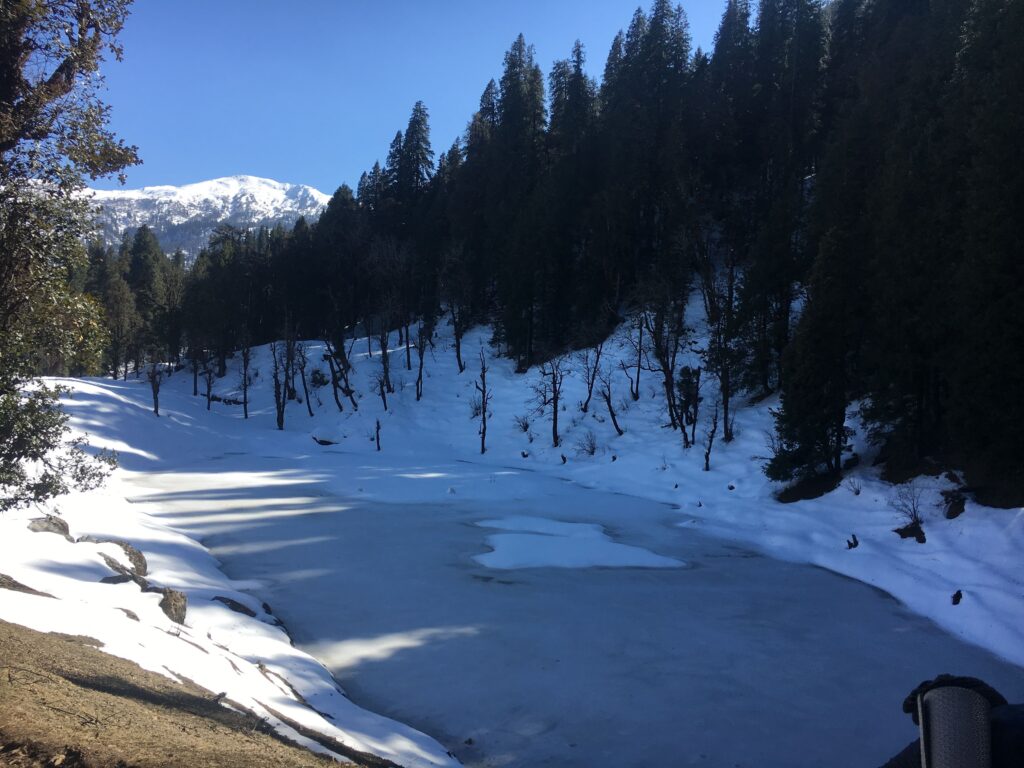
Day 3 Juda Ka Talab to Kedarkantha Base Camp (3,429 m): 4 km in 3 hours
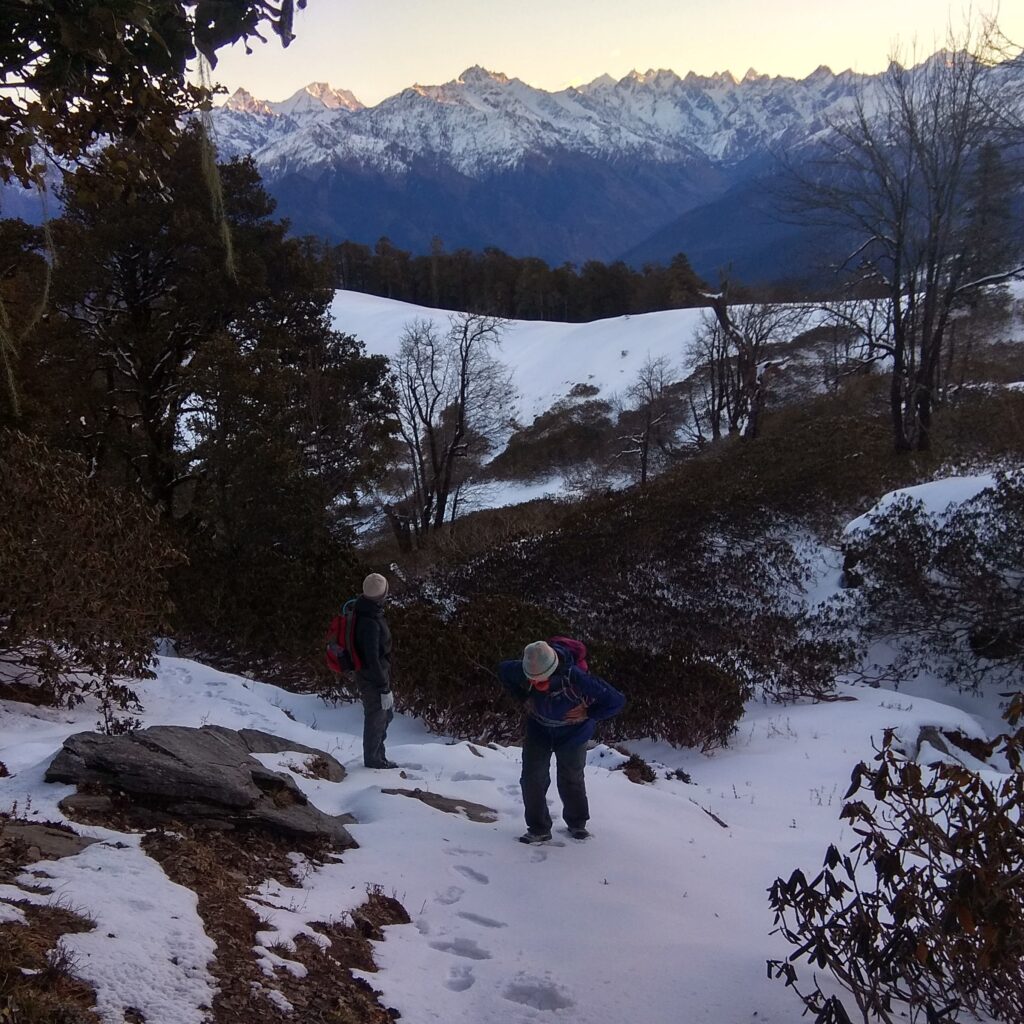
From Juda Ka Talab, the trail leads deeper into dense pine forests until reaching a meadow with shepherd’s huts. Climbing further for another thousand feet, trekkers will finally reach the Kedarkantha base camp, taking around 2-3 hours to complete. The trail from Juda Ka Talab to the base camp is incredibly stunning, providing an ideal setting for photographers and nature enthusiasts alike. Despite being a bit colder due to the lack of insulation, the base camp offers panoramic views of the famous peaks of Uttarakhand, making it an ideal spot for camping.
Day 4 Kedarkantha base camp to Kedarkantha Summit (3,810 m) and back to Hargaon (2,713 m): 8 km in 5-6 hours
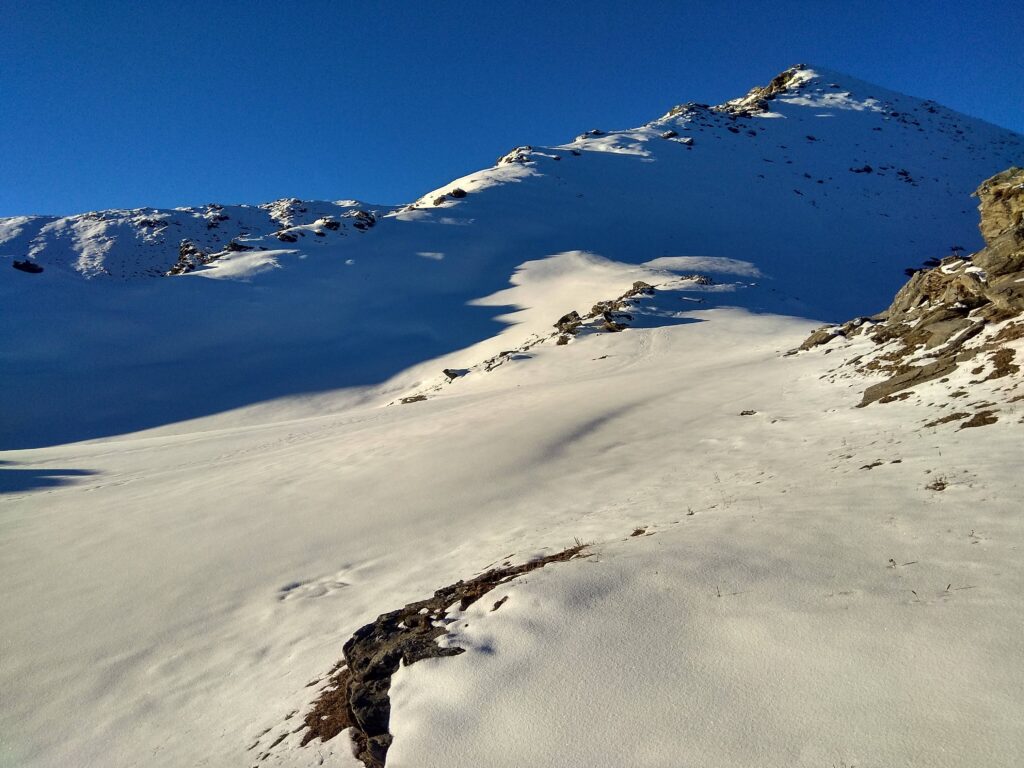
Day 4 is the day you’ve been waiting for! The trek to the summit from the base camp is not long, and upon reaching the top, you’ll be rewarded with a jaw-dropping 360-degree view of the Uttarakhand peaks, the Chaainsheel Pass, and the Kailash ranges of Himachal. You can even see the Har Ki Dun valley below. The Kedarkantha summit is marked by an arrangement of stones with a Trishul pointing to the sky. Legend has it that the peak was meant to be the original Kedarnath temple, but Lord Shiva, who was disguised as a cow hiding from the Pandavas, was disturbed during meditation by the villagers. The interruption made him change his location to the present Kedarnath temple.
After spending time on the summit, we hike back to the base camp and head towards Hargaon (2 km trail) post-lunch. Hargaon is a large camping area en route to Sankri, where we will spend the night before bidding farewell to this beautiful place.
Day 5 Hargaon to Sankri: 4 km trek in 2 to 3 hours
Today is the final day of our trek and we will descend from Kedarkantha to Sankri, which is a 4 km trek taking 2-3 hours. Once we reach Sankri, you can take the rest of the day to explore the charming village and nearby villages like Gangad and Osla, which are known for their warm hospitality and traditional Pahari culture. Sankri is also the last road head to the Govind Balabh Pant Wildlife Sanctuary.
Day 6 Sankri to Dehradun: 187 km drive in 7 to 8 hours

Going back home is always a bittersweet moment, but the journey is made easier by taking the same picturesque road back to Dehradun. As we leave behind the dense pine forests and descend towards the city, the landscape slowly changes and opens up into wider roads. Finally, we arrive in the bustling city, bidding farewell to the serene mountains and valleys of Uttarakhand.
Day 2 How difficult is the trek & what are the challenges?
Kedarkantha trek photos:.

Upcoming Treks
- November 2, 2024 open
- November 3, 2024 open
- November 9, 2024 open
- November 10, 2024 open
- November 16, 2024 open
- November 17, 2024 open
- November 23, 2024 open
- November 24, 2024 open
- December 1, 2024 open
- December 2, 2024 open
- December 3, 2024 open
- December 4, 2024 open
- December 5, 2024 open
- December 6, 2024 open
- December 7, 2024 open
- December 8, 2024 open
- December 9, 2024 open
- December 10, 2024 open
- December 11, 2024 open
- December 12, 2024 open
- December 13, 2024 open
- December 14, 2024 open
- December 15, 2024 open
- December 16, 2024 open
- December 17, 2024 open
- December 18, 2024 open
- December 19, 2024 open
- December 20, 2024 open
- December 21, 2024 open
- December 22, 2024 open
- December 23, 2024 open
- December 24, 2024 open
- December 25, 2024 open
- December 26, 2024 open
- December 27, 2024 open
- December 28, 2024 open
- December 29, 2024 open
- December 30, 2024 open
- December 31, 2024 open
- January 4, 2025 open
- January 5, 2025 open
- January 11, 2025 open
- January 12, 2025 open
- January 18, 2025 open
- January 19, 2025 open
- January 25, 2025 open
- January 26, 2025 open
- February 1, 2025 open
- February 2, 2025 open
- February 8, 2025 open
- February 9, 2025 open
- February 15, 2025 open
- February 16, 2025 open
- February 22, 2025 open
- February 23, 2025 open
- March 1, 2025 open
- March 2, 2025 open
- March 8, 2025 open
- March 9, 2025 open
- March 15, 2025 open
- March 16, 2025 open
- March 22, 2025 open
- March 23, 2025 open
- March 29, 2025 open
- March 30, 2025 open
FAQ's about Trek
What are the things to carry for trek to kedarkantha peak.
Kedarkantha Peak in Winters:-
Adequate Clothing Includes –
- Appropriate Base Layers – i.e. Warmers (avoid cotton warmers/inner wear and choose synthetic or woolen base layers)
- Warm Layer including One Padded or Down Jacket and a fleece or sweater
- A Thin waterproof jacket to protect from Snow, Rain, or wind (Alternatively you can carry a waterproof warm jacket such as a Snow Hiking Jacket which serves the purpose of being warm and waterproof both)
- Two Synthetic Trek Pant/Lowers (avoid jeans, cotton lowers)
- Waterproof Pants (Optional, if using gaiters)
- 1 Warm lower (preferably fleece) for overnight wearing in camp
Equipment & Protective Clothing such as
- Waterproof and Warm Gloves
- Trekking Pole
- Micro Spike (Provided by us)
- Gaiters (Provided by us)
- Woolen Cap/ Scarf
- Neck Gaiter/Balaclava
- Sunglasses (Preferably Polarized if trekking in winter)
- Waterproof High Ankle Shoes
- 3-4 pairs quick drying socks
- 1-2 pairs of woolen socks
- Quick Drying Towel
Why trek with Himalaya Shelter?
“ I have been doing treks with Himalaya Shelter for the last two years and they are awesome people with pure humbleness. “
Writes Priyesh.
We at Himalaya Shelter consider our trekkers part of our community, a family of sorts and really understand the efforts that you put into taking that much-needed break and setting off to the mountains. Some of you may wait for months and even a year to plan out that perfect excursion. That’s why we want it to be “a perfect excursion” for you.
Our testimonials (read below) are a testament to our service-oriented mindset.
We take safety into great consideration and ensure our team is trained to handle emergency situations.
For a better experience, we provide accommodation on Twin Sharing throughout the trek. With most trekking operators you would get triple or even quad sharing accommodation.
Our Accommodation will have attached washrooms
(In Sankri on 1st and 5th Night)
Furthermore, we provide the essential safety gear for your trek – – Crampons – Gaiters Without any additional charges.
We pamper you with great food which keeps you going on the trek. (On our google maps out of 300 reviews over 80 Trekkers mention great food😋)
We do not outsource services to ensure topmost quality throughout your journey. We use our own fleet of Vehicles to ferry you to the base camp and return.
Lastly, being a local operator we are direct stakeholders in the economic and social development of Uttarakhand. Employing locals and helping them progress in their lives goes hand in hand with work. Thus choosing Himalaya Shelter, is a step in helping us help locals progress by ensuring financial independence and social progress.
What will be the pickup point and pickup time from Dehradun on Day 1?
The trek pickup point will be near Dehradun railway station. The exact location will be shared with you prior to departure day.
The departure time remains 7 AM sharp for every group departure.
Trekkers arriving by Flight should ideally arrive 1 day in prior. The Airport (Jolly Grant) is situated at least 1 hour drive away from Dehradun Railway Station in the opposite direction. If you’re arriving by flight it is thus advised to travel a day prior due to lack of early morning flights.

When snowfall starts in Kedarkantha?
Snowfall in Kedarkantha typically starts in late November or early December and continues through the winter months until February.
Is Kedarkantha trek safe in January?
Yes, the Kedarkantha trek in January can be safe, but it also comes with certain challenges due to the winter conditions. The weather can be extremely cold and snowy, so it’s crucial to be cautious and informed before attempting the trek in January.
What is Kedarkantha to kedarnath distance?
The Kedarkantha to Kedarnath distance is approximately 396 kilometers. This distance includes 360 km of driving and 26 km of trekking.
- Kedarkantha summit to Sankri trekking:- 10 km
- Sankri to Gauri kund driving:- 360 km
- Gauri kund to Kedarnath:- 16 km
What is the lowest temperature in Kedarkantha?
The lowest temperature recorded in Kedarkantha was around -12°C (10°F).
What is Kedarkantha Trek route?
The Kedarkantha trek typically starts from the Sankri village to Juda Ka Talab. It is about 4-5 km. From Juda Ka Talab to Kedarkantha Base Camp, it is around 4-5 km. The trail leads through meadows with panoramic mountain views. Then, Kedarkantha Base Camp to Summit is roughly 6-7 km. And finally, Hargaon to Sankri is about 4-5 km. The total trek distance is approximately 20-24 km.
What is the Kedarkantha trek cost?
The Kedarkantha trek price is influenced by various factors such as the time of year, trek duration, group size, and preferences in accommodation and services. You can expect a budget between INR 6,000 and INR 12,000 per person for a 4-5 day trek.
This cost typically covers:
- Transportation to and from the trek’s starting and ending points
- All meals & Accommodation throughout the trek
- Trekking equipment like Kitchen tent, Dining tent, Toilet tent, etc
- Sleeping bags, Mattresses, Camping stools,
- Trekking permits and fees
- Services of an experienced trek guide and support staff
- Basic First Aid kit
Opting for a group trek is an alternative approach. It’s an effective way to cut down on transportation and accommodation expenses. Furthermore, certain operators extend discounts, catering to budget-conscious travelers.
How to reach Kedarkantha trek from Delhi?
The distance from Delhi to Kedarkantha is about 433 km. It takes about 11 to 12 hours of driving from Delhi to Sankri and 10 km of trekking from Sankri to Kedarkantha Peak.
There are three ways to reach the Sankri trek from Delhi.
Kedarkantha from Delhi by Road:-
Bus: Direct buses run between Delhi and Dehradun. They depart from the central bus station in Delhi and arrive at the main depot in Dehradun. Upon reaching Dehradun, you can board another bus that will take you directly to Sankri. After arriving in Sankri, you’ll need to start a 10 km trek to reach Kedarkantha Peak, a journey that typically spans 1 to 2 days.
Kedarkantha from Delhi by Air:-
To reach Kedarkantha from Delhi by air, simply catch a direct flight from Delhi Airport to Jolly Grant Airport in Dehradun. Upon arrival at Jolly Grant Airport, you’ll find a multitude of taxi services available at the exit, ready to take you to Dehradun. From Dehradun to Sankri drive takes around 7 to 8 hrs. Upon reaching Dehradun, you can board another bus that will take you directly to Sankri. After arriving in Sankri, you’ll need to start a 10 km trek to reach Kedarkantha Peak, a journey that typically spans 1 to 2 days.
Kedarkantha from Delhi by Rail:-

It’s recommended to opt for the overnight Kota Express, also known as Nanda Devi Express, departing at 11:50 PM, and arriving in Dehradun at 5:45 AM, aligning with other transportation schedules from Dehradun to Sankri.
How is the Kedarkantha trek route map?
How is the climate of kedarkantha in march.
In March, the weather in Kedarkantha is quite chilly. During the day, temperatures range from about 15 to 10 degrees Celsius, while at night, it can drop to about 10 to 5 degrees Celsius. Sometimes, there might be unexpected snowfall and strong winds. However, for the most part, the sky is clear and sunny, providing stunning views of the snow-covered mountains.
What is the distance of Kedarkantha summit from Sankri basecamp?
The Kedarkantha summit is only about 10 km from Sankri and can be covered in approximately 6 to 7 hours. Most trekkers complete this distance of 10 km in two days, with a daily distance of 4 to 5 km.
Is Kedarkantha trek open in December?
Yes, you can go for the Kedarkantha trek in December. It’s a popular winter trek in India. From December to March, the trek is all covered in snow, making it very special.
But, it can be a bit hard, especially if you’re new to trekking. Kedarkantha weather in December might suddenly change, and there could be a lot of snow and strong winds. The paths can also be slippery.
If you’re thinking of going on this trek in December, it’s really important to be well-prepared and go with a good trekking group. Bring warm clothes, strong shoes, and other things you’ll need for trekking.
How to reach Kedarkantha from Dehradun?
To get to Kedarkantha from Dehradun, first, you need to reach Sankri. Once you arrive in Sankri, begin the trek to Kedarkantha summit, which is approximately 10 km away from Sankri.
How to Reach Sankri from Dehradun :-
Every morning, a limited number of shared cabs and buses depart for Sankri from the vicinity of Dehradun Railway Station.
Govt. Buses and Private Buses-
Only one government bus departs from Dehradun Railway Station to Sankri at 8:00 am. Additionally, two private buses leave around 7:00 am from just outside the Dehradun Railway Station heading to Sankri town. The fare for this journey is approximately Rs. 400 per person, which is roughly the same for both the government and private buses.
Private Cab or Taxies-
You can easily locate shared taxis near Hotel Milan or Hotel Grand, merely a 2-3 minute walk from Dehradun Railway Station. These taxis operate up to Purola, which is 54 kilometers away from Sankri. The journey lasts approximately 5 to 6 hours, with a fare of Rs. 400.
From Purola, you’ll find shared cabs to take you directly to Sankri. However, it’s crucial to bear in mind that these cabs typically depart before noon. Hence, plan to reach Purola in the morning if you choose this route . The cab fare from Purola to Sankri ranges from 200 to 300 rupees. (This fare is applicable only when the taxi is full of passengers; otherwise, the cost may vary based on the number of participants.)
In case you miss the buses or taxis from Dehradun for any reason, or due to personal preference, you also have the option to book a private taxi from the same location or near Prince Chowk, approximately 100 meters away from the Railway Station. This would amount to approximately Rs. 6,000 to Rs. 7,000 for booking a Maxx or Bolero.
Shared or Private Vehicle arranged by Himalaya Shelter-
Himalaya Shelter offers both shared and private transport services directly to Sankri for trekkers. Please note that for shared vehicles, we have fixed departure dates, and it is advisable to book your seats at least a week in advance of the departure from Dehradun. We also offer pickup and drop facilities for your hotel stay in Dehradun.
What is the best time for Kedarkantha Trek?
The best time for Kedarkantha Trek is during the winter months of December to February as the trail to Kedarkantha is completely covered with snow, offering a stunning view of the beautiful landscape and snow-capped mountains of Garhwal Himalayas around the trail. Mt. Swargarohini, Mt. Bandarpunch, and Black Peak are some of the major mountains that look stunning in winter.
Anyone with a moderate level of physical fitness can easily complete the Kedarkantha trek during this time. This period is more suitable for beginners as the trail can be successfully completed even in heavy snow. This period is perfect for beginners to really enjoy the immense pleasure of their first experience on snow-covered landscapes at a high altitude. The climate is generally pleasant and it rarely rains or snowsfall, except that there can be heavy snowfall at sometimes. December is the coldest month when the temperature is often below zero and the rest of the winter months have an average temperature of 15 to 5 degree Celsius during the day and 0 to -5 degree Celsius at night. March to April is best suited for trekkers who want to trek in the snow-clad region as well as enjoy the blooming flowers and rhododendrons making it a perfect combination of winter and spring scenery.
How difficult is the Kedarkantha Trek in winter if I am a beginner trekker?
Kedarkantha trek in winter is considered moderately difficult, but the well-defined trail and gradual ascent make it a good option for beginners. However, without proper gear and basic knowledge of the trail, even an easy trek can become highly challenging and risky.
Below are some of the major difficulty points and skills that can be considered to help reduce the overall difficulty of Kedarkantha trek in winter, especially for beginners:
- Snow-covered trails with slippery patches and vergas: Wear waterproof hiking boots, gaiters and micro-spikes on snowy trails and follow marked footprints. Also use trekking poles for support.
- Cold temperatures in winter: Be prepared with 5 layers of clothing as the temperature can drop below zero.
- Cold weather conditions and heavy snowfall: Make sure you have appropriate gear like ponchos, gloves, mufflers and extra socks. Also, keep a polythene bag to ensure your stuff stays dry in the backpack.
- Steep climb while reaching the summit: Keep your walking pace consistent and move slowly. Also do some general warm-up before trekking.
- Multiple trails increase the risk of getting lost: Always follow the guide and obey their instructions. Trekking with a guide also ensures safety and better way management on snow-covered trails.
- Feeling a little hungry while hiking: Feeling a little hungry while hiking is not a big problem, but it can reduce your overall trek experience. So, carry chocolate bars, nuts and other energy snacks to maintain your energy levels on the trail.
Is there any chance of Acute Mountain Sickness during the Kedarkantha Trek?
Yes, AMS can be expected as the Kedarkantha Trek goes up to approximately 12,500 feet (3,800 meters) above sea level. For most trekkers, this altitude is well attainable. However, those who are sensitive to changes in altitude might face mild symptoms of AMS such as headaches, confusion, vomiting, difficulty in sleeping, dizziness, nausea, and undue tiredness. It should be understood that having a high physical fitness level does not minimize the likelihood of getting AMS because altitude sickness results from variations in atmospheric pressure.
To minimize the risk of AMS, follow these tips:
- Ascend Gradually: Staying away from steep vertical gain is good advice to follow. Travel with care if you want to avoid the development of AMS; the altitude should be changed gradually by no more than 300 m per day.
- Stay Hydrated: Increase the intake of water to the body to reduce the viscosity of the blood, thus facilitating the increased transport of oxygen to the tissues at higher altitudes.
- Avoid Alcohol and Caffeine: Both could dehydrate your body, limit blood flow, and enhance your probability of getting sick.
- Acclimatize Properly: Take appropriate breaks, apply some form of stretching routines, and also try to understand the signs of your body.
If the symptoms do not vanish, one should start to descend as fast as possible, possibly not waiting for the onset of serious problems.
To know more about AMS, read this blog: Acute Mountain Sickness .
What is the best time to do the trek and how is the weather?
What are the top highlights of the trek, kedarkantha trek package inclusions.
- Pick-up location: Prince Chowk, near Dehradun Railway Station
- Pick-up Time: 6:30 - 7:00 am
- Guest house accommodation for the night stay of first day and the second-last day of the itinerary | Triple Sharing in one room.
- Alpine tent accommodation for the night stay of Day 2, Day 3 and Day 4 of the itinerary | Twin Sharing in one tent.
- Meals during transportation will be excluded.
- Meals will be provided according to a North Indian food menu.
- The package includes a total of 5 breakfasts, 4 lunches, 4 evening tea snacks, and 5 dinners.
- BMC & AMC certified Guide.
- Cook and support staff.
- Kitchen Tent & Cooking Pots
- Dining Tent & Dining Table
- Plates, spoon, glass, bowl (Carry a lunch box for packed lunches)
- Gas Stove & Cylinder
- Clean sleeping bags and mattresses
- Good quality ‘A’ shaped or dome tents
- Camping stools, Table
- Crampons and gaiters (only if required)
- Toilet Tent with portable toilet seat
- First-Aid kit with Oximeter and Portable Oxygen Cylinder.
- Forest entry charges for Indian nationals (Additional charges will be applicable for international tourists).
- Porter and mule support to carry camping and cooking equipment NOT personal luggage.
- Your designated hotels may not reopen by the time you reach there. While we are making alternate arrangements, do understand that things may not be as “tip-top” as our designated hotels.
- The gurudwara, Hemkund Sahib may not be open. While we are trying to take permission to go to Hemkund Sahib, if it does not happen, then do understand that the pandemic has put restrictions beyond our control.
Package Exclusions
- Personal expenses like tips, personal medicines, phone calls etc.
- Any transport support during the trek apart from what is included above
- Any cost or services not mentioned in the Inclusions
- Accommodation in Dehradun or in the last day of the trek
- Adventure Insurance
- Cost arising due to unforeseen incidents like bad weather, medical evacuation, roadblocks etc
- Porter and mule support to carry personal Luggage can be arranged at an additional cost of INR 350 per bag per day (weighing up to 12 kg)
- Please carry a lunch box for packed lunch/breakfast to avoid using polythenes and Aluminium foils. Keeping the Himalayas clean is our own responsibility. Reduce the use of Plastic when you are in the abode of the Sacred Himalaya. 🌱
- 17-07-2021 to 23-07-2021 open
- 17-07-2021 to 23-07-2021 close
Send Request
Your query has been successfully registered. we will contact you within 24 hours., something went wrong.try after sometime..
Search Here
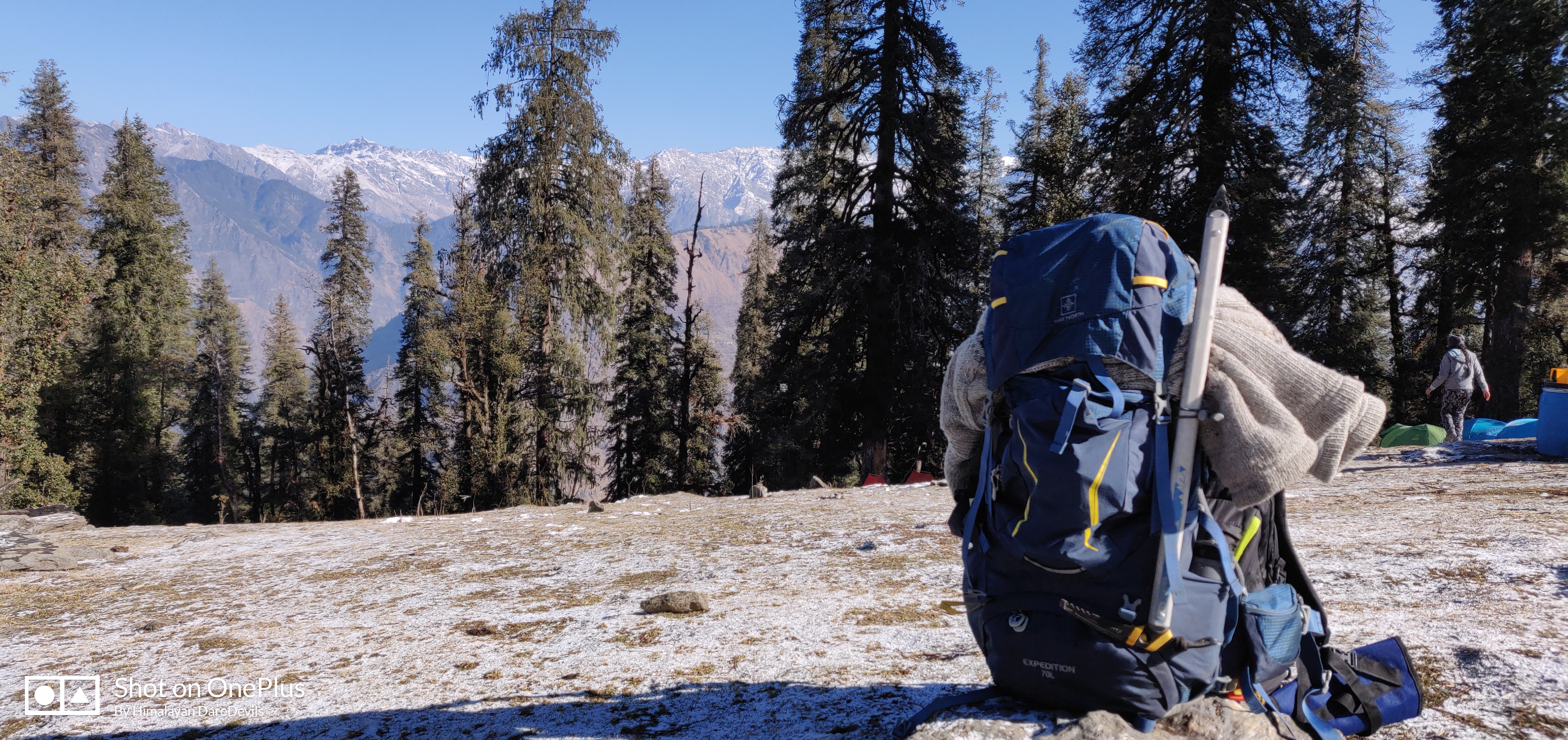
Kedarkantha Trek
Uttarakhand,uttarakhand (115+ reviews).
Starting From
6499 Download PDF Book Now
Price On Demand
Kedarkantha trek: a spiritual exploration.
The Kedarkantha Trek, located in the pristine Govind Pashu Vihar National Park of Uttarakhand, India, is a renowned 6-day adventure that captivates seasoned trekkers and beginners alike. With its most significant highlight being the rewarding summit climb, this trek offers a unique and unforgettable experience in the Indian Himalayas.
The journey begins with a scenic drive from Dehradun to the base camp, setting the tone for the forthcoming adventure. The spectacular peak of Kedarkantha rises tall as you begin your trek from the base camp in the early morning hours, motivating you to scale its heights. The ascent starts off moderately tough, and as you go up, it gets harder and harder; it takes willpower and patience to make it. However, the majestic allure of the upper Himalayas keeps you motivated throughout the ascent.
Every trekker strives to reach Kedarkantha's summit since it is the highest achievement. Pushing your limitations and overcoming challenges to achieve an unmatched sense of success are key components of reaching the top of a mountain. A panoramic view of the Himalayan peaks opens out before you as you stand on the summit, awarding you with breathtaking sights that make your heart sing with joy.
The Kedarkantha Trek has a lot more to offer than just the peak. The presence of breathtaking clearings along the numerous pathways is one of its distinguishing characteristics. These clearings offer peaceful resting areas and charming campsites that let hikers take in the surrounding natural splendor. The strategically placed clearings give excellent viewpoint spots from which trekkers may fully experience the splendor of the route and the breathtaking panoramas.
The enchanting woodlands along the Kedarkantha Trek are yet another noteworthy feature. Your senses will be captivated by the variety of woodlands you pass through on the walk. The lush greenery and varied flora create an immersive experience, making you feel one with nature. The enchanting forests are a delight for nature lovers and adventurers alike, and they add an extra layer of magic to the entire trek.
We offer numerous all-inclusive trek packages for people looking to take on the Kedarkantha journey to suit varied tastes and needs. Our Kedarkantha Trek Packages encompass travel from Dehradun to the base camp and back, along with all essential amenities and guided support throughout the trek. The cost of the packages varies depending on the inclusions and duration, making them accessible to a wide range of trekkers.
In the Indian Himalayas, the Kedarkantha Trek is the peak of adventure and scenic splendor. With its rewarding summit climb, picturesque clearings, and captivating forests, this trek promises an unforgettable journey that leaves trekkers with a profound sense of accomplishment and a deep connection with nature. Whether you are an experienced trekker or a novice seeking to explore the wonders of the Himalayas, the Kedarkantha Trek is a must-try expedition that will undoubtedly leave an indelible mark on your heart and soul.
Trail Type : One way trail. The trek starts and ends at Sankri
Rail Head : Dehradun Railway Station
Airport : Jolly Grant Airport, Dehradun
Base Camp : Sankri
Best Season : January | February | March | April | October | November | December
Service From : Sankri to Sankri
Meals : Meals while on trek ( Veg and Egg)
Stay : Homestay/ Camping
Region : Uttarakhand
Duration : 5 Days
Grade : Easy
Maximum Altitude : 12500 Ft
Approx Trekking KM : 22 Km
1. Meals while on trek (Veg. + Egg).
2. All necessary entry fees and permits.
3. Accommodation: - Guest house, Home stay, camping during Trek.
4. Mountaineering qualified & professional trek Leader, guide, cook and Support staff.
5. First aid medical kits, stretcher and oxygen cylinder.
6. Trek equipment: Sleeping bag, mattress, tent, kitchen & dinning tent, toilet tent, utensils and crampon (if required)
7. Staff Insurance.
8. Porters/mules to carry central equipment.
1. Any kind of personal expenses.
2. Food during the transit.
3. Mules or porter to carry personal luggage.
4. Insurance.
5. Any kind of emergency evacuation charges
6. Anything not specifically mentioned under the head.
7. Transport (Non Ac)
8. Any expense incurred or loss cost by reasons beyond our control such as bad weather, natural calamities (landslides, floods), flight delays/rescheduling/ cancellations, any accidents/medical evacuations, riots/strikes/war/pandemics etc.
What to carry
- Trekking shoes: A good pair of trekking shoes is essential for a comfortable and safe trek. Look for shoes that are sturdy, provide good ankle support, and have a good grip on different types of terrain.
- Backpack with rain cover (50-60 ltr): A backpack is necessary to carry all your gear. Make sure it's the right size for your trek, and comes with a rain cover to keep your belongings dry in case of rain.
- Thermals (upper and lower): Thermals are lightweight and comfortable base layers that help regulate your body temperature in cold weather. Bring both upper and lower thermals to keep warm.
- 3 T-shirts (advisable quick dry): Choose quick-drying T-shirts made from breathable and moisture-wicking materials. This will help keep you cool and dry during your trek.
- 2 trek pants: Choose lightweight and comfortable trek pants that are easy to move in and can dry quickly if wet.
- Jacket (-10 degree): A warm jacket is essential for cold weather. Choose a jacket that is waterproof and windproof, and provides good insulation.
- Fleece or hood (2): Fleece jackets or hoodies are great mid-layer options to keep warm. Bring at least two, as they can also be used as an extra layer at night.
- Sunglasses (UV protected): Protect your eyes from the sun's harmful UV rays with sunglasses that are designed for outdoor activities.
- Sun cap: A sun cap or hat with a brim will protect your face and neck from the sun.
- Hand gloves: Bring a pair of lightweight gloves to keep your hands warm and protected from wind and sunburn.
- Woollen cap: A woollen cap will keep your head and ears warm at night or in cold weather.
- Socks (3 pairs min): Bring at least three pairs of good quality socks that are moisture-wicking and provide good cushioning and support for your feet.
- Headlamp: A headlamp will come in handy if you're hiking in low-light conditions or need to find your way in the dark.
- Trekking pole (if needed): Trekking poles can help reduce strain on your legs and provide additional support on steep terrain.
- Rain cover\poncho: A rain cover or poncho will keep you and your gear dry during unexpected rain showers.
- Day pack (if you plan to offload your bag): If you plan to offload your backpack during the trek, bring a smaller day pack to carry essentials like water, snacks, and a first aid kit.
- A toiletry kit: Bring a small kit with personal hygiene items, such as a toothbrush and toothpaste, wet wipes, hand sanitizer, and toilet paper.
- Lunchbox, cup, spoon: If you plan to bring your own food, bring a lunchbox, cup, and spoon to carry and eat your meals.
- 2 one-litter bottles: Staying hydrated is crucial, so bring at least two one-liter bottles to carry water.
- 2-3 plastic covers to keep your wet or used clothes: Plastic bags are useful for keeping wet or dirty clothes separate from the rest of your belongings. They can also be used to pack out any trash or waste you generate during the trek.
How to reach
- By Air: The nearest airport to Kedarkantha is Jolly Grant Airport in Dehradun, Uttarakhand. From there, you can hire a taxi or take a shared cab to reach Sankri, the base village for the trek. The distance between Dehradun and Sankri is approximately 200 km, and the journey takes around 8 hours by road.
- By Train: The nearest railway station to Kedarkantha is Dehradun Railway Station. From the railway station, you can hire a taxi or take a shared cab to reach Sankri. The distance between Dehradun and Sankri is approximately 200 km, and the journey takes around 8 hours by road.
- By Road: If you are traveling by road, you can take a bus or hire a taxi from Dehradun to reach Sankri. Regular buses operate from Dehradun to Sankri. The journey takes around 8 hours.
Cancellation policy
Life is unpredictable and we understand sometimes you have to cancel or change your trip dates and it is our endeavour to make it as easy possible for you. However, please understand we plan everything including guide fees, permits, accommodation and ration in advance. Therefore any cancellation means inconvenience and certain losses to the people involved in various stages of programme. Keeping that in mind, our cancellation charges are as below-
Cancellation prior to 30 days from start of the event: Get monetary refund with 15% of cancellation charges on trek fee.
Cancellation between 30 days and 15 days to the start of event: 50% on trek fee is non refundable and the remaining 50 % will be given as cash voucher which is valid for 1 year.
Cancellation less than 15 days to the start of event: No refund.
Please note cancellation will be only accepted by email.
Note: The Himalayan Daredevils reserves the right to cancel a programme before departure in the event of logistical problems arriving due to natural calamities, strikes, wars on any other circumstances that makes the event inadvisable. In this case, we will refund 50% of the event fees.
Itinerary changes & trip delays:
We plan itineraries based on the information at the time of planning and in rare circumstances, there are subject to change. In the event that the itinerary is changes or delayed due to unforeseen circumstances such as bad weather conditions, transportation delays, government intervention, landslides etc. We will always aim to give you the best experience possible. However The Himalayan Daredevils are not be held responsible for the cost of delay or changes.
Calendar View
Available Dates :
November 2024 December 2024 January 2025 February 2025 October 2024
Note:- For booking click on the dates available in green color
Modal title
Why Choose Us
Our Best Performance
50,000+ travelers, pan india tour, 250+ bike trips, 4,000+ successful trips, medical and mechanical backup, organized travel itineraries.
Related Blogs
Read and get more about our treks
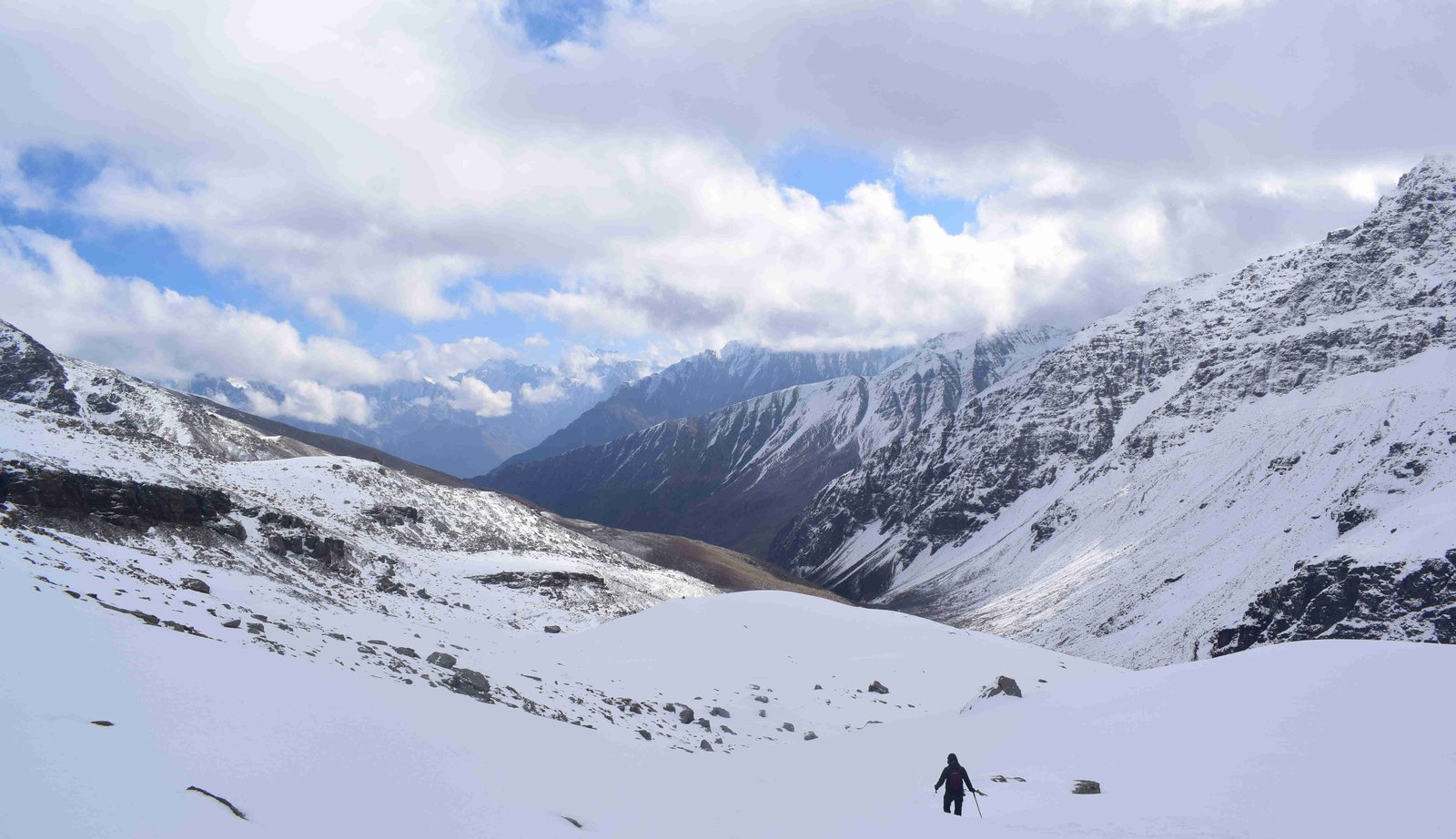
How to Physically Prepare for the Rupin Pass Trek
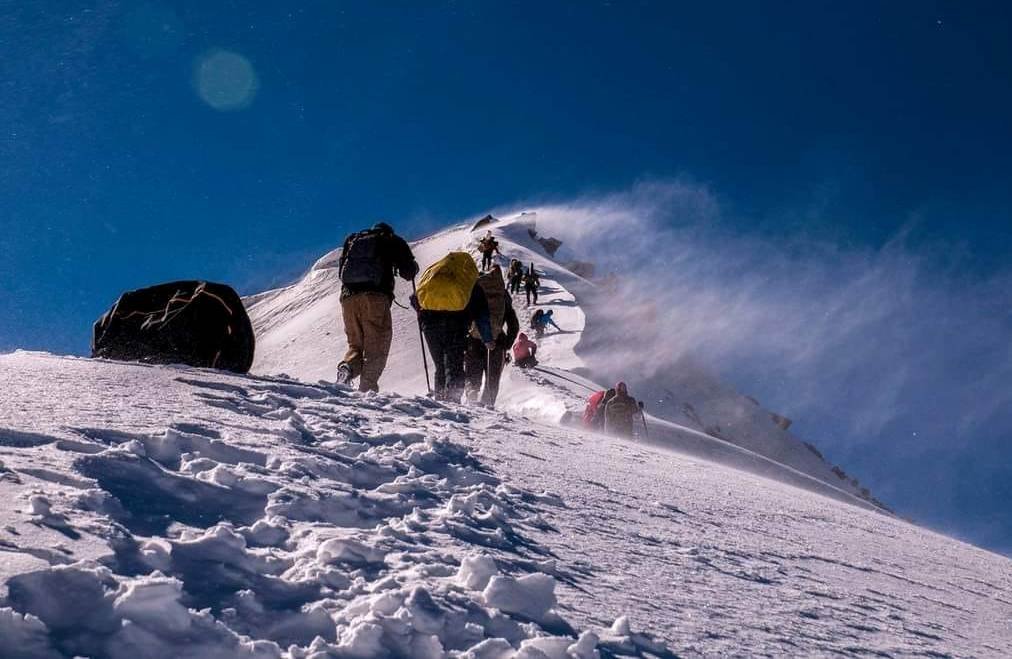
Best Time to Explore Bali Pass Trek in Uttarakhand
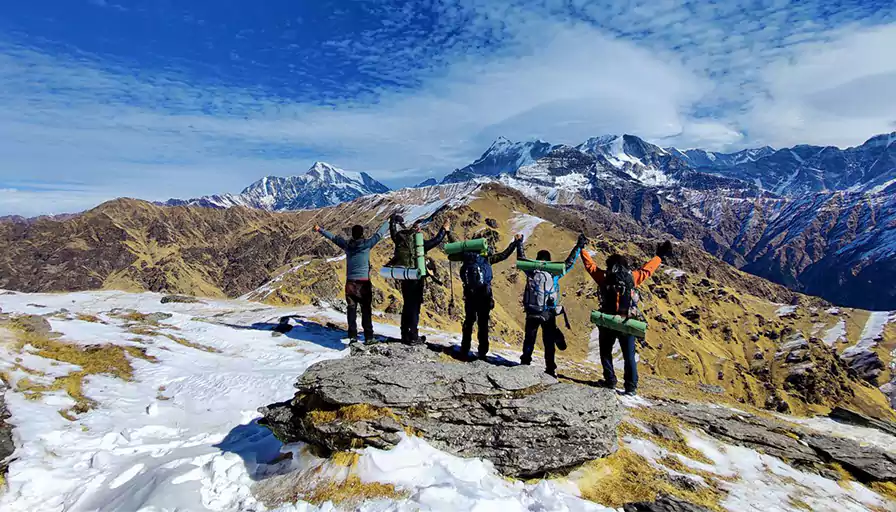
Why Ali Bedni Bugyal Trek is a Must-Do for Nature Lovers
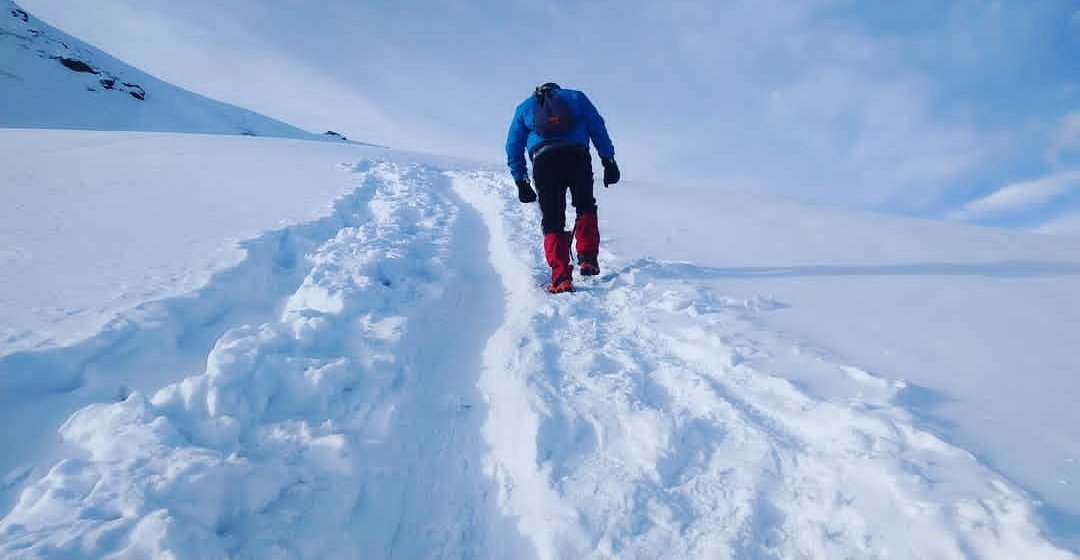
How to Prepare for a Himalayan Winter Trek? 6 Prerequisites
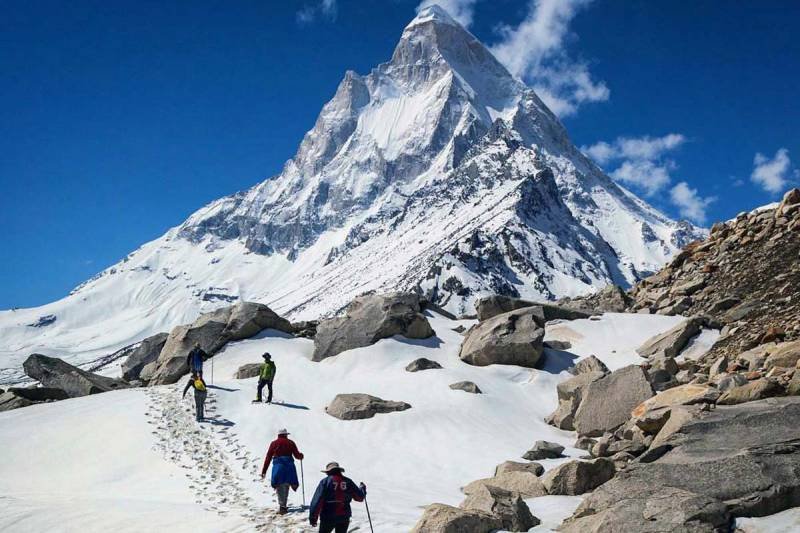
Embark on the Adventure of the Gaumukh and Tapovan Trek

Top 5 Best Winter Treks in India
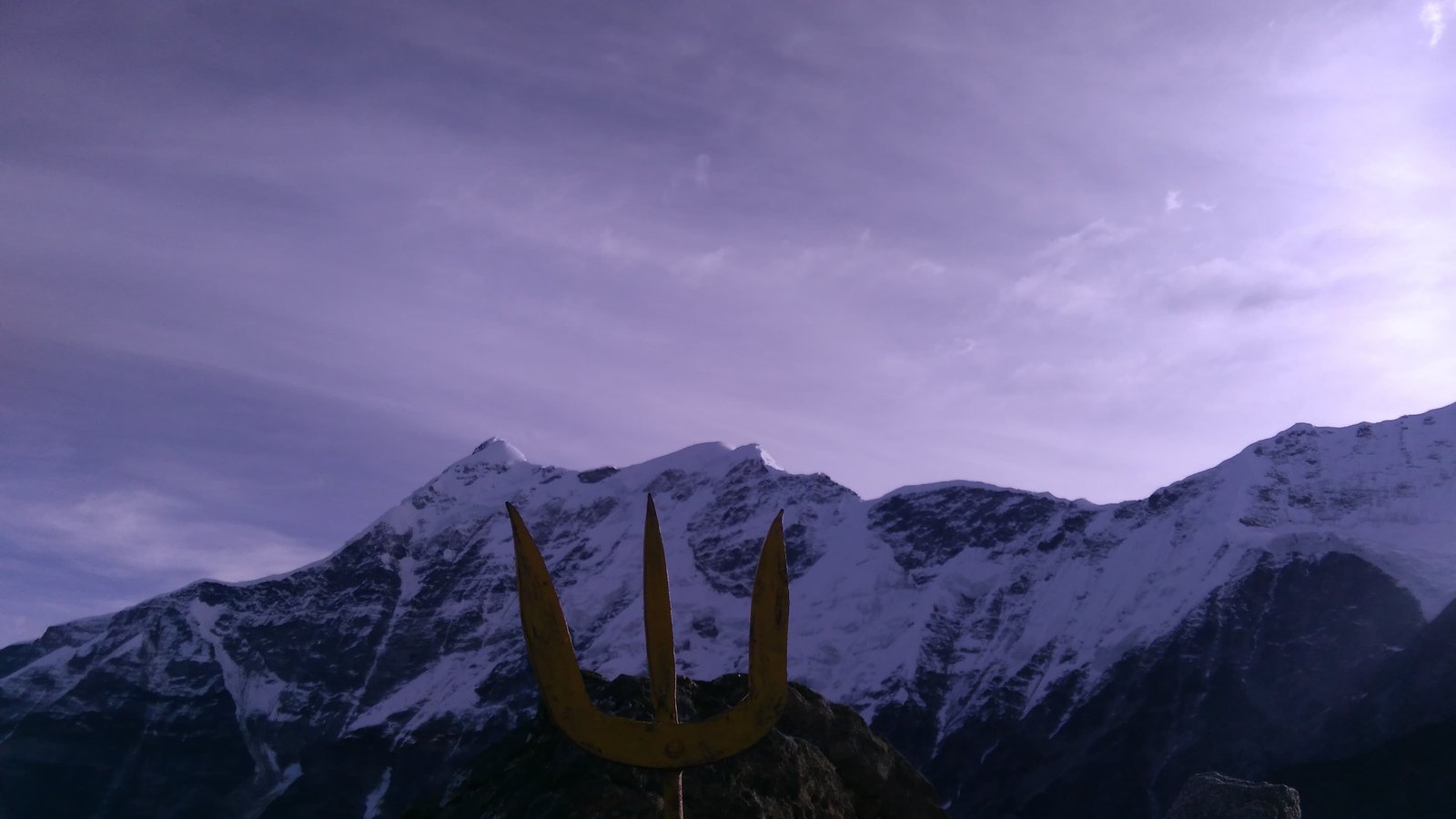
Best Time To Visit Roopkund Lake Trek, Uttarakhand
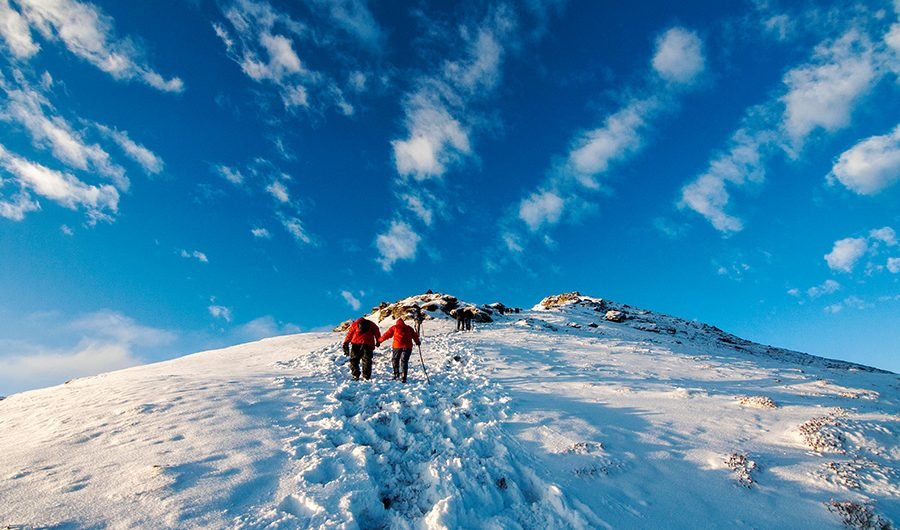
Kedarkantha Trek - Best Winter Trek

Best Time to do the Har Ki Dun Trek - Himalayan Daredevils

Hampta Pass vs Pin Bhaba Pass: Which Trek to Choose?

Top 5 Himalayan Monsoon Trek in India
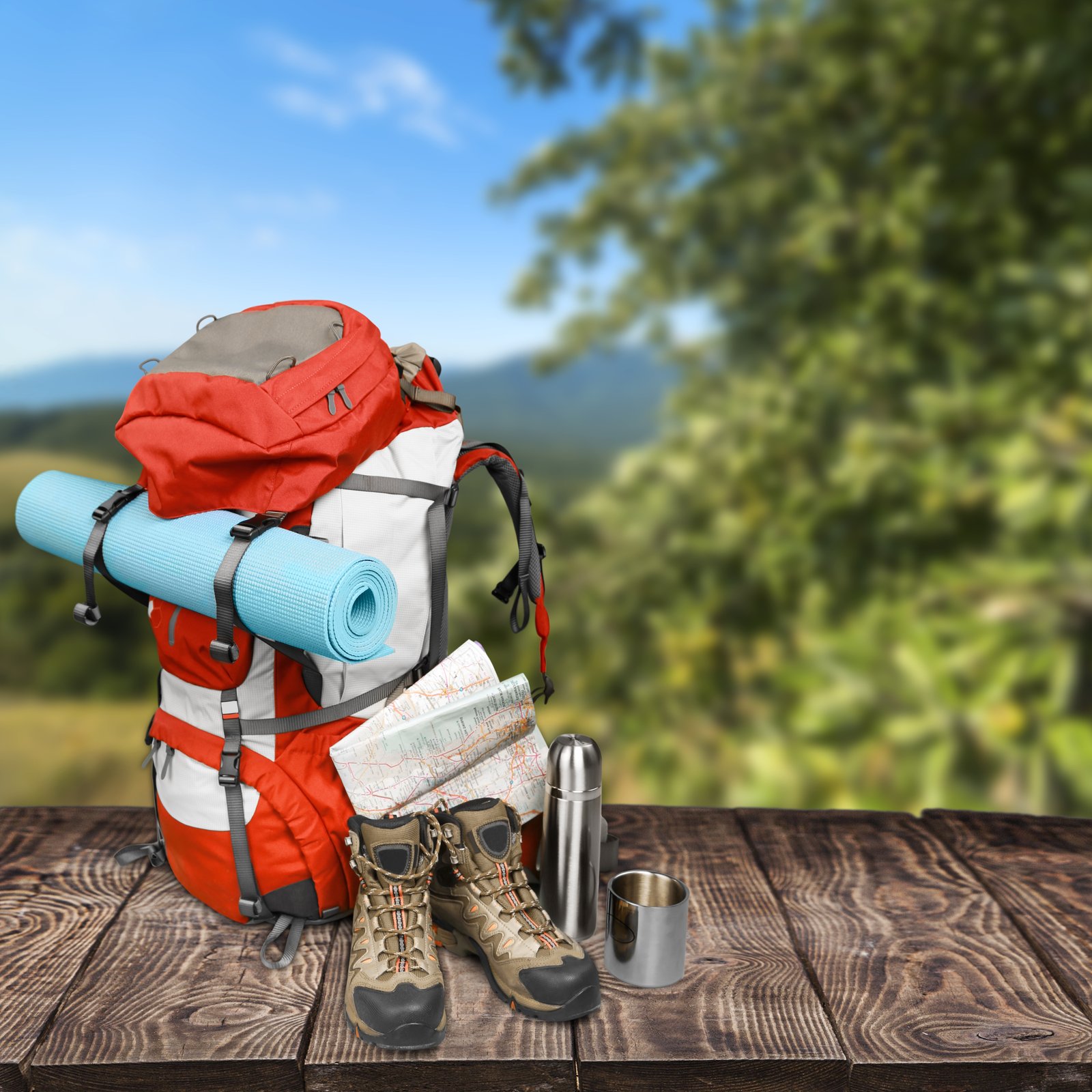
Best Trekking Backpack Essentials for Your Adventure
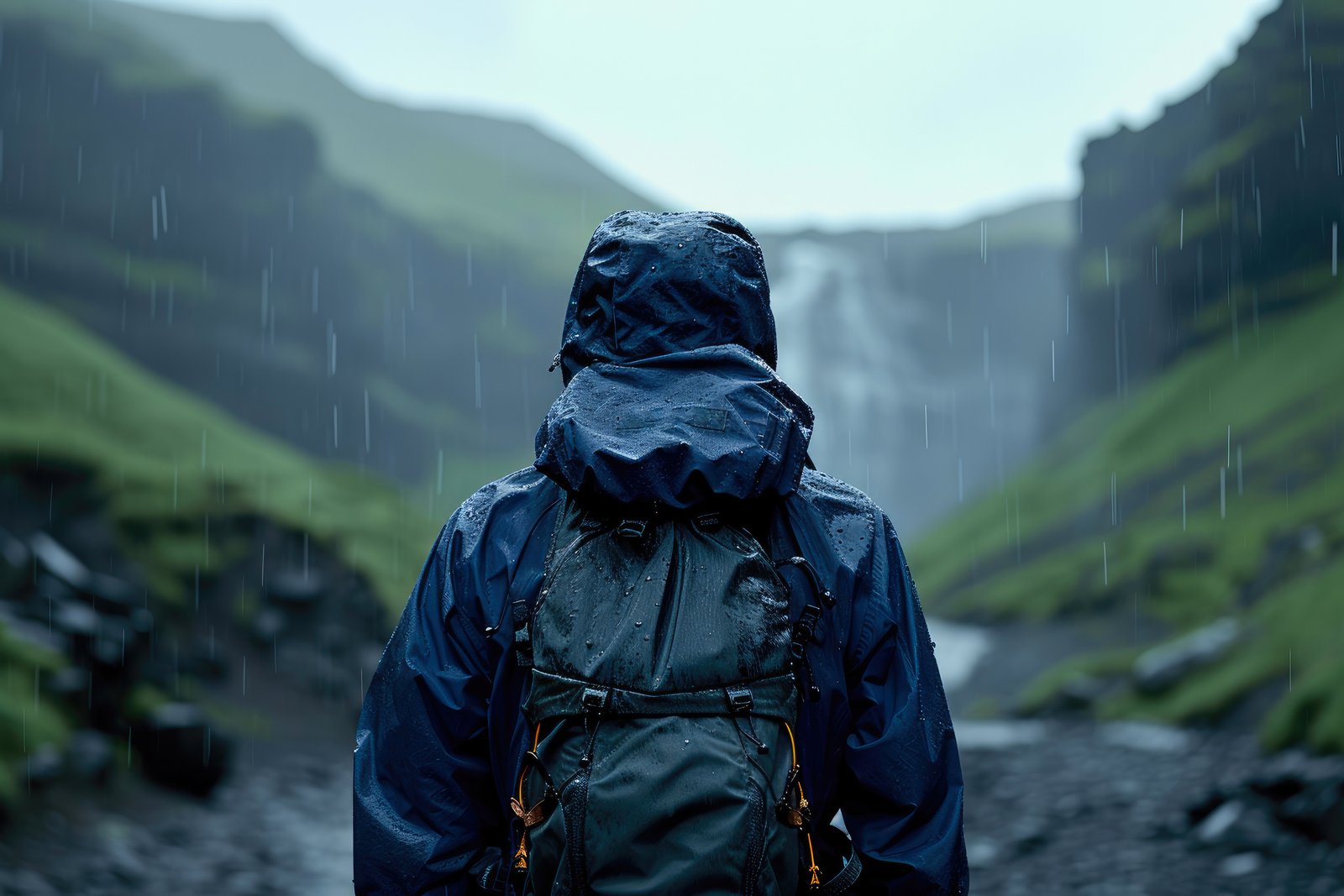
Best Tips for Hiking in the Rainy Season Safely and Enjoyably
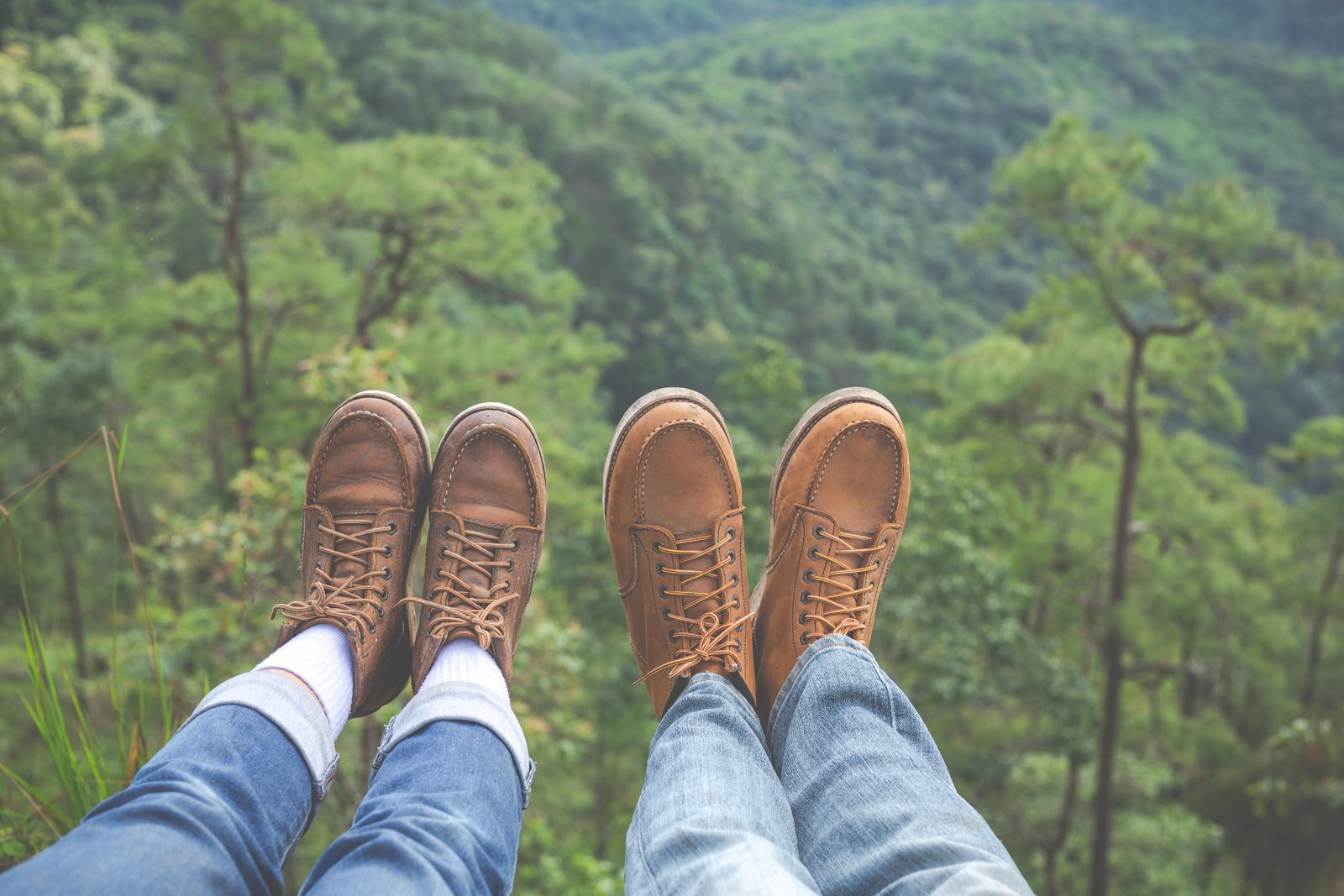
Discover the Best Himalayan Trekking Shoes

The Importance of Using Two Trekking Poles on Himalayan Treks

How to choose The Best Trekking Company in India?

Best Treks in Himachal Pradesh - Himalayan Daredevils

Top 5 Best Treks in Uttarakhand - Himalayan Daredevils
.jpg)
Promoting knowledge about well-being while trekking in the Himalayas
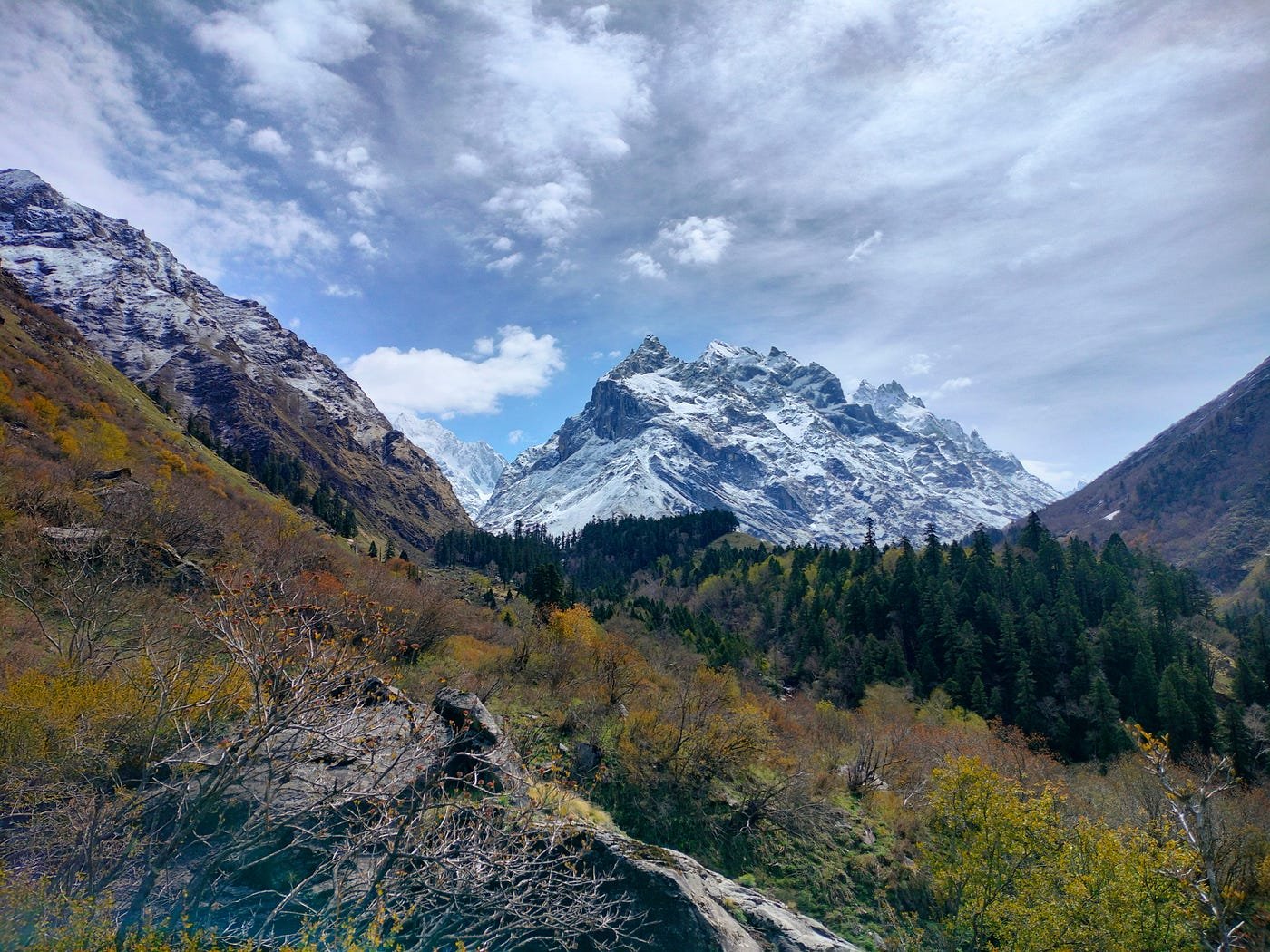
Explore the beauty of Har Ki Dun Trek - A complete Guide

Difficulties of Buran Ghati Trek | Himalayan Daredevils
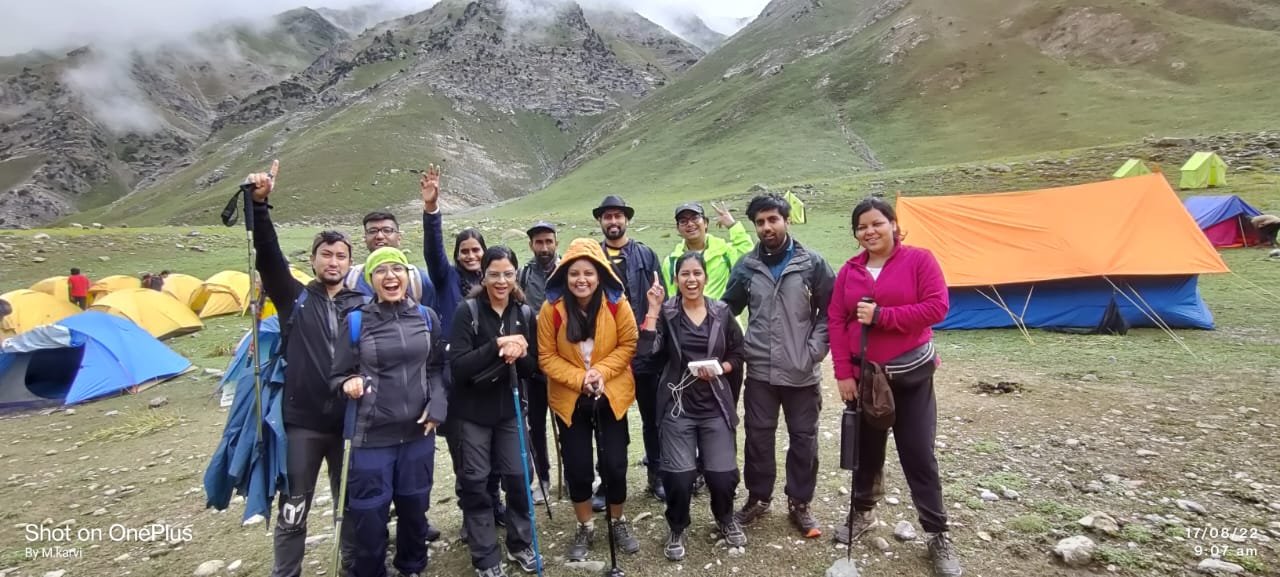
The Beauty of Sar Pass Trek - A Visual Journey Through the Himalayas

Difficulties Of Kashmir Great Lakes Trek | Himalayan Daredevils
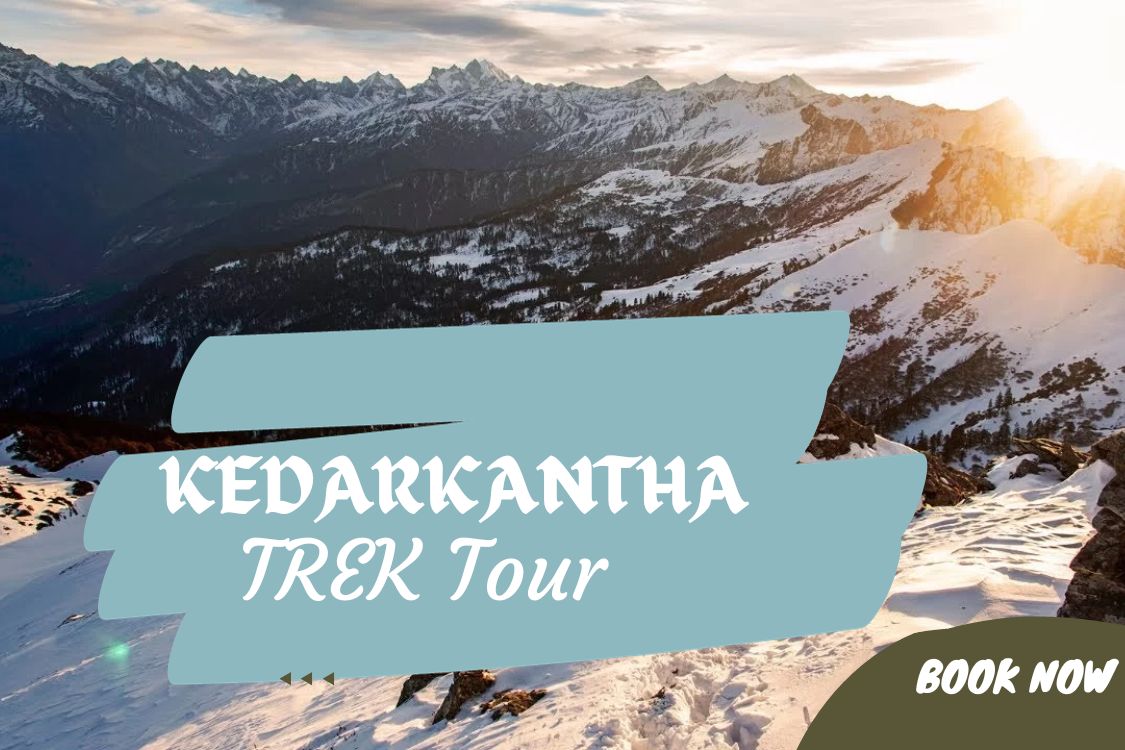
How To Plan A Kedarkantha Trek Tour Within Your Budget
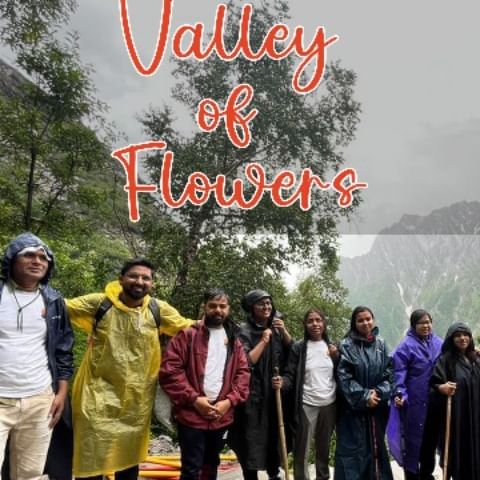
Explore the Beautiful Valley Of Flower Trek
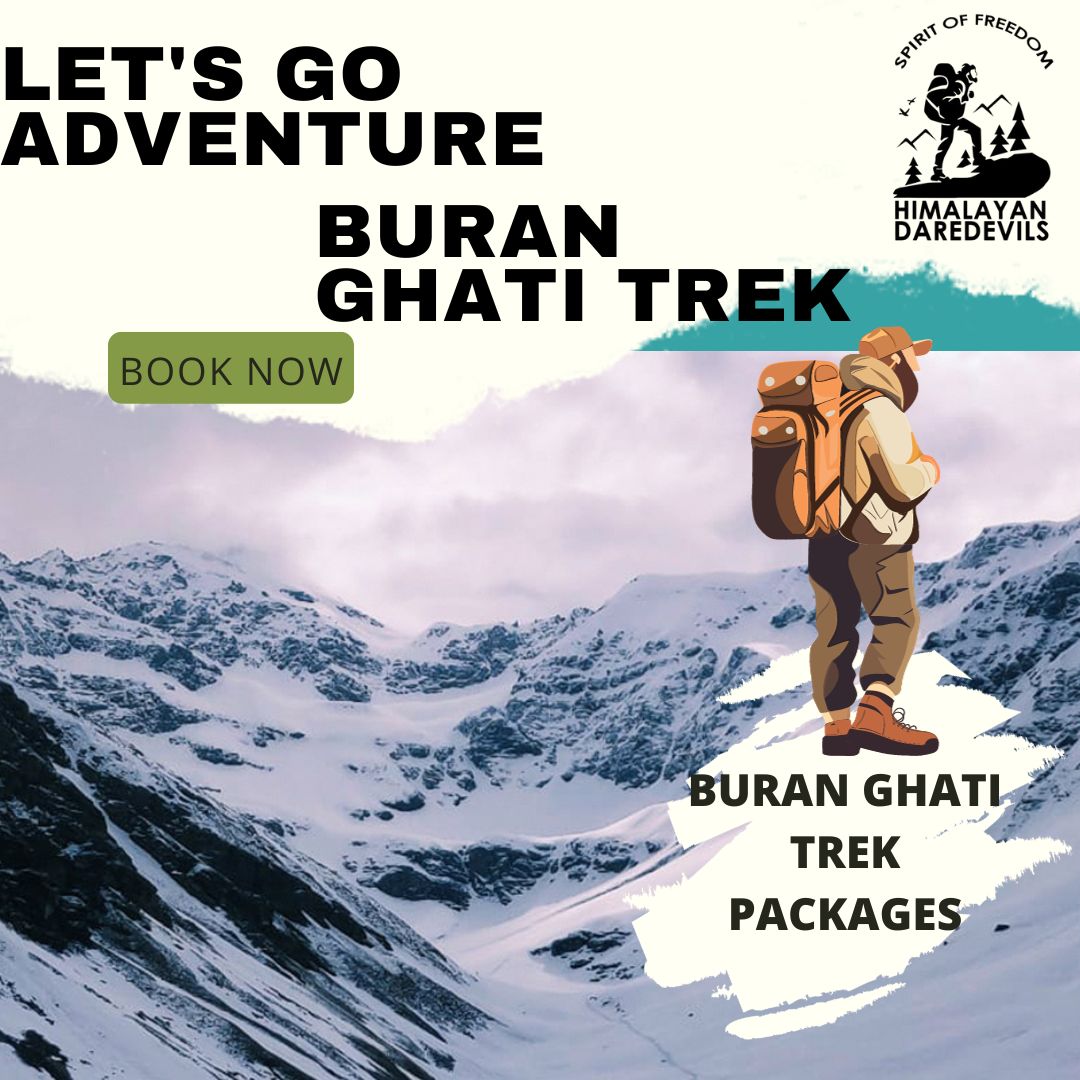
Buran Ghati Trek - A Hidden Gem - Complete Guide

Discover The Valley Of Flowers National Park & Hemkund Sahib Trek
.jpg)
How To Choose Your First Himalayan Trek
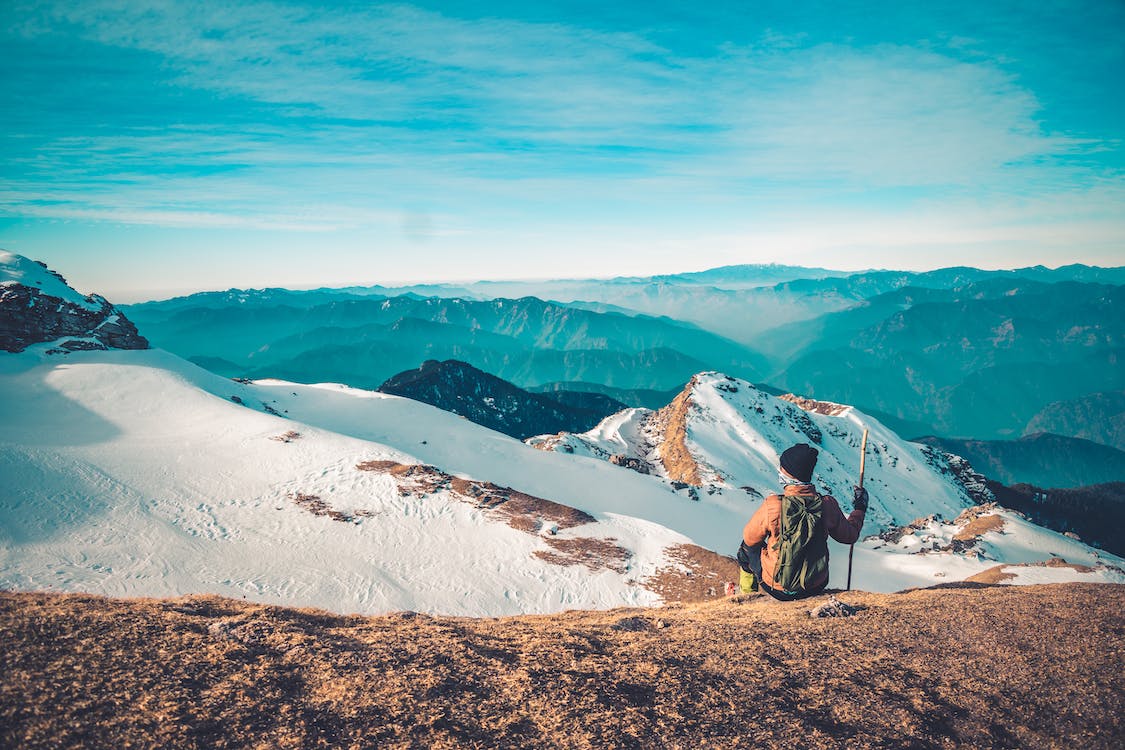
Kedarkantha Trek & Tour Package - A Complete Guide
.jpg)
10 of the Best Himalayan Treks You Must Do
.jpg)
Experience Beauty of Hampta Pass Trekking: A Complete Trek Guide
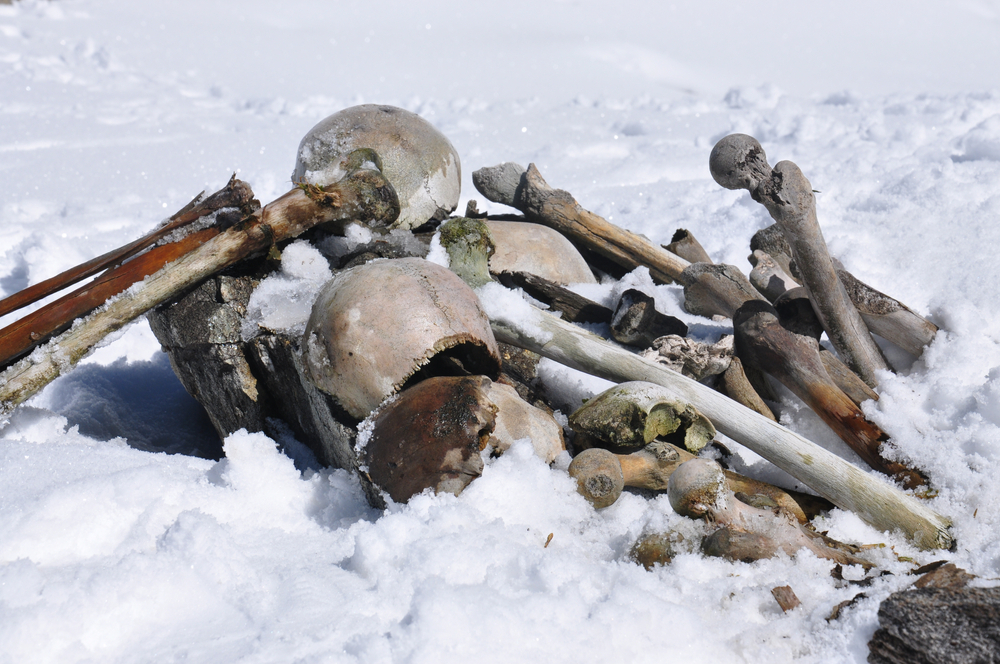
Exploring The Mysterious Skeleton Lake In Uttarakhand

Valley Of Flowers Trek Route : Complete Guide All You Need To Know About The Trek
.jpg)
Bali Pass Trek| A Complete Guide to Bali Pass Trekking Route & Cost

Comprehensive Guide About Beautiful Hampta Pass Trekking
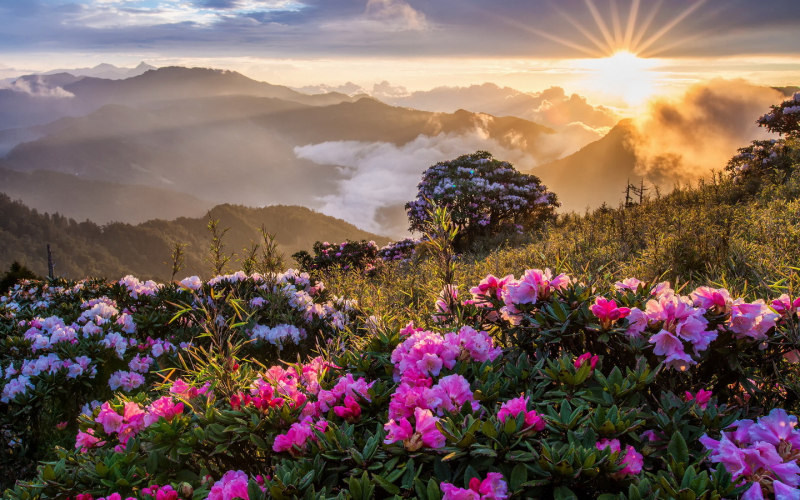
Best Time to Visit Valley of Flowers
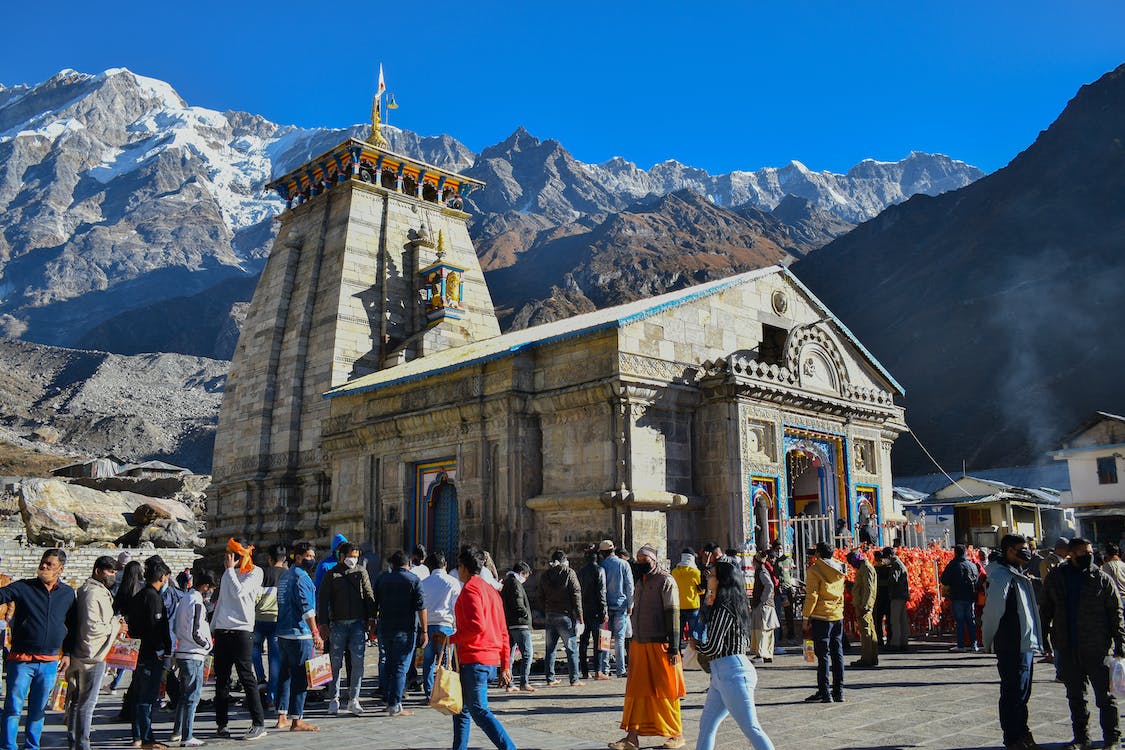
A Spiritual and Adventurous Journey in the Himalayas of Uttarakhand

Trekking In Uttarakhand: Exploring The Majestic Himalayas
+91 7895207206,
+91 6398989097
Need Live support ?
Contact On WhatsApp
Company Menu
- Privacy Policy
- Terms & Conditions
Treks By Difficulty
- Moderate
- Difficult
Affiliated and Recognised by

© 2024 Himalayan daredevils All rights reserved.

.png?w=auto&h=400)
Kedarkantha Trek
Kedarkantha trek overview.
Explore the Himalayas on the beautiful Kedarkantha trek. Kedarkantha is a 6-days trek in the Govind Pashuvihar National Park which is popular for a lot of reasons. The first reason being the rewarding experience of the summit climb. The summit looms large right from the base camp and as you start your journey towards the peak a whole new world reveals itself to you.
Kedarkantha is not particularly an easy climb, it is steep and the closer you get to the summit, the trickier the paths become. But once you complete it, the overwhelming sense of accomplishment is going to take over your senses. A trek to Kedarkantha is also going to leave you mesmerized with its dense lush forest. Kedarkantha trek being inside a wildlife sanctuary, the aspect of nature will render you speechless with its raw Western Himalayan beauty.
Book Kedarkantha Trek Package
Kedarkantha trek, uttarakhand, quick facts of kedarkantha trek.

Kedarkantha Trek Height: 12,500 ft
Start/ End Point of the Trek: Sankri village
Service From: Dehradun
Duration: 6D/5N
Kedarkantha Trek Distance: 20 km
Kedarkantha Difficulty Level: Easy To Moderate
Kedarkantha Trek Temperature: Day (8°C to 15°C) and Night: (-5°C to 3°C)
Best Time to do Kedarkantha Trek: November to April
Railway Station: Dehradun is the nearest railway station
Airport: Jolly Grant Airport, Dehradun
Short Itinerary for Kedarkantha Summit Trek
Day 1 - Dehradun to Sankri
Day 2 - Sankri to Juda ka Talab
Day 3 - Juda ka Talab to Base Camp
Day 4 - Base Camp to Kedarkantha Summit
Day 5 - Base Camp to Sankri
Day 6 - Sankri to Dehradun
Kedarkantha Trek Detailed Itinerary

Dehradun to Sankri
Distance: 187km
Duration: 8-9 hours
Altitude: 1950m
- Start your journey towards Sankri village from Dehradun, which would take you about 9-10 hours.
- Drive along Yamuna and Tons river, with pine forests surrounding your way and enjoy the beauty of nature at its best.
- After the breezy ride reach Sankri and check-in to your campsite.
- Overnight stay at Sankri.

Sankri to Juda ka Talaab
Distance: 4 km
Duration: 3-4 hours
Altitude: 2786m
Start your day with a delicious breakfast and set out on the hike from Saur village.
Climb up through the picturesque trails, crossing several high-altitude suspension bridges and small villages.
As you trek, you'll reach the stunning Juda Ka Talab, a lake said to be formed by Lord Shiva's flowing hair.
Take a moment to step out of your camps and gaze at the starlit sky while you stand beside the frozen lake.
Spend the night at Juda Ka Talab, surrounded by the natural beauty.

Juda ka Talaab to Base Camp
Duration: 4-5 hours
Altitude: 3430m
Start the day with breakfast at Juda Ka Talab and embark on the journey to the Kedarkantha base camp.
Take in the breathtaking beauty of the snow-lined path and patches of green that surround you.
In case of harsh weather, take refuge in the safe and equipped Gujjar huts.
The majestic view of the snow-capped Himalayan peaks of Bandarpoonch, Swargarohini, Kala Nag and Ranglana will leave you breathless.
Reach the campsite, enjoy dinner, and retire to the tents for the night. Spend the night at the Kedarkantha base camp, surrounded by the natural wonder of the Himalayas.

Base camp to Kedarkantha summit
Distance: 6 km
Duration: 6-7 hours
Altitude: 3800m
Begin your day with a hearty breakfast and gear up for the ultimate adventure. Set out early, around 2 am, for the summit trek.
The trek will take around 7 to 8 hours to complete. As you trek, you'll be greeted by the warm, filtered sun rays from the mountains of the Yamunotri and Gangotri range, and the Kinner Kailash ranges.
When you reach the summit, be prepared for a jaw-dropping view as you watch the sun rise from the top.
After taking in the summit's beauty, begin your descent back to base camp. Once you reach the campsite, relax and refuel with a delicious dinner to end the day.

Base camp to Sankri
Altitude: 1900 m
Start your day with a satisfying breakfast at the base camp. As you begin your descent to Sankri village, listen to interesting local stories shared by your guide.
Take in the beautiful views of the snow-capped peaks of the Himalayas along the way.
Once you arrive at the quaint Sankri village, share your trekking experiences with friends over a cup of coffee.
Spend the night in the village and rest up for the journey ahead.

Sankri to Dehradun
Distance: 187 km
The last day, you are supposed to bid adieu to the mountains.
After breakfast, drive towards Dehradun.
Return home with a bag full of memories.
Know Before You Go for Kedarkantha Trek

Kedarkantha is a very popular trek among first timers who are indulging in some serious trekking. It can be a good way to kickstart your trekking journey. Here are some tips for the first time trekkers :
- You can rent trekking poles, trekking shoes, and trekking bags in Sankri but be sure to check the availability before peak season.
- Keeping your phones fully charged and carrying an extra battery for your camera is advisable as electricity in snakri is quite an issue, the place faces frequent power cuts.
- Carry a flask to store warm water which you can drink during your trek .
- This cannot be stressed enough but do not overpack as doing so you will be bringing doom upon yourself.
- Stuff your things in a planned way so that things are easily accessible to you when you need them.
- As you enter Purola (halfway to Sankri), there will be no network so make sure you inform your loved ones.
- There are no ATMs after Mori so be sure to use the ATM in Dehradun itself.
- As you begin your trek, start with small steps and gradually increase your pace
- Keep quick foods like energy bar with you which will give you an instant boost.
- Do not forget to keep your headorce as you will be trekking 3 am in the morning.

Sturdy Trekking shoes - For Kedarkantha trek, you would require sturdy, ankle gripping shoes that would be suitable to walk on snow.
Backpack - A 50-60 L backpack would suffice for Kedarkantha trek, make sure the backpack has good back support with quick access pockets.
Clothes - T shirts(wear one and pack 2), preferably long sleeves quick-dry t-shirts which have a high dollar. A t-shirt which hides your neck will prevent the neck from getting sunburnt. You can also carry thermals with you if you are susceptible to cold but keeping in mind that you have to carry them all along.
Clothing in Winters - During winters it is necessary to carry insulin jackets and a 5-layer clothing is recommended : 1 pair of thermals, 2 light fleece layers, 1 light sweater and a padded jacket. Do not carry heavy sweaters or fleece, carry which are foldable and don't take up much space. Carry 1-3 trek pants with you which are comfortable and stretchable and would not restrict your movements. Even for trek pants, go for the quick-dry ones rather than the cotton as they take the longest time to dry. Trek pants with several zips are convenient as you can keep a few essentials in your pocket.
Sunglasses - Sunglasses are mandatory in your Kedarkantha winter trek as without them you may get snow blindness from the directly reflected UV rays from the snow.
Cap - A sun cap is necessary as it prevents quick exhaustion, dehydration, headache and sunstrokes.
Hand gloves - Carry a pair of hand gloves since you will have to grip on snow on your trek if needed and they would also protect you from extreme gold. Try to get synthetic hand gloves as they would be water-proof.
Woolen cap- It is necessary that you protect your head from the extreme cold after sun down. The maximum amount of hat that our body loses is from our head so it becomes mandatory to keep our head warm.
Socks - Take at least 4 pairs of socks, out of which 3 must be sports socks and one woolen. Again it is recommended that you do not take cotton socks as they take a lot of time to dry.
Trekking Poles - you would require at least one pair of trekking poles as they enhance your stability and balance to a great extent and at the same time it reduces your energy consumption.
Rainwear - The weather in the mountains are unpredictable and can change anytime.From a bright sunny day, it might turn cloudy and start raining. So to protect yourself from such a situation, carry a very lightweight poncho or rainwear.
Raincover for your backpack - All your warm clothes will be inside your backpack so you cannot afford to get it wet. Get a raincover for your backpack or a large plastic bag to protect your clothes from getting wet.
Daypack - If you are unloading your main luggage on a mule then you must carry a daypack where you will keep your essentials.
Toiletries - Carry your toothbrush, paste, a small soap, toilet tissue roll deodorant, lip balm,moisturizer in a separate toiletry kit. Since you won’t be able to bathe in your trek, packing your bag with soaps and shampoos is pointless. For women : If you are menstruating on your trek then you can carry your sanitary napkins, tampons and menstrual cup on the trek. Carry ziplock bags to carry your menstrual waste.
Plastic covers- It is a very smart idea to carry 2-3 plastic bags to keep your dirty or wet clothes. That way you would also be reusing the plastics in a better way as well.
Medicine kit - Diamox, Dolo 650, Avomine, Combiflam, Digene, ORS, Knee brace(optional). Take these medicines only after consulting your trek leader.

By Air : Jolly Grant airport is the nearest airport in Dehradun, which is located 25 kms away from the city. Regular flights are available from Delhi to Dehradun.
By Train : There are many trains available which run till Dehradun from different parts of India. However, if you are traveling from Delhi then there are two Express trains, with an overnight journey : Nanda Devi Express and Dehradun Express.
By Bus : If you are going for Kedarkantha trek from Delhi, then Buses ply regularly from Delhi to Dehradun bus stand. Catch a bus from Kashmere gate ISBT, which is the main bus station of Delhi. Here you will find both AC and non-AC buses till Dehradun. It is recommended that you take the government bus, as it will drop you at Dehradun ISBT.

The best time to go on a Kedarkantha trek is winter, as the season offers dreamy views and amazing weather. Every season has something different to offer, however, Kedarkantha winter holds a unique place in terms of adrenaline and adventure.
- Kedarkantha trek in winters ( December, January, February )
Average temperature during day - 8 degree to 10 degree celsius Average temperature during night - 0 degree -5 degree celsius
Kedarkantha has gained popularity as the most sought after winter trek and that is for all the right reasons. If you are a beginner in the world of trekking and you want to venture out for something serious then Kedarkantha winter trek will give you the right adrenaline rush and sense of adventure.
Trek through the dense forest and learn how to camp on a thick heap of snow. The ultimate adventure awaits as you start ascending the summit of Kedarkantha, the path will be covered with thick layers of snow. As you reach the summit, you will be overwhelmed with a sense of fulfillment, the feeling of which will be etched in your memory for an eternity.
- Kedarkantha Trek in Spring (March and April)
Average temperature during day- 15 degree to 18 degree celsiusAverage temperature during night - 0 degree to 5 degree celsius
In this time, you would still find snow in irregular patches, as reminiscent of the bygone winter season. If you want a pleasant experience with a touch of colors from nature, then spring should be the ideal time for you. Find beautiful newly bloomed Rhododendrons and fresh patches of grass set against the white washed backdrop as you ascend higher.
By the month of April, the snow completely melts away and bursting colors take over the scenery. The place wakes up from its hibernation with fresh energy. A trek to Kedarkantha becomes a must in Spring for its calming nature and it becomes an ideal time for camping.
- Kedarkantha in Summer (May and June)
Average temperature in day - 18 degree celsius to 24 degree celsiusAverage temperature in night - 3 degrees celsius to 8 degree celsius
Kedarkantha trekking during summers sees the dominance of sun during the day, however the evenings remain chilly. During this time you will find no snow, and in June, you might find light rainfall. Proper monsoon sets in the month of July.
If you are looking for an experience devoid of much crowd then this time should be ideal for you since during this time people go for higher altitude treks and Kedarkantha sees leser footfall.
- Kedarkantha Trek in Autumn ( September, October, November)
Average temperature in day - 10 degree to 15 degree celsiusAverage temperature in night- 0 degree to -5 degree celsius
After the monsoon season, the Kedarkantha trek comes to life from the month of September. In this time you get an unparalleled view of the mighty Himalayas as the forests and meadows are at their best. Till October the trekking experience will be pleasant in terms of weather and landscape, however, from November the winter sets in.

For Kedarkantha trek, you would require documents for legal purposes and to present them to the forest department. So, carrying proper documents is of utmost importance, without them you won’t be able to do the trek. The documents that you need to carry with you are as follows :
- Original and photocopy of government photo identity card - Aadhar card/ Driver’s License/ Passport. This is required by the Forest Department for your identification.
- Medical Certificate - You must get a medical clearance by a practicing doctor, without a medical certificate, the forest department would not allow you to trek.
Unsaid Things About Kedarkantha Trek

Trek inside a wildlife sanctuary : Kedarkantha is located in the Govind Pashuvihar Sanctuary and National Park, the area is filled with rich flora and fauna with biodiversity of Western Himalayas. In your trek to Kedarkanth you will be witnessing all three kinds of flora of Western Himalayas : Broadleaf forests, Subalpine conifer and Subalpine shrubs and bushes.
Religious and Cultural significance of Kedarkantha : According to mythology, it is believed that Lord Shiva stayed here for a few days when he was hiding from a demon. All the three significant villages, Sankri, Kotgaon and Gaichwan have a temple dedicated to Lord Shiva. In terms of culture we will see a heavy influence of the Kinnaur, the people over here dress and talk in a similar fashion like the Kinnauris.
You May Also Book
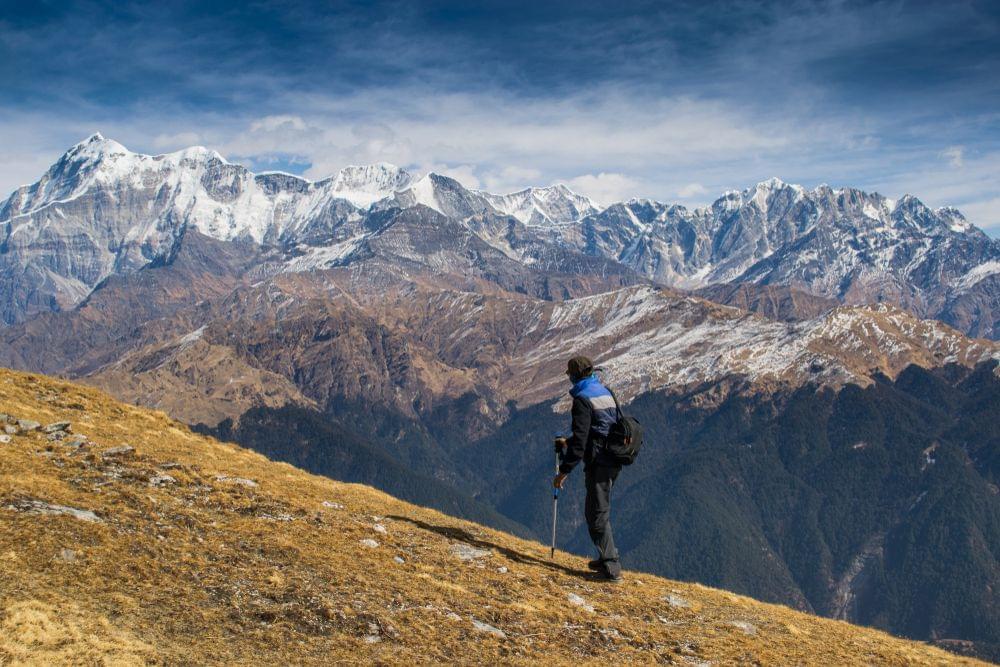
FAQ's of Kedarkantha Trek
How long is the kedarkantha trek.
Kedarkantha trek is a 18 km long trek which takes 4 days from Sankri to complete the trek. On the first day you will cover 5 km which will take you around 4 hours approximately, on the second day you will cover 4 km over a span of 4 hours. On the third day you will trek from Juda ka talab to Base camp which is 4 kms.On the 4th day you will cover around 6 km which will take you 6-7 hours.
What is the height of Kedarkantha trek?
The height or altitude of Kedarkantha is 12500 ft, while Sankri is at an altitude of 6455 ft.
Do I get network access on the Kedarkantha trek?
Getting a network on your Kedarkantha trek is difficult, however, you might get network on the summit and some few places on your route.
Is there an ATM on the Kedarkantha Trek?
The last ATM that you will find en route to your base camp is in Mori. At Mori you will find an SBI bank which has an ATM attached to it. But please keep in mind that the machine, most of the time, is devoid of any cash. In such a case you have to go to an SBI authorized cash withdrawal center where you will swipe your card and the person present at the servicing desh will give you acash. It is recommended that you avoid this hassle and carry vash with yourself from the very beginning. Purola is a good option as it has 3 functioning ATM’s.
Is there a cloakroom facility at Kedarkantha trek?
There is a cloakroom facility at the basecamp of Kedarkantha, where you can leave your things and as the trek ends, your belongings will be brought back to you. Please keep in mind that you should not leave any valuable things in the cloakroom.
Is offloading available at Kedarkantha?
Yes, offloading is available on Kedarkantha trekking. Your bags will be kept on the back of the mule while you walk the trail hassle-free.
Is there any risk of wild animals on the Kedarkantha trek?
There is no as such risk of wild animals in Kedarkantha trek, however, it is suggested that you remain vigilant because after all Kedarkantha is inside Govind Wildlife Sanctuary. It is recommended that you do not get estranged from your group for a long period of time.
Which month is best for Kedarkantha Trek?
The best time to trek Kedarkantha is from December to April. The trek is open during this period and the weather is ideal for trekking. During this time the temperature is low, snow is present on the trek, and the trekking trail is clear. December to January is the best time to experience snow on the trek and April is the best time for wildflowers blooming. It's recommended to avoid the monsoon months of June to September as the trekking trail becomes slippery and is prone to landslides.
Which trek is better: Brahmatal or Kedarkantha Trek?
Both the Kedarkantha trek and the Brahmatal trek are beautiful and offer unique experiences. It ultimately depends on what you're looking for in a trek. If you are looking for a moderate level trek with beautiful views, Kedarkantha trek is perfect for you. If you are looking for a bit of adventure and to be immersed in nature, Brahmatal trek is perfect for you.
Treks in Himachal
Treks in uttarakhand, treks in ladakh, treks in nepal, treks in north-east, treks in kashmir.
.png?w=auto&h=400)
The content and images used on this site are copyright protected and copyrights vests with the respective owners.
© 2024 www.heyhimalayas.com All rights reserved.

Kedarkantha Trek
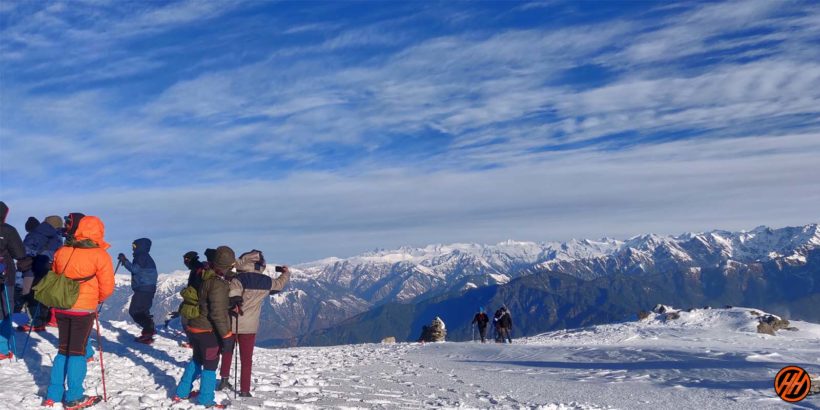
Description
Reviews (68), things to take, available dates, include / exclude, kedarkantha trek – a summit peak at an altitude of 3800 m in uttarakhand himalayas – 2024.
The Kedarkantha winter trek is indeed special, and several aspects contribute to its uniqueness:
Snow-Covered Landscapes: One of the main attractions of the Kedarkantha trek during winter is the snow-covered landscapes. The entire region gets transformed into a winter wonderland, with trees, meadows, and mountains covered in pristine white snow.
Breathtaking Views: The trek offers breathtaking panoramic views of the Himalayan peaks. On a clear day, you can see prominent peaks like Swargarohini, Bandarpoonch, Black Peak, and others, creating a stunning backdrop for your trekking adventure. Winter Camping: Camping in the snow is a unique experience.
If you want to do Kedarkantha Trek with a local trekking organisation then welcome with Himalayan Hikers Team . We treat our trekkers like a family and we have the Most luxurious and expensive hotel and homestay in Sankri like The Grand Shiva Home Stay or Hotel Swargarohini Palace for your luxurious stay and camping stay including with the trek. The Trek route is Sankri, Juda ka Talab, Kedarkantha Base Camp, and Hargaon Camp, and we also provide delicious food every day 4 to 5 times to our trekkers. We have an experienced local Guide, Cooking Team, Helpers, and Transport Pickup and Drop from Dehradun Railway Station.
The special and correct route of the Kedarkantha trek is from Sankri only, from where we have been doing it for about 32 years.
We Provide healthy, and tasty food, served hot all the time, Breakfast, Lunch, evening snacks, soup, and Dinner, along with morning and evening hot water provided to trekkers, which is essential in winter trek to Kedarkantha. Also, medical kits and oxygen cylinders, technical equipment are kept, MICRO spikes for Hiking in snow are provided free of cost during the trek
Route of Kedarkantha Trek
Dehradun to Sankri Base Camp Main Market, Then – Sankri to Juda Ka Talab, Kedarkantha Base camp, Kedarkantha Peak Summit-12500 ft- then Hargaon, Sankri Back to Dehradun
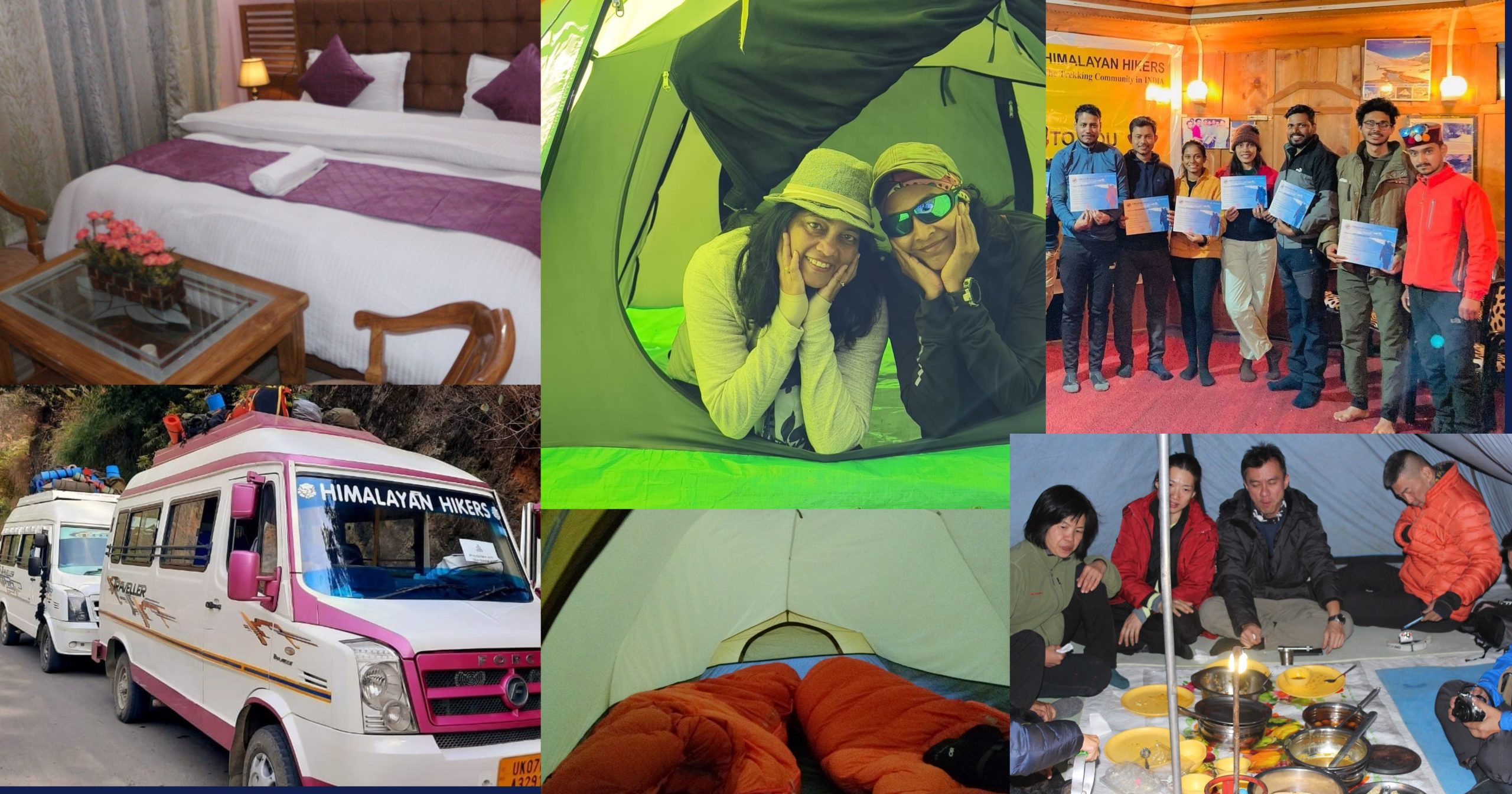
Kedarkantha Trek is a beautiful Winter Trek in Uttarakhand, Himalayas -India
Here are some highlights of kedarkantha trek:.
Snow-covered landscapes: Kedarkantha Trek is famous for its snow-covered landscapes, which offer a breathtaking view of the Himalayan peaks.
Summit climb: The trek involves a summit climb to the Kedarkantha peak, which stands at an elevation of 12,500 feet.
Stunning views: From the summit, you can enjoy stunning views of the surrounding peaks, including Swargarohini, Bandarpoonch, and Kalanag.
Campsites: The trek offers some of the most beautiful camping sites, where you can spend the night under the starry sky.
Local culture: The trek takes you through traditional villages of the Uttarakhand region, where you can get a glimpse of the local culture and way of life.
Difficulty level: The trek is considered a moderate Trek, making it ideal for both beginners and experienced trekkers.
Accessibility: Kedarkantha trek is easily accessible from major cities like Delhi, making it a popular weekend getaway.
Juda ka Talab is a scenic high-altitude lake located in the Govind Wildlife Sanctuary in Uttarakhand, India. Here are some of the highlights of this beautiful destination
Natural Beauty: The lake is surrounded by the majestic Himalayas, with stunning views of snow-capped peaks and lush green forests.
Camping: There are several campsites around the lake where you can spend the night under the stars and enjoy the peaceful ambiance of the surrounding wilderness.
Bird Watching: Juda ka Talab is home to a variety of rare bird species, including Himalayan monals, snow pigeons, and koklass pheasants, making it a paradise for bird watchers.
Flora and Fauna: The lake is surrounded by dense forests of rhododendron, oak, and deodar, which are home to a variety of wildlife species like musk deer, bharal, and leopards.
Religious Significance: The lake is considered sacred by the locals, who believe that it is connected to the Mahabharata epic.
Overall, the Kedarkantha trek is a perfect blend of adventure, natural beauty, and cultural exploration.
We have Trekking Equipment available on Rent, which you can pick up from our Himalayan Hikers Shop at Sankri Base Camp of Kedarkantha
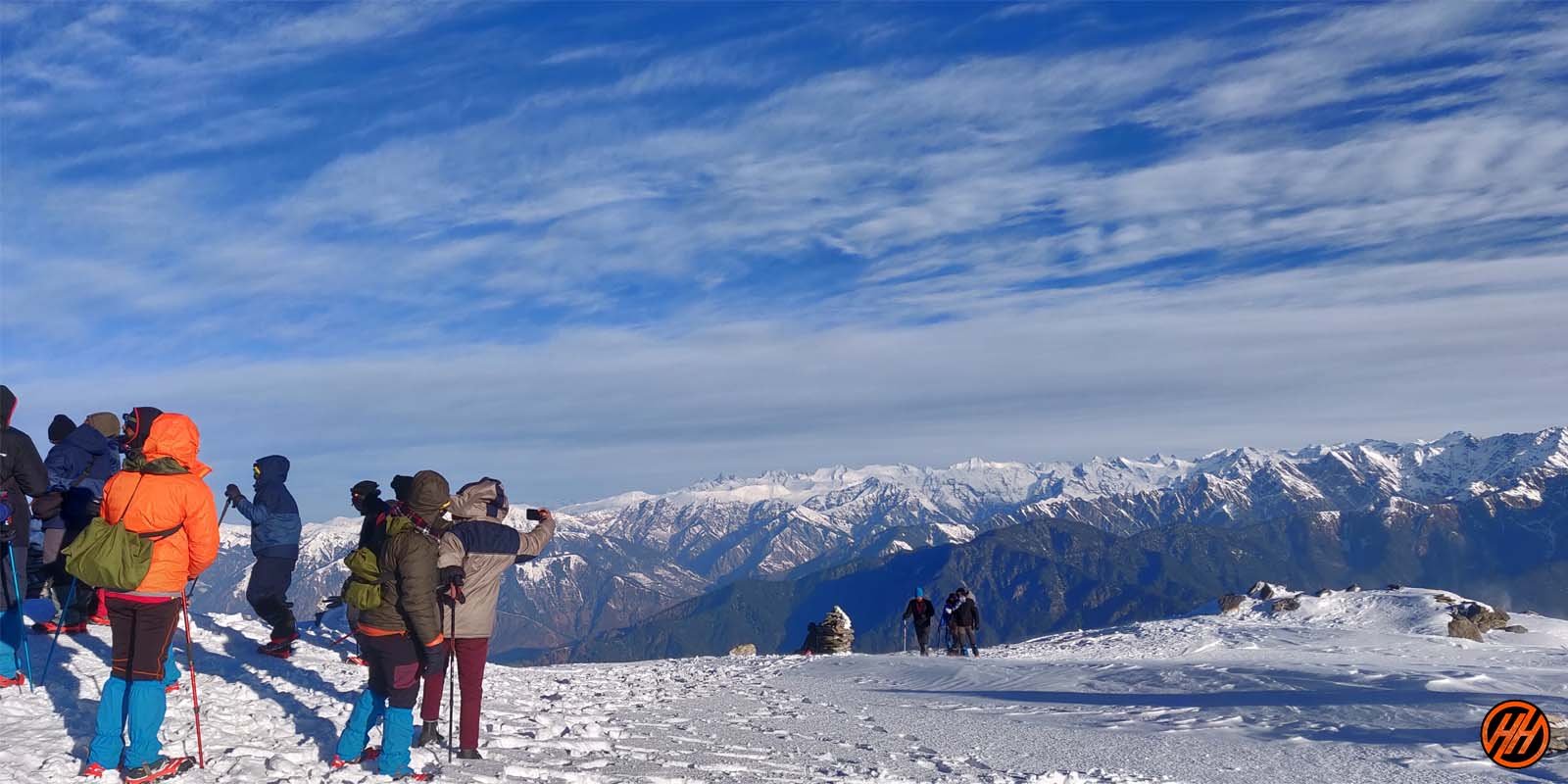
Short Itinerary of Kedarkantha Trek
DAY 01- Pickup Dehradun Railway Station Morning 07:00 Am | Drive to Sankri Base Camp Hotel , Via Mussoorie, Kamptifall, Damta, Purola, Mori Sankri,
Drive Distance: 190 km | Duration: 08-09 hours | Overnight Stay Hotel at Sankri – Twin Sharing or Three Sharing
DAY 2 – Trek from Sankri to Juda Ka Talab Camp 01 | Trek Distance: 05 km | Trek Time : 4/5 hours | Altitude 8,858 ft | Overnight Stay Camp – Twin Sharing or Three Sharing
DAY 3 – Trek from Juda Ka Talab to Kedarkantha Base Camp 02 | Trek Distance: 03 km | Trek Time : 2/3 hours | Altitude 10,498 ft | Overnight Stay Camp – Twin Sharing or Three Sharing
DAY 4 – Early Morning 3:30 am Trek from Kedarkantha Base Camp to Kedarkantha Peak Summit – 12500 ft |After Summit – Back to Kedarkantha Base then after Lunch Trek down Hargaon Camp 3- Trek Distance: 11 km | Trek Time : 7/8 hours | Altitude 8,498 ft | Overnight Stay Camp – Twin Sharing or Three Sharing
DAY 5 – Trek from Hargaon Camp to Sankri Hotel | Trek Distance: 05 km | Trek Time: 4/5 hours | Altitude 6,398 ft | Overnight Stay Hotel – Twin Sharing or Three Sharing
DAY 6 – Drive Back from Sankri Market to Dehradun City Drive Distance: 190 km | Drive Duration:08-09hours | Drop point for Himalayan Hikers trekkers: Dehradun Railway Station
Key Point- Kedarkantha Trek The most popular Winter Trek
Duration: 05 Nights 06 Days from Dehradun to Dehradun
Kedarkantha Trek Cost: Rs. 7,500.00 Per Person including all costs of the trek from 05 nights to 06 Days from Dehradun to Dehradun
Summer Temperature :- Day 5°C to 15°C and Night 2° C to 5° C
Winter Temperature:- Day -2°C to -5° C and Night -5°C to -10°C
Kedarkantha Summit -Altitude: – 12,500 feet
Kedarkantha Weather Conditions – Kedarkantha is one such trek that can be done throughout the year, Here the weather changes every month, But where the weather is very nice and favorable during the day, the night or morning is also cold according to the time.
Trek Level: Moderate
Trek distance: On foot 23 Km – By taxi 420 km
Group Size: – We will have a maximum Group size of 35 people in each group, if someone has to be private for their group, then you will be given a full date.
Kedarkantha is considered one of the most popular winter trek and hiking locations in Uttarakhand, India Altitude is 12500 feet, It is the best trek to fulfill your satisfaction with trekking. Kedarkantha trek is quite special because it has stunning views and it provides the best views of the entire mountains cape. Today Kedarkantha is the topmost trek of Uttarakhand Himalayas. Kedarkantha is an incredible place to stay there and enjoy the sunrise and sunset. The Trek is a classic winter trek that provides a great opportunity for trekkers to explore something new about nature, and experience the life of remote villages of Garhwal Himalayas.
The best time to see snow on Kedarkantha Trek
Every year the snowfall in Kedarkantha starts in the middle of November month. And it starts any time in the month of December too, so a good time to see you here is Snowy December,
Kedarkantha experiences maximum snowfall in January and February, in these two months there is maximum snowfall and there is a white blanket of snow on the entire trek.
You will get to see snow in Kedarkantha from December to March end, which makes this trek a special winter trek.
The most special is the frozen lake, Local name is Juda ka Talab which is in our first camp side it completely freezes in winter.
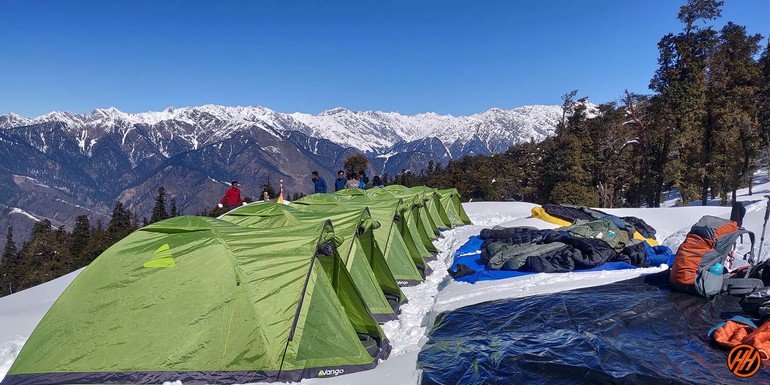
Kedarkantha Mountains Range is Highly Photogenic.
Kedarkantha Trek lies in the Uttarkashi district of Uttarakhand. It starts from the traditional village of Sour – Sankri which is in the Govind Wildlife Sanctuary National Park. Sour village is quite beautiful with snow-covered mountains and the sparkling tons river flowing through it. If you visit it once, then no doubt you will definitely visit here again. The charm is the most beautiful thing about this place. the Sankri is a delightful place set apart by the mountains and chilly climate and weather. Houses made of wood look very beautiful and adorable. In Sour Village, there are various conventions, fairs, and rituals. the people of the village wear traditional costumes and cook traditional food. Folk dances( Naati, raas, and taandi) of the area are a part of amusement and entertainment.
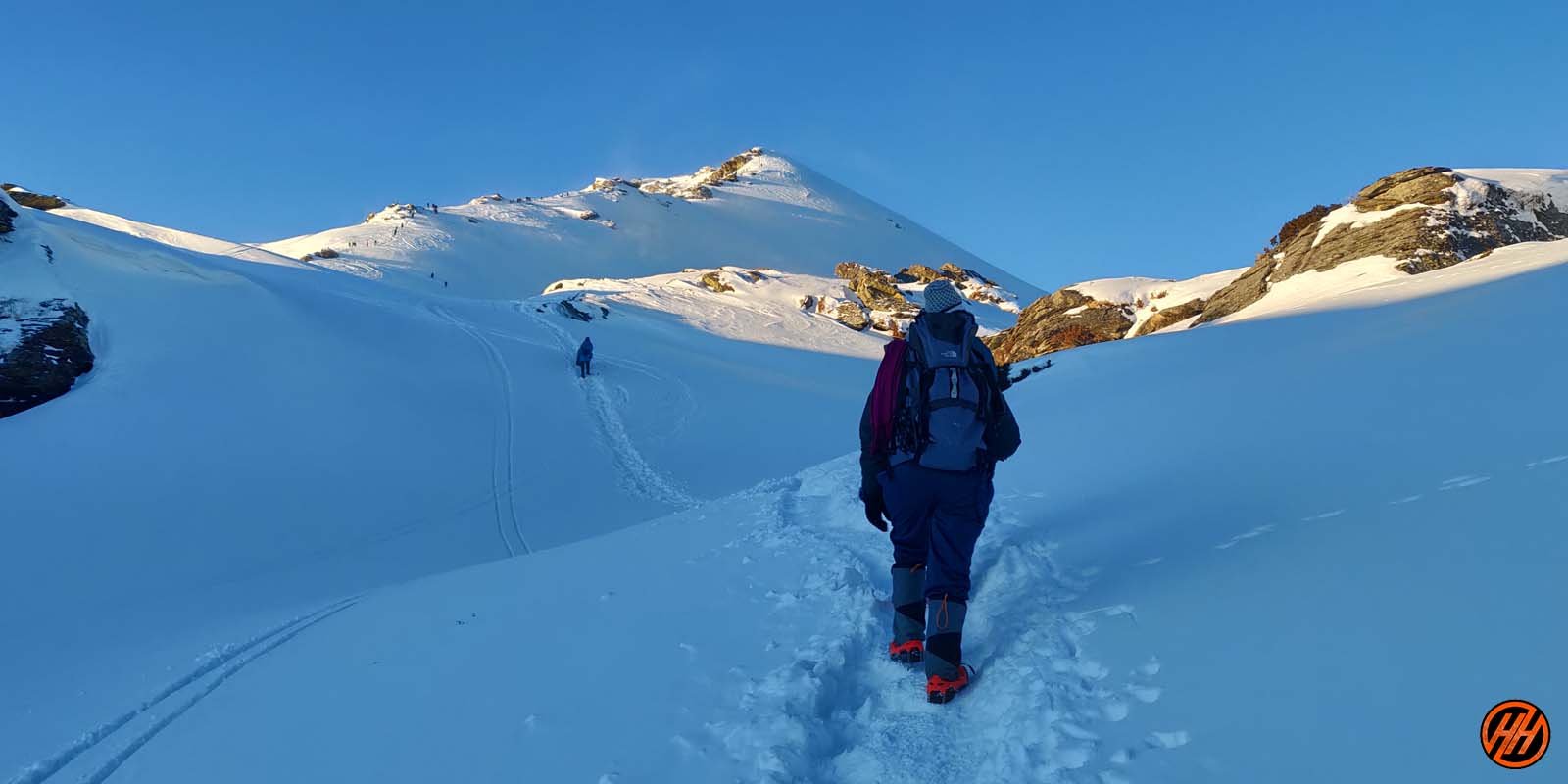
The view from the Kedarkantha Summit
The quite unique thing about the Kedarkantha trek is that from here the most beautiful mountain range of the Himalayas is seen. Which are Swargarohini Peak -I. II.III (6300 meters) , Black Peak (6387 meters), Bandarpunch Peak (6300 meters) , and all the mountains are seen from here like Rupin Pass range, Supin range, Khimloga Peak , Baraadsar Lake range, Vishkhopri range, Ranglana Peak 5800 meters, etc.
From here, the view of all the treks is easily visible from Har Ki Dun Valley and Ruinsara Valley Bali Pass, Borasu Pass, Sarutal, Fachu Kandi Pass Trek . You can view all the treks from a single trek.
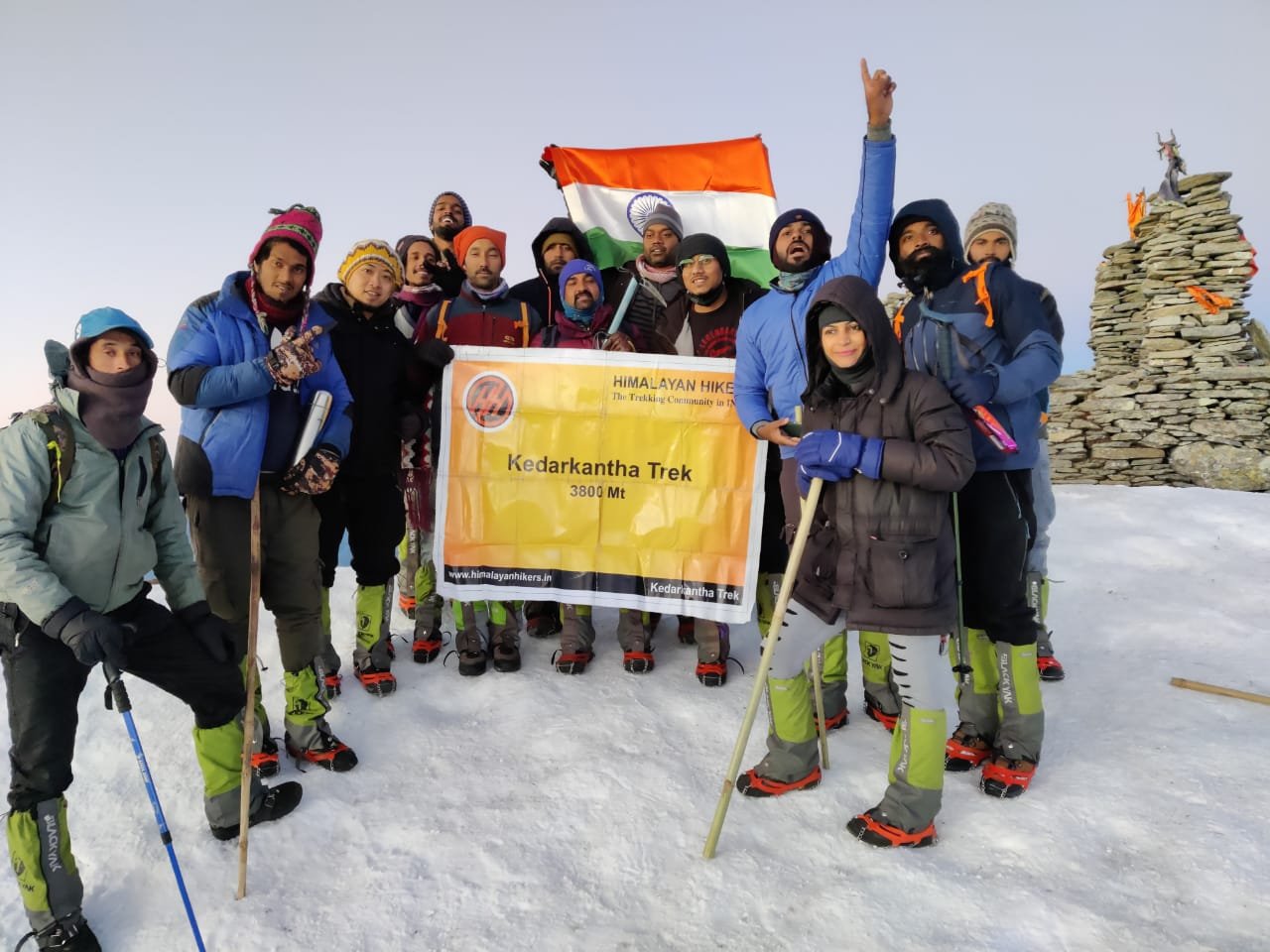
Best Time to Visit Kedarkantha Trek
Kedarkantha is one such trek that you can do throughout the year, it is more popular, especially for winter trek. I believe that these treks are for all those people who consider their second home in the mountains! If you want to spend your time in the mountains then it is an opportunity for you.
from the Kedarkantha trek you will absolutely get some experiences about life and how local people spend their life in backward areas. you will also get peace and satisfaction which everyone wants.
In the early days of my travel every time I went for a hiking or trekking trip. I have done this trek more than 100 times; no one else knows more about this trek than I know! These treks start from near my village, today it seems like when people take this trek and there is joy on everyone’s face. These treks are not very easy and not very difficult.
Age Limit for Kedarkantha Trek
Our personal belief is that people can do this trek for a minimum of 5 years to 60 years but it is necessary to be fit to do this trek. And you can do this trek in the year. These are the plans for both summer and winter.
For Winter Trek, I think it is necessary for people from 10 years to 55 years and this trek will be a relief and joy for first-time visitors. This trek will increase new energy and confidence in you.
You can do the Kedarkantha trek in 05 nights and 06 days. from Dehradun to Dehradun and if anyone has less time, then people can do this trek in 04 nights 05 days, from Dehradun to Dehradun
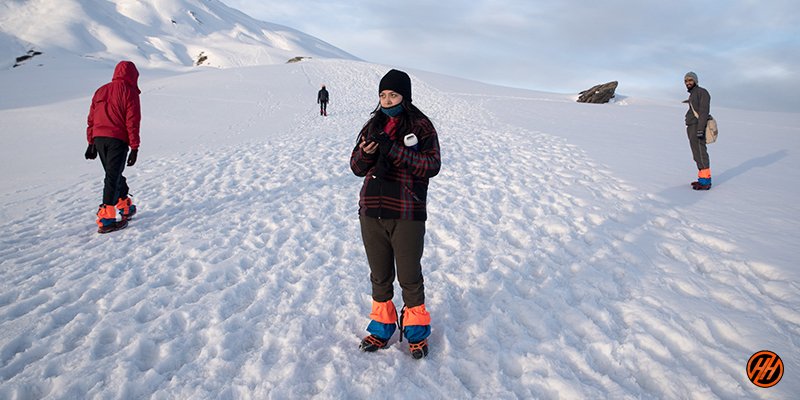
Why Kedarkantha is the Most Popular Winter Trek in Uttarakhand, India?
It is true that Kedarkantha is considered to be the most popular winter trek in Uttarakhand and the world today. Therefore, the Kedarkantha trek is the prominent and most popular winter trek in Uttarakhand. It has got unmatched beauty in winter and the trail hides in a thick blanket of snow almost winter. Kedarkantha trek will offer a large number of stunning views like green stretches of land,fresh flowing water, and thick forests. The snow-clad mountain tops along with the thick forests make the trip worthwhile.
The lush green forests usually turn white, making it a small Switzerland. As a result, The Kedarkantha trek is not only for experienced trekkers but this trek is also for amateurs and children too. Trekking through the forests you can see adorable sights of traditionally dressed villagers collecting fodder for their cattle. It’s a beautiful area to spot various trees like pine,oak, and rhododendron.
The Winter view is a bit different here. There should be snow all around, snow-capped mountains and beautiful river rivulets and birds. Once someone has reached the Sankri market base camp, they have come to another world of mind, Sankri is a small and beautiful market which is famous for shopping among tourists. There are plenty of hotels and homestays that you can spend the night in and then continue with your trek. When you see the sunrise and sunset view here, you will see yourself so close to the sky.
Kedarkantha Winter is different fun playing snowman sliding and throwing snow at each other’s equipment and making snowfall is even more enjoyable. Taking beautiful photos in the snow is a memorable moment and a winter trek can be the best trek in your life. The best thing is that when snow falls, it is a different sight; most people come to see it.
The Moon from the Sankri base camp seems so close that touching it feels possible. And, the sunrise from Sankri is gorgeous because the golden rays of the sun eagerly welcome and wake you up. The day ends, and we don’t even realize – someone said it right that we Kuldeep Ji, you are lucky that you live here. The trekkers told me if the office, airport, everything was here, they would never leave the mountains.
My only answer was – if every facility were here, then the mesmerizing beauty of the mountains would have lost somewhere. The untouched beauty is the thing that provides peace and a spark to know about the hills. We are fortunate and happy to be “Pahadis.”
About the camp of Kedarkantha
The meaning of pond is like a bunch of hair. These are seen in summer when there is no snow here. In Winter, I do not see it because the snow is covered with pure The Juda ka Talab is an incredible camp, where there are dense forests and the beautiful Bugyal in the center, so this is considered a camp. Kedarkantha Base Camp is a beautiful Bugyal. From where you can see the starting Kedarkantha Peak, Kedarkantha Base Camp is in open ground. Kedarkantha Base Camp is a big campsite in this trek, From here you start to see views of the entire Himalayas. It is very nice to spend the night here.
Is it a safe trek for me?
Yes the Kedarkantha trek is very safe. All our professionals strive our best to provide trekkers with the best experience possible.
Kedarkantha Trek is our village’s local trek, which we have been doing for years, here the trek was first done by Himalayan Hikers in 2003 to the children of Woodstock School, Mussoorie since then it has become very popular here. for the winter season,
Difficulty level ?
Kedarkantha is a very beautiful winter trek and an uphill trek in the Uttarakhand Himalayas, this is a moderate trek, The Kedarkantha Trek is great for those people who have a great passion for mountaineering and consider it a special purpose in their life.
Despite the fact that the top is relatively low in elevation, we recommend physical endurance and a strong fitness record. All groups will be Guided by our pros for trekking equipment and impending terrain during the course. We strongly urge beginner trekkers to attempt the Kedarkantha summit due to its modest difficulty.
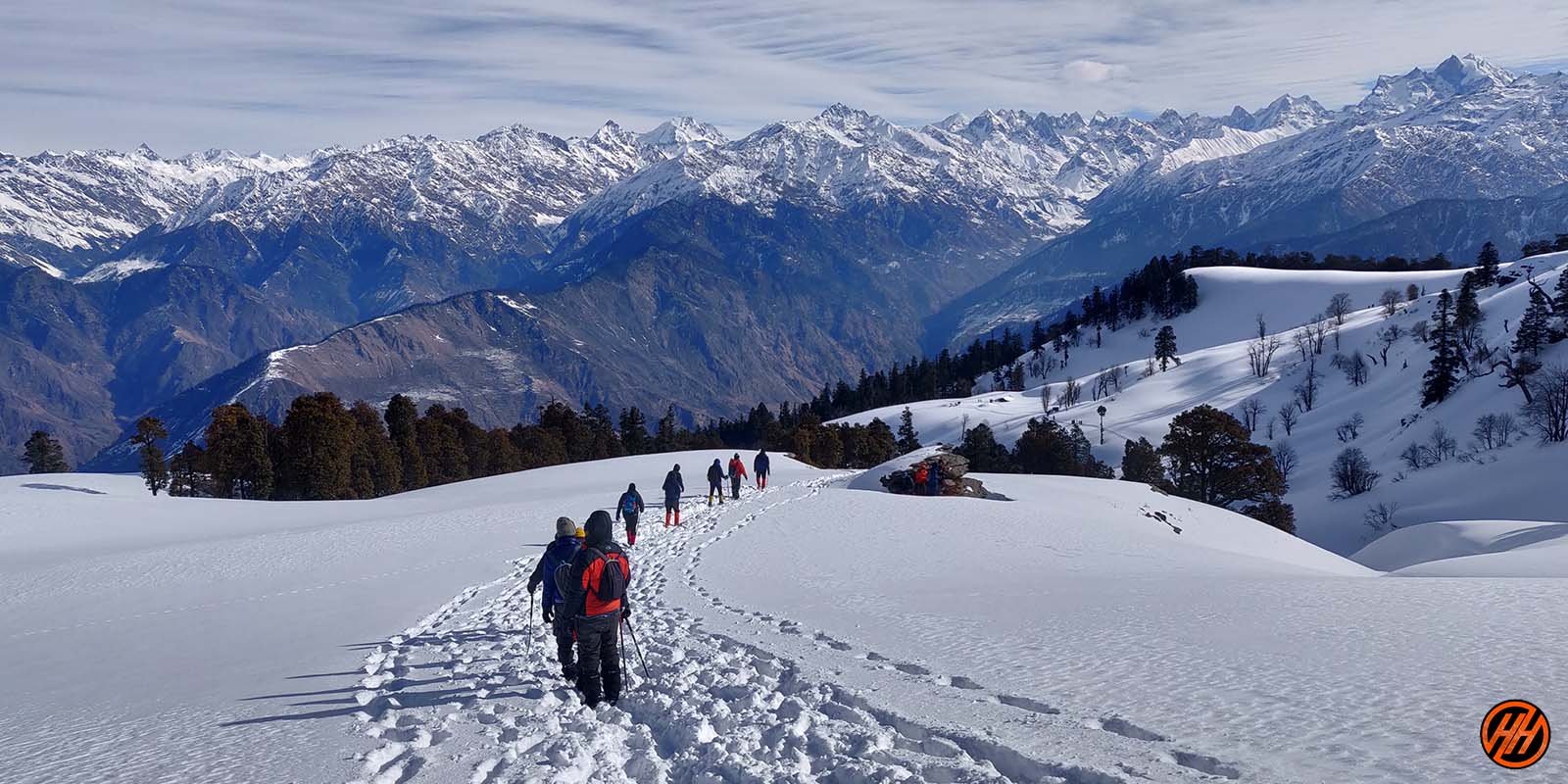
When does snowfall start in the Kedarkantha trek?
In the Kedarkantha trek, snowfall time occurs only in December, but sometimes it happens in early November as well, it is seasonal.
By the way, if it rains sometimes even in October, then the Kedarkantha peak becomes snowfall, but I do not know much longer.
The snow that falls from 15th December lasts for a long time.
Kedarkantha has the highest snowfall in the months of January and February, which lasts till the last of May and does not melt easily.
What should you keep in mind some things for doing the Kedarkantha Trek?
Kedarkantha trek is as good as it is said, you also need to be prepared., Kedarkantha trek is a moderate trek that starts from Sankri and ends at, So what are the special things to keep in mind before coming on this trek?
Winter Season
1. In Kedarkantha Trek Winter Trek, you will need warm clothes a lot, for which you will need proper good uniform clothes
2. Winters are always cold, so only warm clothes can keep you safe on the Kedarkantha trek
3. Always take the information from the company with which you are booking the trek before going on the trek, what do you need to bring
4. In the winter season, the temperature always drops day by day, so warm clothes will help you a lot.
Summer Season
1. The summer trek to Kedarkantha is very special, the view and the temperature are all favorable to you
2. For the summer trek, you have to bring only normal clothes so that your trek can be good, there is no need for hot clothes, but in hiking it is also necessary to bring all the equipment which is necessary for you.
3. It is necessary to have 3 pairs of clothes for trekking, especially the poncho, which you will have to bring every season
4. In the summer season, the temperature is always normal, so there is no need for hot clothes.
Monsoon Season
1. During the monsoon season, it rains occasionally during the Kedarkantha trek, especially in the Uttarakhand Himalayas, so if you have dry clothes here, it is very good, even when wet, it dries quickly.
2. At this time you have to bring at least 4 pairs of clothes, for the monsoon trek you do not have to bring too warm clothes, at this time you, hiking pants and t-Sart, I can trek
3. It’s only a little cold in the morning and evening and the day is a good temperature for you
4. Before going on any trek, it will be easy for you to take information related to each season.
5. Trekkers need to know about these, you can ask us anytime like the trek route, trek map, temperature, weather conditions, difficulty level, trek starting point, endpoint, transport, view of the trek, the best time to visit, How to reach Kedar Kantha, trek distance, Location, etc, keep this information before going.
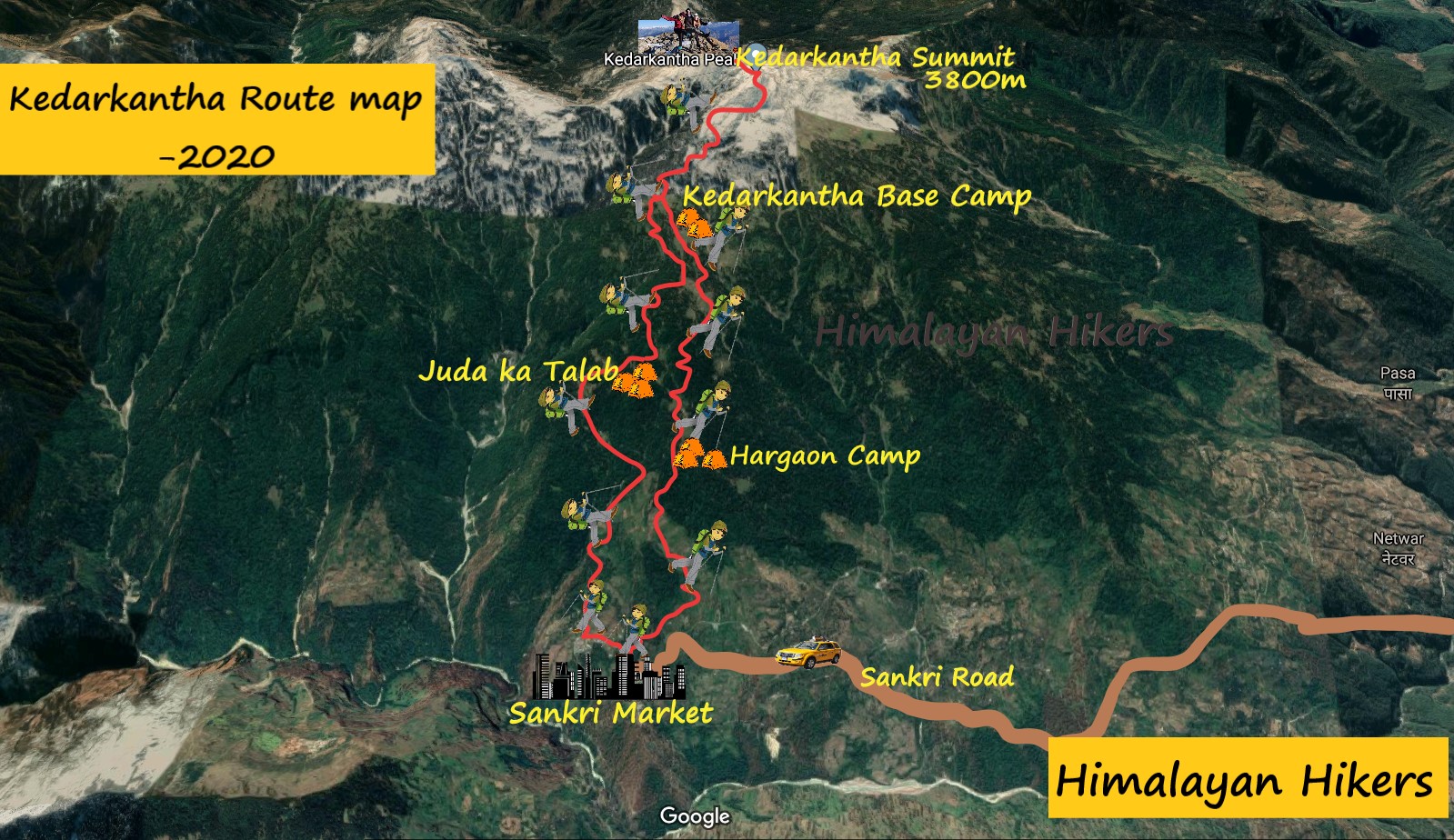
Note: – Our service will remain from Dehradun to Dehradun – for more details please check includes or excludes
How to Reach Sankri Base Camp?
The journey from Dehradun to the Sankri is beautiful and it is you in Dehradun. The way to Sankri is 190 km and it takes 7-8 hours to reach there, the drive is picturesque because you go through some of the beautiful places.
Also, read about – Sankri – A Small Paradise in the Himalayas, Uttarakashi, Uttarakhand
From Rajpur Road you will go and they will come to Mussoorie which is a hill station and it is known as the “Queen of Hills” it is situated at the foothills of the Greater Garhwal ranges and the aura of this place is aesthetic and the environment is soothing so it justifies its title
.After Mussoorie, you will come to Kampitfall. Here you will stop for breakfast. For 45 minutes after breakfast in Kampitfall, you will come along the Yamuna River – Purola, where you will stay for lunch for 1 hour. After that, you will be taken straight to the place where our team will be ready to welcome you.
The drive to Sankri (From where the Kedarkantha trek starts) is one of the most picturesque drives in the Himalayas through Dehradun, Mussoorie, Nain bag, Damta, Nawgano, Purola, Mori, Netwar, Sankri along the Rupin Supin or Tons River Kedarkantha trek is one the easiest treks in the Himalayas to enjoy thick snow cover. With this, you will start seeing the beautiful mountain range.
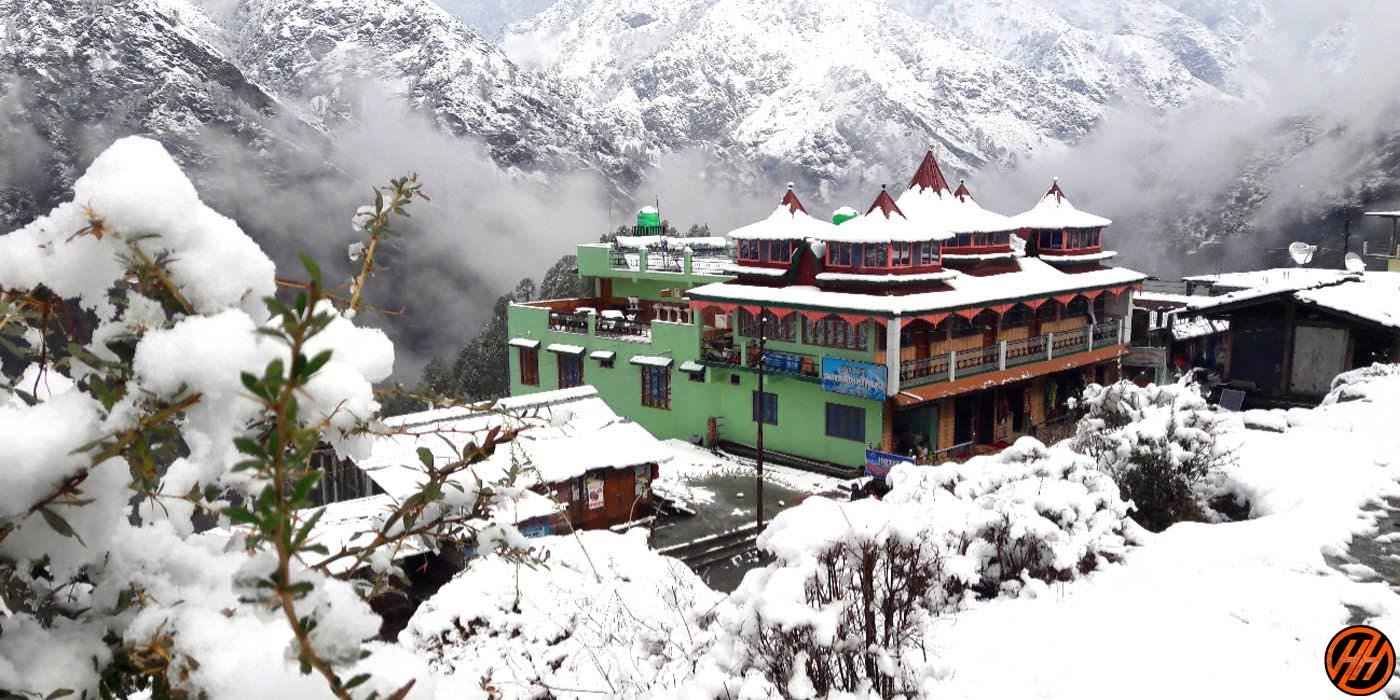
Will there be electricity in the Kedarkantha trek?
Let me tell you that there is no electricity in the forest area of the Kedarkantha trek. Here we use Stobe Light and or Solar Light, candlelight at the nights
If you come on this trek, then you should bring your own headlight and your camera with full charge, if possible, it would be good to bring extra battery backup, and also bring the phone after full charge, today people most of phones use the same
You will get the last electricity only in our hotel Sankri base, where you have to charge the battery of your phone and camera at night.
Phone connectivity and transactions
1) Only the Jio network works in the Sankri base camp, so we will tell our trekkers that if you have any very important thing to do, then Mori, or Purola to good network on your phone It would be better if you call from here to come. Connectivity along the route is unpredictable, so we advise people to complete all their work well in advance.
I will be able to get only Wi-Fi in Sankri, for this you have to pay 50 to 100 rupees.
2) In case of emergency, Himalaya Hikers trekkers will be provided with walkie-talkies in advance so that they can send their messages to the base camp
ATM- The last available ATM transaction will be in Dehradun or Purola. We advise travelers to deposit cash before or while in Dehradun as ATMs available at other locations may not dispense cash at times.
We pick up to you from Dehradun so take out cash from there itself.
How to reach the Kedarkantha trek
The easiest way to reach Dehradun is by flight, Direct flights are always available for Dehradun from Bangalore, Chennai, Delhi, Mumbai, Lucknow, Pune, Kolkata, Gujrat, and more
You can also easily reach Dehradun by train Via Delhi. Trains are available from all states of India.
1. Nanda Devi Express -12205 ( New Delhi to Dehradun ) · Classes: 1A,2A,3A ·
2. Trains from Dehradun DDN to Howrah Jn HWH DDN SPL 02327)
3. Doon Express -13010
4. Mussoorie Express -14041 ( Delhi S Rohilla to Dehradun )
5. Dehradun Shatabdi Express, 12017
Himalayan Hikers will arrange transport for you to go from Dehradun to Sankri Base Camp
Mode of Transport is Tempo Travelers and Bolero taxi, Swift taxi, more
Sankri is our main base Camp office of Kedarkantha trek and Har Ki Dun, Rupin Pass, Bali pass, Borasu pass, Baraadsar lake , more treks
You can reach Dehradun from Delhi by bus, and board it from (Delhi) ISBT, Kashmiri Gate it is good if you are booking the seats.
(Reach ISBT between 5:30 am to 7:00 am and the vehicle will be arranged from there.)
What is the distance to reach Kedarkantha from other state
- Delhi to dehradun distance by flight -207 Kms) and Dehradun airport to Sankri 217 kms by taxi and (Sankri to Kedarkantha 23 km on foot )
- Delhi to dehradun distance by train 302 kms ) and Dehradun to Sankri 190 kms by taxi and (Sankri to Kedarkantha 23 km on foot )
- Delhi to dehradun distance by bus 249 kms) and Dehradun to Sankri by taxi 190 kms, and (Sankri to Kedarkantha 23 km on foot )
- Bangalore to dehradun distance by air 1924 kms) (By Train – 2371 kms) and Dehradun airport to Sankri 217 km by taxi, and (Sankri to Kedarkantha 23 km on foot )
- Mumbai to dehradun distance by air 1344 kms) (By Train – 1724 kms ) and Dehradun to Sankri 190 km by Taxi and (Sankri to Kedarkantha 23 km on foot )
- kolkata to dehradun distance by air 1518 kms ( By Train – 1694 km) and Dehradun to Sankri 190 km by taxi and (Sankri to Kedarkantha 23 km on foot )
- The distance from Dehradun to Sankri is 190 kms.
- Musoorie to Sankri distance is 160 km.
What do we do for safety in Kedarkantha trek?
First of all, the safety of trekkers is much more for us, if you see in the trek, then there are all the risks, which I do not think about.
Himalayan Hikers worry more about you that no one should ever have any problem in the trek.
What should we and you keep more safety in the trek
- Whenever you are going for any trek, it is very important that you go completely fit and ready.
- The trek is not difficult, if you make your feet and your mind calm and strong, you will find the trek very easy.
- While trekking, keep in mind that you are walking on the right route or not always with your guide.
- Most people look somewhere and where they are walking, this can cause twitching in your legs, which can ruin your entire trek.
- It is important to ask your doctor if you have any medical problems
- I should always keep my medical kit with me, it is very important.
- Himalayan Hikers always keep a medical kit with you, such as oxygen cylinders, medicine to be given in emergency on the trek
- If any trekkers have any more problems, then they are brought back to the base camp by laying them in the stretcher.
- Our camp in Kedarkantha trek is around the tree line where you can not have any problem of oxygen
- In case of any medical problem, the help of your guide or well-informed trekkers should be taken
Why should you go for the Kedarkantha trek with Himalayan Hikers?
- Himalayan Hikers is one of the oldest trekking organizations, which is organizing trekking and adventure expedition in Uttarakhand Himalayas from almost past 30 years.
- Himalayan Hikers have started their journey from Sankri Base Camp. Sankri is base camp of more than 25 treks, Which we are organizing like – Kedarkantha, Har Ki Dun, Phulara Ridge trek, Bali pass, Borasu Pass, Rupin Pass. Dhumdharkandi pass. fachu kandi pass. Baraadsar lake, Rupin Supin trek, Nalgan pass, Kanasar lake and many more.
- We are the local people of Sankri village who can provide you the best experience here
- Good and experienced people from more than 20 villages are working with us, who will continue to serve you in your trek and will always be there with you throughout the trek.
- Himalayan Hikers provide the safety of their trekkers and good experience throughout the trek as well as share every story related to the mountains with you.
- Himalayan hikers will feed you with good, healthy and delicious food every day during the trek
- Where you can get the experience of Himalaya Hikers
- Himalayan Hikers own 1 hotel and 1 home stay in Sankri – Sour Village where you can spend some quality time with your family, friends and your loved once.
PARTICIPANTS MUST BRING FOR KEDARKANTHA TREK: SEASON 2023
- Backpack of 50 -60 ltrs
- Sturdy hiking boots: preferably all leather upper as it provides better ankle support. If you do not own a pair yet, it is advisable that you buy one as soon as possible & wear it often so that they are well broken. This will help prevent blisters.
- Lightweight tennis shoes/sandals: for wearing in camp
- Wool socks: 2 pairs: preferably thick wool socks.
- Nylon socks: 2- Pairs, of the type you wear daily to be worm under the wool socks to prevent blisters.
- Hiking shirt: 1 Preferably long sleeve
- Long John top: 2 also known as thermal underwear, preferably wool to be worm as the first layer.
- Warm shirts & pants for camp : 2 each
- Rain cot/ Poncho 1 each • Warm Jacket: 1
- Wool gloves: 1 pairs as thick as available in the market.
- Long John bottoms: Preferably wool to be worm as first layer.
- Under wear: 2-3 changes Hiking shorts/ pants: 1
- Sun hat: Cotton or nylon. Sun Glasses: Preferably with an anchor
- Sun Protection Lotion: optional Lip balm/chap stick: optional
- Water bottle: 2 Bottles of 1 Liter capacity (Pepsi bottles work well) please insure that they do not leak.
- Head lamp / flashlight: Preferably a headlamp as it leaves your hands free to work please bring extra batteries.
- Toilet articles: Tooth brush, tooth paste, etc+ And personal medical kit small one
Kedarkantha Trek FAQs
Q- what is special about the kedarkantha winter trek.
Answer- The Kedarkantha Winter Trek is renowned for its stunning snow-covered landscapes and breathtaking views of the Himalayas. Here are some key highlights and special features of the Kedarkantha Winter Trek:
Snow-covered trails: The trek takes you through dense forests and pristine meadows blanketed with snow, creating a picturesque winter wonderland.
Panoramic views: One of the main attractions of the Kedarkantha trek is the breathtaking panoramic views of the Himalayan peaks, including Swargarohini, Bandarpoonch, Black Peak, and Ranglana.
Camping experience: The trek involves camping at various scenic locations, allowing trekkers to experience the serenity of the mountains and the beauty of camping under the stars amidst snow-capped peaks.
Cultural immersion: The trek passes through several remote villages, providing trekkers with an opportunity to interact with the local Garhwali people and experience their culture and way of life.
Wildlife sightings: The trek offers the chance to spot various Himalayan wildlife species such as musk deer, monal pheasants, and Himalayan langurs in their natural habitat.
Q- Children up to what age can do this trek? And the older ones who are around 60 years of age?
Answer – The suitability of the Kedarkantha Winter Trek for children and older adults can depend on various factors such as their physical fitness, prior trekking experience, and ability to withstand cold weather conditions. Here are some general considerations:
Children : While there is no strict age limit for children to do the Kedarkantha trek, it is generally recommended for children above the age of 8 or 10 years old, depending on their physical fitness and endurance levels. Younger children may find the trek challenging due to its duration, altitude, and cold weather conditions. Parents should assess their child’s physical abilities and consult with trek organizers for specific age recommendations.
Older adults (around 60 years of age) : Older adults in good health and with a reasonable level of fitness can certainly undertake the Kedarkantha trek. However, they need to consult with a healthcare professional before embarking on the trek, especially if they have any pre-existing medical conditions. Trek organizers may also recommend a slower pace and adequate rest breaks to accommodate the needs of older trekkers. Older adults must acclimatize properly to the altitude and listen to their bodies throughout the trek to avoid overexertion or altitude-related issues
Q- The special points in Kedarkantha winter we should prepare for?
Extreme Cold : Temperatures during winter months can drop well below freezing, especially at higher altitudes. It’s essential to pack appropriate cold-weather gear such as insulated clothing, thermal layers, gloves, hats, and a good quality sleeping bag rated for sub-zero temperatures.
Snow and Ice : The trail to Kedarkantha can be covered in snow and ice during winter, making it slippery and potentially hazardous. Ensure you have sturdy, waterproof trekking boots with good traction. Carry microspikes or crampons for extra grip on icy sections.
Altitude : While Kedarkantha is not an extremely high-altitude trek compared to some other Himalayan treks, it still reaches altitudes above 3,800 meters (12,500 feet). Acclimatize properly by ascending gradually and staying hydrated. Be aware of symptoms of altitude sickness and descend if necessary.
Packing the right amount and type of clothing is crucial for staying comfortable and safe during a winter trek to Kedarkantha. Here’s a general guideline for the types and quantities of clothing to consider:
- Long-sleeved thermal tops: 1-2
- Thermal leggings: 1-2 pairs
- Thermal socks: 3-4 pairs
- Fleece jacket or sweater: 1-2
- Insulated down jacket or synthetic equivalent: 1
- Insulated pants or trousers: 1 pair
- Waterproof, windproof jacket: 1
- Waterproof, windproof pants: 1 pair
- Gaiters (to keep snow out of boots): 1 pair
- Wool or fleece hat: 1
- Balaclava or neck gaiter: 1
- Sunglasses with UV protection: 1
- Ski goggles (for windy or snowy conditions): 1
- Insulated gloves or mittens: 1 pair
- Waterproof outer gloves or mittens: 1 pair
- Insulated, waterproof trekking boots: 1 pair
- Extra pairs of woolen socks: 2-3 pairs
- Trekking poles (for stability on snow and ice): 1 pair
- Backpack rain cover (to keep your gear dry): 1
- Spare set of dry clothes for sleeping
Q- How risky is the Kedarkantha trek for beginners?
Moderate Level : Kedarkantha is generally considered a moderate trek suitable for beginners with a reasonable level of fitness. The trail involves ascending and descending through varied terrain, including forested paths, snow-covered slopes, and rocky sections. While it’s manageable for most beginners, some may find certain sections challenging, especially in winter when snow and ice are present
Q- How Do I prepare for the Kedarkantha winter trek physically?
Preparing for the Kedarkantha trek physically requires a combination of cardiovascular endurance, strength training, flexibility, and altitude acclimatization. Here’s a more detailed plan to help you get ready:
- Start with regular aerobic exercises like brisk walking, jogging, cycling, or swimming.
- Gradually increase the duration and intensity of your workouts to simulate the demands of trekking.
- Aim for at least 30-60 minutes of cardio activity, 3-4 times per week.
- Pull-ups or lat pulldowns
Focus on compound exercises that target multiple muscle groups simultaneously. Aim for 2-3 strength training sessions per week, allowing at least 48 hours of rest between sessions to allow for muscle recovery.
- Hip flexors
Incorporate dynamic stretches and mobility exercises to improve range of motion and joint stability.
- If possible, spend some time at moderate altitudes before the trek to allow your body to acclimatize gradually.
- Stay hydrated by drinking plenty of water throughout the day.
- Ascend gradually during the trek, allowing time for your body to adjust to the altitude.
- Be aware of symptoms of altitude sickness and descend if you experience severe headaches, nausea, dizziness, or difficulty breathing.
- Practice Trekking : If you have access to hiking trails in your area, go on regular hikes to simulate trekking conditions. Start with shorter hikes and gradually increase the distance and elevation gain as you build your fitness level.
- Pack Training : Train with a weighted backpack to simulate the load you’ll be carrying during the trek. Start with a lighter pack and gradually increase the weight as you get stronger.
- Rest and Recovery : Make sure to incorporate rest days into your training schedule to allow your muscles to recover and rebuild. Listen to your body and adjust your training intensity as needed to avoid overtraining and injury.
Our Extra Luggage Where do we keep, in Sankri?
Hotels, guesthouses, or homestays : Extra luggage keep our sankri Hotel Sankri offers luggage storage facilities for their guests. You can inquire about the place where you are staying,
What are offloading luggage charges on Kedarkantha Trek?
The cost of luggage offloading charges on the Kedarkantha Trek ranged from Per bag per day Rs. 300 Indian Rupees per day per bag. 8 kg to 10 kg allowed
What type medicines carry for kedakantha trek ?
it’s essential to carry a basic medical kit to address common ailments and emergencies. Here’s a suggested list of medicines and supplies you might consider bringing:
- Acetaminophen or Ibuprofen for general pain relief.
- Aspirin for mild pain relief and as a blood thinner (useful in case of suspected heart attack).
- For indigestion and heartburn.
- For allergic reactions and insect bites/stings.
- Also, useful for managing symptoms of cold or allergies.
- Such as loperamide, in case of diarrhea.
- Oral rehydration salts to replenish electrolytes in case of dehydration.
- Broad-spectrum antibiotic for treating bacterial infections (e.g., respiratory infections or wound infections).
- Prescription from a doctor might be necessary.
- For treating minor wounds or cuts.
- For cleaning wounds.
- For dressing wounds and injuries.
- For preventing and treating blisters.
- SPF 30 or higher to protect against sunburn at high altitudes.
- To prevent chapped lips.
- For removing splinters and cutting bandages or tape.
- To ensure safe drinking water during the trek.
- Any prescription medications you regularly take.
- List of emergency contacts and any relevant medical information.
How many days before booking the Kedarkantha Trek Package?
The number of days before booking a Kedarkantha trek package can vary depending on several factors such as the availability of slots, the policies of the trekking company or tour operator, and personal preferences. However, it’s generally advisable to book your trek package well in advance, especially during peak trekking seasons or popular times of the year.
Here are some considerations regarding booking timing:
- Peak Seasons: If you plan to trek during peak seasons like ( December to March) or autumn (September to November), it’s recommended to book several months in advance, sometimes even 2 months to a year ahead, to secure your spot.
- Off-Peak Seasons: If you’re flexible with your travel dates and prefer trekking during off-peak seasons like winter (December to February) or monsoon (June to August), you might have more flexibility in booking closer to your preferred dates. However, it’s still advisable to book at least a few weeks in advance to ensure availability and to allow for necessary preparations.
- Group Size: Larger groups may need to book further in advance to secure accommodations and permits, especially if you’re traveling during peak seasons.
- Last-Minute Booking: Last-minute bookings might be possible, especially if you’re traveling solo or in a small group, and if there’s availability. However, there’s a risk of limited options and higher prices.
- Tour Operator Policies: Check the policies of the trekking company or tour operator you’re considering booking with. Some may require booking well in advance, while others may offer last-minute deals or flexible booking options.
Himalayan Hikers – Provided food During the Kedarkantha Trek
We serve five -05 times meals a day including- Breakfast, Lunch, Eevening Snakes, Soup, Dinner, A variety of delectable and healthy food is provided which includes; Indian, Chinese and other Western meals. They are nutritious and keep you fit and healthy on the trek.(Veg or non-veg food) With our local food and Day Pack, for Summit Day like fresh fruits
Food Menu – Roti + Rice + Salad + Papad +Matter paneer +Daal +mix veg+ daily more vegetable +sweet+ Bread +Omelets +Nutella + jam + butter +Muesli, Milk+Banana+ Allo parantha +Tea & coffee Cornflakes, Milk +Egg bhurji +Bread, Peanut Butter +Pancake +Plain parantha +Fruits+ Porridge Oats+ +Bread & cheese +Poha +Boiled egg + Gulab Jamun+ Custard+ Jalebi+ Chilla +Honey+ Puri + Chole more
Note: – This is only list Himalayan Hikers Team or Cook provide you more healthy food and more items of per day menu
The type of food provided during a trek can vary depending on factors like the location, duration, and the trekking company or organization you’re with. However, there are some common types of food that are often included in trekking provisions:
- Carbohydrates : Foods high in carbohydrates provide energy for the trek. This includes items like rice, pasta, bread, and potatoes. More
- Proteins : Protein-rich foods help with muscle repair and recovery. Common protein sources include lentils, beans, tofu, meat (if available), eggs, and dairy products.
- Fruits and vegetables : These provide essential vitamins, minerals, and fiber. While fresh produce may not always be available, dried fruits and vegetables or canned options might be included.
- Snacks : Trekking often involves long hours of physical exertion, so snacks are important for quick energy boosts. Snacks like nuts, energy bars, trail mix, and chocolate are common choices.
- Local cuisine: Depending on the region you’re trekking in, you might also get the chance to sample local dishes. This can be a delightful way to experience the culture and flavors of the area.
Day 1: Pickup from Dehradun Railway Station and Drive to Sankri (base camp) by Tempo Travellers 13+D
Total distance 190 km – 8/9 Hours journey
Mode of journey – By taxi
Altitude – Sankri base camp – 1920 Meters
Night stay – Our Swargarohini Hotel – on a share basis
Himalayan Hikers organizes transport for trekkers from Dehradun Railway Station in the morning which will leave for Sankri around 6:00 am to 7:00 am.
Dehradun is the capital of Uttarakhand and one of the most beautiful places in India. The main attraction of this place is Rajpur road go through it and get a glimpse of Dehradun’s beauty. Reach Mussoorie after an hour which is also known as “Queen of Hills”. People visit it heavily during vacations with their family and friends.
- Dehradun to Mussoorie: The drive often begins in Dehradun and takes you through the picturesque hill station of Mussoorie. The scenic beauty of the Mussoorie hills with its lush greenery and pleasant weather is a great start to your journey.
- Mussoorie to Kempty Falls: As you continue your drive, you can make a detour to Kempty Falls, a popular tourist spot. The falls offer a refreshing stopover with beautiful cascades surrounded by green hills.
- Purola: After Kempty Falls, you’ll continue your journey through Purola. This is where the terrain starts to become more hilly and remote, offering a glimpse of rural Himalayan life.
- Beautiful Villages: The drive takes you through several small villages and hamlets, each with its own charm. You’ll pass by terraced fields, pine forests, and quaint houses that dot the landscape.
- Stunning Valleys: As you get closer to Sankri, you’ll enter valleys with breathtaking views. The Tons River Valley is particularly beautiful, and you’ll cross it on your way to Sankri. The river, surrounded by lush green hills, is a sight to behold.
- The Last Stretch to Sankri: The final part of the drive is through dense forests and narrow mountain roads. The road might be challenging, but the natural beauty is truly remarkable. As you get closer to Sankri, you’ll notice the mountain vistas opening up, and you’ll be surrounded by towering peaks.
- Sankri: When you arrive in Sankri, you’ll find it to be a charming village with a Himalayan backdrop. The views of the surrounding mountains, especially during sunrise and sunset, can be awe-inspiring.
Go to Hotel Swargarohini, freshen up, and enjoy evening snacks in the open terrace with great views. You will be provided some details after which you can go for an evening walk but be at the hotel for dinner.
Enjoy a delicious dinner and spend a comfortable night in the mountains.
Day 2 : Trek from Sankri to Juda Ka Talab
Trek Distance 5 Km – 4/5 Hours Trek
Mode of journey – on foot
Altitude – Juda ka talab – 2700 Meters
Night Stay – Camp in tents – on a shared basis
Today, the heartwarming morning is eagerly waiting for you to wake up. Feel the peace amid the mountains; no connectivity and no materialistic thing is here to disturb you, the only thing is peace.
Relish the hot cup of coffee/tea at 6:00 a.m. and get ready for your breakfast at 7:30 a.m. You have to strictly leave at 8:30 am after the instructions of your guide
The trek from Sankri to Juda Ka Talab on the way to Kedarkantha is a beautiful journey that takes you through the lush forests of the Govind National Park in Uttarakhand, India. Here’s a rough route and some of the scenic highlights along the way:
- Sankri (Base Camp): Your trek to Kedarkantha starts from Sankri. Sankri is a picturesque village surrounded by snow-capped peaks and lush green meadows.
- Forest Trail: As you leave Sankri, you’ll enter a dense forest with pine, oak, and rhododendron trees. The forest trail is particularly beautiful during spring when the rhododendron trees are in bloom.
- Scenic Views: As you ascend, you’ll have occasional openings in the forest that offer glimpses of the snow-capped peaks in the distance. The Swargarohini range and Bandarpoonch are some of the prominent peaks you might spot.
- Water Crossings: You’ll encounter a few small streams and water crossings along the way. These add to the charm of the trek and provide opportunities for refreshing breaks.
- Kedarkantha Base Camp: After a few hours of trekking, you’ll reach the Kedarkantha Base Camp. This campsite is located in a meadow and offers panoramic views of the surrounding mountains.
- Juda Ka Talab: From the Kedarkantha Base Camp, you’ll continue your trek to Juda Ka Talab. The trail meanders through more forests and meadows. Juda Ka Talab is a small, picturesque lake surrounded by a meadow and is an excellent camping spot. The reflections of the surrounding mountains in the clear water make it a beautiful setting.
- Mountain Views: While at Juda Ka Talab, you’ll have stunning views of Kedarkantha Peak, which appears quite close from here. The clear mountain air and the serene atmosphere make this campsite a wonderful place to spend the night.
The trek from Sankri to Juda Ka Talab is known for its natural beauty and relatively moderate difficulty, making it a popular choice for trekkers. It’s advisable to undertake this trek with a guide or in a group, especially if you’re not familiar with the route, as weather conditions can change rapidly in the mountains, and a guide can provide important local knowledge and safety.
Day 3 : Trek from Juda Ka talab to Kedarkantha base
Trek Distance 03 Km – 2/3 Hours Trek
Altitude – Kedarkantha basecamp – 3200 Meters
Night Stay – Camp in a tent- on a share basis
The trek from Juda Ka Talab to Kedarkantha Base Camp is a crucial part of the Kedarkantha trek in Uttarakhand, India. It offers some breathtaking views of the Himalayan landscape. Here’s an overview of the route and what you can expect to see along the way:
- Juda Ka Talab: You’ll start your trek from Juda Ka Talab, a picturesque alpine lake surrounded by meadows. The lake’s pristine waters and reflections of the surrounding peaks create a serene atmosphere. Take in the beautiful surroundings before setting out.
- Gradual Ascent: The trail from Juda Ka Talab to Kedarkantha Base Camp involves a gradual ascent through a mix of meadows and forests. The path can be snowy, especially in the winter months, so make sure to wear appropriate footwear and carry trekking poles for stability.
- Views of Kedarkantha Peak: As you trek, you’ll have periodic views of the Kedarkantha Peak in the distance. The snow-clad peak stands tall and is an ever-present reminder of your ultimate goal.
- Pine Forests: You’ll pass through dense pine forests with towering trees. The forested sections offer a refreshing change of scenery from the meadows and are particularly enchanting in the snow.
- Mountain Vistas: The trek provides stunning panoramic views of the surrounding Himalayan peaks, including Swargarohini, Bandarpoonch, and the Gangotri-Yamunotri range. These views get more captivating as you gain altitude.
- Kedarkantha Base Camp: After a few hours of trekking, you’ll reach the Kedarkantha Base Camp. The campsite is located in a high-altitude meadow with stunning 360-degree views of the Himalayas. The Kedarkantha Peak is prominently visible from here, and it makes for an ideal spot to rest and acclimatize.
- Snow (in Winter): Depending on the season and recent weather, you might encounter snow on the trail. This can make the trek more challenging but also more beautiful.
The Kedarkantha Base Camp is a popular spot for trekkers to spend the night before making the final ascent to the summit of Kedarkantha Peak. The clear mountain air and the quiet, serene environment at the base camp create a peaceful setting for trekkers to prepare for the next day’s adventure.
Day 4 : Trek from Kedarkantha base camp to Kedarkantha Summit (3800 Meters) and descent to Hargaon Thach
Trek Distance 11 Km – 6/7 Hours Trek
Altitude – Hargaon thach – 2645 Meters
Today is the main day of your trek, so be ready at 3:30 am in the morning to witness the sunrise from the Kedarkantha summit. Nothing can be better than watching the rising sun from the summit because then the views are jaw-dropping. Whoever watches it gets mesmerized.
The Kedarkantha summit is the final destination of the Kedarkantha trek, and it offers breathtaking views of the surrounding Himalayan peaks. Here’s a description of the route from Kedarkantha Base Camp to the Kedarkantha summit and its location:
- Starting from Kedarkantha Base Camp: The trek to the Kedarkantha summit typically begins from the Kedarkantha Base Camp. This campsite is situated in a high-altitude meadow and serves as the starting point for the summit attempt.
- Early Start: To reach the summit and enjoy the best views, it’s recommended to start very early in the morning, usually before dawn. The early start allows you to ascend while the snow is still firm and the weather is clear.
- Ascend through Alpine Meadows: The trail from the base camp to the summit involves a gradual ascent through alpine meadows. The landscape becomes more open, and you’ll be walking on a mix of snow and rock.
- Snow Clad Terrain (in Winter): Depending on the season, you might encounter varying degrees of snow as you climb higher. In the winter months, the trail is often covered in snow, which can make the trek more challenging but incredibly beautiful.
- Views of Surrounding Peaks: As you ascend, you’ll be treated to breathtaking views of the surrounding Himalayan peaks, including Swargarohini, Bandarpoonch, Kalanag, and others. The views become more and more stunning as you get closer to the summit.
- Kedarkantha Summit: The Kedarkantha summit is a small, snow-clad peak. Once you reach the summit, you’ll be rewarded with panoramic views of the Himalayan ranges. The Kedarkantha Peak itself is a remarkable sight, and you’ll also have a clear view of the Har Ki Dun Valley.
The Kedarkantha summit is at an elevation of approximately 12,500 feet (3,800 meters), and it’s known for its captivating 360-degree views of the surrounding mountains and valleys. It’s a popular spot for trekkers to take in the beauty of the Himalayas, especially at sunrise when the peaks are bathed in golden light.
Day 5: Trek from Hargaon thach to Sankri – Hotel Swargarohini
Trek Distance- 0 5 Km – 4/5 Hours Trek
Night Stay – Hotel – on twin share basis
Today morning enjoy breakfast at your last camp of this trek. Start trekking and while descending from Hargaon to Sankri you will come across many viewpoints and reach the apple orchards.
- Hargaon Campsite: Your last day of trekking usually starts from the Hargaon campsite. Hargaon is a picturesque campsite located in a forested area. It’s a serene and peaceful spot with the soothing sounds of the forest.
- Descend through Forest: The trail from Hargaon to Sankri is primarily a descent through the forested area. You’ll be walking through dense pine and oak forests, which can provide a different but equally enchanting view compared to the alpine meadows higher up on the trek.
- Mountain Views: While descending through the forest, you might still have occasional glimpses of the surrounding Himalayan peaks. These views can be especially beautiful with the play of light and shadow through the trees.
- Passing Through Villages: As you get closer to Sankri, you’ll pass through small villages and settlements. These provide a glimpse of local life in the region, and you may encounter friendly villagers along the way.
- Sankri: Your trek concludes when you reach Sankri. Sankri is a charming village in the Uttarkashi district of Uttarakhand and serves as the starting and ending point for the Kedarkantha trek. The village is surrounded by snow-capped peaks and lush landscapes.
- Village Scenery: The village of Sankri itself is quite picturesque, with traditional wooden houses, terraced fields, and the beautiful backdrop of the Himalayan mountains.
Day 6: Return from Sankri to Dehradun by Tempo Travellers
Distance 19 0 Km – 8/9 Hours Trek
Mode of the journey – Bay Tempo Travellers
Our service ends here
Today – It is your last breakfast on this trek with the Himalayan Hikers team. The certificates will be given and after some beautiful photos, we will bid you all goodbye from Sankri.
Mandatory Documents
Please carry the documents given below.
Original and photocopy of government photo identity card- (Aadhar Card, Driving License, Voters ID, etc, Passport and Visa important to foreigners Medical Certificate (First part should be filled by the Doctor and Second part by the Trekker) Declaration Certificates
Note: – Many trekkers commit the same mistake of carrying unnecessary items on a trek which only makes the backpack heavy. It is important to know the right items to carry. It differs from season to season if you are trekking in summers then carry less layers of warm clothing and if you are trekking in winters carry enough layers to protect yourself against chilly cold.
Necessary Items for trekkers

Backpack (50 to 60 liters) A strongly built backpack with good support is compulsory for a trek. (Rain cover is important)
Sturdy Trekking Shoes The shoes should be strong enough with good support. The people ask if sports shoes would be comfortable but it is good to bring the right trekking shoes.
The Clothes You Should Bring On a Trek Avoid keeping extra clothes because it only makes you backpack heavy.
Trek Pants – The jeans are never suitable for a trek so you need at least 2-3 trek pants for treks carry more for longer treks.
Jacket – Jackets are very important to carry on a trek it protects you against the chilly weather. So carry 2 jackets on a week long trek.
Layers of warm Clothing Carry warm woolen layers or fleece. Carry more layers during winter season (at least 2 to 3) and less during summer.
Thermals – The Temperature decreases at night so you might be need thermals for Night.
T- Shirts – Bring those t shirts which dry fast.
Poncho –They are needed if you are trekking on a Rainy day to keep you dry.
Hiking Pole
Water Bottle 2
Cap or Balaclava
Woolen and Waterproof Gloves
Socks (Woolen and Regular)
Torch head light
Personal Toiletry Items – (toothpaste, toothbrush, toilet paper, sanitizer etc.)
Carry Personal Medical Kit
Personal Medical Kit (Carry minimum 5 tablets and maximum 10)
Medicine for Altitude Sickness
Medicine for acidity and discomfort.
Fever and Headache Medicines
Pain Reliever
Motion Sickness Medicine
Medicine for Allergies
Medicine for Diarrhoea
Sprains Cream or Spray
Antiseptic Cream
Stretchable/Elastic bandage
Note:- Please take all medicines only when prescribed by the doctor. In case you face any problem during your trek, discuss and take advice from the Professional guide.
It is important to have some guidelines in place in case something unexpected happens. Here are some general guidelines that may be helpful:
- Have a first-aid kit: Make sure to carry a well-equipped first-aid kit that can be used to treat minor injuries and ailments.
- Follow safety protocols: It is important to follow all safety protocols and guidelines related to the trek. This includes staying on designated trails, avoiding risky or dangerous areas, and staying with your group.
- Have a communication plan: Make sure to have a communication plan in place in case of emergencies. This may include carrying a mobile phone or a satellite phone, or using a walkie-talkie to stay in touch with other members of your group.
- Know the local emergency services: Be aware of the local emergency services available in the area where you will be trekking. This includes knowing the location of the nearest hospital, police station, or rescue service.
- Carry proper gear and equipment: Make sure to carry appropriate gear and equipment for the trek, including proper footwear, warm clothing, and rain gear. This will help you stay comfortable and safe during the trek.
- Follow Leave No Trace principles: Follow Leave No Trace principles and leave the trekking area as you found it. This includes packing out all trash and waste, avoiding damaging vegetation, and respecting wildlife.
- Stay calm and collected: In case something unexpected happens, try to stay calm and collected. Assess the situation and take appropriate action to stay safe and help others in your group.
It’s also a good idea to consult with a local trekking agency or experienced guide before embarking on a trek, as they can provide additional guidance and support to ensure a safe and enjoyable experience.
Kedarkantha Trek FAQ
1. What is the Kedarkantha Trek? Kedarkantha is a popular winter trekking destination in the Garhwal Himalayas of Uttarakhand, India. It is known for its scenic beauty, dense pine forests, expansive meadows, and panoramic views from the summit.
2. Where is Kedarkantha located? Kedarkantha is located in the Govind Wildlife Sanctuary in Uttarkashi district, Uttarakhand.
3. How do I reach the starting point of the trek? The trek starts from a village called Sankri. Here’s how you can reach Sankri:
- By Air : The nearest airport is Jolly Grant Airport in Dehradun, about 220 km from Sankri. From there, you can hire a taxi to Sankri.
- By Train : The nearest railway station is Dehradun Railway Station, around 200 km from Sankri. You can take a bus or taxi from Dehradun to Sankri.
- By Road : Sankri is well-connected by road. You can take a bus or taxi from Dehradun, which is approximately an 8-10 hour drive.
4. What is the best time to visit Kedarkantha? The best time to trek to Kedarkantha is during the winter months of December to April, when the region is covered in snow, offering a beautiful winter trekking experience. It can also be trekked from April to June and September to November, but winter is the most popular season.
5. What is the duration of the trek? The Kedarkantha trek typically takes 5-6 days, including travel time to and from Sankri.
6. What is the difficulty level of the trek? The trek is considered easy to moderate. It involves gradual ascents and is suitable for beginners with good physical fitness.
7. What is the altitude of Kedarkantha? The summit of Kedarkantha is at an altitude of approximately 3,810 meters (12,500 feet).
8. What should I pack for the trek? Here’s a list of essential items to pack:
- Warm clothing (layers, thermal wear, down jacket)
- Trekking shoes with good grip
- Trekking poles
- Backpack (40-60 liters)
- Sleeping bag (if not provided by the trekking company)
- Personal medical kit
- Water bottles and purification tablets
- Snacks and energy bars
- Raincoat/poncho
- Sunscreen, sunglasses, hat
- Flashlight/headlamp with extra batteries
- Toiletries and personal hygiene items
9. Do I need a permit for the trek? Yes, you need permits to trek in the Govind Wildlife Sanctuary. These can usually be arranged by your trekking company or obtained from the forest department office in Sankri.
10. What kind of accommodation is available during the trek? Accommodation during the trek typically includes camping in tents at designated campsites. The facilities are basic but comfortable.
11. Are there any risks or challenges on the trek? The trek involves challenges such as:
- Cold weather and potential snowfall
- Physical strain from long trekking days
- Altitude-related issues It’s essential to acclimatize properly, stay hydrated, and follow the guidance of your trek leader.
12. Is it safe to trek alone? While it is possible to trek alone, it is highly recommended to join a group or hire a local guide for safety, navigation, and a richer experience.
13. Can I do the trek if I have no prior trekking experience? Yes, beginners can do the Kedarkantha trek, but it is advisable to be in good physical condition and perhaps undertake some shorter treks beforehand to build endurance.
14. What kind of food is provided during the trek? Most trekking packages include vegetarian meals, which are nutritious and catered to trekking needs. The food usually includes local cuisine, rice, chapati, vegetables, dal, and snacks.
15. What are some key highlights of the trek?
- Spectacular views of peaks like Swargarohini, Bandarpoonch, and Black Peak
- Dense forests of pine, oak, and rhododendron
- Snow-covered landscapes in winter
- The serene Juda ka Talab (a high-altitude lake)
- The panoramic views from the Kedarkantha summit
16. Are there any cultural or historical aspects of the trek? The trek passes through traditional villages like Sankri, which offer a glimpse into the local culture and lifestyle of the people living in the Garhwal Himalayas.
17. What kind of fitness is required for the trek? A basic level of fitness is required for the Kedarkantha trek. Regular cardiovascular exercise, such as jogging, swimming, or cycling, and leg strengthening exercises can help prepare for the trek.
18. What should I be aware of regarding altitude sickness? Altitude sickness can affect anyone above 2,500 meters. To minimize the risk:
- Acclimatize properly
- Stay hydrated
- Avoid alcohol and smoking
- Ascend slowly and give your body time to adjust
This FAQ should provide a thorough overview for anyone considering the Kedarkantha trek. If you have more specific questions, feel free to ask!
Are you Looking for Trekking Equipment on Rent?
If any trekker needs trekking equipment on Rent then Himalayan Hikers has the best trekking equipment available on rent.
There are many people behind this who are in great need of it, it is better to hire it at affordable price without spending much money for just a few days.
Rent Costs per Day
1. Hiking shoes Per day Rs. 100/-
2. Hiking Pant Per Day Rs. 100/-
3. Down Jacket Per Day Rs. 100/-
4. Hiking Pole Per Day Rs. 50/-
5. Headlight Per Day Rs. 50/-
6. Trekking Bag 50 to 60 litter Per Day Rs. 50/-
7. Gloves Per Day Rs. 50/-
Trek Equipment You can book directly on first day at the Sankri Base Camp.
September-2024
15 Sep to 20 Sep 2024 (Open)
20 Sep to 25 Sep 2024 (Open)
21 Sep to 26 Sep 2024 (Open)
22 Sep to 27 Sep 2024 (Open)
27 Sep to 02 Oct 2024 (Open)
28 Sep to 03 Oct 2024 (Open)
29 Sep to 04 Oct 2024 (Open)
October- 2024
04 Oct to 09 Oct 2024 (Open)
05 Oct to 10 Oct 2024 (Open)
06 Oct to 11 Oct 2024 (Open)
11 Oct to 16 Oct 2024 (Open)
12 Oct to 17 Oct 2024 (Open)
13 Oct to 18 Oct 2024 (Open)
18 Oct to 23 Oct 2024 (Open)
19 Oct to 24 Oct 2024 (Open)
20 Oct to 25 Oct 2024 (Open)
25 Oct to 30 Oct 2024 (Open)
26 Oct to 31 Oct 2024 (Open)
27 Oct to 01 Nov 2024 (Open)
November-2024
01 Nov to 06 Nov 2024 (Open)
02 Nov to 07 Nov 2024 (Open)
03 Nov to 08 Nov 2024 (Open)
08 Nov to 13 Nov 2024 (Open)
09 Nov to 14 Nov 2024 (Open)
10 Nov to 15 Nov 2024 (Open)
11 Nov to 16 Nov 2024 (Open)
15 Nov to 20 Nov 2024 (Open)
20 Nov to 25 Nov 2024 (Open)
21 Nov to 26 Nov 2024 (Open)
22 Nov to 27 Nov 2024 (Open)
23 Nov to 28 Nov 2024 (Open)
24 Nov to 29 Nov 2024 (Open)
25 Nov to 30 Nov 2024 (Open)
26 Nov to 01 Dec 2024 (Open)
27 Nov to 02 Dec 2024 (Open)
28 Nov to 03 Dec 2024 (Open)
29 Nov to 04 Dec 2024 (Open)
30 Nov to 05 Dec 2024 (Open)
December -2024
01 Dec to 06 Dec 2024 (Open)
02 Dec to 07 Dec 2024 (Open)
03 Dec to 08 Dec 2024 (Open)
04 Dec to 09 Dec 2024 (Open)
05 Dec to 10 Dec 2024 (Open)
06 Dec to 11 Dec 2024 (Open)
07 Dec to 12 Dec 2024 (Open)
08 Dec to 13 Dec 2024 (Open)
09 Dec to 14 Dec 2024 (Open)
10 Dec to 15 Dec 2024 (Open)
11 Dec to 16 Dec 2024 (Open)
12 Dec to 17 Dec 2024 (Open)
13 Dec to 18 Dec 2024 (Open)
14 Dec to 19 Dec 2024 (Open)
15 Dec to 20 Dec 2024 (Open)
16 Dec to 21 Dec 2024 (Open)
17 Dec to 22 Dec 2024 (Open)
18 Dec to 23 Dec 2024 (Open)
19 Dec to 24 Dec 2024 (Open)
20 Dec to 25 Dec 2024 (Open)
21 Dec to 26 Dec 2024 (Open)
22 Dec to 27 Dec 2024 (Open)
23 Dec to 28 Dec 2024 (Open)
24 Dec to 29 Dec 2024 (Open)
25 Dec to 30 Dec 2024 (Open)
26 Dec to 31 Dec 2024 (Open)
27 Dec to 01 Jan 2025 (Open)
28 Dec to 02 Jan 2025 (Open)
29 Dec to 03 Jan 2025 (Open)
30 Dec to 04 Jan 2025 (Open)
31 Dec to 05 Jan 2025 (Open)
January -2025
01 Jan to 06 Jan 2025 (Open)
02 Jan to 07 Jan 2025 (Open)
03 Jan to 08 Jan 2025 (Open)
04 Jan to 09 Jan 2025 (Open)
05 Jan to 10 Jan 2025 (Open)
06 Jan to 11 Jan 2025 (Open)
07 Jan to 12 Jan 2025 (Open)
08 Jan to 13 Jan 2025 (Open)
09 Jan to 14 Jan 2025 (Open)
10 Jan to 15 Jan 2025 (Open)
11 Jan to 16 Jan 2025 (Open)
12 Jan to 17 Jan 2025 (Open)
13 Jan to 18 Jan 2025 (Open)
14 Jan to 19 Jan 2025 (Open)
15 Jan to 20 Jan 2025 (Open)
16 Jan to 21 Jan 2025 (Open)
17 Jan to 22 Jan 2025 (Open)
18 Jan to 23 Jan 2025 (Open)
19 Jan to 24 Jan 2025 (Open)
20 Jan to 25 Jan 2025 (Open)
21 Jan to 26 Jan 2025 (Open)
22 Jan to 27 Jan 2025 (Open)
23 Jan to 28 Jan 2025 (Open)
24 Jan to 29 Jan 2025 (Open)
25 Jan to 30 Jan 2025 (Open)
26 Jan to 31 Jan 2025 (Open)
27 Jan to 01 Feb 2025 (Open)
28 Jan to 02 Feb 2025 (Open)
29 Jan to 03 Feb 2025 (Open)
30 Jan to 04 Feb 2025 (Open)
31 Jan to 05 Feb 2025 (Open)
February- 2025
01 Feb to 06 Feb 2025 (Open)
02 Feb to 07 Feb 2025 (Open)
03 Feb to 08 Feb 2025 (Open)
04 Feb to 09 Feb 2025 (Open)
05 Feb to 10 Feb 2025 (Open)
06 Feb to 11 Feb 2025 (Open)
07 Feb to 12 Feb 2025 (Open)
08 Feb to 13 Feb 2025 (Open)
09 Feb to 14 Feb 2025 (Open)
10 Feb to 15 Feb 2025 (Open)
11 Feb to 16 Feb 2025 (Open)
12 Feb to 17 Feb 2025 (Open)
13 Feb to 18 Feb 2025 (Open)
14 Feb to 19 Feb 2025 (Open)
15 Feb to 20 Feb 2025 (Open)
16 Feb to 21 Feb 2025 (Open)
17 Feb to 22 Feb 2025 (Open)
18 Feb to 23 Feb 2025 (Open)
19 Feb to 24 Feb 2025 (Open)
20 Feb to 25 Feb 2025 (Open)
21 Feb to 26 Feb 2025 (Open)
22 Feb to 27 Feb 2025 (Open)
23 Feb to 28 Feb 2025 (Open)
24 Feb to 01 Mar 2025 (Open)
25 Feb to 02 Mar 2025 (Open)
26 Feb to 03 Mar 2025 (Open)
27 Feb to 04 Marc 2025 (Open)
28 Feb to 05 Mar 2025 (Open)
What is Included In This Trek?
Transport from Dehradun to Dehradun – Tempo Travellers or Bolero Taxi
Forest Permit and entrance fee
Accommodation in Hotel Sankri – Swargarohini Hotel and The Grand Shiva Home stay
Accommodation in tents on twin/three share basis
All meals: Breakfast, Lunch, Tea, Coffee, Snacks, Soup and Dinner
High quality Dome tents
Sleeping bags
Separate Toilet tents – Ladies and Gents
Dining Tent
Dining Table
Kitchen team
Radio Walkie Talkie for Communication
Good Experience Trek Leader guide and Technical guide
Medical Kit
Oxygen Cylinders
Crampons and Gaiters
What is Not Included In This Trek?
Personal Insurance
Medical Certificate if you Age 50 above
Personal toiletry Items and Personal Medicine kit
On first day En Route to base camp the Breakfast and Lunch are Not Included
Last Day En Route Lunch and Dinner are Not Included
Offloading Costs Per Bag Per Day Rs. 300.00 Pay to Directly our Branch Office at Sankri
68 reviews for Kedarkantha Trek
Ravindra Meena – April 14, 2024
Overall I really enjoyed this trek. My first snow trek and I did a lot of fun here. Specially the arrangement and activities Himalayan hikers provides at such locations were just amazing. our guide Nishu Rana was very helpful, friendly, funny and careful throughout the trek. I really like that… It was a memorable trek for me. Thank you Himalayan Hikers for such a good trek hope to do so more with you.
Kapil Sabdhani – April 11, 2024
Excellent food and travel guide. Overall amazing experience.
Onal Bhatt Shah – April 11, 2024
This was my first ever trekking experience and I must say I couldn’t have made a better decision than choosing Himalayan Hikers for the same. First and foremost our guides- Dinesh Rawat ji and Suresh Shah ji made it possible for us to do the trek specially the summit and that too before sunrise.The chefs Kamlesh ji and Kedar ji made food that was both tasty and healthy.The tents were good, the campsites were better and our company from guides, to chefs, to locals, to co-trekkers was excellent. Full marks to Himalayan Hikers for such comfort in such adversity and kudos to our entire team. We did it.The summit with the sunrise view. Hip Hip Hurray.🫡🥳
Atul Bharti – April 11, 2024
Trekking with Himalayan Hikers was the best experience. The whole trip is not only about trekking but camping. In camps we had the best and comfortable experience with amazing food. We ate Gulab Jamun and custored and so many things. The best part of the whole trip was the company and support of the trekk guide. He supported and motivated in the trip, also arranged cricket sport during our camping.
Overall, it was an amazing experience, I would personally recommend others to trek with Himalayan Hikers.
saurabh Kumar Verma – March 21, 2024
Good Experience with Himalayan Hikers … and Himalayan Hikers team leader ( guide) Very Experience Person..
Aman Kumar madesia – March 21, 2024
Himalayan Hikers made my Kedarkantha trek an absolute delight! The guides were so friendly and experienced, ensuring our safety every step of the way. The breathtaking views from the summit were worth every bit of effort. I highly recommend Himalayan Hikers for an incredible trekking experience!🏔️😊
Amol Jadhav – March 18, 2024
This was my first time with Himalayan Hikers for the Kedarkantha Trek. I did my Sumit on 12 March 2024. whole process was smooth. I would highly appreciate our Trek Guides- Rupesh sir, Rana sir and Alok sir, they were very enthusiastic and encouraged each one of us. some scope is there for betterment like food options and food serving timings. Tents were good but snow /ice could have been removed from the tents area because that was the problem for many of us. Overall experience was good. 3.5 out 5 for the facilities that has been provided to us like hotel, equipment and food.
Umang Chheda – March 15, 2024
This was my first time Snow trek and it had been thrilling adventure experience. Team had well organized right from Transport, Accomodation and Food (Super Tasty). Thanks to the entire team for making this journey so smooth in such tough conditions, so hatsoff for the same.
workforankitjena19 – March 15, 2024
These trek was a lifetime experience which I cannot forget it was the best experience with our guide Sonu and kedar sir there expertise helped us to complete the trek in all conditions.The food was very good and up to the mark.Best Experience Ever.
sachinvasaniya27 – March 15, 2024
Amazing experience.. Good food.. Good guidance kedarsir and sonusir were so supportive..
divysharma367 – March 15, 2024
One of the finest trekking company. Our trek leader sonu sir and kedar sir helped us complete our trek and provided assistance in every possible way. Food in the camps was on top. Thank you Himalayan Hikers!
mandarchavan021100 – March 15, 2024
Best trekking experience, Trek guides guided us well, food was delicious, stays were warm and cozy, and the view was worth every penny. Next trek will be planned soon through Himalayan hikers
Divyanshu Kataria – March 15, 2024
Best experience
Darshit Soni – March 12, 2024
I did my Kedarkantha Trek from 9/3/24 to 12/3/24 with the Himalayan Hikers. It was indeed adventurous and thrilling. About the services of the Himalayan Hikers, it was much better with respect to accomodation, food, transportation and trekking experience and the team of Harimohanji Rawat, Amitji, Babluji and others gave an extra edge. The things that which made me prefer them over others are their time management, pricing, constant support and their ready to serve attitude. At the end, every organisation should work constantly to improve their services and I also feel same regarding this organisation. If one is confused regarding the organisation, I firmly believe that you can go ahead with Himalayan Hikers for your trekking.
Darshan Panchal – March 12, 2024
As my first snow trek it was a wonderful experience. There was team of 3 guides. They managed the group successfully. The morning tea was a new thing which made me fresh from the start of the day. As a science student I want to add a point that you can sprinkle salt around area of camp site to keep camp site clean. Rest all was very good.
ROSHMI UMBOWN – February 14, 2024
I did my Kedarkantha Trek on 7th Feb’24. One of the best traking experience with team Himalayan Hikers. I must say there is no one better than them. Himalayan Hikers have absolutely fantastic, knowledgeable and reliable guides and experience leaders . They have provided us very good quality of food, beautiful camp site and best quality of sleeping bag . I would love to join again with the team HH and also loved to recommend my family and friends. Spacial thanks to Rawat Sir, Nishu Bhai, Devid Bhai, Joggi bhai and all the team members.
Ajay Kumar – February 10, 2024
my experience with this himalayan hikers team was terrific. this was my first ever trek so there was a lot of excitement . But when i came here then i came to know that due to heavy snowfall sunmit was closed , but our trek leaders & our guides were too dedicated to do the summit with us . they kept our motivation high . we made the trail from base camp to summit . & this was a great experience with such a professional & supportive team.
Surajit Mandal – February 2, 2024
Brimming with precious memories and yearning to go back…. Thanks Manoj ji and your team and management of Himalayan Hikers for everything! Love from Bengal!
Subrahmanya Shetty (verified owner) – January 31, 2024
In one word “Amazing”.I had never been to Himalayas and Kedarkantha was my first ever trekking experience. First day we stayed at swarg rohini. The food provided over there was delicious and nutritious. Second day we started our hike. The guide Mahaveer rana was very knowledgeable and made our trekking experience smooth and joyful. The food provided in the camping site was exceptional as well. The climb to the summit was bit hard due to black ice but with the help our guide we sailed through. And in the end experienced my first ever snow fall.
Ankit Kumar – January 31, 2024
The Trek experience was really awesome. Food provided was very healthy, tasty and nutritious. No chinese or junk food. The camping site was also really awesome with proper facilities and amenities provided. Happened to trek with very experienced guide “Mr. Mahavir Rana” and had a wonderful life experience. The guide was very helping and professional with very supportive nature. He helped us to capture the essence of himalyas with its beauty and its local flavours. Overall the experience was very satisfying and lively. The only thing fishy was at the Hotel provided at Sankari which was Hotel Swargrohini where food quality was below average and No geysers provided at the room.
Sameer Agrawal – January 31, 2024
Recently booked kedarkantha trek with them and the experience was exceptional. The trek guide, the camping sites, the food everything was great! The trek guide, Mr. Mahavir Rana, was very experienced. He supported and motivated us through the trek to the summit. The food provided at the camping sites was healthy, tasty and nutritious. No junk food provided! The overall experience was amazing and exceptional. Will surely recommend them to friends and family!
deepak – January 31, 2024
The guide mahaveer rana is exceptionally skilled as a guide. The behaviour of staff is friendly and very sweet. Camping site is neat and sleeping bags are of good quality. Menu is full of healthy foods, no junk food was served. Mahaveer rana Guide helped us in completing the summit and motivated us throughout the summit. He also helped in exploring various tastes of Himalayas and vegetation. He not only guided us but also taught the technique of trekking on ice snow and white ice.
Priyadarshan – January 30, 2024
I enrolled and took part in Kedarkanth Trek from December 30, 2023. And what an experience it was!! Himalayan Hikers (HH) and Kuldeep in particular were outstanding in planning and execution of the trek. Not only this is scenic trek but little difficult for beginners and those with little age on their back, like me 69 years old! Both guides on this trek, Ganga Panwar and Tripan are very knowledgeable, encourage and inspire every tracker, would look for everyone for morning tea, breakfast or dinner. Food quality was very excellent. If health permits, I will not mind joining Har Ki Doon trek in October!
AMIT GUPTA – January 30, 2024
I have completed Kedarkanth Trek with Himalayan hikers its was Amazing experience. From Pick up point to Drop point you don’t have to worry about food food & stay. Food Quality is Awesome. I would also thanks to our guide Jogi bhai he is very knowledgeable and supportive with good behavior. Over all it was a awesome experience. Would surely recommend every one to trek with Himalayan hikers, since the end to end support and it’s really helpful..!!
Himabindu – January 29, 2024
Please choose Himalayan Hikers for kedarkantha trek without any hesitation.
kedarkantha trek was my first trek and the experience was really fantastic. I would never forget this experience and the HH team made the journey more intresting and memorable. Radhey ji taught us about Mountains and I got to learn about Mountains from different perspective that would be my lifelong learnings Radhey ji along with Anirudh ji,David ji and Sanjay helped me and my friends to reach the summit and clarified lot of doubts and had lot of fun conversations during the trek. The food is top notch and the team made sure that all the members reached the summit safely by being with us.
Ayush Gupta – January 26, 2024
I’m Ayush Gupta from Bhopal.This was my first trek. It was an awesome experience. I never imagined it to be so good. Food was so tasty. Cleaning was good everywhere in tents, the camping, etc. Cutlery was provided for all the meals. They were also very clean. The guides were helping and taking care of every individual personally. They motivated us for the summit. The summit was unbelievably amazing. Radhey Sir always led from the front. He gave a lot of pep talks to motivate us for the peak. David sir and Anirudh sir (bhaiya) helped us with important tactics required to cross trickey sections of the trek. Anirudh bhaiya was very friendly. He played a lot of games with us. It’s the best trek I have so far in my life.
Rukman Parihar – January 26, 2024
Trek Leader of Himalayan hikers Special Radhe, David and Anirudh of are very helpful. All the facilities provided during the trek were very good. Got a very good chance to know nature. The entire team of Himalaya Hikers is very helpful. thank u Himalayan hikers team.
Ayushi Choudhary – January 26, 2024
The Kedarkantha trek with Himalayan Hikers was an exceptional experience. The team’s organization, from accommodation to meals, was top-notch. Knowledgeable guides and breathtaking views made the trek memorable. Highly recommend their services for a seamless adventure. Embarking on my first trek with Himalayan Hikers marked a significant milestone in my life. The experience has sparked a newfound love for trekking, and I’m grateful for the supportive team at Himalayan Hikers for making my first trek so memorable. All our trek leaders Radhe sir, Anirudh sir, David sir, Sanjay sir are very supportive during the trek it was my first experience of trek and it was all worst Thankyou so much Himalayan Hikers for the best experience.
Harsh Malviya – January 26, 2024
Trekking to Kedarkantha was an unforgettable journey that surpassed all expectations. From the breathtaking landscapes to the warm hospitality, every moment felt like a dream come true.
The food on the trek was a delightful surprise. Amidst the rugged mountains, we were treated to delectable meals that energized us for each day’s adventure. And who would have thought we’d indulge in piping hot jalebis and gulab jamuns amidst the mountains? It was truly a culinary delight!
A special mention goes to our trek leaders: Radha, David, Sanjay, and Anirudh. Their guidance and support were invaluable throughout the trek. They not only ensured our safety but also made sure we had the best possible experience. Their expertise and care provided us with the confidence to conquer each trail.
Aditya Aryan – January 25, 2024
very good experience. food was great and team was very helpful at all steps.
Progga Datta – January 25, 2024
Kedarkantha trek was the first trek of my life. I did not have much idea about how challenging this can be. A big and heartfelt thanks to team Himalayan Hikers for their unmatched support and motivation that helped me to get to the summit and come back safely. Thanks for the great experience.
Prasana Ezhilan K R (verified owner) – January 25, 2024
Such a great experience. Excellent team supporting us all the way till the end. great and healthy food.
Mohak jain – January 5, 2024
I’m mohak jain from kota (raj.) i have recently completed my winter trek with Himalayan hikers on new year. The all the arrangements by the Himalayan hikers were best and properly managed wether providing food , tent , accommodations, guide , transportation etc even they provided me with jain food separately though i was single person who required jain food then also they prepared it for me separately. And coming on the guide the all the guides david bhai , ramveer bhai , khajan singhi ji , rawat ji , netra , dani bhai, sonu all were very cooperative and expert despite of cold weather and snow on trails they helped each and every trekker properly to cross it. Big thanks to owner bhagat singh ji and Kuldeep bhai for providing us with the best team and facilities.
Himalayan Hikers – January 5, 2024
thanks Mohak jain sir
Naveen (verified owner) – January 5, 2024
i have my best trekking experience with Himalayan hiker, best food ..best trek leader and best guides with a reasonable price …
Zil Maravaniya – January 4, 2024
Trek experience was amazing!!! Specially the trek guides (Rahul sir, anirudh sir , manoj sir) …👍🏻 And the food and living arrangements at even 10500 ft. Hat’s off !!!🫡 Thanks for this unforgettable experience!!!👊🏻
Rushil Nandaniya – January 4, 2024
A wondergul experince away from all the worries of everyday life away from internet away from social media. The trek was under the guidance of trek leaders- Rahul Pathakji, Anirudh Chauhanji and Manojji all of them were very polite and pushed us to our limits. Verything was top notch from food to hygiene. Cheers to the guides and our team of 33 members for experince of a lifetime. Best trek for beginners
Prasham Trivedi – January 4, 2024
Mihir – December 20, 2023
Top notch management, everything was perfect . loved the food on the trek and staff nature
Himalayan Hikers – December 21, 2023
Arun Parihar – December 9, 2023
Recently conquered the Kedarkantha trek with Himalayan Hikers, and the experience was amazing ! The trek guides were not only incredibly helpful but also genuinely good-natured, making every step enjoyable. The food was absolutely awesome! Every meal was a delight, fueling our adventure with delicious flavors. Big shoutout to the Himalayan Hikers team for turning this trek into an unforgettable journey.
Himalayan Hikers – December 9, 2023
Vytesh R (verified owner) – November 25, 2023
Excellent experience with Himalayan hikers for kedarkantha trek. It was my first Himalayan trek and it was my best decision to go with Himalayan hikers. Everything was very well arranged, food, tent, camps etc. special mention to food – it was like home food, such healthy food which made it very conducive to optimum trekking, would really recommend Himalayan hikers kedarkantha trek to everyone! Don’t miss the experience of the lifetime!
Saral Shrivastava – January 14, 2023
Himalayan Hiker’s Kedarkantha Trek
Write a review on Himalayan Hikers for kedarkhantha trak and special mention David bhiya and Sanoj bhiya as my guide
I recently had the pleasure of going on the Kedarkantha trek with Himalayan Hikers and I couldn’t be happier with my experience. Our guides, David bhiya and Sanoj bhiya, were incredibly knowledgeable and attentive throughout the entire trek. They made sure we were safe and comfortable at all times, and their passion for the mountains was evident in the way they shared their knowledge and love for the area with us. The trek itself was challenging but extremely rewarding, with beautiful views and a sense of accomplishment at the summit. I highly recommend Himalayan Hikers and specifically David bhiya and Sanoj bhiya as guides for anyone looking to experience the beauty of the Kedarkantha trek.
Himalayan Hikers – January 17, 2023
thanks Mr. Saral shrivastava ,
ashishsingh.bme (verified owner) – December 27, 2022
wonderful experience . never imagined such kind of service like custard and gulab jamun on trek , matar paneer , ontime tea and foods etc. Our guide mahavir ji and chaturvedi ji aka pandit ji were very supportive and always encouraged us to complete the trek. Himalayan hikers are the best trek agency as far as I seen.
Himalayan Hikers – December 28, 2022
thanks Mr. Ashish ji have a great day
apoorva1997.as – December 7, 2022
It was the best experience of my life till date. The staff was very helpful, we were served home cooked meals at all intervals. The guide who went with our group, Mr. Kamal Thappa, he was very helpful from beginning till the very end. I’m a beginner trekker and this was my first trek but he made it easy for me and helped me out at every step of the way wherever I got stuck. They treated us like family and it didn’t feel like a second that we were away from home. We were even served food in our tents itself because we were too cold to come out. In all the greatest experience and the credit goes entirely to the Himalayan Hikers family. ?
Himalayan Hikers – December 7, 2022
Thanks Apoorva ji , you have shared your experience kedarkantha , we will continue to do better in future also.
rishabhkhetan1995 – December 7, 2022
One thing I can assure is that there is no better company than Himalayan hikers. It is the best in terms of everything, be it the trek guide, food, experience and so on. Special thanks to our trek guide Mr Kamal. He is the best guide you can ever come across. He helped us in all the way possible and I can assure you nobody does everything in such a personal way. I loved the trek and its memories are going to stay lifelong with me.
Mubaraq Shazan – December 4, 2022
I am coming back today after doing Kedarkantha trek, very special experience with Himalayan hikers team , Kedarkantha my 1st winter trek is really a special for me, Himalayan hikers took great care, food was super every day, guides helpful, they have their own wonderful Hotels sankri Thanks HH
Himalayan Hikers – December 4, 2022
Thanks Mubaraq sir – Have a great day –
Bimbita Dasgupta (verified owner) – April 7, 2022
I did Kedarkantha trek with HH team from 6th-11th Feb’22. This was my first winter trek. This was a life altering solo trip for me. I thank the whole team for the brilliant arrangement overall, be it food, hotel room, tents, hospitality of every individuals of the team. I would definitely recommend my near & dear ones to go for treks with HH team. Thank you once again, looking forward to again some awesome new experiences of my life with HH team. Till then cheers!!! 🙂
Himalayan Hikers – April 7, 2022
thanks you so much
Manali Panwar – February 16, 2022
Had a wonderful experience with Himalayan hikers Starting from sankri to Kedarkantha the visuals were amazing The guides were super supportive and the accommodation provided by them were amazing Never have I imagined to eat jalebi and gulab jaamun at such peak If you want to visit Kedarkantha , do book your travel with them , you will not be disappointed
Manali – February 16, 2022
Neha Bisht (verified owner) – November 17, 2021
I recently booked the Kedarkantha with my friend and had an amazing experience with Himalayan Hikers. Thanks to our trek guide Ashu and Suresh bhaiya. They took great care of us. Being a small group there were lots of fun and our trek guide made sure that we are having fun and not having any issue. Hope you meet you soon.
senifa – July 13, 2021
I have done my first winter trek to kedarkantha in march 2021 through himalayan hikers .The food provided on the trek on all days was really nice and much appreciated as it was difficult for cooks to prepare in such cold weather ,its a lifetime experience to witness snow ,walk in snow and slide in snow,I am thankful to my guides(ashutosh,rajesh,Manoj) who really motivated us till the summit and to bring back some good memories .
Susmita – April 8, 2021
Me and my husband did this trek during Holi on 29.03.21 to 01.04.21.This is our first trek, enjoyed a lot, experience with Himalayan Hiker team was quite good from pickup to drop. Ours was a 47 people group and were guided by four(RADHE, BIJU Bhaiya, Ramesh Bhaiya and forgot other’s name).The guides were very helpful, charming, and funny too, they gave their helping hands whenever we needed. On the very 1st day of our trek, after 1 hour climbing we were exhausted by our backpack, but the guides helped us by carrying our backpack by themselves for the rest of the trek(as Mules were already booked at the beginning).Thank you guys and also sorry for the inconvenience. Food was good at Hotel & Camp. Only problem was electricity & wifi at Hotel, though it is understandable at such a remote location. Above all Himalayan Hikers Rock. Will meet you soon and recommend you to others.
Amol Bhosale – March 30, 2021
Had an experience worth a million dollars, a million smiles and so much more. This was one amazing trek for our group of 6 mountaineers and we want to do it all over again, just to see the amazing view of the mountains once again. The trek guide and instructor Mr. Kuldeep Panwar were really amazing. He had all the info about the trek and made it real easy for us.Recommend this for all nature lovers and hard core adventurers alike
Devesh S. Dhake – March 9, 2021
I have been waiting for Kedarkanta Trek for around 6 months, but today I have finally succeeded with it because of our fabulous guide Kuldeep Panwar. On summit day it snowed really heavy so it was risky to climb up the summit but our guide made it fun for us and finally we completed the summit.
Rajesh – January 25, 2021
Hi, Thanks Himalayan hikers team for a wonderful winter trek experience. Starting with Kuldeep ji for answering all our queries and arranging the transportation from dehradun. Next a big thanks to our guides Santosh and brijmohan for taking such good care of our group. They lead the group very professionally and we were instructed about all the activities in detail. Also thank to the cooks who provided such delicious food on all days. The tents and equipments were first class.
Coming to the trek the long walks on snow and reaching the summit before sunrise was too good. The sunrise view from summit makes you forget everything else. A must do winter trek. Thanks once again HH team.
Sachin Raj – December 26, 2020
It was very amazing trip, very good planned and executed! See you soon with another amazing trek in coming years!
Nilesh Phutane – November 18, 2020
Hello Himalayan team , Myself and my son r planning to do our first snow trek of kedarkanth , we r from pune if we reach airport at 8.00 am from mumbai how will be the transport 2) query about trekking gears do we get in sankri 3) for 22 December we r planning and pl inform for COVID safety measures
admin – November 18, 2020
Hello sir its pleasure to hear, you planning Kedarkanhta Trek with us. So can you please call or WhatsApp us at +91-9756197558 so that we can give you all details about Kedarkanhta.
SHREEVIBHA JEEVARATHINAM – May 4, 2020
HI I AM SHREEVIBHA JEEVARATHINAM FROM BANGALORE Kedarkantha Trek with Himalayan hikers. Was one of my best experiences in 2015! Thank you Akshata Bv for letting me know and Priyanka Pai for organizing and accommodating me and Himalayan hikers for ensuring every little thing was taken care of! Shared elaborate story pics from google plus one of the best experiences in my life… thanks Kuldeep ji and Priyanka for connecting us to this experience
Sagar & Pallavi – March 5, 2020
Great experience we have had with Himalayan Hikers (HH), this was the first snow trek for us with lots of queries in mind but HH team made it very simple for us, HH people are really very nice, kind, polite and helpful. Thanks to Mr. Kuldeep Rawat sir and his team for giving us a lifetime memorable trekk. If anyone is going first time then you don’t need to worry, simply connect with Kuldeep sir he will guide you nicely. Just don’t compromise the necessary things to carry which HH suggest you to carry. All hiking gears you can get on rent in Sankri if you don’t want to carry luggage with you.
Summary about Himalayan Hikers: ✓ Safe. ✓ Great food quality. ✓ All time support for any queries. ✓ Well mannered staff and guides. ✓ No hurry for fresh or slow trekkers. ✓ Stay facility is fantastic.
Manali – February 19, 2020
I did my First Snow trek ‘Kedarkantha trek’ with Himalayan hikers in February 2020. It was the best best experience ever in my lifetime.. from pick up from dehradun, stay at hotel Swargarohini, trekking experience, stay at tent, best food at this much high altitude. Its was the life remembering experience. And the guides we got were the best till date. Rajat sir, pardeep bhaiya, deshraj bhaiya and Nilam di.. i dont have enough words to thanks them.. they were so polite and so nice with us. They helped me to reach the summit nd the view from top wss mesmerising and unforgettable. Thanks to himalyan hikers for the best experience nd waiting for the next trek to do with you again…
Neha Dwivedi – February 9, 2020
This was my first trekking experience in uttarakhand. I had decided to book with himalayan hikers. At the start i was little worried about the services and the place but the team has won my heart. The guides were so supportive “brijmohan jee” ratan jee, mahendra jee. Thank you for all your support. The team has provided fresh food that too steaming hot at such an altitude which is almost impossible for me to think. They have taken soo good care of us like their own child. The team has provided us food at 3 am when we were going for summit which is incredible. Also i would like to thank kuldeep jee for helping me understand what to take and what not in the trek. Overall it was an amazing experience with himalayan hikers and i will surelly book another trip with this group. Kudos to all team members. Love you himalayan hikers team. Will surelly recommend to my friends.??
Abhra Gupta – December 1, 2019
When you review a trekking company, you must also keep in mind why you chose it in the first place. I came to know about them because one of my good friend suggested me to join there. Firstly, these guys are NOT for the fussy people, in fact trekking as a sport is NOT suitable for the fussy and beta males. The Himalayan Hikers are in a league of their own. The guides are local and ARE total beasts at what they do. It is not a company for candyfloss people who throw money at companies expecting a luxurious itinerary in return. It is not one of those places. If you want to know the history behind each mountains, connect with the local culture, experience what hardship in the Himalayas actually means, Himalayan Hikers are at the top of the food chain. I had the chance to trek with Surender Rana, my guide during Kedarkantha. We started the summit at 3:45 am from BC. We were the first to reach the peak with the lowest duration. About the food, they have employed probably the best cooks from the valleys. I doubt if any other companies come close to them in terms of experience in trekking, cooking. The secretary, Shri Chain Singh, is what a gentleman and businessman should be. He eats his food with his employees. The guides and his subordinates respect him to the fullest. And maybe that is why Himalayan Hikers have such an incredible customer retention.
Shirish Gupta – November 30, 2019
It was simply an A+ experience for me and our entire group. From the second to the fifth day, there was only trekking and trekking. Great views of the Himalayas, amazing trekking routes, snow blankets to walk over, everything was so beautiful and clear. Kudos to HH team! Such a delight Kedarkantha trek!
Sudipta Mitra – November 21, 2019
Kedarkantha as a trekking place is a very fantastic place and every should have a trek here in winter season to enjoy the snow and the vast ice fields along with the long walks . As an overall review I would like to say that it’s quite good. As for the Campsite and the service you provided during the trek and the guides and everything is awesome. However some changes to be done to make it even better . For example the hotel in which we were staying was not up to the mark with relation to other other trekking companies . Especially , the hot water supply in the hotel was not up to the mark and they need to add diverse types of food. Also, I can remember the equipment that we had been given was not good , especially the crampon . However, my hats off to the guides as the night we had a snowstorm , they worked very hard to keep the snow away from our tent. I strongly recommend that you undergo this trek during winter and of course , with this organisation.
Jogesh patel – November 20, 2019
A very beautiful natural place for mountain and snow lover. It is my third and first trek in uttrakhand region we booked with Himalayan hikers for fist time but we surprise with this hospitality,nice trek leader,nice set up with good views all thing is good for me. Specially team serve ” hot jalebi” at 12k it’s awesome expireance for like me Gujarati person. Food is always hot and team is very comparative and motivational. Keep it up and looking for next trip. Best
Usha Adhikari – November 20, 2019
Awesome experience, Kedarkantha was my first trekking experience , its not about only treck but also the guid and other services including food/ lodging. I and my team are like beginner for treck, but the team of guids(Ramesh bhaiya, narender bhayia and gyan bhayia) provided by Rawat ji was really nice.They all are so supportive and motivational people, it is very important to have a great guide. This team has proved to be quiet efficient in a lot many ways. They are patient for the slow trekkers, great entertainers and even greater cooks. Most important was food which was served was really giving us homely feel and commendable .
Our experience with the Himalayan hikers was really amazing.
Mansi Nagda – November 20, 2019
Amazing experience and best part was the service Better ng vegetarian I always had this doubt of good food but they provide superb and amazing quality food and that’s not it A such an altitude where we won’t even get water to drink we would get food like almost atleast 4 times a day ( freshly cooked not packaged )
Being a first timer and beginner in trekking we could complete it with utmost ease
The guide and the staff is amazing
I was in constant touch with Kuldeep ji and right from our pick up from Dehradun station and drop to.Dehradun station we did not feel uncomfortable or anything
It was the best experience
Also when we went there were many trekeking groups which were closed due to government regulations for their problems
But Himalayan Hikers have their own property and you can totally rely on them
Akshata Dorkadi – November 19, 2019
I have been trekking the Himalayas for 7 years now (not too many years, I know!) But trekking is my life. I like to explore new places, new people, experience life as it comes. Himalayan hikers is a great team of different, warm and fun people who help you through the trek. For trekking at extreme temperatures, it is very important to have a great guide. This team has proved to be quiet efficient in a lot many ways. They are patient for the slow trekkers, great entertainers and even greater cooks.
Our experience with the Himalayan hikers have been amazing!
Kudos to the team!
One can never go unless the mountains call for you. Have a great time trekking the Himalayas!
pooja – November 19, 2019
I had never been to Himalayas and Kedarkantha was my first trekking experience. I did not know much about the places and what things to carry, but thanks to Mr Kuldeep who helped a lot. It was once in a lifetime experience, the steep climb was very hard for me but the support and motivation by our trek leader “Mahendra” was enough to boost my confidence. When I reached the summit I felt out of this world and words are less to explain them!The towering mountains looked extremely captivating and the peaceful aura of this place is unforgettable. Thanks to all the mates and team members for being so kind and helpful.
Your email address will not be published. Required fields are marked *
Name *
Email *
Save my name, email, and website in this browser for the next time I comment.
Related Tours
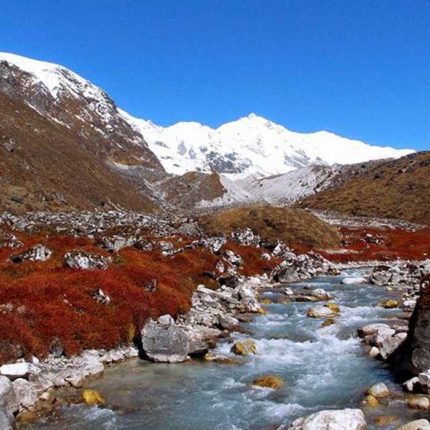
Goechala Trek
Exploring the North Eastern Himalayas feels totally different.
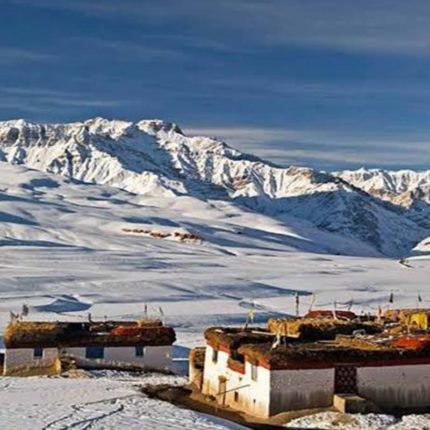
Parang La Trek
Parang La Pass the famous Trekking routes In Ladakh
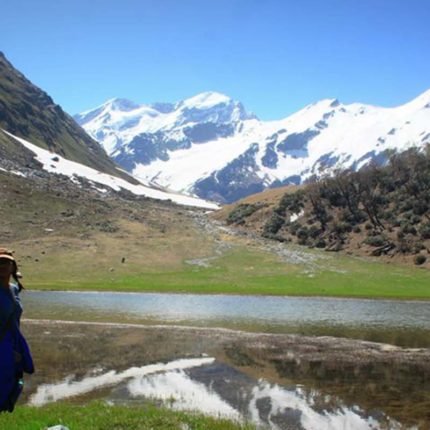
Ruinsara Tal – Har Ki Dun Trek
Harkidun – Ruinsara tal Trek is one of the best trek in Himalayas
Price: ₹ 7,500.00
Book the tour
Send a quick enquiry.
- Overview Itinerary Dates Include/Exclude
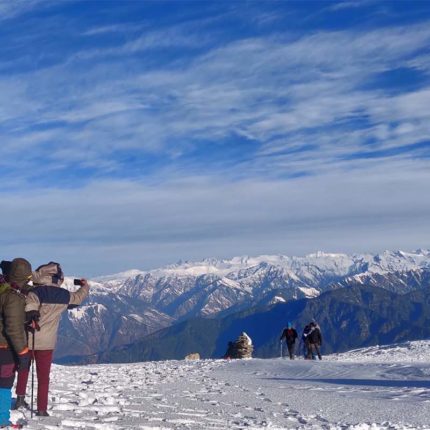

Home » Shop » Kedarkantha Trek
- getting there
- DETAILED ITINERARY
- cost inclusions
- CANCELLATIONS
- Submit to know our Kedarkantha trek details
- 1 Week trek
- 2-4 Days short trek
- Easy Grade Treks in Himalayas
- Easy Snow Treks
- Family friendly
- Garhwal Treks
- Spring Treks
- Summer Treks
- Uttarakhand
- Winter Treks
Kedarkantha Trek – Nov’23 to March’24
Updates for kedarkantha trek:.
- Upcoming group departure for Kedarkantha trek (Nov to March) from Dehradun. Snow usually starts depositing on trail from the later half of November and remains till late March to early April.
- Private/customised tours to Kedarkantha for your own group/family is open as per your preferred date. TREK FEE will be same for a group of 8 to 9 persons i.e. ₹ 9950 + 5% GST per person (Sankri to Sankri) and will be proportianately lower for 10 persons or more in a private/customised tour.
Below is your Complete Guide to Kedarkantha trekking tour 2024 and will help you to navigate through this detailed page information. Click a link to jump to a specific part of information.
Introduction Itinerary Altitude and distance graph Campsites Temperature & clothing How to reach the trek base Snow during spring Snow conditions during 2019-20 season
About the trek:
Probably you have searched for a winter or snow trekking trail in India and landed on our Kedarkantha trek details page. It is indeed the most popular winter trekking destination in India. Kedarkantha peak (Latitude 31.02257° N & Longitude 78.17185° E) is a low altitude mountain peak at ~3810 m/12500 ft. The peak and trail are on the fringe of Govind National Park, Uttarakhand.
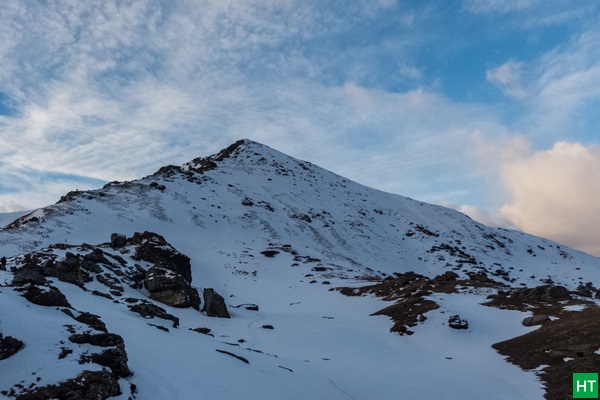
The region marks the boundary with its neighbouring state Himachal Pradesh and situated in western flank of Uttarkashi district. Naturally the area is surrounded by Shivalik hills and approaching to high Himalayan snow peaks. From summit you can see a 360° panorama, very special during sunrise. Peaks like Swargarohini, Bandarpunch, Black Peak create the backdrop.

Winter and Spring add snow and blooming of flowers, a nearly ideal experience for your Himalayan hiking destination. Surrounding Tons river valley, dotted with remote villages, snow capped mountain ranges in the horizon, and rich flora and fauna of the national park makes the short and easy hike to the Kedarkantha peak an enjoyable hiking experience. In winter or spring, the trail remains covered with fresh snow. Snow patches amidst giant pine forest and snow covered meadow in this altitude, even late till spring, makes this trek a special one. Campsites in winter are mostly on or around snow. In spring during March and April another added bonus is the blooming of Rhododendrons. Temperatures are warmer than the harsh winter days but residual snow remains intact on higher altitude, specially on top and even till base camp.
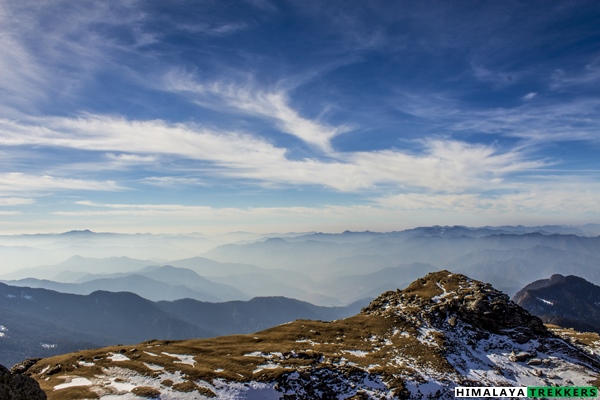
Winter summit to the Kedarkantha peak is indeed special. You will remember the summit push while breaking the dawn for long in your memory. Pictures can give you some feel, but not all 🙂
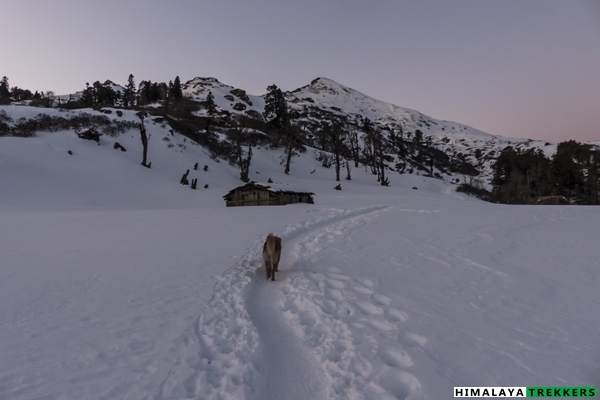
We believe that our HT support team can give you one of the most memorable experience of your lifetime. This is how you feel on the trek wit HT:
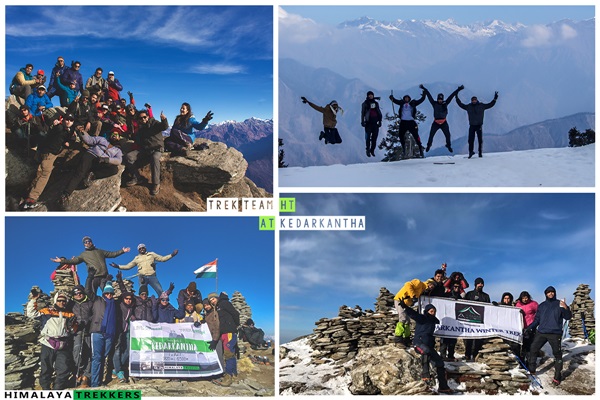
Kedarkantha trek brief itinerary:
Day 1: Drive from Dehradun to Sankri (~1930 m/6360 ft) – 200 Km – 9 to 10 hrs. Lodge or a guest house accommodation on a triple sharing basis. Day 2: Trek to the campsite near to Juda Tal (~ 2800 m/9185 ft) – 5 Km- 4/5 hours. Twin sharing tent. Day 3: Trek to Kedarkantha base (~ 3440 m/11285 ft) – 5 Km – 3 hours. Twin sharing tent. Day 4: Trek to Kedarkantha Peak (~ 3800 m/12465 ft) – approx 2 to 3 hours climb – spend some time at the summit and back to Kedarkantha base – total 7 Km – 6/7 hours. Twin sharing tent. Day 5: Trek to Sankri — 8 Km – 4/5 hours. Lodge or a guest house accommodation on a triple sharing basis. Day 6: Drive from Sankri to Dehradun – 200 Km – 8/9 hours
Important note:
- You need to reach on your own to Dehradun on Day 1 morning (latest by 7 am) or the previous night. Return to Dehradun on Day 6 evening (by 7 pm) . Arrange your tickets for inward journey and return from Dehradun accordingly. We will arrange transport to reach Sankri and return but are NOT included in the TREK FEE .
- Last ATM is at Mori, 25 Km before Sankri but don’t depend till you reach here. Withdraw cash well in advance either in Dehradun, Naugaon or Purola.
- Only BSNL and Jio network may work at trek base Sankri, that too with limited connections. Make a phone call back to home from Mori while reaching Sankri. After Sankri there is no presence of network.
Altitude & Distance Profile Graph for Kedarkantha TREK:
Here you will get a pictorial idea, before going to some facts and details.
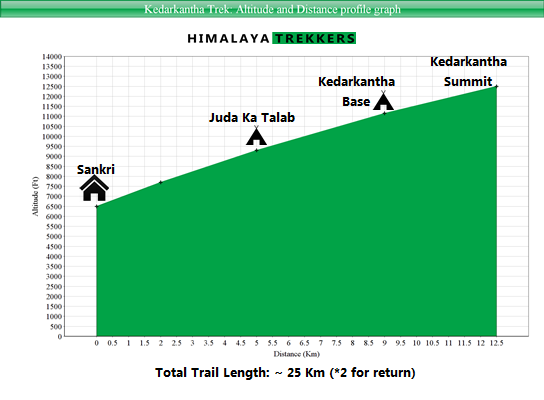
Campsites during winter Kedarkantha trek:
In winter Juda Ta Talab starts freezing around mid December and by month end the area receives moderate amount of snow (around 6 inch up to a feet). Surrounding conifer jungle set up creates the perfect back drop and a sudden snowfall can turn this site powdery and surreal :-). Snow remains as late as mid of March in this campsite.
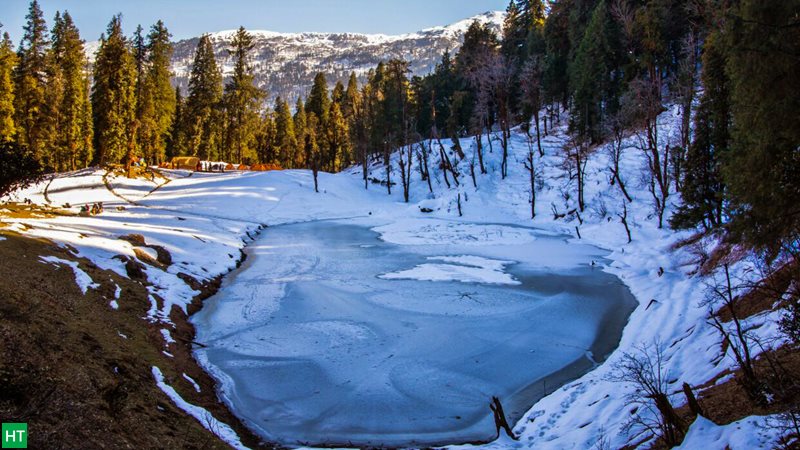
Temperature range during Kedarkantha trek:
Winter (Dec to Feb) temperature: From December to February during winter the daytime temp remains cool and nights are cold. Night/early morning temperatures (when it usually reaches minimum) will be approximately as following
Sankri: 2°C to 0°C Juda Tal: -2°C to -5°C Kedarkantha base: -5°C to -10° C.
Note that the temperature will be around 6° to 8°C warmer at a given place inside the tent, and still, the temperature inside the tent can be freezing. Keep adequate warm layers with you.
Spring (Mar-Apr) & Autumn (Oct-Nov) temperature: Day time weather remains pleasant and nights are cooler.
Night/early morning temperatures at camp sites can be from 8-10°C (lower camps/Juda Tal) to 0-2°C (higher camps/Kedarkantha base)
What type of clothing should I bring for this trek?
It is important to carry proper clothing on this trek. Three layers of clothing are recommended at the campsite in the early morning or evening while you are outside your tent.
- Base layer (moisture-wicking layer; use synthetic and avoid cotton): A quick-dry base layer (dry-fit t-shirt, half or full sleeves) & trekking pants (synthetic, preferably quick-dry, and some wind- or water-proof material is useful)
- Mid layer (warm clothing): Usually a warm jacket (synthetic, hollow fibre, fleece, or down jacket, etc.), but you may use combinations of layers as well (e.g., a light jacket + hoodies + a sweater or a thermal, which you may already have with you).
- Outer layer (weatherproofing): a windproof and waterproof jacket with a hood is best, or a poncho or raincoat.
Note that we don’t have any gear renting facilities, although at some bases, you may get a few on the spot. You may read our opinion on whether should you buy or rent your trekking gear to get a broader understanding.
Check a comprehensive List of things to carry in a himalayan trek or download the PDF. Also read how to choose right trekking gear before purchasing any gear.
Access to trek base Sankri:
We may arrange a pickup from Dehradun to Sankri and return. This will be on a cost to cost basis and shared by the availing team members. You pay directly to the driver, sharing equally. The fare is ₹ 6000 for a Tata Sumo, one way and can accommodate 5 to 6 people. Whereas a Tempo Traveller charges ₹ 900 (10 to 12 seats) one way. Approximately, ₹ 2000 per person when you avail both ways. This cost is not included in the TREK FEE.
Or else you may reach Sankri independently and join us here. Here is a road map with major points en route to Sankri.
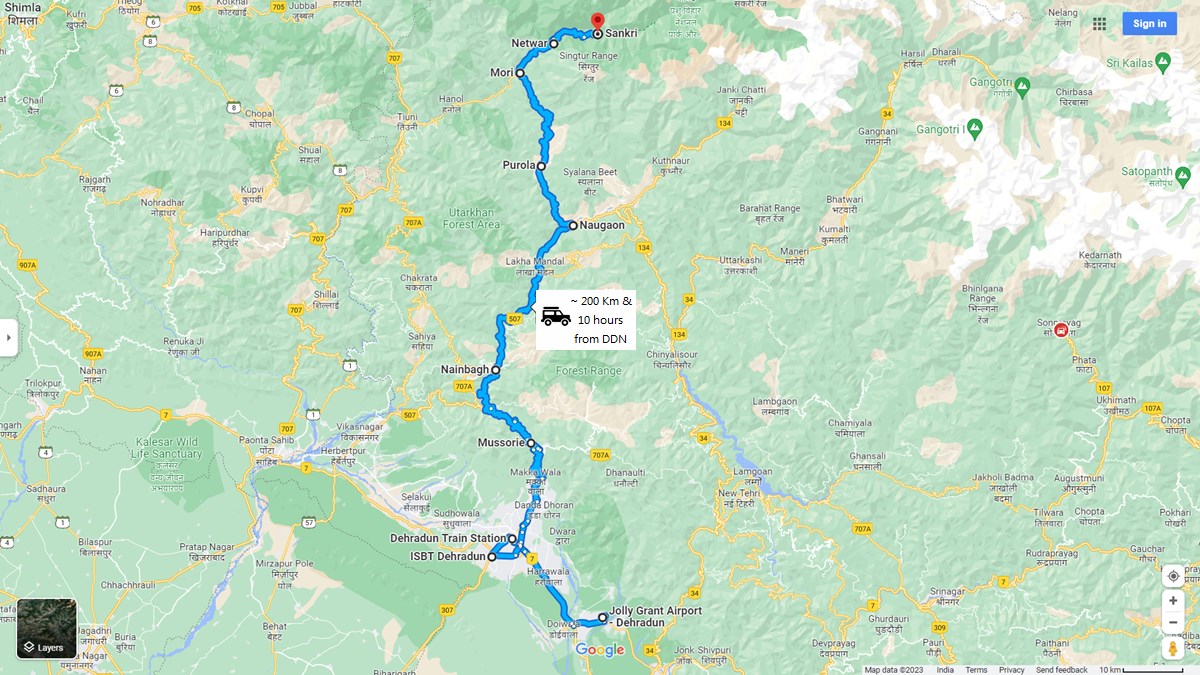
Do we get snow in Kedarkantha trek during spring (March/April)?
Being in Uttarkashi district and due to proximity with the Himachal border, Kedarkantha trail normally receives moderate to heavy snowfall from December to February. Quite naturally winter snow deposition remains as late as April. Also a fresh snowfall in not rare even in spring on altitude around ~ 3000 m/10000 ft or above. In general you will get patches of snow in and around Juda Tal campsite. As you climb higher, you will encounter more snow. From Kedarkantha base to the summit, normally the trail will be covered with moderate snow (around 6 inches). Another advantage of Kedarkantha spring trek is that the temperature will be warmer comparing to winter months and more conducive to trekkers who don’t feel like getting into subzero temperature throughout. Plus blooming of Rhododendron in the stretch between Sankri to Juda Ka Talao is definitely a bonus in spring :-).
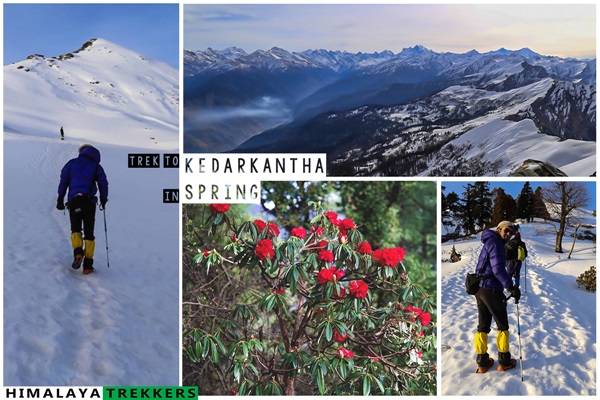
Past snow updates for Winter-Spring:
Check here for latest update from Kedarkantha trail along with fresh photos during early December 2019. You will have an understanding of current snow condition and forecast for the season. You should get moderate snow in mid to late December . Heavy snow from December end to January end is expected this time. February is normally not conducive for this trek due to harshest winter conditions with heavy deposited snow. March and April, i.e. spring season is ideal for snow spring trek, when weather starts getting warmer.
As of beginning of March, 2019, Kedarkantha peak may have accumulated “4 foot snow barrier “. February is always been the harshest month on mountains, cold and snowy. This winter promised good snow by mid December. Till mid Jan 2019 we got expected snow of 1 to 2 Ft varying from Juda Tal to the Kedarkantha peak. Then came the snow storm which poured more than 2 Ft snow at Sankri in itself. Summit to Kedarkantha peak was a mini expedition (just joking) mostly in February. Groups trekked to Juda Tal, camped there , hiked around and returned frequently. Occasional small sized groups reached the summit.
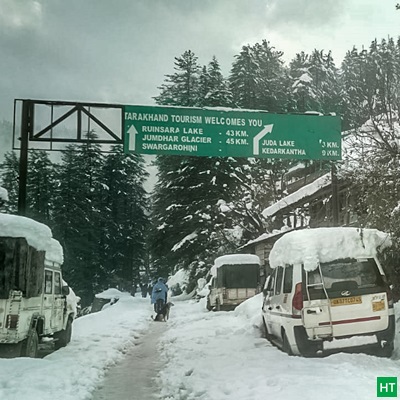
As the spring approaches, our spring trek groups are starting from 10th March, 2019. It is needless to say that Kedarkantha trail will remain covered with moderate to heavy snow in March and could very possibly till end of April 2019. Till mid of March it will be challenging to reach the summit, but will ease out if there is no further significant snowfall.
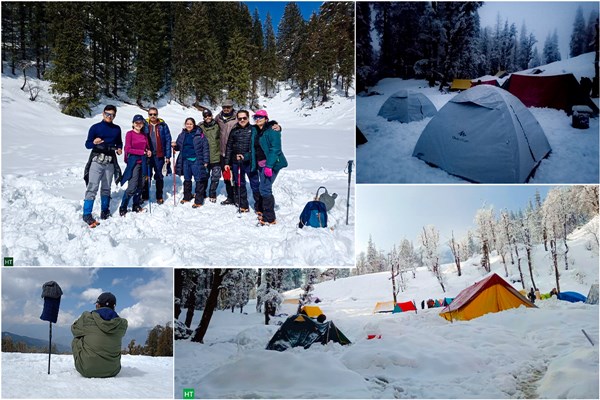
Finally Kedarkantha summit opened again on 18th March’19, as the first team after a long break reached the summit of Kedarkantha. Entire February and till mid of March snow was just too much to deal with and no team was able to reach summit. These are the pictures of our team who summit Kedarkantha on 24th March’19. This year snow will remain on summit till May beginning for sure.

Why treks with HT?
Duration: 4 days of trekking; Walking from Sankri to Kedarkantha summit and back to Sankri. 6 days from Dehradun to Dehradun.
Prerequisite: No prior trekking experience is required. Good physical fitness is always desired in any trek.
Grade: Easy
Physicality: 5.5/10
Trail Length: 25 Km
Highest Point: Kedarkantha peak ~ 3820 m/12500 ft
Seasons: March/April (Spring/Snow), October/November (Post Monsoon/Fall), & December to February (Winter/Snow)
Further Option: Har Ki Dun trek can be combined.
Access: Trek starting point (trek base) is Sankri, 200 Km from Dehradun.
Rail station: Dehradun (Station Code: DDN)
Airport: Delhi, Jolly Grant in Dehradun (Airport Code: DED)
Upcoming scheduled dates for Kedarkantha trek:
- You can check the scheduled Fixed Departure dates in the calendar available inside Booking Form or inside REGISTER NOW form. Tour starting Dates are highlighted as per our itinerary ( Day 1 of 6 days itinerary ).
- At present BOOK NOW functionality is disabled . You can get all the information in your email by submitting the REGISTER NOW form.
- If you are a group of people and available dates are not matching then you may select Custom date mode (by clicking the Select your custom date) and fill in the displayed form.
- You can also check all the available dates at a glance in our TREK CALENDAR .
- Trekkers need to reach Dehradun on Day 1 morning (latest by 8 am) or the previous night. Return to Dehradun on Day 6 evening (around 7 pm). Arrange your tickets for inward journey and return accordingly.
How to reach Sankri (The trek base):
Nearest Rail station: Dehradun (Station Code: DDN)
Nearest Airport: Delhi, Jolly Grant in Dehradun (Airport Code: DED)
Based upon your request we will arrange a pick up and drop from Dehradun to Sankri and back. This will be shared equally by the team members on actual basis. You pay directly to the driver/transporter. The fare is Rs 5500 for a Tata Sumo/Mahindra Maxx one way. This can accommodate 6 to 8 people. A Tempo Traveller charges Rs 9000 (12-14 seat) one way. This is NOT included in TREK FEE and to be paid directly to the driver/owner.
If you wish to reach our Trek Base Sankri on your own by public transportation:
- There are 2/3 privately operated buses from Dehradun (near DDN railway station on Gandhi road) To Sankri. The 200 Km journey will take around 10/12 hours. The busses start at 5:30/6/7 am.
- While returning from Sankri take the morning bus to Dehradun/Vikasnagar and reach by 7 pm.
How to reach Dehradun:
For the treks at Uttarkashi district in Garhwal , one has to reach the capital city of Uttarakhand, Dehradun, specially the trek starting from Sankri, Yamunotri etc. Haridwar, Rishikesh and Dehradun are 3 nearby cities in the area and one can move from one to another by public vehicles like bus or shared Jeeps.
For more options to reach Haridwar you can check here .
Haridwar to Dehradun: 55 Km and may take one and half to 2 hours.
Dehradun to Rishikesh: 45 Km and may take around one and a half hour.
You can fly or by train reach New Delhi as per your convenience from any part within India.
There are direct trains from Kolkata to Dehradun.
KUMBHA EXPRESS – Train No. – 12369 ( Very good option to reach Haridwar by 5 pm; You can take a bus from the terminus just opposite to the railway station referred as Roadways bus stand/ISBT and reach Dehradun in one and half hour. Spend the night in Dehradun and start your onward journey by car next morning.)
UPASANA EXPRESS – Train No. – 12327 ( Very good option to reach Dehradun directly by 5 pm; Spend the night in Haridwar and start your onward journey by car next morning)
DOON EXPRESS – Train No. – 13009 ( Don’t book this train when you plan a long onward journey immediately in the morning)]
Avoid booking wait listed (WL) tickets in AC classes (1A/2A/3A) or Chair Car (CC). Book Sleeper class (SL)/Second Sitting class (2S) tickets which have normally more seats/berths and hence much better chance to get confirmed.
You can reach Dehradun easily from New Delhi by train or bus (~ 6/7 hours) and is around 260 Km.
Following trains are good to reach Haridwar and run daily.
DDN JANSHTBDI – Train No. 12055 (Arrives DDN in the evening @ 9:10 pm, good choice when you stay the night in Dehradun and have a long drive ahead next day) NANDA DEVI EXP – Train No. 12205 (arrives DDN early morning @ 5:40 am)
Always avoid booking waitlisted (WL) tickets in AC classes (1A/2A/3A) or Chair Car (CC). Book Sleeper class (SL)/Second Sitting class (2S) tickets which have normally more seats/berth and hence much better chance to get confirmed.
Govt. Road Transport (Roadways of Uttarakhand, Uttar Pradesh, Delhi, Haryana, Punjab etc.) buses are frequently available in day time and night from Kashmiri Gate ISBT ( http://www.delhi.gov.in/wps/wcm/connect/doit_transport/Transport/Home/ISBT/Fare+Chart ). Tickets are available on board for these regular type buses. From Delhi Airport or Station you can reach ISBT Kashmiri Gate via Delhi Metro service ( http://www.delhimetrorail.com/metro-fares.aspx ). It is only 4 Km from NDLS and can be reached easily by booking an auto rickshaw.
For privately operated bus, you can book online from different portals. Select a boarding point suitably. Overnight Volvo/A.C/Push back buses are available. Normally these buses take up to 7 hours to reach Dehradun ISBT. You can book an auto rickshaw for Railway Station (5 Km away)/Hotel Drona (GMVN) or take a shared auto (Route No. 5) from ISBT.
[There are two major bus terminus in Dehradun. The buses from Delhi/Haridwar goes to the ISBT (Inter State Bus Terminus) and the other one is the Parvatiya Depot (Hill Depot, from where you can get the buses going up the hills like Uttarkashi, Barkot, Purola etc) located just beside the Railway station.
Nearest Airport Jolly Grant is 25 Km away from Dehradun. book a private taxi to reach Dehradun city. This airport is accessed from Dehradun, Haridwar and Rishikesh easily. The flights are mostly via Delhi.
For night stay in Dehradun:
Trekkers reaching on the previous day before the journey to the actual trek base need to stay the night in Dehradun. There are several options in Dehradun for spending a night while staying in Premium, Standard or Budget accommodation. Options vary from Privately operated Hotels/Lodges, to state run Tourist Rest Houses.
State run GMVN (Garhwal Mandal Vikas Nigam) operates Hotel Drona complex is 10 minutes walking from the railway Station. You can book an auto rickshaw. From ISBT it is around 5 Km. You can book an auto rickshaw to Hotel Drona (GMVN) or take a shared auto (Route No. 5) from ISBT (Inter State Bus Terminus). This is a reliable and a decent choice for Standard accommodation. The have restaurant and room service. Check the following for online booking of the above: http://www.gmvnl.com/newgmvn/tour/booktrh.asp You can call or visit GMVN nearest office or even send an email for more information.The information is available at: http://www.gmvnl.com/newgmvn/online_reservation/#
Return from Dehradun:
Normally you reach Dehradun from any trek base by 6/7 pm in the evening. You can take any train after 9 pm or regular bus service as mentioned above to reach Delhi or directly to your homeward journey in the same night.
Drive from Dehradun to Sankri – 200 km – 10 hours
Today morning we start our trip from Dehradun. 200 Km long drive takes at least 10 hours to reach Sankri, our trek base. It’s advisable to start latest by 7 am in the morning.
Initially after crossing Mussoorie town the road enters the Yamuna valley and we continue along the river for a while. It gets better after crossing the town of Purola. The car goes up the winding road surrounded by blue pine forest. From Mori we follow the course of Tons river. You’ll enter Govind National Park after you cross Netwar and after Netwar you will be following the course of the river Supin. The road gets bumpy at times but you won’t feel much because of the astounding beauty of the surroundings. On your way you will experience dense conifer forest, scattered apple orchids, farming fields and open valleys in between.
Sankri may appear comparatively busy in a trekking season than the villages you may have visited interior in the Himalayas. But if you look carefully, you’ll find that most of the people around you are either trekkers or the local support staff.
We will arrange your accommodation in a home stay at Saur village or in a lodge at Sankri. This will be on sharing basis and on the basecamp always expect a dormitory style room. Saur is actually bigger than Sankri and in the ‘Pahari’ essence too. It is just two minutes’ drive from Sankri. If the sky is clear and you reach Sankri/ Saur before sunset, you can’t miss the vibrant orange and purple hue on beautiful snowcapped ranges of Mt. Swargarohini from here. Over a hot cup of tea, you’ll be discussing the trail with our coordinator/trek guide keeping that beautiful painting into the backdrop.
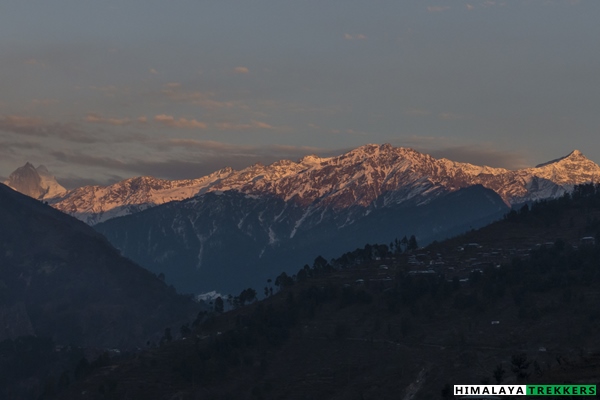
Trek to Juda Tal - 5 Km - 4/5 hours
Today morning after breakfast we start our trek to Juda Tal also referred Juda Ka Talao. Initially we follow the road which connects Sankri to Taluka for about five minutes. Then we leave the motor able road and turn right to take the trail which leads to Kedarkantha.
The climb for today is throughout of moderate gradient and can be tiring at stretches. The trail starts gaining height among sparse conifers at the beginning.
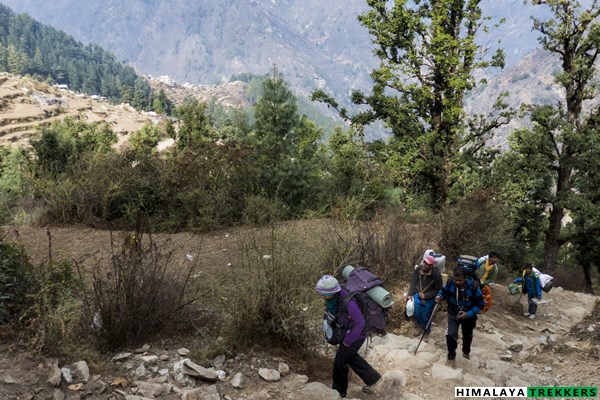
After following the trail for about an hour on the mountain slope, you will find a cement bridge lying on a small stream. The foot trail splits into two and we take the left one. The tree line clearly starts to change by then. You’ll see more Maple and Oak trees in the forest. After ascending for another hour or so you’ll cross a huge fallen trunk to reach a glade inside the forest. Surprisingly a single walnut tree stands tall in the middle. We take a well-deserved rest here. After all we completed halfway to the Juda Ka Talao.

Continue climbing after taking a good rest at the “Fallen Trunk” meadow. Before reaching the last meadow of the day we cross another meadow in between. Both of the meadows share surprisingly same characteristics. Both are covered with lush green carpet of soft grass. If you have any time or energy left, allow yourself to walk a few steps barefoot on it. But certainly not at all if it’s cold and snow covered. These are the small pleasures of life what we city dwellers miss back at home. Both the meadows have shepherd huts nearby. Hop inside. Imagine spending a lonely night there sharpening your knife, cooking your own food on a wooden fire and praying all night long that bear doesn’t attack your sheep as does the shepherd. Not really that lonely, huh? Well, you can imagine as many sheep as you want with you!
However, let us take a break from our imagination and let us get back to the trek. We turn right from the last meadow and climb for 15-20 minutes more and we’ll reach our campsite for the day. The total distance is hardly 5 Km but it may take up to 5 hours!
Judatal is a really pretty campsite. Imagine an undulated wavy meadow amidst a dense Maple-Oak forest and at the left corner of the clearing there’s a small lake which remains frozen in most of the winter. So, what do you think? Pretty enough?
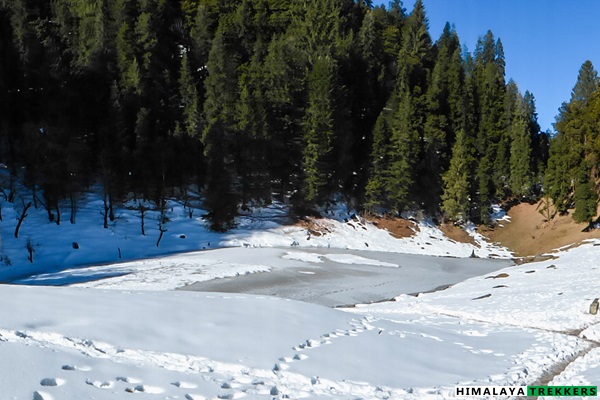
There are quite a few stories about Juda Ka Talao. Locals say that this small lake is somehow channelled with a well of Saur villages. Long time ago, a small shepherd boy got drowned in the lake. That little boy loved to play his flute. He carried his flute everywhere he would go. Almost after a week of the tragedy, the flute was discovered from that well in the Saur village. True or not? You be the judge.
Today we trekked only about 5 km but remember that we have climbed three mountains and gained considerable altitude. Today’s trek was not that easy as it appears. After an early dinner we call it a night and get into the cosy comfort of the sleeping bag inside tent.
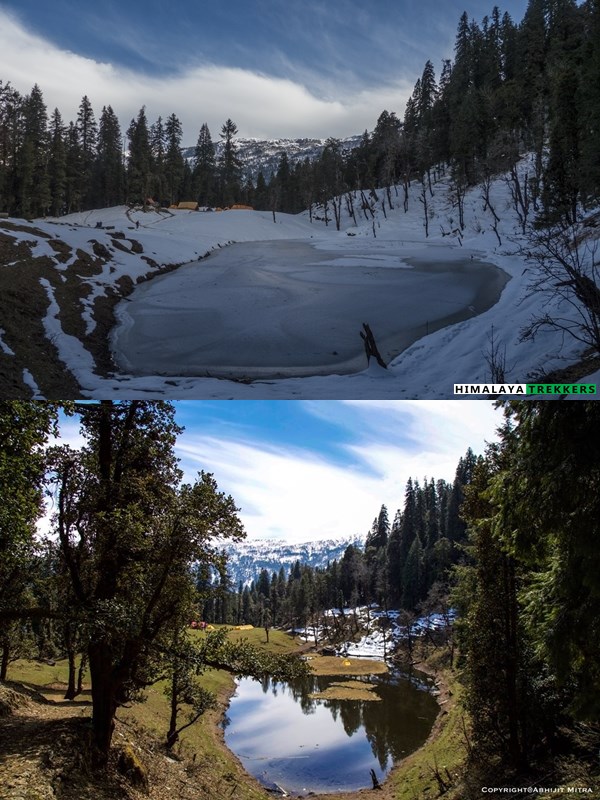
Trek from Juda Ka Talab to Kedarkantha base – 4 km – 3 hours
The trail towards Kedarkantha base is clearly defined across Juda Ka Talab campsite. After about 5-10 minutes of climb we reach a vantage point on the slope from where you get a full view of the pristine lake and the grassy meadow. Take out your camera for sure! Climb further and you’ll see the trail going straight forward keeping the ridge to your left. Don’t take that trail but wait for your guide here. That route will take you straight to another campsite called Hargaon. You are supposed to climb the ridge to your left. The trail goes inside the Oak, Conifers and Maple. In winter the snowline would have begun by this point.
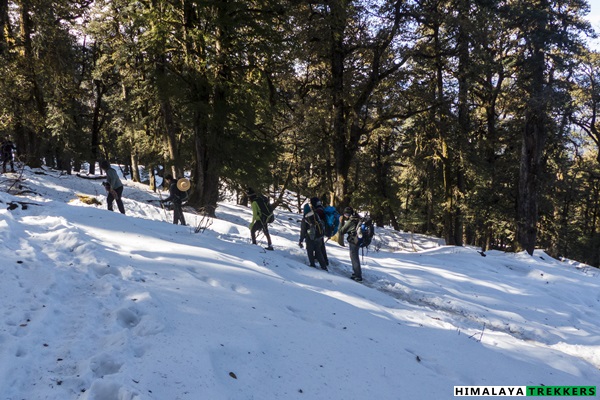
Can you see the triangle shaped peak right above the tree line peeping ahead? Yes, that is Kedarkantha 🙂

Continue about an hour of steep climb we reach a spot where stands a solitary shepherd hut. The ascent gets gentler after this point and we’ll reach today’s destination after maximum one more hour of trekking. Spend few minutes here, enjoy the surroundings.
As said before, after walking another hour you’ll see a vast opening with few desolated shepherd huts. A thrilling view of a 180 degree arc of majestic snow capped Himalayan ranges with significant peaks like Bandarpunch, Swargarohini, Kalanag and Ranglana can be seen from here. Yes, cheer up, we have reached today’s camp site. Now don’t get too carried away with the view. Look left to the arc. You are supposed to start before the break of the dawn next day to reach the top on or before sunrise! We serve the dinner early in the evening, as the last scattered light remains on the horizon.
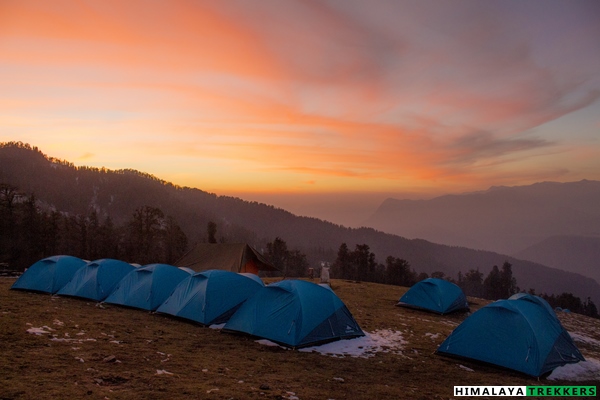
Get into the tent and pack your light day pack, if you have one. Otherwise keep at least a bottle of water and some dry food/chocolates with you during summit. Tomorrow expect tea to be served by 3 am in the morning.
Trek to Kedarkantha top and back to base: 8 Km - 7/8 hours
Today we start as it has been planned. In December/January it will be pretty cold at the onset of the dawn. Wear warm jacket and certainly a windproof on top. A pair of gloves is a must, if not a waterproof one. Take out your torch, a headlamp is always better as it keeps your hands free.

The first hour of the hike takes you through dense Oak/Kharsu forest but as you climb further the forest recedes. You may come across something quite interesting to attract your attention during the initial walk. You may spot pug marks on snow larger than human. Ha-ha, you haven’t discovered “Big foot” or “Yeti” pug marks but probably of the Himalayan Black Bear. And yes, Govind National Park has quite a number of Himalayan Black Bears in its wild life chart. But unlike their pug marks you have to be really lucky to spot one.
However, after almost an hour of gentle climb you’ll reach a clearing with a shepherd hut from where there are mainly two trails on the way to the top. Depending on the conditions, especially on snow in winters most of the hiking teams take the left one while climbing and descending the other way.
From here the trail gets steep. After climbing for another half an hour or so, you’ll find yourself above the tree line. The structure of the shrine at the top is clearly visible from here. Usually dawn starts to break by this time. After this point we climb the steep ridge to the top. Follow your guide and his footsteps as he takes you to the top through the switchbacks.
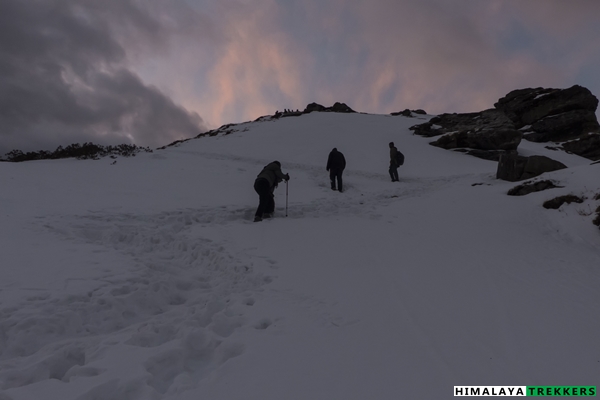
The trail can be slushy and icy at stretches in the morning. We will provide you a pair of Anti Slip Grip/Crampon that help you get a better hold. After hiking another half an hour that way you’ll find yourself right in front of the shrine. Don’t stop there. Take left and climb for five more minutes and you reach the top. Yes, it’s a summit, essentially every peak has one.
Majestic 360 degree view of the Himalayas waits at the summit. In the southerly direction you can see the wide valleys sloping down. A number of high peaks in Gangotri and Yamunotri ranges can be seen towards the north. Your guide will help you to spot the Swargarohini range, Mt. Kalanag/Black peak, Hati parvat, Ranglana and more. Snow capped ranges of Kinnaur forms the backdrop in west. Savour the summit to your heart’s content and head back towards base camp.
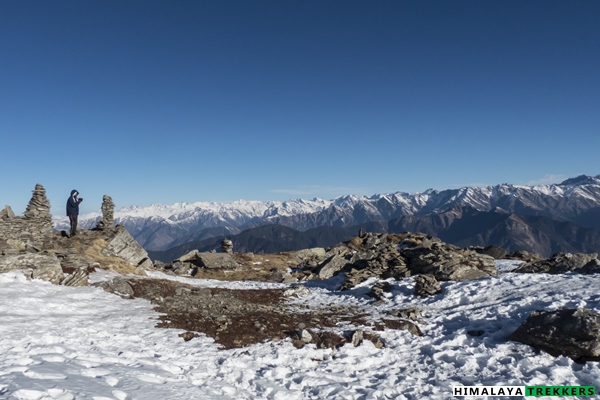
While going down we may take the alternative route. In winter this trail is fully covered with soft snow and be careful while descending. Use your heel to get a better grip. At times a glissading can be the icing on the cake.
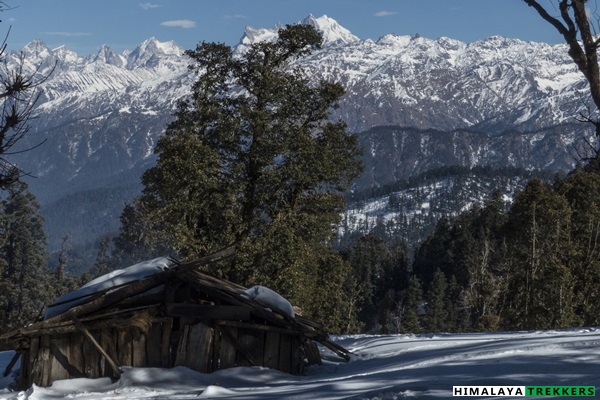
It will take around 2 hours to get to the base camp from summit. Have your hot lunch and enjoy the well earned rest after the tiring summit :-). We camp overnight at Kedarkantha base.
Trek to Sankri via Hargaon: 8 Km - 4/5 hours
Today is the last day of our trekking and it’s all the way down to Sankri. There’s no hurry and we’ll enjoy the morning and then start going down to Sankri.
For the first half an hour we retrace our steps to the Shepherd hut where we took a good rest while reaching the base camp. From here we take a different route through dense Maple-Oak forest to the opening of Hargaon campsite. From the clearing the entire Har Ki Dun river valley is distinctly visible dotted with villages on both the sides of the carving Har Ki Dun nallah.
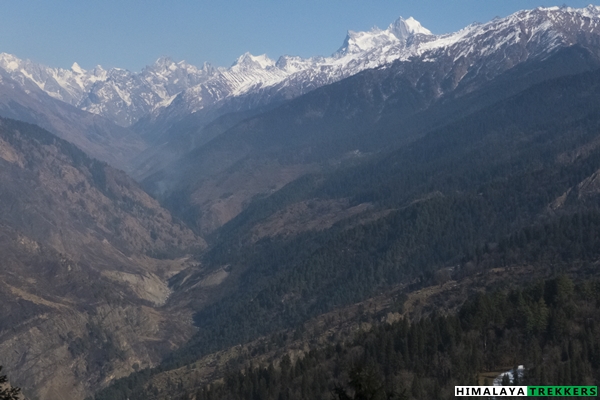
Another hour of hike will take you to the cement bridge which we crossed on the first day of our trekking. Saur is not far from here. It takes maximum one hour to reach the Saur village from here and another 5 minutes to Sankri. If you have any more energy left, explore around the Saur village or just stroll around Sankri bazaar. Accommodation will be in lodge/home stay.
Drive to Dehradun: 200 Km - 10 hours
If you start by 6:30-7 am in the morning, expect to reach Dehradun by 6 pm latest. The trip ends here, but not the memories!
P.S.: Distances and altitudes are approximate and may not be exact.
TREK FEE: ₹ 9,950 + 5% GST per person, Sankri to Sankri
- The above cost is applicable for Fixed Group Departure treks . If such dates are published for this trek, then you can see the Green coloured dates inside the calendar available in the Booking Enquiry Form on the trek details page or in the Upcoming Treks Calendar .
- If you have your own group or would like to have your own private tour, then you may customise this trek for your team only and as per your preferred dates. A customised trek’s cost depends on the number of persons and the inclusions. TREK FEE will be the same as mentioned here if you are a group of 8 to 9 people with the same inclusions and exclusions as mentioned below (i.e., the Fixed departures). The cost will increase if the number of persons decreases, and it will decrease if the number of persons increases.
- To book a trek, first you need to submit the Booking Enquiry Form on the trek details page so that we can send you all the relevant details by email and call you to discuss. You will get the package as well as preparation details and payment instructions. Choose from the radio button for a Scheduled date (i.e., a group departure, if available) or your Custom date.
Inclusions:
2 night’s accommodation at Sankri (Day 1 & Day 5) in a lodge/guest house on a triple sharing basis and dinner. We will provide separate room(s) for male and female member(s) for the group departure treks.
All meals during the trek. Regular Indian style nutritious vegetarian food during the trek (including occasional eggs), breakfast packed/hot lunch (depending upon the time you reach a campsite), light evening refreshment, and dinner. Tea is served during breakfast and the evening.
Excellent Trekking Guide , who will be a local to this particular area and has profound knowledge of the trekking trails around.
Specialised Cook, Support staff, Porters/Packed Animals for carrying the central logistics of the trek.
Twin sharing tent during the trek. We will provide separate tent(s) for male and female member(s) in the group departure treks.
Camping equipment/gears like Sleeping bag, Carry mattress, Gaiters, Micro spikes/Crampon. (If you have a high altitude specific personal Sleeping Bag use it for better hygiene). You need to bring a personal rucksack, trekking shoes and suitable clothing for the trek.
Kitchen tent, dining tent and toilet tent (with a toilet seat) as required during the trek.
All permit fee, camping charges, forest levy required for the trek.
Basic Medical & First Aid kit. Always bring your personal medicines kit.
Travel insurance cum Accidental Insurance Policy covering high altitude trekking tours (For Indian nationals it is included in the TREK FEE, up to 60 years of age). It covers your trek as well as Dehradun to Dehradun, for a duration of 7 days.
Exclusions:
Transportation from Dehradun to Sankri and back (₹ 6,000 for Tata Sumo/Bolero and ₹ 9,000 for a Tempo Traveller. Approximately ₹ 1000 per person one way for the pick up or drop when shared with fellow trekkers). One way bus ride is ~ ₹ 600.
We assume that you will carry your personal Rucksack/Backpack with all your personal belongings. If you want to offload your Rucksack and be carried by thorse then you need to pay an additional ₹ 1200 for the entire duration of the trek. The Rucksack should not weigh more than 10 Kg. Always carry your personal daypack in case you opted for rucksack offloading.
Any tip/gratuity to the HT support staff.
Anything that is NOT mentioned in the “Inclusions” or personal in nature.
- We assume that you have read and understood our “Terms & Conditions” ( https://himalayatrekker.com/terms-and-conditions ) before Booking a trek/tour.
- To reserve your place in a scheduled Fixed Departure trek or a Customised/Private trek pay 25% of the TREK/TOUR FEE as the initial “Booking Deposit” . You can pay by Net banking/Draft/Cheque/Credit/Debit/AMEX cards. This will ensure your participation in the desired trek and we will reserve your place in the scheduled date. You need to pay the remaining amount at least 15 days before Trek Starting Date .
- If you book a Trek/Tour before 14 days or less from Trek/Tour Starting Date, you need to pay the full TREK/TOUR FEE .
Cancellations:
- “Booking Amount” i.e. 25% of the TREK/TOUR FEE is Non-Refundable at any stage.
- If in case you are not able to make it due to unavoidable reason(s), we provide you a very flexible choice of Shifting to another trek within next one year . One year is counted from the starting date of the trek/tour you booked initially with us.
- In case you postpone your trip you need to inform minimum of 15 days before the trek/tour starting date. (Though we suggest to inform us earlier if known)
- In case you postpone a trek/tour before 15 days of the scheduled Trek/Tour Starting date or prior , you may shift to another group of the same trek/tour scheduled in the same season or within next one year. You may shift to another suitable route also. For changing any, you need our approval first. Your request must be in written communication through your registered email with us.
- If you cancel/postpone a trek/tour from 14 days to 8 days before tour starting date , your Booking Amount is Non-Refundable. We will not take any request of shifting dates. We will charge 50% of the amount as Cancellation Charges and process refund of remaining 50%. You may also shift to another group within next year but 25% Booking Amount will be deemed as Cancellation Charge and the rest amount will be transferred to the shifted group.
- If you cancel a trek/tour 7 days (i.e. a week) before Trek/Tour Starting Date or later , there will be NO REFUND.
- In case of any unforeseen incident including but not limited to natural calamities like flood, earthquake, landslide, forest fire or any political unrest, if we are compelled to cancel the trek/trip, you will be entitled to redeem the full amount for the same/similar kind of trek/trip within next one year.
If you need more clarifications write in to [email protected]
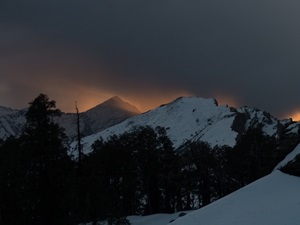
Tour Reviews
I did Kedarkantha Trek with HT in April 2022. This was the first time, I had enrolled with them. Overall my experience was superb. Right from home stay at Sankri till the summit completion, arrangements were an amazing. Everyday we were given hot and delicious mouth watering meals with deserts, which wasn’t expected at the heights of mountain s… On the Summit day, after a certain point, I thought of giving up the trek as it was tiring, however the trek guide (Arjun) and his team supported and motivated me a lot and due to which I was able achieve the summit!!! At the beginning and end of each phase of the trek, the trek lead gave us detailed briefing, which helped me understand how the day would be.. Every day, he took stretching sessions, so that we can achieve our goals. He also taught us how to setup the tent. I would definitely like to do more treks with HT in future !!!
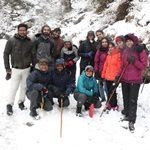
This was my first ever long trek and that too a winter one. I did not go with any expectations but I would say they have set their standards so high that you won’t be disappointed even if you had your expectations high. They are quite professional and provide good and foremost experienced guides which is quite essential for such types of treks and along with good food. These people take in small number of groups unlike the other trekking companies which is an added bonus as this makes sure that you will be well taken care of. We were a group of 9 people (15 os their limit) and we were provided with 2 guides which meant that even the slow trekkers like myself were very much part of the group and not left in between the long journeys. And the guides made sure that we competed our treks (all we needed was their help and support during the entire journey)
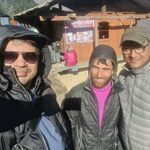
The whole trip was organised and Executed well. We all had a great time in the Mountains.. Just a request that the micro spikes should be made available in all sizes.. The spikes were of nearly same size, and some people faced issues as they were loose.
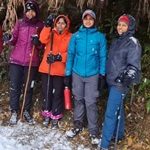
Hello Rhik, the trip was a very well organised one. Food was great, Prakash and Sonuj were perfect guides.Very good experience for us, thank you very much!I also want to thank the entire group for great company, warmth and friendliness! One suggestion from me is to provide better sleeping bag in Juda lake camp site as it wasn’t warm enough. Base camp sleeping bag was much better and quite warm.
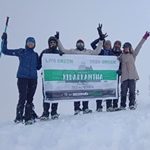
Thanks HT team.. special thanks to Prakash, Dev, Vijay n others. Food & Hospitality – as expected from HT.. Stay – great effort by HT team (day & night) to keep the tent intact in spite of the heavy snowfall. Trekking guidance – excellent work by Prakash, and helping us make it to summit even after losing a day. Emergency response – special thanks to Prakash to have taken care of the team whenever medical assistance was required. Overall, we are satisfied with our experience with HT again.
Snow snow everywhere!!!But all in all it was a wonderful trip..organised beautifully! Very thankful for the hot food provided by very warm HT folks up there at an altitude of 10k ft. Thanks HT for giving us this beautiful experience!
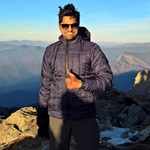
There’s always something special about doing something for the first time! My First Himalayan trek that was Kedarkantha were with Himalayan trekkers (HT), had one of the great experience all thanks to team HT, me along with 6 other people from Mumbai had the best of times there at Kedarkantha trek, its an summit trek which involves trekking 3 days upto 12500 feets in snow, pines forests and where temperature could get freezing at night, we did all quite comfortably, Sapta the founder of HT explains really well about the trek before at the time of inquiring and very helpful and understanding about the needs and situation, the guide along with local people ensured we are comfortable in the tricky times and were provided with best of guidance,food and help whenever needed,the ground staff are amazing, warm, knowledgeable and serves with the smile, i Strongly recommend everyone to choose Himalaya trekker and live those memorable moments in lap of nature.
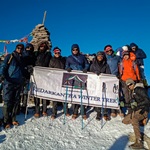
Kedarkantha trek – This was my first Himalayan trek and I was in two minds to go with Himalaya trekkers intially. Having understood the way the niche market they operate in, the restrictions on the group size, I gave it a shot, and the experience was nothing less than breathtaking!
The food, the facilities, and the support staff provided utmost care and support.
The local guide, Chandra Prakash, was best in class. Knows in and out about the trek and yet has been modest through out the trek. Trekking with Prakash has been more than an adventure trip. Being a local, he has connected to each member at a personal level. He kept engaging with the group telling us how the life in mountains is and how important it is to remain modest as any amount of experience would not help if the mountains intend to pull you down. He has simple anologies of connecting nature to the behavioural instincts, say, asking us to bend our heads down to the low height doors of the houses in the mountains and connecting it to the fact that mountains teach to bow the head down always, to avoid calamaties.
Apart from the great technical experience he’s got in guiding the members over a trek, he has rubbed off his charm over all of us, and has shown us an all new perspective of what it demands to be a human. His basic gestures to voluntarily offer a solo traveller one of his own crampon (spikes) and trekking with one crampon during the night enabled a young soul to reach the summit and watch the beautiful sunrise!
With Prakash and team, we never felt left alone. He always went the extra mile to take care about the safety of the members. He views the trek more as an opportunity to provide an unforgettable and a safe experience to the members than just mere business.
I’m glad I chose Himalaya Trekkers, and I sure am looking forward to do more treks with them! Thanks team. Best Regards, Hari
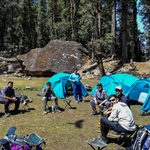
Great team at Himalaya trekkers for Kedarkantha trek. I have trekked with different groups but this is far the best trekking company. Small group size and details were taken care of. I would recommend Himalaya Trekkers and definitely trek again with them.
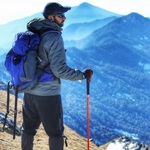
This was my first Himalaya trek and it was a really wonderful experience, the support staff during the trek was really very well trained, the food provided to us during the trek was like the food we get at home A-1 quality, and the best part which I experienced by choosing HT was the small group which was really continent. I’ll defiantly choose HT For my next winter trek 🙂 .
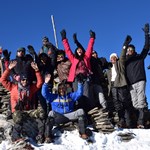
We went to Kedarkantha on DEC 16,2017 with you. We had an incredible experience which we’ll cherish it forever. Every thing was very well organised right from transportation, food, guide and accommodation. Our trek guide Mr.Chandra Prakash took care of us really well. We’re glad to have trekked with you.Hope to do many more treks with Himalaya Trekkers in the future.

We went on the Kedarkantha trek with Himalaya Trekkers in Dec,06 and experience was breathtaking, staff was friendly always ready to help in any way they can. Who could have imagined we would be eating such delicious foods at the height of 13000 ft. They made it possible. They offer you freedom and peace to enjoy nature as you like. So GO For It, and GO With HT 🙂
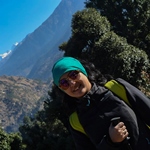
We went on the Kedarkantha trek with Himalaya Trekkers in December 2016 and we had a fabulous experience with the team. They specialize in small groups offering a very personalized experience, without compromising on the professional management aspect. The staff went out of their way to accommodate every request we made and always served with a smile. They were highly knowledgeable and experienced, and became our friends by the end of the trip. The best part of HT, as against many other “renowned” operators, is they offer you freedom and peace to enjoy nature as you like, without intruding on your personal space and bombarding you with unnecessary rules or regimen-like group activities. So if you are just looking to enjoy nature, listen to the silence of the mountains, or bond with the local smiling faces, HT is the best trekking partner for you..if you are looking for a college excursion party, look elsewhere…
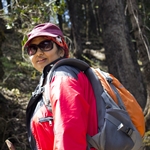
It really feels great when you go up a mountain, reach its summit, spend good one hour dazing the snow-capped peaks around, looking down upon the clouds and return with the tales of achievement. It is not just the four days of trekking amidst the pine trees or on the snow, but the entire phase of planning, preparation (both physical fitness and logistics). Would it not have been the guidance that I received regarding the choice of clothing, shoes, physical training schedule, right at the onset, completing the summit could be difficult. No, it was not just the walk, but knowing the place, people, their lifestyle, listening the tales of other trekkers, setting up a camp and sleeping in the blue tent under the starry sky. I will look forward for another trek with you guys, in some other magical destination.

I am very much happy with your service especially the hospitality and service … Amit was so informative and gelling up with us easily … Kind hearted person and will take care of people very nicely. Special thanks to Chandra Prakash, Rana for supporting Aunties to climb the peak and Thanks to Upendra for delicious timely food. Please avoid giving Bread and Jam for breakfast …. I feel it is dry and cant eat more …
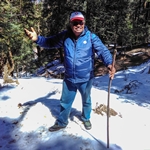
Excellent trek. Very co-operative and helpful staff. Very good guide. They were giving lot of things to eat. Cheerful and very much friendly – great place.
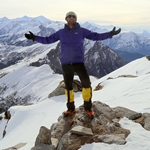
Firstly, I would like to thanks Sapta for arranging KK trek within very short notice. I usually not prefer to go with trek agency due to miss management but here I found everything was arranged in proper way like camping, equipment, and food. Our cook Kamal prepared very good food during the trek. For every trek the team members and team size is very important. If team size is limited then guide can take proper care and I found the same is here. It was really memorable trek for me. Thanks Himalaya Trekkers for given opportunity to walk with you. Cheers.
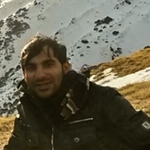
My first trekking was with HT. Initially, i was so scared, but later on i really enjoyed a lots throughout the Trek. Starting from day 1 up to last day HT team guides us very carefully and properly. Those days were unforgettable to me. All the arrangements were very good. But one Suggestion from my side is, It would be better if HT provides the Trekking Shoe to those who are really need that. During trekking,I saw that some people (including me) were facing really difficulties.
Leave a Review
Cancel reply.
You must be logged in to post a comment.
You May Also Like

Bali Pass Trek
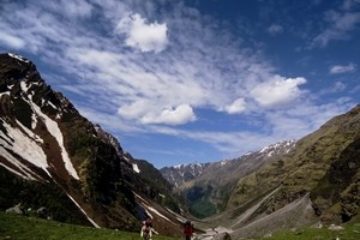
Rupin Pass Trek
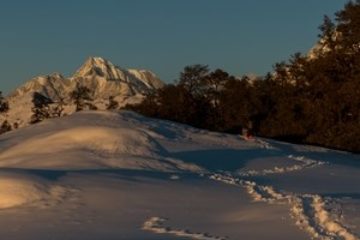
Brahmatal Trek
Submit this form that we can email you all the necessary details and call you to discuss., tour starting date: green boxed dates indicate starting of a scheduled fixed departure tour (day 1 of our tour itinerary). please check the calendar and choose a suitable fixed departure date (green boxed) unless dates are not matching or you are looking for a customised/private trip., i accept the terms & conditions.

Kedarkantha Trek 2024 | Cost, Itinerary, Tips & More
Region: Uttarakhand
Base Camp: Sankri
Grade: Easy – Moderate
Distance: 18 km
Min Age: 10 Years+
Best Season: Winter
Trek Description
If you are looking for a winter trek in the snow, the Great Himalayas welcome you to the most popular and scenic Kedarkantha trek.
Winter trekking in the Himalayas can spice up your experience. One amazing experience is Kedarkantha winter travel in Uttarakhand’s Garhwal Himalayas’ Sankri area. Kedarkantha trip has everything for everyone.
For new trekkers, it can be rewarding and mesmerizing, but for experienced trekkers, it can provide significant rewards quickly. It’s ideal for independent trekkers, groups of friends, families with kids, and anybody else seeking a satisfying, challenging Himalayan journey. You might discover yourself on such an exciting journey.
On the way from Dehradun to Sankri, you’ll pass some lovely villages and towns, such as Mussoorie, Nowgaon, Purola, and Mori. The picturesque path winds through a verdant pine forest, where the fragrant scent of freshly cut pines wafts through the air.
Once you make it through the woods and arrive at Mori, the Tonnes River will become a part of your journey. Famous for its rafting opportunities, the Tonnes River is Yamuna’s largest tributary.
It is recommended to begin early in the morning to reach Sankri by sunset, as the 190-kilometre drive usually takes 8-9 hours to finish. Before starting your hike, the following day, you will spend the night at a guesthouse.
After breakfast at Sankri, they set foot for Juda Ka Talab first thing in the morning. You can see local children on their way to school and ladies beginning their day’s work as you go through picturesque villages like Saud on this exciting walk.
The path winds through a thick pine forest, rising steadily until it reaches a ridge. The path levels out and widens after walking on the ridge. The dense woodland gives welcome shade from the scorching sun.
You have arrived at the world-famous Juda Ka Talab, a picturesque little lake with three artificial islands in the middle. You can camp next to the lake and enjoy a starry night meal.
The trail descends further into the pine forest from Juda Ka Talab till it reaches a meadow with shepherd’s huts. After two or three hours of climbing, hikers will reach the base camp of Kedarkantha after climbing an additional thousand feet.
Photographers and eco-tourists will find paradise along the path that leads from Juda Ka Talab to base camp. The base camp is an excellent camping site since, despite being slightly colder owing to a lack of insulation, it gives breathtaking views of the well-known Uttarakhand peaks.
The long-awaited fourth day has finally arrived! The summit is close to the base camp, where you may enjoy a short but breathtaking ascent before taking in spectacular views of the Himalayan Kailash ranges, the Chaainsheel Pass, and the peaks of Uttarakhand.
The valley of Har Ki Dun, which lies below, is also visible. A stone arrangement featuring a Trishul pointing upwards marks the peak of Kedarkantha.
According to legend, the people interrupted Lord Shiva’s meditation while hiding from the Pandavas as a cow on the summit, which was supposed to be the initial location of the Kedarnath temple. He shifted his position to the current Kedarnath temple due to the interruption.
You will return to base camp after spending some time on the peak, and then after lunch, you will hike the 2-kilometre trail to Hargaon. On your way to Sankri, you will stop at the spacious camping area of Hargaon for the night before saying goodbyes to this picturesque location.
Taking the same beautiful route back to Dehradun makes the always-tender return home trip less painful. The scenery gradually changes as you head downhill into the city, transitioning from dense pine forests to larger roadways. As you say goodbyes to Uttarakhand’s tranquil valleys and mountains, you finally reach the busy town.
What’s Included?
Price inclusion.
- Transportation : Transportation from Dehradun to the basecamp and back to Dehradun is included in the package.
- Accommodation : Enjoy comfortable stays during your trek with accommodation in hotels, guesthouses, or dormitories, offered on a twin, triple, or dormitory sharing basis. When camping, rest in spacious tents on a double or triple sharing basis.
- Meals : We provide nourishing and delicious vegetarian meals. Our meals are designed to keep you energized throughout the trek.
- Camping Fees/Permits : All necessary trekking permits and woodland camping fees are included in the package, ensuring a hassle-free experience.
- Trek Equipment : We provide essential trekking equipment, including dining tents, kitchen tents, sleeping tents with mattresses, and sleeping bags. Utensils, ropes, micro-spikes, and gaiters (if required) are also part of our equipment offerings.
- Mules and Porters : Mules and porters are available to carry central equipment, easing your load and allowing you to focus on the trek.
- Qualified Team : Our team comprises experienced and qualified guides, cooks, helpers, and porters who are dedicated to making your trek safe and enjoyable.
- Basic First Aid : A basic first aid kit with an oxygen cylinder and a helmet (if required) is available to address any potential health concerns during the trek.
- Expert Assistance : You can always reach out to our experts for any queries or assistance during your trekking journey. Simply contact us at +91-8089693825.
Price Exclusion
- Backpack Offloading : If you prefer to offload your backpack, an additional fee of INR 1050 per bag applies.
- Mules or Porters for Personal Bags : The service of mules or porters to carry personal bags is not included and can be arranged at an extra cost.
- Emergency Costs : Any expenses arising from emergencies during the trek are not included in the package.
- Tips : Tips for the trekking team are optional and not included in the package.
- Items Not Mentioned : Any expenses or items not mentioned in the inclusion section are not covered.
- Stay at Dehradun : Accommodation and meals in Dehradun on the last day of the trek are not included.
- Meals During Transportation: Meals during transportation are not included.
- GST : A 5% Goods and Services Tax (GST) is applicable and not included in the package.
Things to Carry
- 45-60 Ltr Bag Pack With Rain Cover & Comfortable Straps
- Hot & Cold Water Bottle Like Borosil & Milton
- Energy Bar, Dry Fruits & ORS
- Personal Medical Kit
- 2/3 Full Sleeves (Non-Cotton)
- 1 Full Fleece T-Shirt
- 1 Fleece Jacket (Woollen Or Sweater)
- 1 Down Feather/Hollofil Jacket
- 1 Waterproof Jacket/Poncho
- 1 Pair Thermal Inners (Upper And Lower)
- 2 Trek Pants (Avoid Shorts & Denim Pants)
- 1 Pair of Waterproof Gloves
- 1 Pair of Woollen Gloves
- Woollen Cap
- 4 Pairs Of Cotton Socks
- 1 Pair Of Woollen Socks
- 1 Pairs Of Sunglasses (U/V Protected)
- 1 Neck Gaiters (Buff)
- 1 Waterproof & High Ankle Trekking Shoes
- 1 Pair Of Floaters
- Hand Sanitizer & Sunscreen Lotion
- Toothbrush And Toothpaste
- Toilet Paper And Wet Wipes
- Quick Dry Towel
- Lip Balm & Antibacterial Powder
- Moisturizer
How To Reach
If you’re flying in, the nearest airport to Sankri village is Jolly Grant, located near Rishikesh. From there, you can arrange a separate taxi that will take you directly to Sankri, which serves as the starting point for the trek.
The nearest railway stations to Sankri are Dehradun and Rishikesh. You can easily find a bus or taxi from Dehradun that will take you directly to Sankri.
Buses to Sankri can be boarded at the Mussoorie bus stand near the Dehradun Railway station. These buses depart from Dehradun at the following times: The first bus departs at 5:30 a.m. The second bus leaves at 6:30 a.m. The third bus departs at 7:30 a.m. En route, you’ll pass through checkpoints such as Mussoorie, Naugaon, Purola, Mori, and finally, Sankri village.
Difficulty Level of Kedarkantha Trek
The Uttarakhand, India, Kedarkantha hike in the western Himalayas is breathtaking. The moderately challenging walk offers beautiful Himalayan views and is popular with travelers.
From Sankri, a small settlement in the western Himalayas, the trip winds through lush woods, meadows, and snow-capped peaks. The moderately demanding hike is suitable for fit people with basic trekking experience. The 32-km Kedarkantha trip takes six days.
Altitude gain is a major problem of the Kedarkantha climb. The trek leads you to 12,500 ft above sea level, where the air becomes thinner and harder to breathe. For individuals inexperienced with high altitudes, acclimatize for a day or two before the hike. Some hikers struggle on the last day due to the steep slope and rocky, slippery snow route.
The hike is difficult due to sudden weather changes. Winter is cold and windy. Keep warm with a sleeping bag and other supplies. Kedarkantha trekking is enjoyable and offers stunning Himalayan views and an opportunity to appreciate nature despite the hardships. The journey through oak and rhododendron forests lets you see Bharal or Himalayan blue sheep and snow leopards.
Best Time for Kedarkantha Trek
Among the few treks in the Indian Himalayas that are accessible all year round, the Kedarkantha trek stands out. The Kedarkantha walk is accessible for ten months, except July and August, the wettest months in Uttarakhand. Four distinct seasons make up the ten months:
Summer – May and June
Spring – March and April
Winter – December to February
Autumn – Mid-September to November
You may expect different weather, terrain, and challenges with each season. To sum up, here is a review of the subtle changes that will occur during the year. This will be useful as you plot out your journey.
More Info of Kedarkantha Trek
The Uttarakhand government now requires local guides for trekking in 2021. Remember that Kedarkantha hike permits are only provided with a Forest Department-registered local guide. Govind Pashu Vihar National Park officials enforce this rule. The Sankari Forest Office and the local guide will help you get trek permits.
Village of Osla
On your way to Har ki Dun from Sankri, you’ll pass Osla, a charming village. Osla is 26km from Taluka and 2590m high, perched on a steep slope covered by apple trees. The wood homes of Osla will immediately pique your curiosity and make you want to explore this wonderful community.
Village Jakhol
The entrance to Govind National Park is Jakhol village. It is 19 kilometres from Netwar in Uttarkashi’s Mori block. This tiny Uttarakhand village is serene and beautiful, with views of the Garhwal Himalayas. Mountain and valley views will delight you. People stay there to experience its divinity.
Trek Saru Tal
The Saru Tal Trek takes you to the holy water of Sar Lake at 4200 meters in the Western Garhwal Himalayas in Uttarkashi, Uttarakhand. Sankri is the base camp for a nine- to ten-day gentle hike. Daytime temperatures are mild, while nighttime temperatures are cold at Saru Tal. The Himalayas and gorgeous meadows will wow you from the outset of this adventure.
Trekking Ruinsara Tal
Ruinsara Tal, 3,500 meters above sea level, will amaze you as you explore Garhwal’s sacred valleys. The glacial blue lake is 14 kilometers from Osla/Seema at the foot of Kalanag Peak. Har-Ki-Doon Valley residents revere Ruinsara Tal, besieged by alpine flowers and rose-pink rhododendrons. Residents of this region believe they are Kauravas’ ancestors and have built temples in their honor.
Bali Pass Trek
The 5,000-meter Bali Pass is in Garhwal. This striking high altitude byskip offers unobstructed views of Kala Nag, Bandarpoonch, and Swargarohini. The Bali Pass walk offers experiences and wonderful views to make you nostalgic. Jankichatti is the end of the Sankri village hike. This journey requires some hiking expertise.
Trekkers can reach The Paradise of the Himalayas from Uttarakhand’s Sankari Village. It is a picturesque hamlet in Uttarkashi district and a trekker’s paradise. Sankri Village is the last entrance to Govind Balabh Pant Wildlife Sanctuary. The town offers breathtaking views of the Himalayas and many mountain peaks from afar.
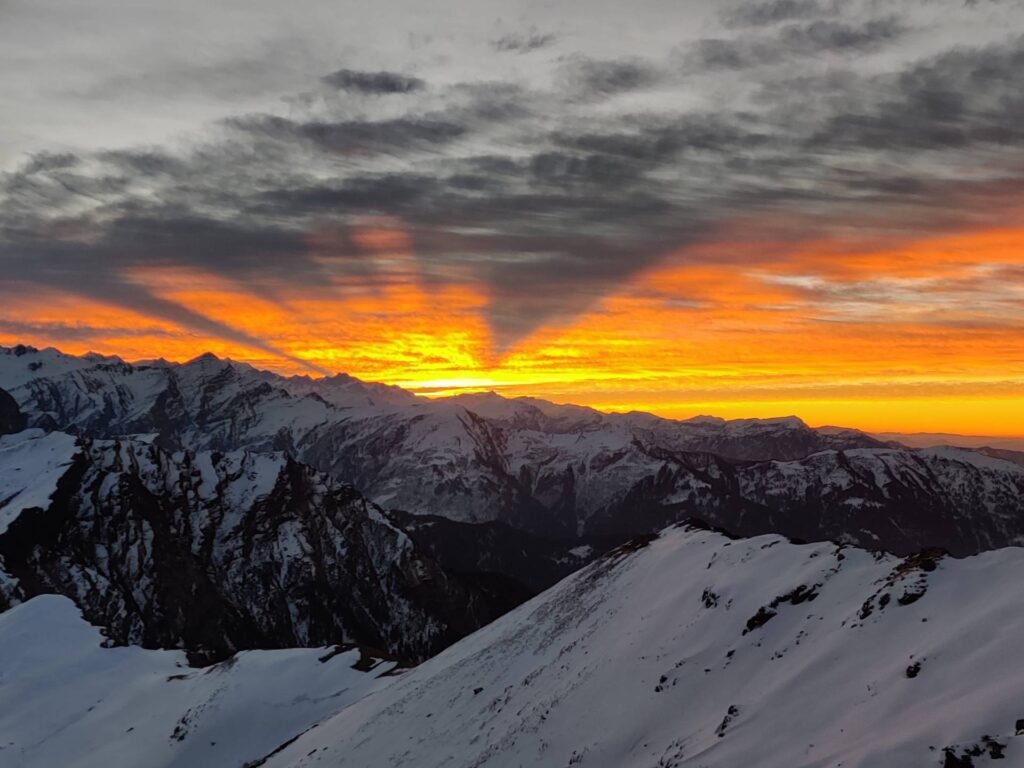
Map of Trail
For maximum comfort, we offer three and four person tents with twin-sharing or three-sharing options.
Himalayan Dreamtreks is a trekking company that puts all of its participants’ safety first, including female trekkers. They have a robust safety system in place, including a dedicated team of experienced and qualified trek leaders and support workers who are prepared to manage emergency situations and administer first aid.
The HDT also takes special precautions to guarantee the safety and comfort of female hikers. They offer separate tents for female hikers, female trek leaders, and support staff. They also have separate restrooms for ladies and promote a safe and respectful environment for all trekkers.
During the trek, HDT provides wholesome and nutritional meals. The food is vegetarian and consists of rice, dal, veggies, chapati, paratha, pasta, noodles, and soup. Special dietary needs, such as vegan, gluten-free, or Jain meals, can also be accommodated if requested in advance.
/ Per Person
5% GST & Transportation Cost
Cancellation Policy
Available Dates
Contact us for Booking
Similar Treks

Dayara Bugyal Trek

Kuari Pass Trek
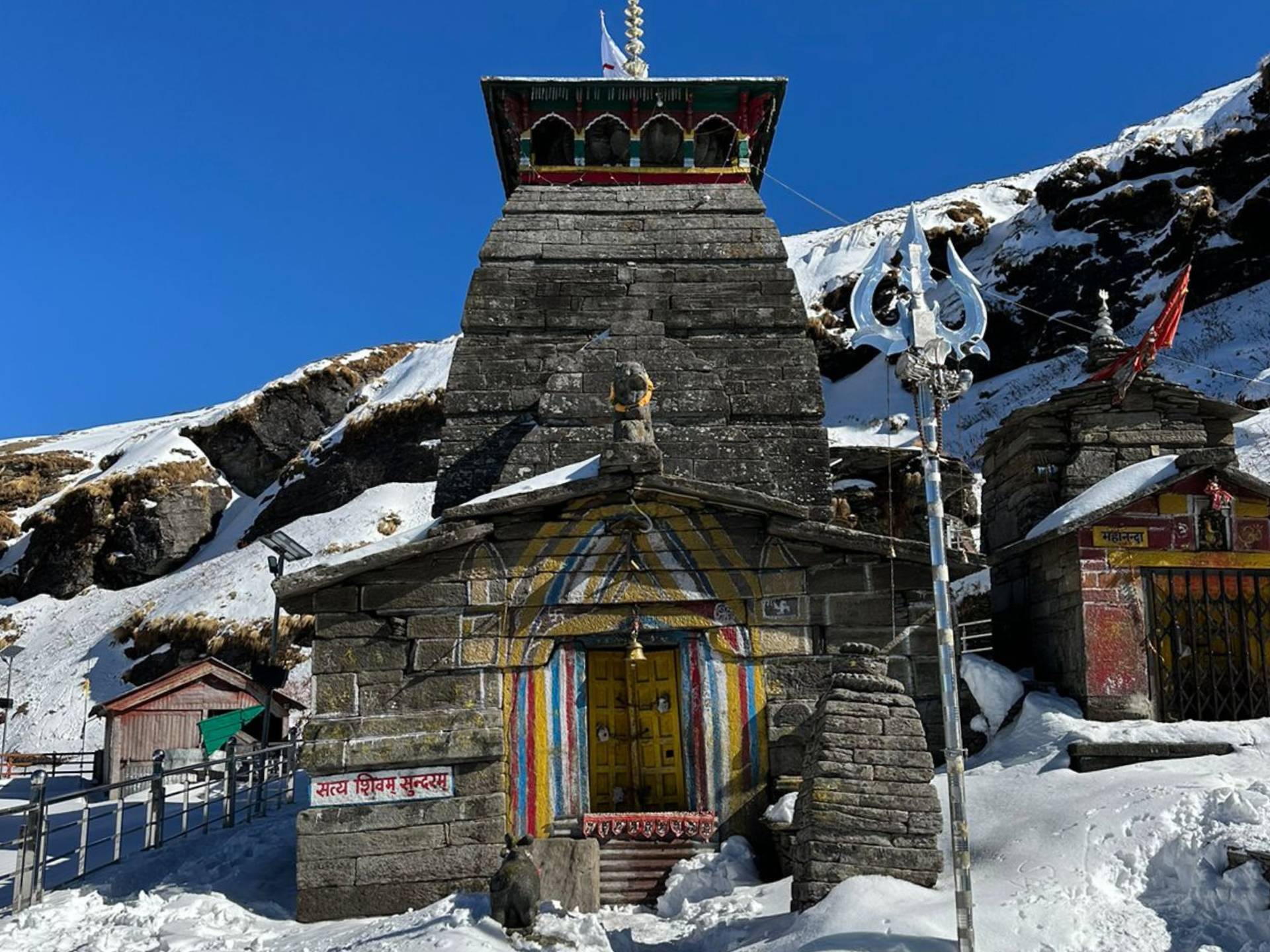
Chopta Tungnath Trek

Brahmatal Trek
3 responses to “kedarkantha trek 2024 | cost, itinerary, tips & more”.
My age 48 can I join
Hi Ashish, you can join this trek. Trekkers of all age groups accompany us on treks. Make sure you’re in good physical shape and can walk 5 kilometers in 35-45 minutes, you’ll find this trek manageable. However, if you lead a more sedentary lifestyle, we suggest incorporating daily exercise into your routine to enhance your trekking experience. Activities like jogging, walking, yoga, or gym workouts can be beneficial. It’s all about ensuring you’re comfortable and can fully enjoy your trek.
Great place
Leave a Comment Cancel reply
Save my name, email, and website in this browser for the next time I comment.
+ Transportation Cost
Call for Booking
Subscribe to our newsletter
Get news and discounts straight to your inbox
We are Associated With

Himalayan Dream Treks
We believe in making the Himalayas more than just a destination; we see them as a life changing experience. Whether you seek spiritual enlightenment, have a passion for trekking, or simply crave adventure, we're here to accompany you on your journey.
Important Links
Why Choose Us?
Advance Payment
Cancellation Policy & Refund
Privacy Policy
Terms & Condition
Career At HDT
Contact Details
+91-80896 93825
+91-94565 46051
Join Our WhatsApp Group
Office Address
Dehradun Office :
10 B, Mothorowala Rd, Dharampur, Ajabpur Kalan, Dehradun, India, Uttarakhand, 248121
© All Rights Reserved 2024 Himalayan Dream Treks
(To the Himalayas and Beyond) — Designed & Developed by DeveloSquad

- KEDARKANTHA TREK
Trek to the Summit: Kedarkantha Trek with Adventure Peaks Expeditions.
Uttarakhand
Easy To Moderate
Trek Distance
Trek duration, highest altitude, best season.
Nov to April
Nearest Airport
Pick & drop point.
Dehradun Railway Station
Railway Station
- Transport Included | From Dehradun & Return
ABOUT KEDARKANTHA TREK

Located at an altitude of 12,500ft., Kedarkantha is one of the most famous winter treks in Uttarakhand. Kedarkantha is well-known for its striking and magnificent beauty. During winters enclosed in sparkling snow, this trek presents the tremendous look of the royal Himalayan peaks. It also offers its trekkers a unique chance to experience life in the outmost of villages that too in dead winter. If you really want to enjoy nature at its best and experience an amazing trek then the Kedarkantha trek is definitely the best option for you. During the trek, you will pass through fascinating pretty sights, snow tracks, rich forests as well as fields.
This trek is ideal for both beginners and seasoned trekkers due to the simple endurance of the trail. While trekking, you will get the chance to camp around frozen Juda Ka Talab where once Lord Shiva used to meditate. Kedarkantha trek is sure to give you supreme beauty, glorious sights of the beautiful villages, snow paths, intense landscape dotted with eye-catchy lakes, meadows, mountains, the great Himalayan peaks as well as soothing rivers. In case, you are a mountain lover who wants to explore every inch of the terrains then the Kedarkantha trek is going to be an utter delight for you. You need to know that Kedarkantha is covered with snow from December to April, making it one of the top treks in Uttarakhand.
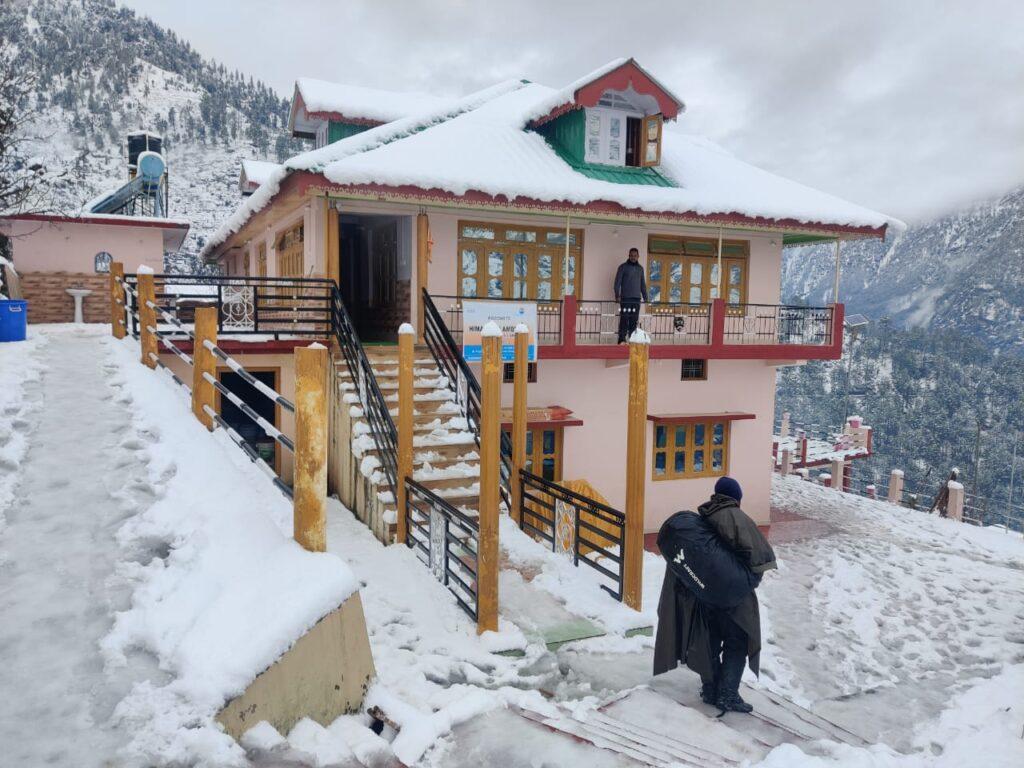
Kedarkantha trek summit is settled in Govind Wildlife National Sanctuary Park of Uttarkashi. While trekking you will see this enthralling peak is surrounded by different attractive river valleys. November to the last week of April is the best time to plan for this trek as you can find a lot of snow here. The campsites of this trek are a treat for your eyes as they are covered with snow from mid-November. Currently, Kedarkantha is considered the top trek of the Uttarakhand Himalayas. If you love enjoying mind-blowing sunrise and sunset then you must plan for the Kedarkantha trek at least once in your life. This trek begins from a traditional village named Sankri which is present in the Govind Wildlife Sanctuary National Park. Sankri is very beautiful with snow-capped mountains as well as the twinkling river flowing through it. Knee-deep snow in winters, compelling sights from the top, and gorgeous and simple trails, make Kedarkantha a widespread trek among trekkers. You need to know trekkers from across the world come to experience the splendid beauty of this trek.
Remember every trek in the Himalayas is considered special and renowned for its incredible beauty. Trekking not only gives you the chance to get a perfect dose of nature which is not possible in cities. Not only this, but trekking also gives you an opportunity to extend your physical and psychological bounds.
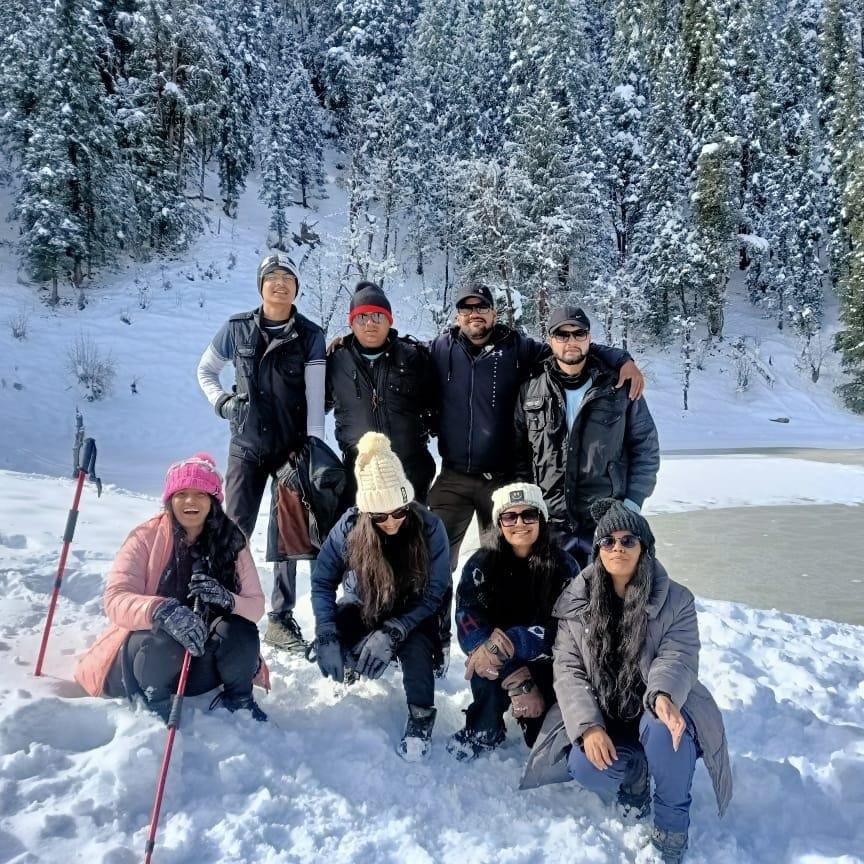
So, if you like trekking and want to experience nature at its best then you must surely plan your trip to Kedarkantha and rejuvenate yourself in the beauty of the scenery.
FIX DEPARTURE
1st, 2nd, 3rd, 4th, 5th, 6th, 7th, 8th, 9th, 10th, 11th, 12th, 13th, 14th, 15th, 16th, 17th, 18th, 19th, 20th, 21st, 22nd, 23rd, 24th, 25th, 26th, 27th, 28th, 29th, 30th Nov.
1st, 2nd, 3rd, 4th, 5th, 6th, 7th, 8th, 9th, 10th, 11th, 12th, 13th, 14th, 15th, 16th, 17th, 18th, 19th, 20th, 21st, 22nd, 23rd, 24th, 25th, 26th, 27th, 28th, 29th, 30th, 31st Dec.
1st, 2nd, 3rd, 4th, 5th, 6th, 7th, 8th, 9th, 10th, 11th, 12th, 13th, 14th, 15th, 16th, 17th, 18th, 19th, 20th, 21st, 22nd, 23rd, 24th, 25th, 26th, 27th, 28th, 29th, 30th, 31st Jan.
1st, 2nd, 3rd, 4th, 5th, 6th, 7th, 8th, 9th, 10th, 11th, 12th, 13th, 14th, 15th, 16th, 17th, 18th, 19th, 20th, 21st, 22nd, 23rd, 24th, 25th, 26th, 27th, 28th Feb.
1st, 2nd, 3rd, 4th, 5th, 6th, 7th, 8th, 9th, 10th, 11th, 12th, 13th, 14th, 15th, 16th, 17th, 18th, 19th, 20th, 21st, 22nd, 23rd, 24th, 25th, 26th, 27th, 28th, 29th, 30th, 31st Mar.
1st, 2nd, 3rd, 4th, 5th, 6th, 7th, 8th, 9th, 10th, 11th, 12th, 13th, 14th, 15th, 16th, 17th, 18th, 19th, 20th, 21st, 22nd, 23rd, 24th, 25th, 26th, 27th, 28th, 29th, 30th April.
The best time to do the Kedarkantha Trek is usually from November to March when the snow covers the trail, offering breathtaking views.
The Kedarkantha Trek is easy to moderate in difficulty, making it suitable for beginners as well as experienced trekkers.
The total duration of the Kedarkantha Trek is usually 5 days, including travel to and from the base camp.
The altitude of Kedarkantha Peak is approximately 12,500 feet (3,810 meters) above sea level.
Essential items to carry for the Kedarkantha Trek include warm clothing, sturdy trekking shoes, sunglasses, sunscreen lotion, poncho, headlight, trekking poles, gloves, woolen cap, water bottles, first aid kit, and high-energy snacks.
It is mandatory to go with a local trekking agency registered under forest department and Uttarakhand tourism, it is highly recommended for all tourists, especially for beginners or those unfamiliar with the terrain.
Permits are required for the Kedarkantha Trek, and they can be obtained from authorized trekking agencies.
Accommodation during the trek includes tents at designated camping sites along the trail.
There are no strict age restrictions for the Kedarkantha Trek, but participants should be reasonably fit and able to trek for several hours a day. Recommended age limit is a minimum of 10 years with a medical certificate.
Weather during the trek can vary from cold to extremely cold, with temperatures dropping below freezing at night. During the Kedarkantha trek, weather conditions vary with the seasons. In winter (December to March), temperatures range from 0°C to -10°C, with heavy snowfall. Spring (April to June) brings milder temperatures of 5°C to 15°C, with patches of snow at higher elevations.
Monsoon (July to September) sees temperatures of 10°C to 20°C, with heavy rainfall and slippery trails.
Autumn (October to November) offers clear skies and temperatures of 5°C to 15°C. Trekkers should be prepared for fluctuating weather and pack accordingly, ensuring proper clothing and gear to make the most of their Kedarkantha adventure.
Only basic first aid kits are available with guides from trekking agencies along the Kedarkantha route. Trekkers should supplement with their own medications and equipment. In case of emergencies, evacuation may be necessary to access more comprehensive medical facilities in nearby cities.
Yes, solo trekking is possible for the Kedarkantha trek, as trekking agencies often organize group treks where solo trekkers can join. At the basecamp starting point of the trek, solo trekkers will have the opportunity to join other tourists and form a group for the trek. This allows solo trekkers to enjoy the experience while also ensuring safety and companionship along the trail.
Yes, it is safe for girls to trek the Kedarkantha. Trekking agencies prioritize safety and provide experienced certified guides, groups, and proper separate arrangements for accommodations.
Alternate routes or side trips during the trek include exploring nearby villages or ascending nearby lakes and meadows for panoramic views.
Wildlife encounters are rare, but trekkers should be cautious of slippery trails, heavy snowfall, and altitude sickness.
Yes, Trekking equipment such as Jackets, Shoes, trekking poles, raincoats, headlamps, Trek pants, and backpacks can usually be rented at the base camp or nearby shops.
The cost of the Kedarkantha Trek varies depending on factors such as group size, trekking agency, and amenities included, but typically ranges from ₹7500 to ₹9000 per person.
Yes, it is possible to do the Kedarkantha Trek in winter, as it is a winter trek only but it requires additional preparation and caution due to the harsh weather conditions.
Transportation options to reach the Sankri starting point of the Kedarkantha Trek include buses, taxis, or private vehicles from Dehradun.
It's advisable to book the trek at least a month in advance, especially during peak trekking seasons.
Cultural and historical sites near the trekking route include remote villages with traditional lifestyles and ancient temples dedicated to local deities.
DETAILED ITINERARY

Drive 198 km/8-9 Hrs
Altitude – 6300ft/1920m
Only Jio and BSNL newtwork available
Trekkers will be picked up from Dehradun railway station at 7 AM. The journey will start from Dehradun to Sankri village. You will drive along the Yamuna and other rivers along with beautiful pine forests that will surround your way. the drive to Sankri is going to be memorable because of the captivating sights.
By 5 PM in the evening, you will reach Sankri and after freshening up you will get the time to explore this beautiful village. The night stay of all the trekkers will be arranged in a hotel or homestay.

Altitude 9,100 ft.; Trek 3.5 km/ 4-5 Hrs., Night stay in tents at Juda Lake.
In the early morning, we will start the trek from Sankri to Juda-Ka-Talab which is 4km. You will enjoy really amazing views of nature from Juda-Ka-Talab as it is located at a height of 9,100ft. The dense forest and carpet of maple leaves during the trek will surely startle you. The track going to Juda-Ka-Talab passes through riveting forests of deodar, oak, and birch trees. Night stay will be scheduled in tents at Juda Lake, giving you chance to spend some quality time in nature’s lap.

Altitude - 11,250 ft.; Trek 3 km/4-5 Hrs, Night stay at base camp.
From Juda-Ka-Talab, your trek will start at Kedarkantha base early in the morning which is nestled at an altitude of 11,250ft. In order to reach Kedarkantha base, you will go through the forest of Pine and Oak trees which will later lead to breathtaking meadows.
Also get ready to experience the splendid views of well-known Himalayan peaks such as Swargarohini, Kala Nag, and Bandarpoonch. Night stay will be planned at base camp, giving you outstanding views of nature.
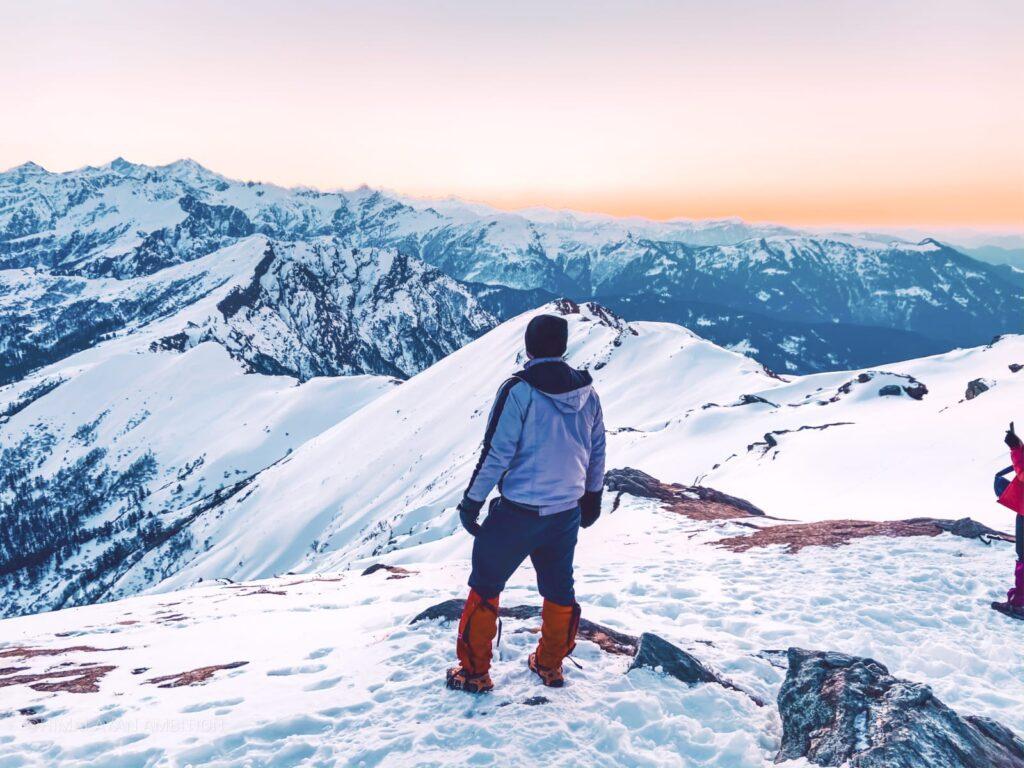
Altitude - 12500ft/ 3810m; Night Trek 3.5km, base camp to summit/ 3-4 hrs; Trek 7km/3-5hrs, summit to juda lake. Night stay in tents at Juda ka talaab.
On day 4, we will trek from Kedarkantha base to Kedarkantha summit which is located at a height of 12,500ft. On the same day, we will return back to base camp as well as descend to Juda-ka-Talaab camp. While trekking, you will go through crystal clear streams and oak trees. You will also be served with delicious and healthy breakfast.
At night, all the trekkers will stay in tents right under the open sky filled with sparkling stars.
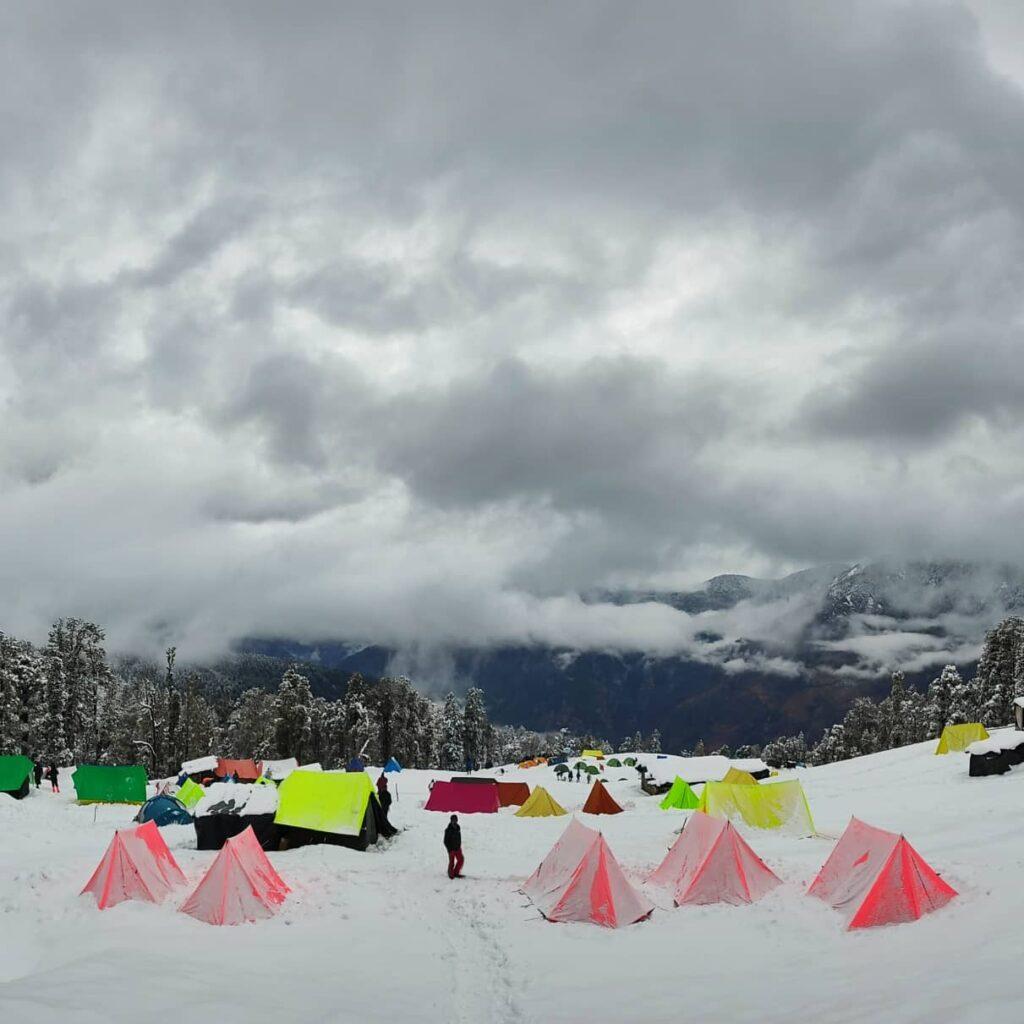
Trek 3 km/2-3 hours
On day 5, we will trek back from Juda-Ka-Talaab to Sankri via Hargaon which is almost 3 hours trek. After reaching Sankri, we will drive back to Dehradun along with some beautiful and life-long memories. It will take almost 8-9 hours to reach back to Dehradun.
At Dehradun railway station, we will drop you off by 11 pm. Say goodbye to the most exciting treks that will give you some unique experiences to cherish throughout your life.
THINGS TO CARRY
- Backpack & Rain Cover (50-70 Litres)
- Hiking bag (20 litre)
- Trekking Shoes (Ankle Shoes)
- Warm clothes
- Water Bottles
- Jacket (Down or padded)
- Fleece or woolen clothes
- Trek pants and Trousers
- T-shirts (collar and full sleeves)
- Thermal inner wears (both upper and lower)
- Woolen or Fleece cap
- Hand Gloves
- Socks (4 pairs)
- Neck cover, Muffler, Balaclava, any
ACCESSORIES
- Sunscreeen Lotion (SPF 50/70)
- Moisturizer and Lip Balm
- Raincoat and Ponchos
- Power banks
- Trekking pole
- Small Hiking bag (10-20litre) (for summit climb or if you opt to offload your backpack)
- Glucose, Dry fruits
- Personal Toiletries kit
- Toilet paper roll and sanitizer
- Personal basic medical kit
MANDATORY DOCUMENTS
- Original with photocopy of government photo identity card any one (Passport, Aadhaar Card, Driving license or Voter ID)
- Transportation : Dehradun & Return.
- Accommodation (Hotel, Homestay, Camping)
- Meals : All Meals as per menu from first day Dinner to last day Breakfast at basecamp; Vegetarian Meal.
- Camping charges : Camping and forest permit fees for Indian Nationals.
- Trekking equipment : High quality tents (living tent- triple sharing, kitchen tent, dinning tent, toilet tent)
- Sleeping bags, mattresses, liners, Utensils, Gaitors, Microspikes/crampons, ice axe.
- Safety equipment : First aid medical kit, oxygen cylinder, stretchers, rope.
- Mountaineering qualified and experienced Trek leader, Guides, Cook and Support staff.
- Meals during road journeys
- Any personal expenses
- Mules or porter to carry personal luggage
- Anything apart from inclusions
Backpack Offloading Charges
• Offload your backpack to a mule or porter to lighten your load during the trek. • Offloading charges range from ₹300 to ₹900 per day per bag, depending on the specific trek. • Ensure your backpack weighs less than 11 kg and is equipped with a waterproof cover. • Suitcases, trolleys, or duffel bags are not allowed.
Booking Confirmation Policy
• The customer receives a Booking confirmation receipt immediately via Email and WhatsApp of a successful booking.
Cancellation policy
In the event you cancel your trek, cancellation policy we follow :
• Cancellation 20 days before the starting date of the trek – Refund with 10% cancellation charges.
Cancellation 20 days before the starting date of the trek – Refund with 50% cancellation charges
Cancellation less than 20 days from the starting date of the trek – No refund
Note : HA gives you a facility in the event of cancellation due to some reason to transfer your trek (same trek and same batch) to your friend.
The refund will be given in the form of a trek voucher with 1 year validity, you will get an email for your trek voucher, it will take up to 7 working days.

Trekking in the Himalayas is a popular adventure sport for those who love exploring the unknown. The mountain ranges in India provide stunning and exciting trekking paths.
famous Treks
- BALI PASS TREK
- HAR KI DUN TREK
- VALLEY OF FLOWERS
- BRAHMATAL TREK
- HAMPTA PASS TREK
- Himalayan Ambition , Vasant Vihar Enclave, Dehradun, Uttarakhand
- +91 9719715444
- +91 9536332828
- +91 9536385777
- [email protected]
- Privacy Policy
- Terms & Conditions
Copyright © Himalayan Ambition 2022 BY ADXVENTURE
Enquiry Now
Kedarkantha "Best Winter trek" organized by Trek The Himalayas (TTH)
- Kedarkantha "Best Winter Trek"
Before you read anything about Kedarkantha Trek , first read this:
"This is a must-do trek for every trekker/nature lover/adventure lover person".
It was the year-end festive season of 2018 and as a mountain lover, I was planning a mountain trip. I did search almost every place of Himachal and Uttarakhand. After a few days, one of my colleagues suggested for Snow trek in Kedarkantha. I gave a thought, googled, researched, and found this image which is at the top of Kedarkantha Peak .
.webp)
and looking at this, I ended up deciding this as my first Himalayan winter snow trek .
In this article, the first section is dedicated to all the information/preparation related to the trek followed by my personal experience along with the group.
Registration :
Many certified trekking groups conduct these kinds of trips. A few of them are TrekTheHimalays ,IndiaHikes, AdventureNation, Moxtain etc.
I chose Trek The Himalayas based on feedback I received from many friends and TTH did not disappoint. Registration can be easily done on their website before about 2 months.
This is not a very hard trek but it doesn't mean you come out of the office and start your trip. It requires some fitness. Better to prepare well before this trek so you can enjoy the beauty instead of giving too much trouble to your body. At high altitudes where oxygen is less, should be very aware of how your body reacts. Drinking a lot of water and getting good sleep helps in these conditions.
Connect to Base Village and Campsites :
Sankri is the base village for the Kedarkantha trek . It connects with Dehradun and it takes around 8-10 hours to reach Sankri. It is a quite place in the foothills at an altitude of 6400 feet. Starting from Sankri, the first campsite is Juda Ka Talab at 9,100ft height. The next day campsite is Base camp which is at 10,200 ft and is the most beautiful site. The final day campsite is in Hargaon (Opposite side of Juda Ka Talab) which is encountered after the summit.
Mobile Networks and ATMs :
Mobile networks slowly dies after Mussoorie and should not expect ATMs after Dehradun. So should be well prepared with cash. There is a P.C.O. in Sankri with broken BSNL networks.
***************************************************************************************************
Day 1 : The Journey started in the early morning from Dehradun station, where one of the TTH members was there to greet us and provided the tempo traveler to Sankri Village. Being solo I could easily get a window seat and was looking curiously at other fellows with whom i was supposed to spend the coming days.
Dehradun to Sankri road journey is very beautiful alongside the Yamuna and Tons rivers. We stopped in Mussoorie and Purola Village for breakfast and Lunch.
Coming from Pune I was already feeling the cold. After 8 hours of hilly roads we reached to our hotel (named as Trek The Himalayas ) and we our rooms were already allocated. There we met with our trek leads, we completed all the formalities and briefing , had good dinner and slept.Since we all were tired , we slept early.
Day 2 morning 7:00 o'clock : I went to balcony of hotel with a cup of tea . This morning was very beautiful. Snow caped mountains in-front of us , only sound of Tons river and few birds. Temperature was hovering between 2 to 5 degrees maybe. Everything was so beautiful there.
We all were so excited and started our journey for first campsite Juda Ka Talab .
For first timers, It was challenging ascend of around 5 hours. On the way we witnessed first snow of trek.
.webp)
- Much needed Maggie Break .
- We halted at Maggie point and started posing for photos. By this time I became familiar with 21 strangers .
- After a long ascend of around 5 hours, we finally reached Juda Ka Talab campsite where a frozen lake alongside our tents was waiting for us.Temperature was around 2-3 and everything was covered with snow.
- This had to be one of the best campsites of TTH .
- Frozen Juda Ka Talab, Few dared to walk over.
- We played few games there to get used to with temperature . Made snow man.
- Need to work harder for Snow art.
- There I had few talk with group member during evening tea , then soup and followed by some delicious dinner and songs and stories to end a beautiful day. Initially it was not that easy to get used to with snow and low temperatures. I couldn't sleep properly. Bones were freezing in the night even though i had few layers of thermals. Whole body was covered but still we were shivering with cold. I said to myself "Welcome to Winter Trek ".
- Then i saw a guy with his tripod at midnight in mid of snow at temperature of around -3 degrees to capture these images.
- Magic images captured by Shaurya.
- This image already speaking thousand words.
- He was Shaurya, One of my new friend. His dedication to his photography was really motivating.
Day 3 Morning : My fingers got numb while completing morning duties. Every touch with water was felt as current to body. Thanks to TTH team, they provide some hot water, which i used to drink and wipe my face. Everything was so memorable but torturous .
It was the day to reach our base camps covering about 2 KMs in 3 hours, so it was a bit relaxed day compared to previous one. We started from Juda ka Talab around 10 AM and reached to base camp around 1 PM . In between we witnessed frozen waterfall , beautiful snow landscapes , Pine trees. It was most scenic route of the trek.
.webp)
- Beautiful path to cross.
- Everything was Frozen.
- Almost at the base camp.
- This campsite provided a view of all snow caped peak in-front and behind us a snow mountain which we had to cross next day to reach the peak.
- I think this was the best place to get profile pic. After relaxing we had lunch , then took some rest and we all were literally lost in nature by now.
- My group had amazing talent, few were singing, few busy with their DSLR setup , some dancing , few story tellers. It was really a great experience to be part of that group.
- View from base camp.
- Nothing else matters.
- Next day was summit day and we had to start early by 3 AM, so it was a quick shut down for day 3.
Day 4 Summit day : At 2 AM we got a call for tea , 2 : 30 AM was Maggie time and 3 AM. We put our crampons and were set to conquer the Kedarkanth peak .
.webp)
- Head torches.
- From base camp to peak it was around 4 hours ascend and most magical ascend we could ever had.
- We started to climb the mountain behind our camps and we walked and walked and walked.
- I had experience of night trek (Kalsubai) , so i was confident about my pace and stamina. With small steps we reached half way point. By this time it was not that dark. As the affect of night was melting down , we all could see the peak . I got goose bump at that time.
- Magic started. When we looked at that peak we never thought it could take that much of effort to reach at the top but as we were getting closer to that, looked like peak was running away from us. Minute by minute we were taking some heights, feeling the lack of oxygen, stopping almost every 15 mins walk and meantime I realized why this is said to be the most beautiful winter trek .
- Sun started to smile from left side , the snow caped mountains became golden , horizon went orange then blue.
- I though of that Trident of Shiva image again ,i smiled, increased my pace. It was just 80 - 100 meter distance between me and that Trident. I turned back and saw this.
- Simply Breathtaking.
- In the way there were stacks of stones.
- I finally reached at the top. It looked like i was at top of everything. 13 peaks were visible including Swargarohini, yamunotri, Bandarpuch. All were snow caped. I saw that Trishool, clicked a photo, had some biscuits and cake. Sat down their and thanked to almighty and got lost.
- Peaks of Yamonotri , Swargarohini.
- We congratulate each other took group pictures with our trek lead who motivated everyone to climb even in difficulties.
- I forgot all those numb fingers, sleepless nights , lack of oxygen , current of cold water. It was all about 360 degree view from KedarKantha peak .
- It was time to return back . We chose other side of mountain to go down. As expected, we all took a natural snow slide to get down. It was fun. It didn't take much time to reach half way back.
- I was descending alone and was so happy and satisfied. Smiling all the way.
- We reach to our base camp around 11 AM, had rest . After lunch and individual stories of everyone , we started towards our last campsite Hargaon.
- Hargaon Campsite.
- This site is close to Juda ka talab . As descending is always tricky and got trickier in melting snow. By 5 PM we reach to our last campsite.
Day 5 Back to Sankri : It was all about descending that day. This was our last day of trek . We reached around 1 PM to Sankri . Got good bath . Had lunch. Took rest. It was time to celebrate our success. So we partied and danced till night.
All was good.
Day 6 Back to Dehradun : We had to return to Dehradun . We started sharp 7 AM and crossed those hilly roads by listening some beautiful local songs.
- My train was at night so with my two new friends we stayed in a hotel for a while .
.webp)
- happy memories with friends during trekking journey on kedarkantha.
- The only thing i could say about this trek , all those pictures and words don't tell you the the full stories. You should do this trek at-least once in lifetime.
- As they say, you go alone but come with many friends .
- Image of Trident at 12,500 ft will always remain as it is in my heart.
Upcoming Treks
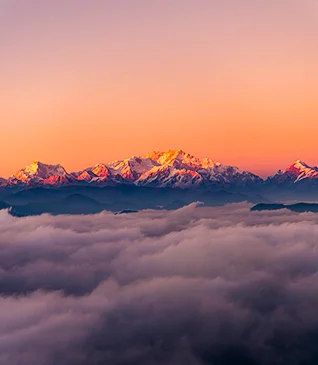
Sandakphu Trek
West Bengal
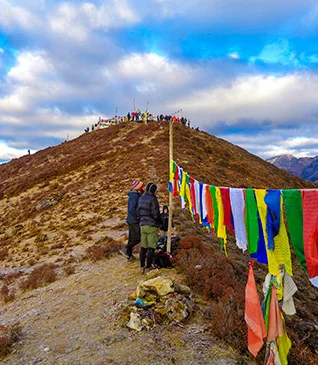
Goechala Trek
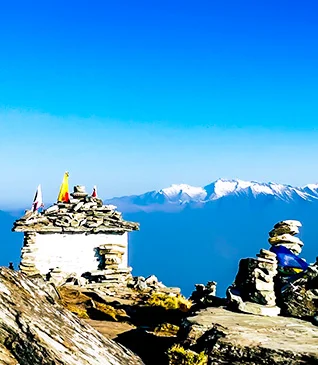
Chopta Chandrashila Tungnath Trek with Deorital
Uttarakhand
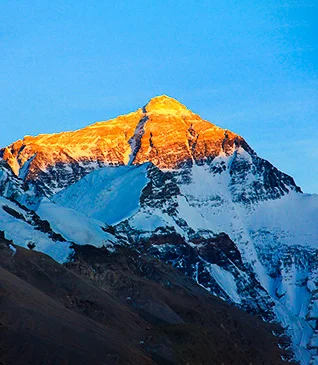
Everest Base Camp Trek
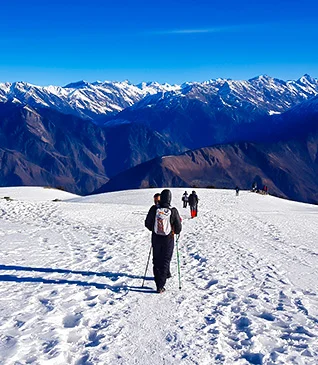
Kedarkantha Trek
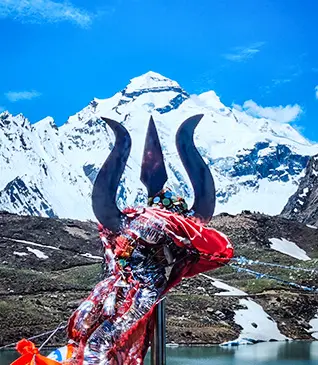
Adi Kailash and Om Parvat
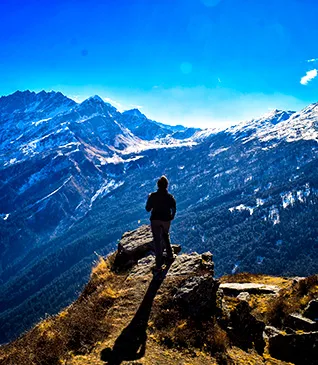
Winter Kuari Pass Trek
.webp)
Gaumukh Tapovan Trek
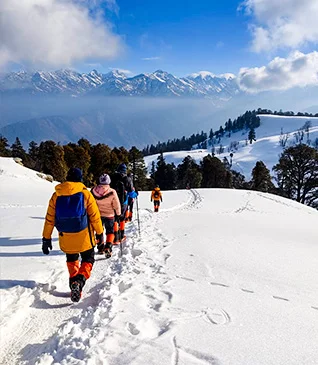
Brahmatal Trek
.webp)
Hampta Pass Trek
Himachal Pradesh
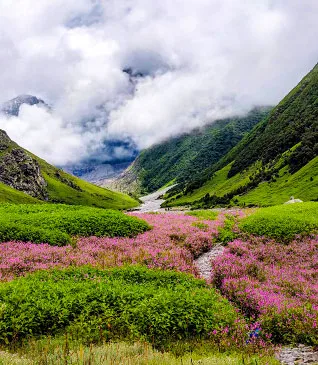
Valley of Flowers Trek
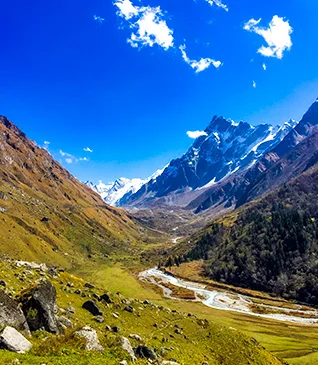
Har Ki Doon Trek
.webp)
Annapurna Base Camp Trek
.webp)
Ranthan Kharak Trek
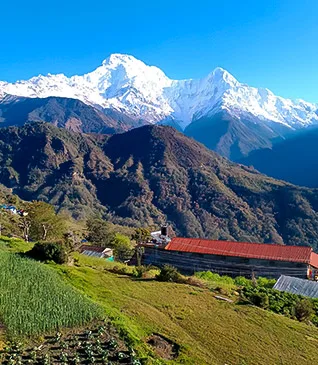
Khopra Ridge
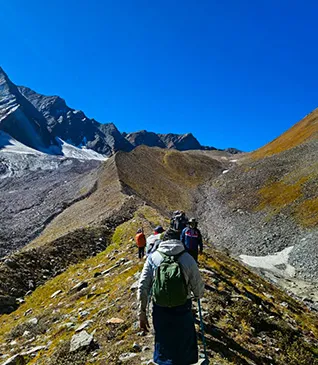
Bali Pass Trek
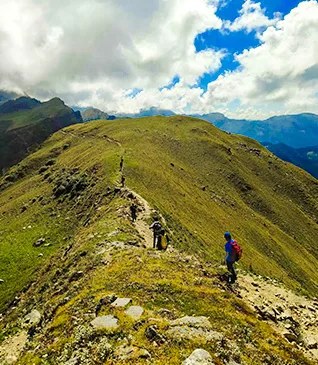
Phulara Ridge Trek
.webp)
Rupin Pass Trek
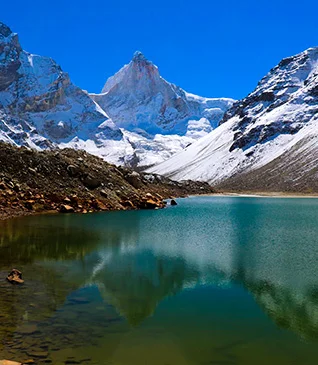
Kedar Tal Trek
.webp)
Ali Bedni Bugyal Trek
.webp)
Dayara Bugyal Trek
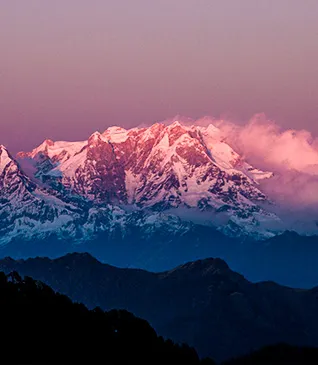
Panwali Kantha Trek
Recent articles.
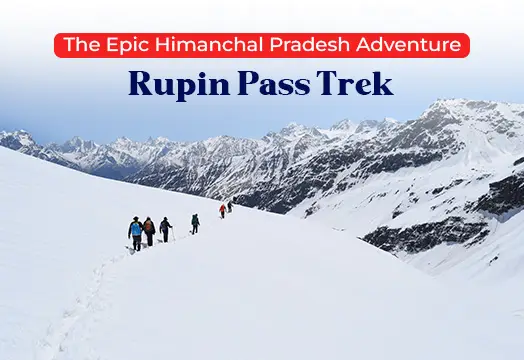
Rupin Pass Trek - The Epic Himachal Pradesh Adventure

Adventure Travel in India- Trek the Himalayas

Kuari Pass Trek - Winter Adventure for Beginners

Trekking in Himachal Pradesh - Buran Ghati Pass

Stargazing on Treks: A Celestial Experience Amidst Majestic Peaks

Blooming Love Story in the Valley Of Flowers

Har Ki Dun Trek - Best Trek for Beginners in Uttarakhand

Uttarakhand trekking Places to Visit in 2024

Best Adventure Company in India in 2024 - Trek The Himalayas

Winter Treks : Explore the Snowy Trails with Trek The Himalayas

Rent A Gear
Trek Articles
Quick Links
Trekking & Hiking
Mountaineering
Multi Sports
Himalayan Pilgrimage
Website Privacy
Terms & Condition
Contact Info
Get in touch with us. E-mail us Monday-Saturday (10 AM to 6 PM)
Address: Trek The Himalayas 7/2/1, Convent road, Near SBI Main Branch Dehradun-248001,Uttarakhand
Phone: 8191004846
Email: [email protected]
2024 Trek The Himalayas. All rights reserved

IMAGES
VIDEO
COMMENTS
Kedarkantha Trek offers a unique opportunity to explore the snow-covered landscapes of the Himalayas and a great experience of trekking in Uttarakhand. The easy endurance of the trail makes it one of the Best Treks for Beginners in Uttarakhand and also for seasoned trekkers. The spellbinding views from the summit make the 12,500 ft climb ...
The easy accessibility of the Kedarkantha location ensures a smooth transition into the heart of the Himalayas. The Height Of Kedarkantha Trek. The Kedarkantha summit stands at an impressive elevation of 12,500 ft showcasing a gallery of Greater Himalayan Ranges. Elevation of Sankri : 6,400 ft.
The Kedarkantha trek with Trek The Himalayas is a kaleidoscopic adventure that mesmerizes at every turn. As you embark on this journey, you'll find yourself surrounded by vibrant forests, where the colors of nature come alive with each step. The trek leads you through enchanting trails that wind past charming villages and lush meadows, eventually revealing breathtaking views of snow-covered peaks.
The Kedarkantha Trek is moderately complex and suitable for beginners and experienced trekkers. All of these contribute to the rich biodiversity of the Himalayas. Please remember the following text about the plants and wildlife you can encounter during the Kedarkantha Trek: Plant Life in Kedarkantha Trek. 1. Rhododendron Blooms
Kedarkantha is easily one of the most popular treks in India — popular amongst seasoned trekkers and beginners alike. There are many reasons why it is a very popular trek to do in the Indian Himalayas. The most important of them is this — the summit climb. The summit climb of Kedarkantha is a very rewarding one.
Exploring the Himalayas: More Than a Trek . The Kedarkantha trek goes beyond being a physical challenge. It's an opportunity to connect with nature and the local culture. From encounters with diverse flora and fauna to interactions with mountain communities, every step is a revelation. Kedarkantha Trek Itinerary Safety Measures and Tips
The Kedarkantha trek is a captivating Himalayan expedition renowned for its stunning landscapes and thrilling adventure. Nestled in the Garhwal region of Uttarakhand, India, this trek perfectly blends natural beauty and challenging terrain.The hike usually spans 4-6 days and begins from Sankri village, known for its rustic charm and warm hospitality.
The Kedarkantha Trek, a 25 km route, takes you from an elevation of 6,400 feet to 12,500 feet, making it one of the easier treks in Uttarakhand. It is an ideal choice for beginners who wish to experience the wonders of trekking in the majestic Himalayas. Furthermore, the duration of the summit day is quite extensive.
Planning for the Kedarkantha Trek? Here's a complete guide to trekking Kedarkantha including suggested itineraries, things to carry and more. +91 8147086083 / 7760710005 ( Mon - Fri: 10:00 - 21:00 ) ... Kedarkantha is one of those rare Himalayan treks that remains accessible even during winters. Suitable for those looking to begin their journey ...
The Kedarkantha trek is a paradise for trekkers and adventure enthusiasts in the Uttarkashi District of Uttarakhand state of India. With its awe-inspiring landscapes, pristine wilderness, and the opportunity to witness the raw beauty of the Himalayas, this trek has become a favorite among both beginners and seasoned trekkers.
<p> Kedarkantha: A dream trek awaits you with Trek the Himalayas! Experience the enchanting Kedarkantha Trek in the Indian Himalayas and discover breathtaking snowy landscapes that will captivate your heart. This unforgettable adventure offers a unique opportunity to immerse yourself in the pristine beauty of Uttarakhand's winter wonderland. Traverse through picturesque trails, witness ...
Kedarkantha Trek Overview: Kedarkantha Trek is a beautiful hiking trail in the Garhwal Himalayas of Uttarakhand, and is located in the Govind Wildlife Sanctuary of the Uttarkashi district. This trek is one of the most popular winter treks in India and is suitable for beginners and families.The trail is also well-known among nature lovers, birdwatchers, and professional trekkers.
Trek from Kedarkantha Base Camp to Kedarkantha Peak (12,500 ft) and back to Hargaon (6 km / 8,450 ft): Today is the summit day. Begin early in the morning and ascend from the base camp to the Kedarkantha Peak, reaching an altitude of approximately 12,500 ft. Enjoy panoramic views of the snow-capped Himalayan peaks from the summit.
Explore the Himalayas on the beautiful Kedarkantha trek. Kedarkantha is a 6-days trek in the Govind Pashuvihar National Park which is popular for a lot of reasons. The first reason being the rewarding experience of the summit climb. The summit looms large right from the base camp and as you start your journey towards the peak a whole new world ...
Day 4 : Trek from Kedarkantha base camp to Kedarkantha Summit (3800 Meters) and descent to Hargaon Thach . Trek Distance 11 Km - 6/7 Hours Trek. Mode of journey - on foot Altitude - Hargaon thach - 2645 Meters. Night Stay - Camp in a tent- on a share basis Today is the main day of your trek, so be ready at 3:30 am in the morning to witness the sunrise from the Kedarkantha summit.
Kedarkantha peak (Latitude 31.02257° N & Longitude 78.17185° E) is a low altitude mountain peak at ~3810 m/12500 ft. The peak and trail are on the fringe of Govind National Park, Uttarakhand. Kedarkantha peak summit at 12500 ft. The region marks the boundary with its neighbouring state Himachal Pradesh and situated in western flank of ...
Kedarkantha, set in the Garhwal Himalayas, is a perfect winter trek known for its snowscapes and beginner-friendly nature. The highlight is the Kedarkantha summit, offering 360-degree views of peaks like Swargarohini and Bandarpoonch. Trekkers experience serene campsites surrounded by pine forests and frozen lakes, and witness breathtaking sunrises and sunsets.
Nestled in the heart of the majestic Himalayas, the Kedarkantha trek offers an enchanting journey through snow-capped peaks, lush pine forests, and picturesque meadows. Located in the Uttarkashi district of Uttarakhand, India, this trek is renowned for its breathtaking landscapes and serene atmosphere, drawing adventure seekers and nature ...
The 32-km Kedarkantha trip takes six days. Altitude gain is a major problem of the Kedarkantha climb. The trek leads you to 12,500 ft above sea level, where the air becomes thinner and harder to breathe. For individuals inexperienced with high altitudes, acclimatize for a day or two before the hike.
Kedarkantha is a peak in the Himalayan ranges with an altitude of 12,500 ft. It was our first winter with a complete snow trek, and the preparations for this began almost a month ago with shopping and fitness. We watched several videos and read many articles to understand this mountain and the level of preparation required.
Located at an altitude of 12,500ft., Kedarkantha is one of the most famous winter treks in Uttarakhand. Kedarkantha is well-known for its striking and magnificent beauty. During winters enclosed in sparkling snow, this trek presents the tremendous look of the royal Himalayan peaks. It also offers its trekkers a unique chance to experience life ...
Location: Garhwal Himalayas, Uttarakhand. Duration of Kedarkantha Trekking is 6 days and 5 nights. Maximum Kedarkantha altitude 3800 meters / 12500 feet above sea level. Grade: Easy to Moderate. Kedarkantha Tour Package Rs.7999/- Per person from Dehradun to Dehradun. Kedarkantha trek India distance is 20 kilometers.
Sankri is the base village for the Kedarkantha trek. It connects with Dehradun and it takes around 8-10 hours to reach Sankri. It is a quite place in the foothills at an altitude of 6400 feet. Starting from Sankri, the first campsite is Juda Ka Talab at 9,100ft height. The next day campsite is Base camp which is at 10,200 ft and is the most ...